PART 3—
PETRARCHISM AND THE REPERTORY OF VENETIAN MADRIGALS
Chapter 7—
The Madrigals of Adrian Willaert
Adrian Willaert did not burst onto the Venetian scene as Rore was to do some years later. By the time he took up the position of chapelmaster at San Marco in 1527 he had already been a key figure at the Ferrarese court for over a decade, having joined the large musical establishment of the worldly, flamboyant Cardinal Ippolito I d'Este, brother of Duke Alfonso I, in 1515 or 1516.[1] When Ippolito died in September 1520 Willaert had shifted to the duke's service, where he had remained as a chapel singer until 1525, and had spent the years until 1527 serving another Este, Alfonso's son Cardinal Ippolito II.[2] Nor had Ferrara formed the limit of Willaert's contact with Italy and points east. In 1517, when Ippolito I left Ferrara to carry out duties as bishop of Eger in Hungary, Willaert had accompanied him, returning to Ferrara only in August 1519, and at some point during the pontificate of Leo X (1513-21) he had also visited Rome.[3]
[1] The first discovery that Willaert was a singer in the court chapel at Ferrara under Duke Alfonso I came from René Lenaerts, who placed him there from 1522 until 1525; see "Voor de biographie van Adriaen Willaert," in Hommage à Charles van den Borren: Mélanges, ed. Suzanne Clercx and Albert vander Linden (Antwerp, 1945), pp. 205-15. Lewis Lockwood has shown that Willaert joined the Ferrarese establishment of Cardinal Ippolito I d'Este as early as July 1515 and certainly by 1516; see "Josquin at Ferrara: New Documents and Letters," in Josquin des Prez: Proceedings of the International Josquin Festival-Conference, New York, 21-25 June 1971, ed. Edward E. Lowinsky and Bonnie J. Blackburn (London, 1976), pp. 118-21. For a fuller account of Willaert's years with Ippolito I, including discussion of the relevant documents, Willaert's time in Hungary, the patronage of Ippolito I, and an inventory of some works from the period, see idem, "Adrian Willaert and Cardinal Ippolito I d'Este: New Light on Willaert's Early Career in Italy, 1515-21," Early Music History 5 (1985): 85-112. Lockwood suggests that Willaert's services were probably obtained by Ippolito through contacts with the French Royal Chapel, of which his teacher Jean Mouton was a member (see esp. pp. 87-88). The only book-length biographical study of Willaert is that of Ignace Bossuyt, Adriaan Willaert (ca. 1490-1562): Leven en werk, stil en genres (Louvain, 1985).
[2] Lenaerts, "Voor de biographie," pp. 209-13.
[3] Information about Willaert's visit to Rome comes from an anecdote told by Gioseffo Zarlino, Le institutioni harmoniche (Venice, 1558), p. 346. All of these residencies and travels took place after several youthful years spent in Paris, first studying law, then music as a pupil of Jean Mouton. See Zarlino's Dimostrationi harmoniche (Venice, 1571), pp. 11 and 221; facs. ed. Ridgewood, N.J., 1966.
By 1527, then, Willaert had already been cultivating his skills in Italian soil for well over a decade. During that time many of his works had found their way into important Roman manuscripts (the Medici Codex and Cappella Sistina 16) and manuscripts of north Italian provenance (Bologna Q 19, known as the Rusconi Codex), while additional works had been printed by Antico and others.[4] Among them were masses, motets, and chansons — genres that still formed the mainstays of the pan-European polyphonic tradition in the 1520s and the proving grounds for any composer aspiring to international acclaim.
By contrast, none of Willaert's works presently datable to his Ferrarese years set Italian texts.[5] Indeed, whether Willaert set any Italian much before his first five madrigals appeared in 1534 remains an open question, since little is known of the madrigal's early history at Ferrara. Yet as Iain Fenlon and James Haar have shown, the madrigal of the 1520s was decidedly a Florentine and secondarily a Roman phenomenon.[6] Ferrara — along with Mantua and other northern courts — had instead been a center of the frottola, a genre that waned in the 1520s and was not clearly replaced in the north by madrigals until the following decade.[7] Although Ferrara did sustain musical ties with Rome, there was no clearly perceptible Florentine-Ferrarese axis of the sort that would establish a link to the decade's principal exponent of madrigals, Philippe Verdelot.
The scant knowledge relating to Maistre Jhan and Alfonso dalla Viola, the two other composers active in Ferrara during the 1520s who eventually produced madrigals, tends to confirm the impression that madrigal writing was just beginning to
[4] On the Medici Codex (I-Fl, MS Acquisti e doni 66), a presentation manuscript containing fifty-three motets, see Edward E. Lowinsky, ed., The Medici Codex of 1518: A Choirbook of Motets Dedicated to Lorenzo de' Medici, Duke of Urbino, 3 vols., Monuments of Renaissance Music, vols. 3-5 (Chicago, 1968), vol. 3, and the review of it by Leeman L. Perkins in The Musical Quarterly 55 (1969): 255-69. On Cappella Sistina 16, a papal manuscript from the later years of Leo X's reign (i.e., probably between about 1515 and 1521) containing seven motets and one mass (the Missa Mente tota tibi supplicamus a 6) by Willaert, see Josephus M. Llorens, Cappellae Sixtinae codices, musicis notis instructi sive manu scripti sive praelo excussi, Studi e testi, no. 202 (Vatican City, 1960), pp. 29-31. The motet manuscript in I-Bc, Q19, is also taken up in Perkins's review cited above, pp. 265-67, where it is claimed as a manuscript of northern Italian provenance contemporaneous with the Medici Codex; see also David Crawford, "A Review of Costanza Festa's Biography," JAMS 28 (1975): 208, who dates the manuscript to ca. 1518 and suggests Bologna as its provenance. A number of Willaert's motets also mention members of the Milanese Sforza family. Important as well are the manuscripts in I-Pc, MS A17 , and I-Rv, MS S 35-40 (olim Inc. 107bis, S. Borromeo E. II.55-60), the latter known as the "Vallicelliana manuscript"; see Lowinsky, "A Newly Discovered Sixteenth-Century Motet Manuscript at the Biblioteca Vallicelliana in Rome," JAMS 3 (1950): 173-232; rev. version in Music in the Culture of the Renaissance and Other Essays, ed. Bonnie J. Blackburn, 2 vols. (Chicago, 1989), 2:433-82. An important early printed source for Willaert is the printer Andrea Antico's anthology Motetti novi e chanzoni franciose (Venice, 1520). The anonymous print Libro primo de la fortuna (including Willaert's famous chromatic experiment Quid non ebreitas ), of which a single altus part book survives at I-Bc with the shelf no. MS R 141, probably derives from somewhat later. Recently Iain Fenlon and James Haar have dated it to ca. 1526; see The Italian Madrigal, pp. 218-20, as well as their discussion of the apparently related Messa motteti Canzonni Libro primo, pp. 210-11.
[5] Even these French and Italian settings owe much to Italian influences, however. For a persuasive assessment of the Italian impact on Willaert's later chansons, see Lawrence F. Bernstein's ed. of Antico's multifaceted collection of 1536 (with many chansons by Willaert), La couronne et fleur des chansons a troys, 2 pts., Masters and Monuments of the Renaissance, vol. 3 (New York, 1984), Chap. 5.
[6] The Italian Madrigal, pp. 7-9 and passim.
[7] Ibid., pp. 9-10, 74-75, and 320.
get under way in Ferrara during Willaert's time there. Of their Italian settings nothing is assignable to the 1520s save a single work in the Florentine manuscript known as the Newberry part books from about 1527-29 — anonymous in that source but attributed in a later one to Maistre Jhan.[8] Another of Maistre Jhan's madrigals was subsequently published in the Libro primo de la serena of 1530 (RISM 15302 ).[9] Dalla Viola's madrigals do not survive in early manuscript sources at all, and his first madrigal book was published only in 1539.[10] Though his madrigals show fluent acquaintance with Verdelot's Florentine style of the 1520s and clearly served as private fare for the Ferrarese court for some time before their publication, nothing indicates that dalla Viola composed any of them as early as the mid-twenties. Furthermore, Willaert's madrigals, once printing of them began, appeared not as the sudden release of a reservoir but as a steady trickle-five in 1534, followed by one in 1538, five more in 1540, and so forth.
The implications of these bibliographical artifacts are simple and profound: the genesis of Willaert's entire corpus of madrigals was quite likely Venetian. Willaert's earliest settings from 1534 owe much to the still-dominant Florentine tradition, but over the following decade they quickly began to replace Florentine traits with nascent Venetian ones. By the 1540s Willaert and other Venetian madrigalists had either displaced Florentine style almost entirely or reserved it for setting poetic madrigals, ballata-madrigals, and other lighter Italian verse forms. Their new products accommodated northern polyphonic techniques to Bembist literary ideals, layering part upon part with scrupulous attention to the affective values of sound, the strength and articulation of syntactic components, and the weighty canons of decorum.
This novel style had its most radical and influential embodiment in the Petrarchan sonnet settings of Willaert's Musica nova. During the mid-forties and fifties the Musica nova style, still known only through an aural and manuscript culture, was disseminated by Willaert's students in madrigals that modified its syntactic and expressive rigors for the purposes of print, making it more palatable for public consumption. Even though Willaert's own settings of Petrarch's sonnets were
[8] US-Cn, Case MS-VM 1578. M91, fols. 82-83; the altus part book is in Sutton Coldfield, Oscott College, Old Library MS Case B, No. 4.
[9] The two, respectively, are Deh quanto e dolc'amor and Hor vedete madonna. The former was attributed to Maistre Jhan only in his Primo libro, published posthumously in 1541. Its presence in the Newberry manuscript, otherwise almost wholly devoted to Verdelot, is peculiar (see H. Colin Slim, ed., A Gift of Madrigals and Motets, 2 vols. [Chicago, 1972], 1:88-89). Hor vedete madonna, conversely, reappeared without attribution in Arcadelt's Libro secondo a 4 (1539; repr. 1541). On Maistre Jhan's biography see Lewis Lockwood, "Jean Mouton and Jean Michel: French Music and Musicians in Italy, 1505-1520," JAMS[32] (1979): 230.
[10] Alfonso's Primo libro a 4 was issued by Bulghat of Ferrara. For further on this book and the question of early Ferrarese madrigal writing see Leonardo Julio Waisman, "The Ferrarese Madrigal in the Mid-Sixteenth Century," 4 vols. (Ph.D. diss., The University of Chicago, 1988), Chaps. 1 and 3. Waisman is inconclusive about whether any of Alfonso's madrigals were written in the 1520s and dubious that any of Willaert's were (p. 40). Madrigals were performed at Ferrarese banquets given in 1529. Among composers for the banquets was dalla Viola, but he is not mentioned in the famous cook's account as a composer of madrigals per se; see Howard Mayer Brown, "A Cook's Tour of Ferrara in 1529," Rivista italiana di musicologia 10 (1975): 216-41.
withheld from publication during this time, a smattering of madrigals he wrote setting less complex verse appeared in a variety of printed anthologies. This twofold division represents a recurring pattern in Venetian madrigalian history: expressive weight was aligned with private settings and less imposing styles with public ones — a pattern that grounds my presentation in the remainder of the present chapter and one to which I will point more than once in those that follow.
Public Styles and Printed Anthologies
The Musica nova preserved the only madrigal corpus Willaert published in his lifetime. His other madrigals, thirty in all over almost as many years, survive almost exclusively in anthologies and in prints devoted to other composers.[11] As shown in Table 2, the bulk of these (four-fifths) came out between 1534 and 1549. Many went on being reprinted periodically, but only six new ones cropped up in prints issued between 1554 and 1563.
Through the year 1541 Willaert's madrigals appeared only in collections otherwise mainly devoted to Philippe Verdelot — Verdelot's — second books for four and five voices of 1534 and 1538, respectively, his only six-voice book of 1541, and a number of reprint editions (starting with RISM 154020 and 154018 ).[12] It was not until 1542 that Willaert's madrigals first appeared in non-Verdelot editions. The printer Girolamo Scotto's collection of his own madrigals, Madrigali a quatro voci . . . con alcuni a la misura breve, et altri a voce pari, included Willaert's two settings of canzone stanzas by Petrarch, Qual più diversa e nova cosa and Quante volte diss'io. And the first of Gardane's Madrigali . . . a misura di breve series included a single sonnet setting by Willaert. Both of these editions advertised themselves in connection with the fashionable new black-note madrigals.
In subsequent years, nine more new madrigals came out in five-voice editions of Rore: three in Rore's eclectic second book of 1544, five in Scotto's edition of Rore's third book of 1548, and in 1557, finally, one in his fourth book. These and the settings published in Verdelot prints account for all but five of the thirty anthologized
[11] The sole exception is Scotto's posthumous print of 1563, the Madrigali a quatro voci, a sentimental commemorative collection that unites the more accessibly scored four-voice madrigals with examples of Willaert's canzoni villanesche. The print has a number of what appear to be clear misattributions, but much of it consists simply of reprinted madrigals. It contains only a single unicum (discussed below).
[12] Much has been made of these joint appearances as an indication that the two composers may have been connected in some way, especially given Willaert's role in arranging madrigals of Verdelot for lute and voice, Intavolatura de li madrigali di Verdelotto da cantare et sonare nel lauto, intavolati per Messer Adriano, novamente stampata . . . (Venice, 1536). For Verdelot's possible influence on Willaert see Lowinsky, "The Vallicelliana Manuscript," p. 194, and Einstein, The Italian Madrigal 1:326; see also Wolfgang Osthoff, Theatergesang und darstellende Musik in der italienischen Renaissance, 2 vols. (Tutzing, 1969), 1:286 and 305, for an argument contradicting the latter's view that Willaert's style emerged from Verdelot. But Verdelot's biography after 1528-29 remains as mysterious as ever, and he could well have perished during the plague that hit Florence then. The best biography of Verdelot is that in Slim, A Gift of Madrigals and Motets 1:41-65; see also idem, "Verdelot, Philippe," in The New Grove 19:631-35. In lieu of more concrete information, the possibility remains a good one that the editions of Verdelot were in some sense commemorative and that Willaert's place in them was that of a first among various equals, brought together to embellish the works of an old master.
| |||||||||||||||||||||||||||||||||||||||||||||||||||||||||||||||||||||||||||||||||||||||||||||||||||||||||||||||||||||||||||||||||||||||||||||||||||
| ||||||||||||||||||||||||||||||||||||||||||||||||||||||||||||||||||||||||||||||||||||||||||||||||||||||||||||||||
settings Willaert made of Italian literary verse that survive (omitting his secular Latin settings and lighter dialect settings); the remaining five were issued singly in sundry editions of 1549, 1554, 1559, 1562, and 1563.
This publication pattern corresponds to Willaert's general rate of productivity over his lifetime, which showed a steady decline from about the mid-1540s. A famous anecdote in Zarlino's Sopplimenti musicali of 1588 reveals through the mouth of Parabosco that even Willaert's pupils came to think of him as an immaculate but slow worker.[13] Giulio Ongaro has corroborated this through a remarkable report he located, which relates that in 1547 the Procuratori of San Marco gave Willaert's young pupil Baldassare Donato the task of "keeping Willaert occupied in composing" (tenir solicitato esso maistro Adriano a tal composition).[14] Willaert's slowness in composing may have been exacerbated by increasingly poor health, for by 1549 a series of wills and codicils begin to describe him as ill and confined to bed.[15] In combination with such evidence, the anthologized madrigals provide a means to chronicle the evolving (and diminishing) pattern of Willaert's compositional production.
All of this suggests the existence of a counternarrative to the heroic tale of monumental production on which Willaert's posthumous reputation has always rested — an undercurrent of creative hesitation and generic fragmentation beneath the Musica nova 's exterior of extraordinary invention, conceptual unity, and generic consolidation. Aside from biographical data, the evidence of Willaert's anthologized madrigals provides many insights into the broader cultural economies of Venetian madrigal production. Unlike those of the Musica nova, the anthologized madrigals contain a great thematic diversity and formal variety. Poetic madrigals and hybrid forms of ballata-madrigal and canzone-madrigal predominate early on, but after 1540 they appear in equal numbers with sonnets, canzone stanzas, ballatas, and even a variant of terza rima. The settings range between nearly Musica nova — like gravity in a few to numerous others that are light, with passages of homorhythm, triple time, and the like. The majority use standard cut time, but a few use black notes. Some are in one part, others have some sort of formal division into two. Many, like Mentre al bel letto, written to celebrate the creation of Parma's dukedom in 1545, were obviously occasional. Others were encomiastic — the tributes to Polissena Pecorina, Qual dolcezza giamai, and Elena Barozza Zantani, Ne le amar'e
[13] The Sopplimenti musicali were published in Venice. The story relates Parabosco's conversation with a self-important, little-known "maestro," who claims he can write a mass in an evening like one he has just heard by Willaert — one that Willaert had allegedly worked on for two months. Parabosco trumps him by replying, "I believe you and I am surprised that you did not write ten of the sort in that time," then goes on to explain Willaert's method of composing: "Adriano quando compone metto ogni suo studio et ogni sua industria, e pensa e studia molto bene quello che abbia da fare avanti che dia fine, et mandi alla luce una sua compositione; il perche, non per altro che per questo, è riputato il primo de' nostri tempi" (Adriano when he composes puts all his learning and all his industry and thinks and studies very well what he must do before he considers a piece finished and sends his composition out into the world; for no other reason than that is he reputed to be the best in our time); p. 326.
[14] See "The Chapel of St. Mark's at the Time of Adrian Willaert (1527-1562): A Documentary Study" (Ph.D. diss., University of North Carolina at Chapel Hill, 1986), pp. 88-90 and Document 170.
[15] See those reproduced in Vander Straeten, La musique aux Pays-Bas 6:227-46.
fredd'onde, discussed in earlier chapters.[16] They may have been used for particular events or simply satisfied the more general wishes of interested fans and patrons.
These particulars begin to elaborate the striking bifurcation within Venetian repertory that must have governed the creation and dissemination of the many different madrigal types to which I pointed above. On one side stood the monolithic repertory of the Musica nova, representing so implacably a musical embodiment of the classic, "authentic" Petrarchism prized by the literary elite. On the other stood the heterogeneous repertory of anthologized works that were mostly more immediate in their appeal, with no obvious claims for a transcendent musical poetics. Unlike the "hidden" state in which the Musica nova was cultivated and preserved in manuscript, many of Willaert's madrigals for printed anthologies probably entered the commercial marketplace without much delay. By contrast with those of the Musica nova, they display Willaert at his most accessible.
In the genre's earliest Florentine and Roman forms, of course, accessibility — if not public accessibility — was part of madrigal's temper, and it was within this frame of reference that Willaert started out. His first group of four-voice madrigals, published in Verdelot's Secondo libro in 1534 and reprinted in 1536 and 1537, adapted the chansonesque style identified with Verdelot and Jacques Arcadelt. Each of these madrigals arranges its poetic lines as a series of elegant, charming melodies. Sometimes the lower voices assume autonomous roles, expressively or contrapuntally (particularly in imitative passages), but most of the time musical prominence is ceded to the cantus. All five of Willaert's madrigals from the 1534 group set either the new cinquecento form of poetic madrigal or the most common hybrid variety derived from the ballata.[17]
The early madrigalists' preference for ballatalike structures forms a useful point of musical departure, for it reveals their continuing attachment to the balanced formal return offered by song forms. Rounded ballata-madrigals yielded rounded musical madrigals. In setting Dragonetto Bonifazio's ballata-madrigal Amor mi fa morire (see Ex. 9), Willaert capitalized on the text's vestigial resemblance to the repetitive, sectionalized structure of the ballata: the poem has a brief ripresa (vv. 1-2), an irregular passage of mutazioni (vv. 3-9 — normally two piedi equaling two verbal periods, but here three), and a quasi-volta (vv. 10-12) that elides midway into a ripresa.[18] As shown below in my schematization of melodies carried (characteristically) by the cantus, Willaert mirrors — even outstrips — the text's elision into the ripresa, postponing it musically beyond the poetic return — that is, until the end of v. II (cf. mm. 3-5 with mm. 59-60).
[16] See above Chap. 2 n. 49, and Chap. 3 nn. 38-39.
[17] On these hybrid forms see Don Harrán, "Verse Types in the Early Madrigal," JAMS 22 (1969): 27-53.
[18] On this poem see ibid., p. 32 n. 20. The rhyme of v. 10 matches that of v. 9, as the beginning of a volta should do. On the poet Bonifazio (Bonifacio) see Erasmo Percopo, "Dragonetto Bonifacio, marchese d'Orio: rimatore napoletano del sec. XVI," Giornale storico della letteratura italiana 10(1887): 197-233, with Amor mi fa morire on p. 219.
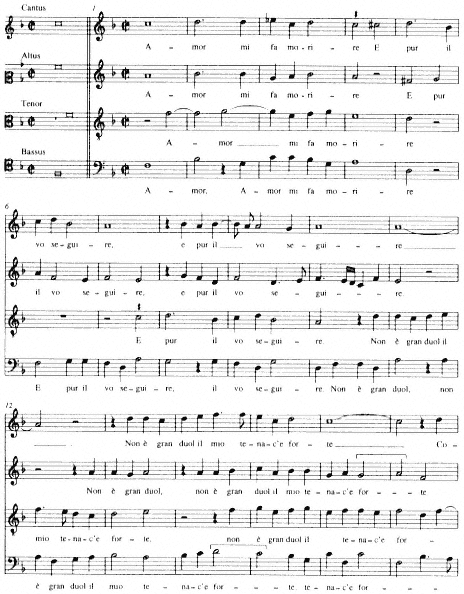
Ex. 9.
Willaert, Amor mi fa morire (Dragonetto Bonifazio), incl.; in Verdelot, Secondo
libro a 4 (Venice, 1536) (RISM 15367 ), no. 1.
(continued on next page)
(continued from previous page)
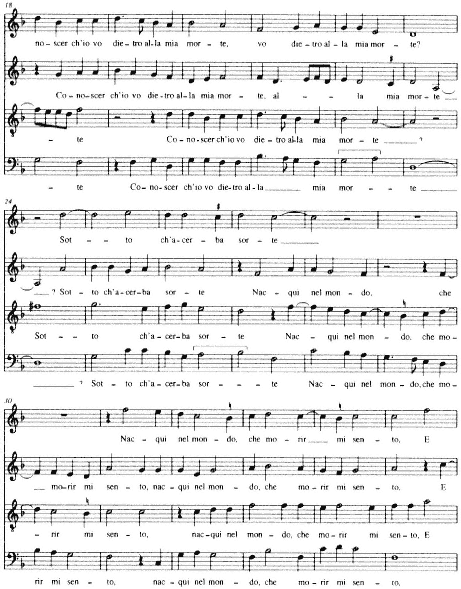
Ex. 9
(continued)
(continued on next page)
(continued from previous page)
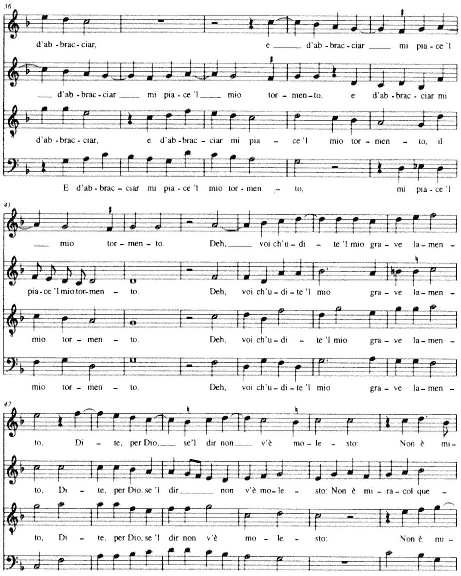
Ex. 9
(continued)
(continuedon next page)
(continued from previous page)
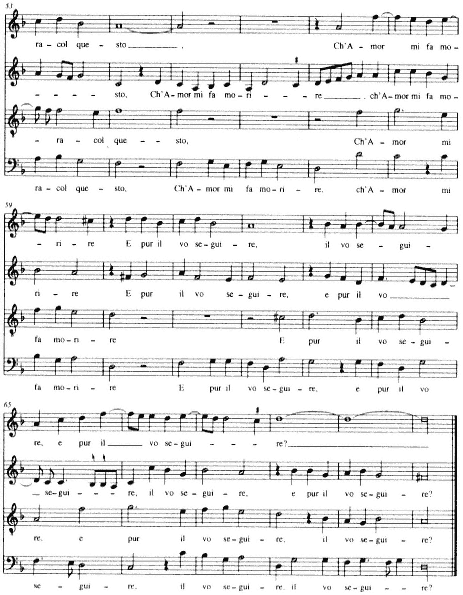
Ex. 9
|
Willaert's setting adheres to the phraseology of French and Italian song styles that binds each poetic line to a single musical phrase. His rendition favors a reading based on versification, so much so that even the enjambment of lines 5 and 6 produces two distinct musical phrases.[20] Yet it still practices a northern art of imitation.
At a higher level the setting divides the twelve poetic lines into structural groups formed around five verbal periods:
|
Each of these poetic divisions in turn finds support in an interwoven system of melodies and cadences (see Table 3), still wholly based in the traditional tenor-
[19] Note that the prime sign (') below indicates varied repeat of a phrase.
[20] Although sixteenth-century madrigals were often performed with instruments taking at least some of the parts or doubling voices, my critical discussions in Chapters 7-10 treat all voices as if they were sung. Since all of the madrigals I discuss in Part 3 were conceived in such a way that all parts would provide viable poetic readings when performed by voices, this seems reasonable analytically but it should not be taken to dismiss or minimize the historical existence of other kinds of performances.
Readers wishing fuller access to the madrigals under discussion should consult modern editions of them, as listed below. My identifications of poets come from Il nuovo Vogel except where otherwise noted. I have added poetic sources wherever possible. I am grateful to Lorenzo Bianconi and Antonio Vassalli for use of their handwritten catalogue of sixteenth-century poetic incipits and to Michael Keller, Anthony Newcomb, and Shuli Roth for use of the computer database of cinquecento poetry at the University of California at Berkeley.
| |||||||||||||||||||||||||||||||||||||||||||||||||||||||||||||||||||||||||||||||||||||||||||||||||||||||||||||||||||||||||||||||||||||||||||||||||
superius framework.[21] The madrigal proceeds from a d-mollis tonality strongly polarized with A. Its first important cadence, between the cantus on aa and tenor on a over D in the bass (m. 10), rounds off the opening two settenari. As the poetic refrain that will close the piece, these lines need to be firmly anchored, and Willaert does so by treating line 1 as an antecedent, brought to a half cadence (m. 4), and line 2 as a consequent. By letting line 2 cadence fleetingly on f/F (altus-bassus, m. 7) and then, more strongly, on the D-major chord (m. 10), Willaert's setting makes the whole into a tiny, but balanced, bar form aimed toward the final. F retains its status as a secondary
[21] The designation of pitches in Table 3 and elsewhere follows Renaissance practice, with each octave conceived as proceeding upward from pitch G and c designating our "middle c."When speaking of pitch class generally, without reference to particular register, I simply use upper-case letters.
cadential degree and D as a primary degree as the quasi-mutazioni first cadence in a decorative suspension to f/F at mm. 17-18 and then in a hollow open-fifth at m. 23. The last resounds with D in no fewer than three voices (cantus, altus, bassus), while the tenor lingers on the a it had sung in the penultimate cadential sonority. It might seem surprising that this otherwise traditional tenor should retire contrapuntally at a moment of such clear structural definition. But doing so enables it to leap dramatically to center stage, its unexpected high f-sharp attack at m. 24 beaconing the tonal reorientation to come with the "bitter fate" of the third period.
F-sharp is an outsider in the D/A tonal world of the ripresa. The diminished-fourth cross relation it forms with the alto's bb-flat — and that bb-flat's augmented-fourth cross relation with the cantus's ee (m. 25) — subverts the tonal calm that had prevailed in the ripresa . Ultimately the tonality is riveted to a new axis of pitches, F and C, which dominate the medial third and fourth poetic periods, approached through a detour past G at line 7(m. 42).[22] The shift amounts to a change of modal orientation from Hypoaeolian to Hypolydian that first emerges in a series of evaded cadences at midverse, with falling fourths, ff to c, in the cantus (mm. 31, 33, etc.). Eventually the cadences take up more clear-cut positions at verse endings (mm. 35, 47, 51), reinforcing the shift of modality. Only after D is summoned back with phrase B2 and the start of the last period, "Non è miracol questo," does the madrigal meld seamlessly into a return of the opening.
In Amor mi fa morire, then, Willaert put northern contrapuntal skills to novel expressive use. Pitch emphases, voice leading, and modal relationships all quietly shape prosodic structures at the two levels of verses and periods. The madrigal's new coloristic expressivity — the cross relation between ee-flat and e at the very opening (m. 3) and cross relations highlighting the "bitter fate" in mm. 24-25 noted earlier — introduces a refined dramatic tension into the handling of the verse structure. Some of the madrigal's rhetorical gestures, like the abrupt pause and textural shift to near-homorhythm at the exclamatory "Deh, voi ch'udite 'l mio grave lamento" in the midst of otherwise staggered declamation, are boldly new. Its imaginative transitions between verses call to mind the formal subtlety often heard in Arcadelt's madrigals of the 1530s, most famously Il bianco e dolce cigno from the Primo libro of 1539. And yet with all this, musical accents are allied to words in melodies free enough to allow a virtually infallible diction.
Despite these novelties, Willaert's Amor mi fa morire is closer to Verdelot's style than to anything Willaert composed in later years. The music remains syllabic with many short phrases, cadences (including many Landini cadences) at the end of nearly every verse, minimal text repetition, frequent four-square metric patterns,
[22] This sort of medial modal contrast parallels that undertaken in contemporary chansons, as Howard Mayer Brown pointed out with respect to Willaert and Verdelot; see "Words and Music: Willaert, the Chanson, and the Madrigal about 1540," in Florence and Venice, Comparisons and Relations: Acts of Two Conferences at Villa I Tatti in 1976-1977, vol. 2, Il cinquecento, ed. Christine Smith with Salvatore I. Camporeale (Florence, 1980), pp. 217-66. Comparable events in chansons are generally managed within a much more controllable verbal space — four or five lines of equal length and rhythmic character.
enlivened chordal textures built mainly around tenor and cantus, and a rounded formal structure. The musical treatment of vv. 1-2 as a single bipartite unit — the latter part essentially a variation of the former with a "half cadence" separating the two (m. 4) — recalls the handling of seven-syllable couplets typical in the repertories of both frottola and early madrigal. These qualities serve as a reminder that Willaert largely preserved the formalistic approach that Howard Mayer Brown identified in likening one of his chansons to a madrigal of Verdelot's.[23] What is more, the novelties I have noted in Amor mi fa morire move it farther from Verdelot's style than any of the other madrigals in the 1534 collection do. A typically Verdelot-styled setting of a ballata-madrigal is Willaert's Madonna, il bel desire, whose melodic repetitions are far more schematic:[24]
|
Like many early-sixteenth-century song settings, Madonna, il bel desire assembles jigsaw fashion four distinct melodic strains. Each of these strains plays a discrete rhythmic-harmonic role: phrase A that of an initiating gesture for settenari; phrase B a more elaborated melody for endecasillabi, tracing a falling-ff-to-final-g curve; phrase C a short open-ended melody for paired settenari, supported frottola-like by
[23] Ibid.
[24] The madrigal has a mixed attribution history. In RISM 153416, 15367, and 153710, it is assigned to Willaert. In 154020, Scotto's combined edition of Verdelot's first and second books for four voices, it appears to be attributed to Verdelot, as Gardane apparently believed in assigning it to Verdelot in 1541 . As Stanley Boorman has argued, however, this is probably only a result of the fact that the madrigal begins in the middle of a recto with Verdelot's name in the header and with a madrigal of Verdelot's immediately preceding Madonna, il bel desire. In 1540 Willaert's name does not appear until the header of the verso on which Madonna is completed. See Boorman, "Some Non-Conflicting Attributions, and Some Newly Anonymous Compositions, from the Early Sixteenth Century," Early Music History 6 (1986): 125-27 and 157.
For scores of Madonna and other madrigals by Willaert not published in the Musica nova see Willaert, Opera omnia, Corpus mensurabilis musicae, no. 3, AIM, vol. 14, ed. Helga Meier (NeuhausenStuttgart, 1977).

Ex. 10.
Willaert, Signora dolce, io te vorrei parlare, cantus, mm. 1-11; in Verdelot,
Secondo libro a 4 (Venice, 1536) (RISM 15367 ), no. 2.
a homorhythmic minim chain with a weak-beat ending; and phrase D a medial endecasillabo melody arching from bb-flat up to dd and down to d below.
There is even more archaism, albeit of an eclectic sort, in other madrigals from 1534. Quando gionse per gli occhi al cor, madonna recalls the old Florentine ballate of Heinrich Isaac, Alessandro Coppini, and Bartolomeo degli Organi: strong metrical rhythms and syncopations, triple-meter shifts, and passages of homorhythm (mm. 31ff.). And the quasi-medieval floating lines and fragile melismas of Signora dolce, io te vorrei parlare, a chivalric offer of secret servitude to a "sweet lady," harken back to the chansons of the fifteenth-century rhétoriqueurs.[25] (See the opening bars of the cantus in Ex. 10.)
By 1540 Willaert's anthologized madrigals, even the ones for four voices, had already grown distant from Verdelot's balanced songlike conception. The difference is striking in Già mi godea felice ogni mio bene,[26] one of Willaert's contributions to Scotto's reprint edition Di Verdelotto tutti li madrigali del primo, et secondo libro a quatro voci (154020 ). This piece sets a little eight-line madrigal, disposed in the near-symmetrical scheme ABbA CddC.
Già mi godea felice ogni mio bene, Once I gladly enjoyed all my good fortune,
Hor, sì longo al mio ben, tal doglio Now, so far from my loved one, I feel such
sento, grief
Che più crudel tormento That I have never had a more cruel torment,
Non hebbi hormai, nè sì gravose pene. Nor such a grave pain as now.
Felic'era'l mio amor, felic'ero io; Happy was my love, happy was I;
Hor, benchè sia'l mio core Now, though my heart is
Sì lontan dal suo amore, So far from its love,
Fie volendo felice l'amor mio. Let my love be happy if it wishes.[27]
The poem is a study in simple symmetries, yet Willaert's setting counteracts nearly all of them: the anaphora, repetitions of rhymes, and evenly deployed paradoxes. Its melodies wind out motet-style in a formidable 99 breves (not much shy of the 120
[25] This funny little text does not even scan as proper seven- and eleven-syllable lyric verse.
[26] Willaert may have gotten the text from Constanzo Festa's setting in the latter's Primo libro of 1538. No poetic source is known.
[27] I am grateful to Elissa Weaver for help in translating several poems in this chapter, including this one.
or so typical of his sonnet settings), with little regard for the length or overall rhythmic character of each verse. The declamatory pacing varies widely, from the opening, dominated by breve and semibreve declamation, to subsequent passages declaimed continuously in minims (Ex. 11). Added to all this are several extended melismas, all of these thwarting any clear perception of the poem's versification.
Nevertheless, Willaert did not ignore the poem's larger verbal structures altogether. On the contrary, he magnified the rhetorical-rhythmic closes, culminating the ends of each half with multiple textual repetitions that stretch line 4 over 23 breves and line 8 over 16 1/2. Other tactics gather momentum toward these final cadences too: the cantus makes a prolonged ascent to gg shortly before the close of the first half and florid, sequenced melismas before the very end. As he did in setting Amor mi fa morire, Willaert brought into relief the internal apex of the poem by carrying line 4 to the madrigal's farthest point of modal remove — in this case an evaded, overlapped cadence on f/D — and then turned almost immediately back to the original tonality of C durus.[28]
Ironically, Willaert spun out these simple verses with more pliant, elongated melodies than he had ever used before, forsaking the prosodic rhythms that had previously been fundamental to Italian lyric song. Già mi godea and other madrigals of 1540 also mark the beginning of Willaert's experimentation with subtle manipulations of timbre, generated by variously blending and reblending different vocal groups. Certainly none of his earlier expositions looks anything like the one in Ex. 11, which weaves a highly individuated cantus and altus into a spare duo for eight long measures before finally repeating v. 1 a quattro. The madrigal's subsequent dispositions of text continue to project varied groupings that intersect and overlap one upon another, as at line 6 (mm. 71-79), where three high voices replace three low ones. The technique is strikingly new in a four-voice texture and profoundly unsettling to the traditional cantus-tenor edifice on which the madrigal's earlier song textures — even less conventional ones like Amor mi fa morire (Ex.9) — had been built.
Scotto's four-voice reprint of Verdelot presented two more of Willaert's madrigals. One set a lengthy madrigal text, Così vincete in terra,[29] a fourteen-line encomium of a woman, in a style much like that of the 1534 collection. But the other introduced Willaert's first published sonnet setting, Qual anima ignorante over più saggia (set in toto, as all his essays in the sonnet were to be). Qual anima ignorante is a Petrarchan lament loosely modeled after Petrarch's In qual parte del ciel (no. 159), complete with repetitive rhetorical constructions and pervasive antitheses. Its only debt to repetitive song forms is an internal refrain, lines 3-4 returning as lines 7-8.
[28] After the close of v. 4 nearly all the cadences land on C (e.g.,m. 75, m.80, m.91), with the exception of mm. 66-67.
[29] An anonymous setting of the same text survives in I-Bc, MS Q21, which dates from ca. 1526; see Fenlon and Haar, The Italian Madrigal, pp. 137-39.
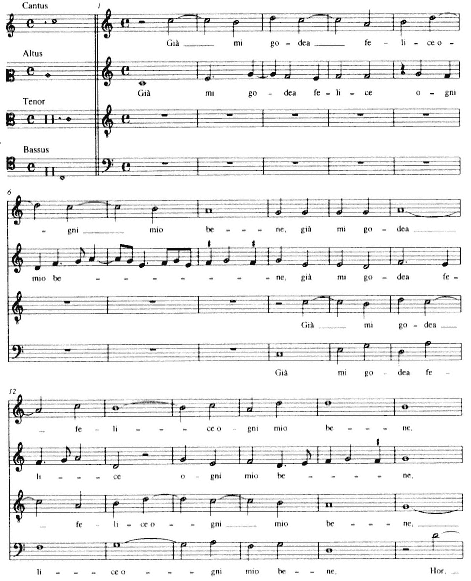
Ex. 11.
Willaert, Già mi godea felice ogni mio bene, mm. 1-17; in Di Verdelotto tutti li
madrigali del primo, et secondo libro a 4 (Venice, 1540) (RISM 154020 ), p. 47.
Qual anima ignorante over più saggia What soul ignorant or more wise,
Qual huom mortal, qual dio, qual donn'o diva, What mortal man, what god, what woman or goddess
Che non sappia 'l mio mal onde deriva, That might not know from whence my woe derives
E del mio grand'ardor pietà non haggia. And might not pity my great ardor? 4
Qual selv'è sì riposta o sì selvaggia What woods so hidden or so savage,
Qual lauro in aria cresce o qual oliva, What laurel rising in the air or what olive tree
Che non sappia 'l mio mal onde deriva, That may not know from whence my woe derives
E del mio grand'ardor pietà non haggia. And may not pity my great ardor? 8
Qual part'hoggi del mondo, che non sia What part of the world today that is not
Delle lagrime pien'e di lamento, Full of tears and of laments,
Delle voci, sospir'e doglia mia. Of voices, sighs, and my griefs? 11
Non giace cosa hormai sotto la via Not a thing now lies beneath the path
Del ciel che non conosca 'l mio tormento, Of heaven that does not know my torment
Se non sola colei, ch'io sol vorria. But her alone whom I alone desire. 14
Willaert's setting of Qual anima ignorante continued the trajectory of other madrigals from 1540, though the basic conception differs from that of sonnet settings in the Musica nova . Willaert made no seconda parte for the sestet or any double-bar division at all and matched the poetic refrain with the same music. In these respects the setting follows conventional norms for setting the lighter forms of the ballata and madrigal. Yet some of the elastic pacing and varied vocal scoring of Già mi godea finds its way into Qual anima ignorante, especially in the last tercet, where the previously languorous rhythms unexpectedly pick up. Here too Willaert loosed the restraints of a prosodic approach by fully recognizing the poetic enjambment with a continuous musical phrase (mm. 110-11).
All three of the poets in 154020 have continued to elude identification. The point is suggestive, for it relates to Willaert's general disengagement in anthologized madrigals from verse authorized by classical tradition or having pretensions to the highest literary pedigree. If the poets' voices remain so consistently unrecoverable in our day, they were probably muted in Willaert's too. More than theirs, it was probably Willaert's voice that resonated "authorially" among buyers and auditors in salons and print shops. This does not mean that poems were typically chosen through Willaert's agency or authority: the mechanisms through which he acquired texts remain mysterious and the impetuses for his settling on one or another were probably as fragmentary and diverse as their printing venues.
Both of Willaert's two five-voice madrigals featured in Scotto's anthology Le dotte, et eccellente compositioni de i madrigali a cinque voci (RISM 154018 ) may have arisen at the behest of particular patrons or for special occasions.[30] One of these is
[30] As Fenlon and Haar point out, the composers listed in this print appear in "what looks like a descending order of importance" (ibid., p. 313): Willaert, "suo discipulo" Leonardo (Leonardus) Barré, Verdelot, Arcadelt, Festa, Corteccia, Berchem, and so on (the order thereafter becomes slightly less straightforward) — an arrangement only a little different from that given on the title page of the cantus part book. The undated print RISM [153820] (Il nuovo Vogel, no. 2883) is undoubtedly a later reprint of 154018, as established by Mary S. Lewis, "Antonio Gardane and His Publications of Sacred Music, 1538-55" (Ph.D. diss., Brandeis University, 1979), p. 629, and Fenlon and Haar, The Italian Madrigal, p. 313.
the famous homage to Polissena Pecorina, Qual dolcezza giamai (the text of which appears in Chap. 2, pp. 34-35). Qual dolcezza giamai is the only madrigal from these years that essays an explicitly celebratory style, with appealing melodies that have little place in Willaert's Petrarch settings. The graceful, catchy soggetto in Ex. 12, announced by the tenor under a shimmery alto countersubject and imitated at m. 5 by the cantus, has no analogues among expositions in the Musica nova. Einstein viewed this kind of five-part writing as technically new; "the choral response, the vocal coloring (one might call it 'vocal glazing'). Just as a painter covers over but does not conceal a shining ground color with another one, delicate and transparent, so Willaert superimposes upon a prominent voice, the bearer of the espressivo, another purely radiant one."[31] Einstein did not link this to the celebratory nature of the text. But he did note the new dramatic potential inherent in such textural flexibility and particularly the rhetorical and timbral possibilities in treating the fivepart madrigal as two four-part textures (as happens at the beginning of the seconda parte ). (The only text for which Verdelot uses such a technique in the same print is an actual dialogue.) In making the words easily perceptible, Willaert also kept the declamatory meter uniform, even when the parts give out different rhythms and melodies on the same words. His short, simple formulas for acclamations like "Desta nei cor" usually repeat the same motive (as shown in Ex. 13) but also vary it with the more athletic motion of the bassus (Ex. 13b) or the rising movement of the altus (Ex. 13c). Willaert pitched settings like these to a lighter — hence lower — stylistic level than his settings for the Musica nova (even switching to a near-homorhythmic triple time at "Et si rallegra in ciel di gir'in giro").
Though Qual dolcezza giamai progresses through an accumulation of enjambments (vv. 1-3, 5-6, 7-8, 10-11, 13-14), Willaert's setting still largely ties its phrases and contrapuntal articulations to the poem's versification.[32] Superficially the parts appear to function autonomously, but Willaert stitches them to a series of cadences that coordinate the parts at moments of prosodic definition (note the four upper voices at m. 13, Ex. 12).[33] The combination of relatively short melodious strains and frequent multivoice cadencing keeps the words clear and the texture delightfully transparent.
Both Qual dolcezza giamai and the other setting in Le dotte, the ballata Quanto più m'arde e più s'accende il foco, may owe their existence to local sources of patronage.
[31] The Italian Madrigal 1:327-28.
[32] The only exception is that of the strong enjambment that opens the second part, "A la dolce armonia si fa serena / L'aria, s'acqueta il mar, taccion'i venti" (At the sweet harmony the air becomes / serene, the sea calms, the wind turns quiet), for which Willaert provided a separate exposition for "A la dolce armonia," and then made what follows continuous.
[33] Some of these cadences involve as many as all five voices, for example, mm. 79, 84, and the general pause preceding the triple-time passage, m. 63. For the full setting see Willaert, Opera omnia 14:65-70.
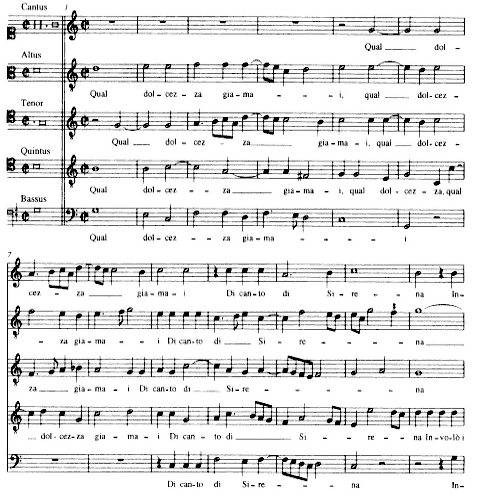
Ex. 12.
Willaert, Qual dolcezza giamai, mm. 1-13; in Le dotte, et eccellente compositioni de
i madrigali a 5 (Venice, 1540) (RISM 154018 ), p. 1.
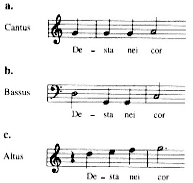
Ex. 13.
Willaert, Qual dolcezza giamai: a,
m. 33; b, mm. 32-33; and c, mm. 36-37;
in Le dotte, et eccellente compositioni
de i madrigali a 5 (Venice, 1540)
(RISM 154018 ), p. 1.
Quanto più m'arde had recently been published (like Già mi godea ) in a setting by Constanzo Festa,[34] and in light of Festa's previous settings of both texts one cannot discount the possibility of a Strozzi connection. Both Quanto più m'arde and Già mi godea remain without poetic identifications. But an important poet-patron of Festa's (and one not represented in surviving literary sources) had significant Venetian connections, namely Filippo Strozzi. One of Willaert's anthologized madrigals, the six-voice Rompi dell'empio core il duro scoglio, published the year after Le dotte in Verdelot's six-voice print La più divina musica (154116 ), set Strozzi's invective on his incarceration by the Medici. By 1541 Filippo had been dead for about three years (as noted in Chapter 2), but his trusted nephew Neri Capponi and sons Piero and Ruberto maintained a Strozzi presence in Venice. Since Festa benefited from Filippo's patronage and set his poems to music,[35] it is tempting to consider whether Willaert may have reset texts set by Festa because they were Strozzi's.
Such a scenario seems plausible in view of Willaert's having composed music for both texts. And Quanto più m'arde shares with an attributed Strozzi poem set by Willaert about 1542, Rompi dell'empio cor il duro scoglio, a darker, more dramatic expression than found in any of Willaert's previous settings. Einstein singled out Willaert's Quanto più m'arde for the violent rhetoric it used to assail the poem's mass of Petrarchan oppositions: death is sweet, pain a jest; ice does not freeze, or fire burn, grief grieve, or death kill; thus does the poet beg Love to freeze, inflame, and kill him.[36]
In lieu of such additive development, Rompi dell'empio cor weaves a bitter address to a "cruel lady" into the theme of Filippo's imprisonment.
Rompi dell'empio cor il duro scoglio Break the hard reef of your evil heart,
Depon gli sdegn'e l'ire Put down your ire and your disdain,
Hormai, donna crudel, depon l'orgoglio, Now, cruel lady, swallow your pride;
Nè ti rincresc'udire, Don't be unhappy to hear
Com'io, giont'al morire, How I, having arrived at death, 5
Non più di te d'amor del ciel mi doglio. No longer grieve for you, for love of Heaven;
Ma sol qual cign'in trist'accenti chieggio, But only like a swan in sad tones ask
Che se m'odiast'in vita That if you hated me in life,
Non mi niegh'un sospir alla partita. You not deny me a sigh at my departure.
Ah, dove folle son, come Ah, where am I going mad, why do
vaneggio? I rave on? 10
Qui non m'od'o risponde Here no one hears or answers me
Altri che de Mugnon le riv'e l'onde. But the shores and waves of Mugnone.
[34] Festa's setting was printed in Arcadelt's Terzo libro a 4 (Venice, 1539). There is also a setting of the poem in Scotto's Primo libro a 4 of 1542.
[35] See Richard J. Agee, "Filippo Strozzi and the Early Madrigal," JAMS 38 (1985): 227-37.
[36] The Italian Madrigal 1:329, where the text is not mentioned by incipit.
Given the continued presence in Venice of the Strozzi sons, especially Ruberto, Willaert's setting may have served as a eulogy, with its deep tessituras and large scoring (it is his only anthologized setting for six voices).[37]
In 1542 Willaert published his second sonnet setting, Chi volesse saper che cos'è amore, again in one complete part. The setting was included in Scotto's Madrigali a quatro voce con alcuni alla misura breve as one of the black-note madrigals, though it bore the unusual time signature O (tempus perfectum, prolatio imperfecta ). In the same year Willaert also published what are now his first firmly datable settings of Petrarch, Qual più diversa e nova cosa and Quante volte diss'io (Canzoniere, nos. 135 and 126). Remarkably, canzone stanzas are Willaert's only known Petrarch settings outside of the Musica nova.
Then in 1544 came the three settings in Di Cipriano il secondo libro de madregali a cinque voci insieme alcuni di M. Adriano et altri autori a misura comune novamente posti in luce a cinque voci (RISM 154417 ), nominally Rore's second book albeit with only eight of his madrigals. Willaert's settings assume an almost equal symbolic position in the collection next to Rore's,[38] with both composers arranged as symmetrical frames for the rest: the print begins with a madrigal each by Rore and then Willaert and ends with the reverse — perhaps a bow to age. Otherwise it resembles other books issued by Venetian printers in the 1540s that presented works by local Willaertians like Perissone, Jachet Berchem, Leonardus Barré, and Parabosco.[39] More will be said about the print in Chapters 8 and 9. For the moment it is important to note how many rhetorically conceived settings clustered in it all at once, signaling the gradual displacement of Florentine madrigalian style in the face of a growing consolidation and diffusion of Venetian practices.
Notwithstanding this, Willaert's anthologized madrigals continued setting texts outside the literary canon of Petrarch, Bembo, Sannazaro, and Ariosto. All the verse in
[37] Possibly Willaert resorted to mode 3 for the same reason. His use of Hypophrygian for one of the only two sonnets from the "in morte" portion of Petrarch's Canzoniere included in the Musica nova (Mentre che'l cor dagli amorosi vermi ) makes me think he may have.
For identification of Rompi dell'empio core and its sources see Eugenia Levi, ed., Lirica italiana nel cinquecento e nel seicento fino all'Arcadia . . . (Florence, 1909), pp. 307, 419, and 445.
[38] It should be noted that Einstein doubted the authenticity of the second, a resetting of Qual anima ignorante, on the grounds of its voice leading and what he took to be removal of the attribution to Willaert in later editions of Rore's Secondo libro (The Italian Madrigal 1:329). To be sure it is difficult to explain the presence of a passage with parallel fifths between tenor and bassus, like that from the upbeat of m. 53 to m.55. Yet the madrigal is also attributed to Willaert in various reprint editions (see Il nuovo Vogel 2:1487-88).
[39] See Table 8. Similar prints include the 1546 reprint of Verdelot's six-voice volume La piu divina, et piu bella musica, originally issued by Gardane in 1541 and later reprinted by him as Madrigali di Verdelot et de altri autori a sei voci novamente con alcuni madrigali novi ristampati & corretti a sei voci (RISM 154619) with madrigals by Noletto (Nolet or Noleth, known from Doni's Dialogo della musica), Jachet Berchem, Parabosco, and Perissone, among others; and Rore's third book, Di Cipriano Rore et di altri eccellentissimi musici il terzo libro di madrigali a cinque voci, as published by Scotto in 1548 (15489) with madrigals by Rore, Perissone, Donato, Willaert, Gabriele Martinengo, and Zarlino. Venetian composers are also scattered throughout Scotto's Verdelot reprint Le dotte, et eccellente compositioni de i madrigali a cinque voci da diversi perfettissimi musici fatte. Novamente raccolte, & con ogni diligentia stampate (RISM 154018), reprinted in 1541 and 1549, which includes works of Verdelot, Willaert, Barré, Constanzo Festa, Arcadelt, Corteccia, Berchem, Yvo, and Nolet.
the 1544 group remains anonymous and some of it ventures strategies of voice and address foreign to conventional lyrics of the early cinquecento. The unorthodox Sciocco fu 'l tuo desire — a lengthy ballata-madrigal couched in the invective of a woman called "Chiara" who rails against the folly and ills of a noble lover — turns on its head the notion that Venetian polyphonists adhered to strictly Bembist literary norms.
Sciocco fu 'l tuo desire Foolish was your desire
Veramente pensando ch'a miei danni In truly imagining that at my expense
Teco n'entrassi a gli amorosi affanni. I should enter into amorous troubles with you.
Mi maraviglio, quando I wonder that
Non anchor chiaro sei del foll'errore, You are not yet certain of the foolish error, 5
E come desiando And how you lost days and hours
L'amor mio ne perdest'i giorni e l'hore. In craving my love.
Donna cortes'e humana A courteous, humane woman
Con vil amante certo mal s'accorda. With a vile lover surely is badly matched.
Non mi conosci, o cieca mente insana You do not know me, o blind twisted mind 10
Di bastardo, nè vo' che per me leggi Of a bastard, nor do I want you to read me
El suon di privileggi The sound of your
Tuoi ch'ogni orecchia assorda. Titles, which deafen every ear.
Hor tienti al mio consiglio: Now take my advice:
Pon giù, se puoi, l'insania e cangia Set aside, if you can, your madness and change
l'ire, your wrath, 15
Ch'assembr'al vespertil e non al giglio. Which resembles bats, not lilies.
Chiara son io, qual fui, nè mi scompiglio I am Chiara, as I was, nor do I
A fart'il vero udire: Trouble myself to make you hear the truth:
Se di te mai pensai, poss'io morire. If I ever thought about you, I might die.
The poem's harsh, chiseled diction replaces Petrarch's lyric meditations with the direct discourse not just of a real-life lover but a female one, no less, and frames her speech in vituperative secular protestations linked with class. Chiara's low-styled cannonade on her lover's high-born vice foregrounds the matter of social rank as it inverts it. She delivers her tirade in a familiarizing second-person singular, crescen-doing from passato remoto to present tense (v. 8) and finally to a rebuke aimed, at last, not (Petrarchistically) at herself but at him. Even the familiar turn to dying for the final rhetorical point does not propose a Petrarchan love-death — a love that ambivalently relishes love pangs as welcome death — but rather hints formally at Petrarch's paradox to reject it. The poem resembles Veronica Franco's invective retorts to challenges to her class and virtue from later in the century (cf. Chap. I, n. 35). Yet madrigalian settings of texts spoken either in a woman's voice or even in a voice overtly aligned with class were rare throughout the sixteenth century, making this one striking despite the relatively neutral treatment Willaert gave it. Rather than embodying the text's invective realism in musical events, Willaert realized it by continuing to experiment with different three- and four-voice choral responses, especially at the most heated and direct parts of Chiara's tirade — the declamation of
v. 12, "El suon di privileggi," whipping by in minims and fast registral shifts of dialogue, or again for the imperative of v. 14, "Hor tienti al mio consiglio."
It is instructive to recall that the madrigals in Rore's Secondo libro were published in the same year Doni described Neri Capponi hoarding Willaert's music, music undoubtedly kept from print for a long time afterward (see Chap. 2 above, nn. 38-39). This coincidence underscores the impression that social polarities were crucial in segregating public madrigals from private ones, and that the madrigals of the Secondo libro were textual and stylistic exemplars of the former ilk, while those kept by Capponi were marked by Musica nova -like reserve. More than that, the stylistic, thematic, bibliographical, and biographical evidence clustering on each side of this polarity suggests that social contexts actually worked to exaggerate differences between them.
From this point on Willaert essentially reworked approaches he had developed by the early to mid-forties. The five madrigals published in Rore's Third Book set occasional texts, with only one or two exceptions, but did not experiment with new approaches.[40] Nothing in subsequent publications surprises much either, except perhaps a spiritual madrigal published posthumously in 1563 — a modified terza rima that turns out to be a gloss of Jacopo Sannazaro's capitolo Se mai per meraviglia alzando il viso (note the adaptation of Sannazaro's second, third, sixth, and part of the fourth stanzas indicated below).
Poem Set by Willaert (with rhyme scheme) Stanze from Sannazaro's Poem
a Piangete' egri mortali, 3 Piangete il grave universal dolore
B Piangete l'aspra morte del Signore, Piangete l'aspra morte e 'l crudo affanno
B Se spirto di pietà vi punge il core. Se spirto di pietà vi punge il core.
C Volgete gli occhi in qua c'hoggi dimostra 2 Volgete gli occhi in qua, che ve presente
D Non quella forma, oimè, non quel colore Non quella forma (ahimè), non quel dolore
C Che finge forse i sensi in mente vostra. Che contemplaron gli occhi de la mente.
e Vedete 'l volto esangue 6 Ecco che hor vi dimostra il volto exangue
F Le chiome lacerate, il capo basso, Le chiome lacerate: el capo basso
E Qual rosa che calcata in terra langue. Come rosa dismessa in terra langue.
G O mirabil pietà, o dolce pegno,
e O sacrosanto sangue,
G Si largamente sparso al duro legno; 4/v.2 Pende come vedete al duro legno.
[40] See Table 2. Amor, da che tu vuoi exemplifies texts that are not specifically occasional, but use the playfully direct voice prevalent in anthologized madrigals: "Amor, da che tu vuoi pur ch'io m'arischi / In udir e vedere / Sirene e Basilischi? / Fammi gratia, signore, / S'egli avvien che mi strugga lo splendore / Di due occhi sireni, e ch'io sia preda / D'un ragionar accorto, / Che chi n'ha colpa creda / Che per udir e per veder sia morto. / Gentil coppia eccellente, / Chi vi mira et ascolta / Solamente una volta / E non mor di piacere, / Può gir arditamente / Ad udir e vedere / Le Sirene d'amor e i Basilischi" (Why do you still want me to endanger myself / By hearing and seeing / Sirens and basilisks? / Do me a favor, Lord, / If it happens that the splendor / Of two serene eyes melts me, and that I am prey / To a crafty reasoning; / For one who is guilty of this believes / That by hearing and seeing he may die. / Gentle excellent couple, / He who gazes at you and listens / Just once / And doesn't die of pleasure / Can turn ardently to listen and see / The sirens of love and the basilisks).
h O rara, o nuova legge,
J Humiliarsi a morte acerba e dura
H Quel che 'l ciel e la terra e 'l mar corregge.
J Piangi mond'orbo, piangi egra natura:
H Morto è 'l pastor per liberar lo gregge,
J Come agnel mansueto alla tonsura.
The similarities between Willaert's and Sannazaro's texts, and especially the publication in 1511 by Franciscus Bossinensis of Sannazaro's text in an anonymous frot-tola setting, presents a potentially fascinating link between Willaert's written polyphony and the capitolo in terza rima so closely identified with oral tradition. Recall that the anonymous setting in Bossinensis's lute book gave every indication of having its genesis in improvised song, indeed song of an epic recitational sort (see Chap. 4 nn. 72-73). As Willaert's only effort at setting terza rima, we might expect to find some semblance of oral genesis in Piangete' egri mortali, but Willaert's madrigal lacks all the traces of oral prehistory that mark the Bossinensis arrangement. The vestigial affinities with oral traditions found in written Italian polyphony from the 1520S and 1530s, even in Willaert's own madrigals of 1534 and his lute intabulations of Verdelot's madrigals from 1536, found no place here.
The collective diversity evinced by the madrigals that Willaert anthologized from the 1530s to 1550s resembles the physiognomy of vernacular literary production during the same period. The earlier end of this span coincides with the beginnings of a phenomenon that parallels our modern-day "journalism," a period when professional polygraphs like Lodovico Domenichi, Lodovico Dolce, Ortensio Landi, Antonfrancesco Doni, and Niccolò Franco began to adapt a wide variety of subjects for popular consumption, often framing them in what I earlier called "dialogic" modes. In 1537 Aretino's Primo libro delle lettere inaugurated the familiar vernacular letter; in 1539 the first anti-Petrarchan parody, Niccolò Franco's Il Petrarchista, dialogo . . . nel quale si scuoprono nuovi secreti sopra il Petrarca, appeared; in 1543 Landi's satirical popularization of the classical genre of paradox Paradossi cioè, sententie fuori del comun parare; and (not least) in 1544 Doni's quasi-comic dialogue evoking the meetings of a musical academy, Dialogo della musica. The playful poetics found in many of Willaert's anthologized texts, the occasional, even biographical side of others, and the appealing musical persona of the settings share the public consciousness of those eclectic literary publications. Both kinds of literary and musical production were designed for the largest possible audience, an audience that thrived on the direct speech and referentiality of realistically situated verse and on the diminutive forms, ludic inversions, and general accessibility to be had in simple plays on Petrarchan courtly love.
Musica Nova and Private Style
Many of the poems set in Willaert's anthologized corpus must have been written by professional polygraphs styling themselves after the prototypes of Franco and Doni, or else by courtier-academists like Spira, Muzio, or Dolce. These new eclectics abounded in the commercializing culture of sixteenth-century Venice, transforming Petrarchan tropes and reworking Petrarch's lyric meditations into the speeches of real-life lovers. The amorous pleas of Quanto più m'arde and pointed diatribes of Rompi dell'empio cor or Sciocco fu 'l tuo desire exemplify the immediacy such verse offered over standard Petrarchan lyrics, even over the shorter canzone stanzas by Petrarch that Willaert anthologized. Still, those canzoni stanzas, alleviated by an admixture of settenari and structurally similar to cinquecento poetic madrigals, offered some relief from the weightiness of Petrarch's ponderous sonnets. Of the anthologized madrigals only seven are sonnet settings and of these Willaert only divided two into two parts. None of the sonnets' authors is known; indeed, only three poets apart from Petrarch can as yet be named for any of Willaert's anthologized settings.
Standing wholly apart from these is the remarkable collection that apparently went so little seen for nearly two decades until it was finally printed with the title Musica nova. Nothing distinguishes the two repertories more than the absence of even a single sonnet by Petrarch among the miscellanea as compared with twenty-four settings of Petrarch's sonnets in the Musica nova, all of which Willaert divided into two parts after the manner of the contemporary motet.
The Musica nova owed its unique complexion to a symbiosis of musical and literary interests that transcends our usual notions of conscientious text setting. Inspired by the wave of Ciceronianism in current literary theory, the madrigals in the collection presented themselves as self-conscious exemplars of a high, serious style. They formed an explicitly secular counterpart to Musica nova's motets (which they followed physically in the print) by their division into two parts, their austerity, the inclusion of four-, five-, six-, and seven-voice settings (like the motets), and the searching nature of their poems. The juxtaposition of Petrarch's sonnets with many motet texts drawn from the Old Testament and dealing with issues of sin and penitence further reinforced the madrigals' parity with the motets.[41]
If the tonal makeup of the four- and seven-voice pieces is any indication, Willaert may have had a direct hand in the structural paralleling of sacred and secular, for motets and madrigals share a partial identity and order that can be seen by comparing Tables 4a and 4b. These tables list what Harold S. Powers has called the "tonal types" employed for the works in each genre, including signatures (or "systems"), cleffings, and finals.[42] Those of the four-voice motets are identical to the four-voice madrigals, with only a minor exception in the inner-voice cleffings of the fourth
[41] See Willaert, Opera omnia 5:iv.
[42] See "Tonal Types and Modal Categories in Renaissance Polyphony," JAMS 34 (1981): 428-70.
| ||||||||||||||||||||||||||||||||||||||||||||||||||||||||||||||||||||||||||||||||||||||||||||||||||||||||||||||||||||||||||||||||||||||||||||||||||||||
pair, while the seven-voice works (including the last four of the five seven-voice motets) are identical except for the signatures in the penultimate pair. Notwithstanding these differences, it is hard to see how such a sequentially ordered pattern of triadic correlations (i.e., system-cleffing-final) could have arisen by coincidence.[43] They raise at least two possibilities: first, that the correspondences between what are mostly unusual tonal types occurred because the paired madrigals
| ||||||||||||||||||||||||||||||||||||||||||||||||||||||||||||||||||||||||||||||||||||||||||||||||||||||||||||||||||||||||||||||||||||||||||||
and motets were to be performed by identical forces in a single venue when they first came into being; and second, that Willaert may even have originally considered planning the madrigal and motet sections as tonal-timbral mirrors of one another. Even though evidence to establish the second of these is lacking, it is useful to recognize that by extending other parallelisms in the collection, such an arrangement would have substantially strengthened the collection's implicit Bembist assertion
that the two categories, sacred and secular, Latin and vernacular, could stand on an equal footing.
Willaert heightened the madrigalistic genre not primarily in these four- and seven-voice works, however; the four-voice works represent the least complex essays in the new style, and the seven-voice works are dialogues that typically pit three- and four-voice groups against one another in large-scale, often homophonic alternations. Instead, the collection is dominated by the madrigals for five and six voices, which incarnated the style at its most sober and introspective and posed the most challenging alternative to preexisting madrigalian norms. Verdelot's five- and six-voice predecessors had shown no signs of pushing the genre toward such a thoroughly polyphonic state. If anything, Willaert's resembled more the continuous, thick polyphony of Gombert's motets, the banderole of post-Josquin international polyphony.
Yet Willaert's idiom differed from both Verdelot's and Gombert's in taking its cue to a far greater extent than either of them did from the words. His settings consistently articulated syntactic structures with musical structure and rhetorical nuances with musical gestures and textures. In accomplishing this in the general "dialect" of the motet, Willaert's Musica nova madrigals participated in the larger project of elevating the vernacular. Now the singing of Italian lyrics could claim a universal significance parallel to the motet's.
This goes far toward explaining what made the sonnet Willaert's ideal vehicle. Sonnets carried rhetorical weight without overwhelming size and naturally invited bipartite division. As a formal genre and one of the most fixed of lyric forms, the sonnet had served as the traditional lyric vehicle for expressing archetypal states of emotion.[44] Literary theorists like Bembo, Ruscelli, and Tasso repeatedly noted that an inevitable corollary of the sonnet's distantly spaced rhymes and long lines (its suono and numero ) was an intrinsic gravità. Within such obdurate matrices as these, poets could impose temporal order on a wide-ranging conceptual space.
Venetian composers found numerous possibilities for musical interpretation of the many temporal-formal schemes that sonnets offered. In the following pages I explore this idea in connection with Petrarch's Pien d'un vago pensier che me desvia. Among sonnets set by Willaert, Pien d'un vago pensier typifies one of the genre's essential strategies, that of locating a spiritual journey within fixed boundaries and demarcating its progress at a series of structurally articulated stages.[45]
[44] See Christoph Kleinhenz, "The Art of the Sonnet," in Francis Petrarch, Six Centuries Later: A Symposium, ed. Aldo Scaglione, North Carolina Studies in the Romance Languages and Literature, Symposia, no. 3 (Chapel Hill and Chicago, 1975), esp. p. 190.
[45] For discussions related to this kind of temporal structuring see Fredi Chiappelli, "An Analysis of Structuration in Petrarch's Poetry," in Francis Petrarch, Six Centuries Later, ed. Scaglione, pp. 105-16; and (more specifically on temporal order in the sonnet) Kleinhenz, "The Art of the Sonnet," ibid., pp. 177-91.
The lyric development I describe is completely undone in Bernardino Tomitano's inversion and rewriting of the sonnet's parts-vv. 1-8 as 8-1 and 9-14 as 14-9 — in a poem included in Rime de' piu illustri poeti italiani scelte dall'abbate Antonini. Parte prima, ed. Annibale Antonini (Paris, 1731), fol. O v', no. 166.
Pien d'un vago pensier che me desvia Full of a yearning thought that makes me stray away
Da tutti gli altri, e fammi al mondo ir solo, From all others and go alone in the world,
Ad hor ad hor a me stesso m'involo, From time to time I steal myself away from myself,
Pur lei cercando che fuggir devria; Still seeking her whom I should flee; 4
E veggiola passar sì dolce e ria And I see her pass so sweet and cruel
Che l'alma trema per levarsi a volo, That my soul trembles to rise in flight,
Tal d'armati sospir conduce stuolo Such a crowd of armed sighs she leads,
Questa bella d'Amor nemica e mia. This lovely enemy of Love and me. 8
Ben, s'io non erro, di pietate un raggio Surely, if I err not, I do discern a ray
Scorgo fra 'l nubiloso altero ciglio, Of pity on her cloudy, proud brow,
Che 'n parte rasserena il cor doglioso: Which partly clears my grieving heart: 11
Allhor raccolgo l'alma, e poi ch'i aggio Then I collect my soul and when I have
Di scovrirle il mio mal preso consiglio, Decided to discover to her my ill-taken counsel,
Tanto le hò a dir che 'ncominciar non oso. I have so much to say to her that I dare not start.[46] 14
Petrarch begins with fantasy, his most fluid medium of movement. The kinetic force that governs this movement is the "vago pensier," the elusive thought that never finds satisfaction in its own self-expression. Steadily the poet moves through a series of unbounded spatial zones. Pulled in turn from the world, from himself, and toward Laura, his soul threatens to take flight, only to be regained unfulfilled. In the end he circles back to his starting point — love unexpressed. Lack of fulfillment and the continual, billowing movement it generates are thus the beginning and end of the poem and the driving impulse throughout.
Successively Petrarch aligns this series of plastic states with the sonnet's compositional structure, matching the migrations of the poet's soul with its four main sections. The first couplet removes him from the world at large to a state of solitude, while the next one rounds off the quatrain with the poet's flight from himself and quest for the beloved. The second quatrain flirts with a potential but frustrated flight of the spirit — a fantasy within the fantasy as he imagines his beloved. In the first tercet the poet hesitantly takes heart from the lady's pity, her half-lucid brow half-clearing his heavy heart. Encouraged, he braces himself to regain his soul ("raccolgo l'alma") in the last tercet — though, predictably, to no avail. These migrations are strung together with enough semantic instability and syntactic fluidity to yield a nearly continual sense of motion. Petrarch's real theme is a spiritual ebbing and flowing, a swaying of the mind. Such psychic movement is the underlying theme of the Canzoniere, a series of internal fluxes that never fully comes to rest and continually refers back to itself. Since the motion is constant, however, it is also static, forever circling with no intended destination but its own self-created world.
[46] Here and below I have taken the liberty of adapting and arranging in verse lines Robert M. Durling's translations of Petrarch's sonnets, Petrarch's Lyric Poems: The "Rime sparse" and Other Lyrics (Cambridge, Mass., 1976). His translations have been invaluable to my work.
Willaert's sacred idiom, with its long-breathed lines constantly overlapping in subtly varied guises and its continual changes of textures and timbres, must have found close company in Petrarch's poetics. Through a continuous, unstable polyphonic web, it realized the meandering syntax Petrarch often utilized to embody his themes of spiritual uncertainty, evoking in musical abstractions effects parallel to Petrarch's verbal ones. (For the complete score see Ex. 14.) Indeed, Willaert set Pien d'un vago pensier without a single notable cadential break except for the one that divides the two parts. The few cadences that occur are so thickly buried in artful counterpoint that they pose little threat to the madrigal's general continuity. Tension is created through constant gesturing toward resolution and turning away, gesturing that recalls Zarlino's descriptions of evaded and extravagant cadences.
Willaert created this kind of polyphony by manipulating the blandest of melodic materials. His melodies largely move in conjunct paths and most of the motives are so mildly profiled as to be almost indistinct from one another. The imitations are generally loose because motivic variation frees up each voice for an independent recitation of the words. Frequently Willaert's melodies move along in chains of minims or alternate unremarkably between minims and semibreves. His soggetti tend to reinforce such regularities, falling out in binary repeated-note groups (as in the opening measures). With few exceptions, the composite declamatory unit holds resolutely to the minim. Most important, this relentlessly even declamation is predicated on a syllabic delivery of the words, with melismas placed few and far between.
Like plainchant, Willaert's declamation and parsing of verse make it seem almost like spoken text, with a resulting emphasis on asymmetrical linear and grammatical constructions. (Notice the localized syntactic articulation given the text at the beginning of the seconda parte. ) Through these various musical techniques, Pien d'un vago pensier (like other madrigals in the Musica nova ) emerges as a subdued musical counterpart of the decorum advocated by Venetian literati and statesmen.
At the same time, the madrigal develops its own musical version of the Bembists' corollary of variazione through its use of constantly shifting materials and forms. The principle of variazione manifests itself most clearly in the changing motivic shapes and accents assigned to different segments of the text. Willaert's preoccupation with diction meant that all the different versions declaimed (soggetti and their variations) had to contain equally accurate patterns of accentuation but not the same rhythmic profile, and the actual pitch content of different statements often seems almost immaterial. Thus, although the same syllables may be stressed in each statement of a textual fragment, the means of accentuation generally differ. Measures 93-103, for example, encompass disparate, overlapping versions of v. II in altus, cantus, and quintus. Willaert renders the third syllable of "rasserena" — the sixth of the endecasillabo and the line's chief poetic accent — in three different ways, each equally suited to the poem's prosody: the altus places -re - on the tactus in a lengthy dotted semibreve (m. 95); the cantus syncopates it on a semibreve (m. 96);
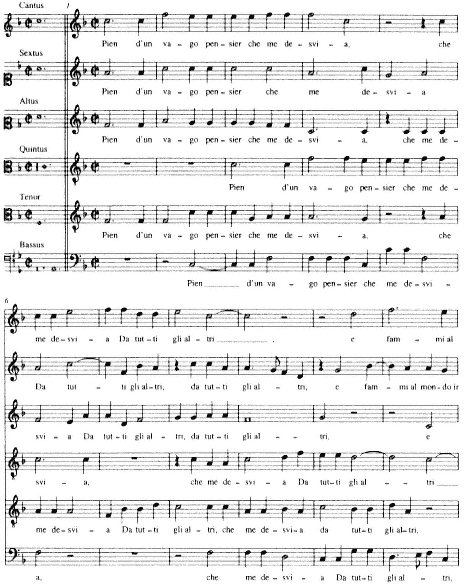
Ex. 14.
Willaert, Pien d'un vago pensier che me desvia (Petrarch, no. 169), incl.;
Musica nova (Venice, 1559), no. 21.
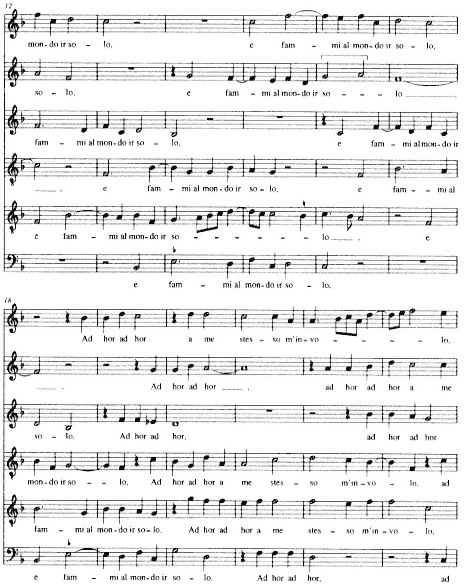
Ex. 14
(continued)
(continued on next page)
(continued from previous page)
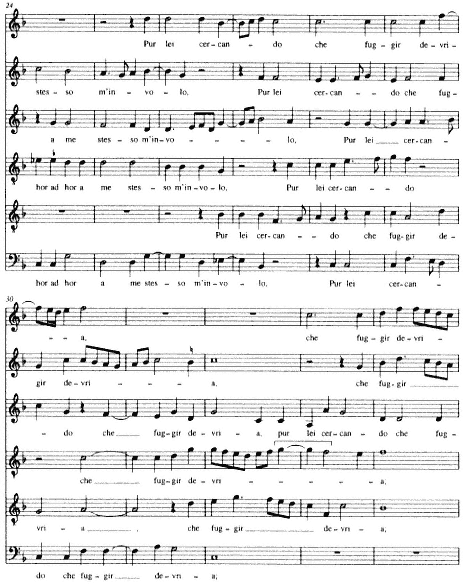
Ex. 14
(continued)
(continued on next page)
(continued from previous page)
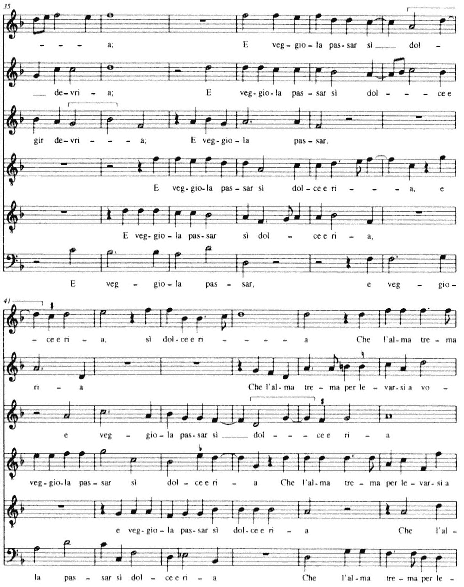
Ex. 14
(continued)
(continued on next page)
(continued from previous page)
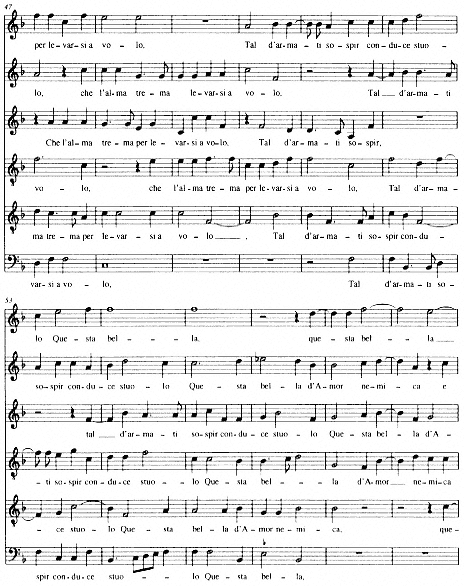
Ex. 14
(continued)
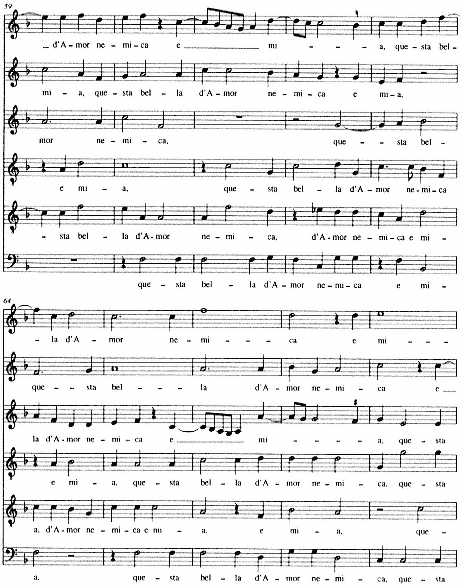
Ex. 14
(continued)
(continued)
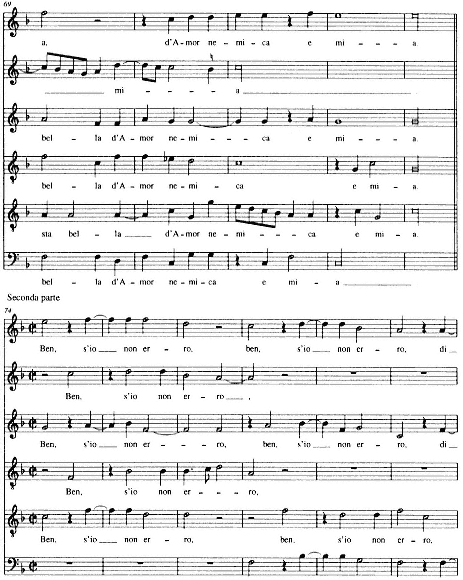
Ex. 14
(continued)
(continued)
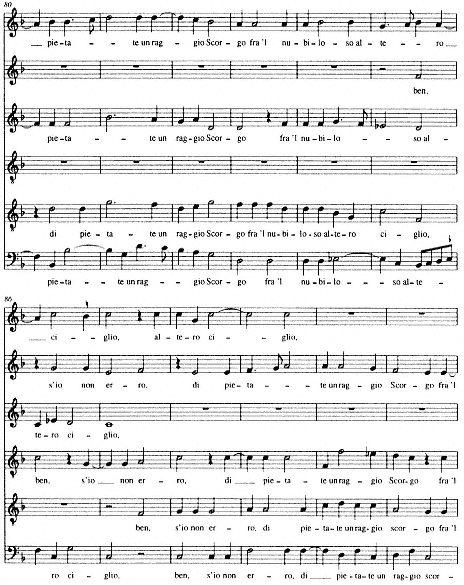
Ex. 14
(continued)
(continued)
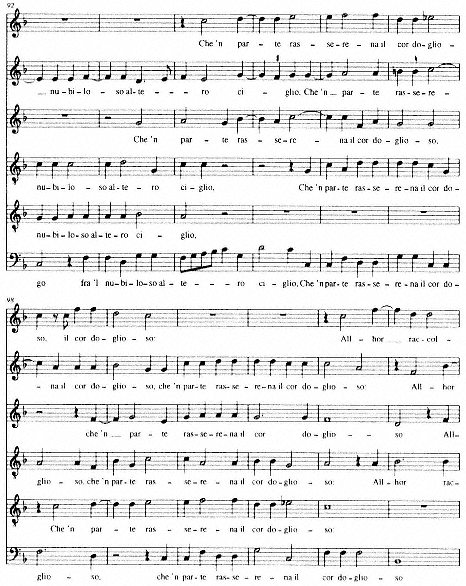
Ex. 14
(continued)
(continued)
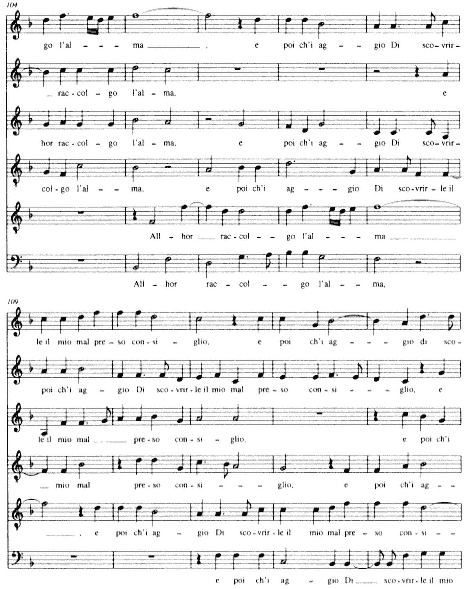
Ex. 14
(continued)
(continued)
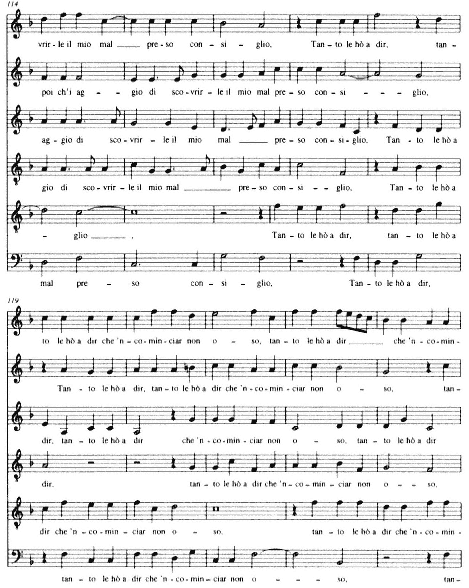
Ex. 14
(continued)
(continued)
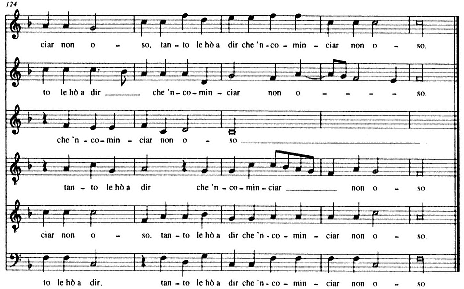
Ex. 14
and the quintus returns it to the tactus with a ubiquitous double-minim figure (m. 97). Both altus and cantus apply agogic accent — prolongation — while the quintus relies wholly on the always unambiguous tonic accent. (A comparable kind of variety obtains with the secondary accent, par - of "parte" near the beginning of the line.) The combined effect of this technique is a lack of any unified polyphonic assertion of meter. In its place a constantly shifting metric polyphony coalesces — faint in its overall level of stress, but pulsating with gentle, inexorable uniformity in the background.
Only on rare occasions, when striking sounds or rhythms appear in the verse, did Willaert project text with a single rhythmic gesture. By contrast with the foregoing, for instance, witness in Ex. 15 the relatively consistent way he set "e rompr'ogn'aspro scoglio" (v. 6 from the five-voice Giunto m'ha Amor fra belle e crude braccia ), with its coarse mouthfuls of r 's, double and triple consonantal clusters, and sonorous a 's and o 's.[47]
This avoidance of clear motivic and metric definition has a parallel in Willaert's cultivation of variegated textures. As successive combinations of freely overlapping voices roam alternately toward homophonic or imitative poles, the various parts constantly rearrange themselves in new configurations. And since every evolving configuration brings with it a new combination of voices, Willaert's vocal color takes on the look of an ever-turning kaleidoscope.[48]
[47] See also the setting of "Romper le pietre," mm. 98ff. from Mentre che 'l cor.
[48] Jonathan Marcus Miller extends my work on Willaert and Rore to argue that both composers constructed their textures in such a way as to bring out clusters of sound, which were in turn designed to help project textual meaning; see "Word-Sound and Musical Texture in the Mid-Sixteenth-Century Venetian Madrigal" (Ph.D. diss., University of North Carolina at Chapel Hill, 1991).
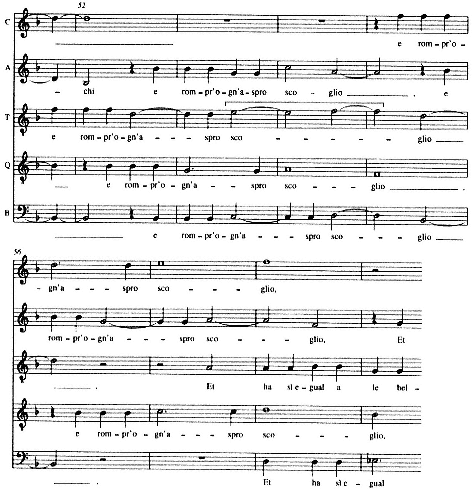
Ex. 15.
Willaert, Giunto m'ha Amor fra belle e crude braccia (Petrarch, no. 171), mm.
52-59; Musica nova (Venice, 1559), no. 11.
These kaleidoscopic effects do not diminish Willaert's ability to shape Petrarch's conceptual patterning in music, as the structural summary of Pien d'un vago pensier in Table 5 makes plain. The schemata of Table 5 necessarily give only a crude picture of the real articulative events in the piece, since the cadences, while intelligible contrapuntally as two-voice formations, are almost always obscured and enervated by the surrounding polyphonic activity of the other voices. Note, for example, that the first cadence, to the perfect octave c/C in tenor and bassus in m. 16, is thoroughly overlapped by multiple, varied assertions of the motive on "e fammi al mondo ir solo" throughout the upper registers. However clear-cut such a two-voice cadence may be, the overall impression conveyed is one of continuity. In a texture like this one, fine gradations in articulation can be projected through the relative strength of preparation and resolution. But such preparation and resolution are rarely unequivocal except at
| ||||||||||||||||||||||||||||||||||||||||||||||||||||||||||||||||||||||||||||||||||||||||||||||||||||||||||||||||||||||||||||||
the end of the prima or seconda parte or at exceptional rhetorical moments and, in any case, are always complicated by other factors — especially texture.
The next cadential gesture at the end of v. 3 (mm. 22-23) presents a different situation, related to the ubiquitous technique that Zarlino dubbed "fuggir la cadenza." The cadence is conspicuously prepared but its resolution is foiled as it moves from an intended penultimate sonority on a C-major triad to one on c-minor. The cadential cantus falls silent at its expected moment of arrival on ff at m. 24 (one of Zarlino's standard "evasion" techniques), replaced by a jarring cross relation, ee/e-flat, with the quintus.
Despite this constant undercutting, Willaert's complex cadential formations do not hinder the goal of supporting Petrarch's linguistic and thematic articulations.
Quite the contrary; they aid it by complementing Petrarch's verbal hierarchy with a musical one, at least within the subtle band of utterance Willaert's idiom allows. Willaert's Musica nova settings generally vary the degree to which cadences are made strong or weak through a judicious deployment of perfect and imperfect cadences, extravagant cadences, different sorts of evasions, and rests. In Pien d'un vago pensier Willaert varied articulative weight, modifying the number of cadential gestures successively deployed by shifting voice pairs for a given portion of text. Mild but calculated cadential repetition is key to such a strategy. By means of sheer repetition, Willaert strengthened the conclusions of each of the independent clauses that end the two quatrains (mm. 30, 32, 34, and 36; mm. 63, 68, 71, and 73) — even though the gestures taken singly are not especially strong — and in accordance with Zarlino's dictum that textual repetitions be limited to significant parts of a text. Cadences are also positioned carefully in different tessituras according to grammatical weight. Thus while the lower voices bury their cadence under continuous upper-voice melody when ending a mere dependent clause at m. 16, three of the four cadences that end the main clause of the first quatrain are exposed in the uppermost register (mm. 30-36).
Verse 12 shows how shrewdly Willaert coordinates these articulations with the main structural divisions of the sonnet. At this juncture, two striking cadences demarcate the poet's progress following the rhetorically crucial "Allor raccolgo I'alma." Though standing in formal isolation, prosodically unhinged, these words signal the poem's spiritual turning point. Willaert's setting highlights them with an independent melody and a turn to somewhat broadened rhythmic gestures. As the declamation slows, the semibreves allow the resonant a 's, o 's, and the double consonants to breathe, creating assonance in accented and unaccented syllables alike and a deceleration that marks at once the text's grammatical structure and its "grave" rhetorical character.[49]
The value of Willaert's reading is both immediate and contextual, since it sets up the musico-dramatic pacing of the remainder of the sonnet. The long phrases subsequently assigned to "e poi ch'i aggio / Di scovrirle il mio mal preso consiglio" (vv. 12-13) in order to span the enjambment contrast with the relatively short ones that have just been heard. Further, by returning to a predominant minim motion, the music resumes its insistent pace and starts to marshall the more bustling texture with which Willaert generally approached sectional endings. Willaert sustains both qualities through the final verse and heightens their rhetorical effects with a flood of closely spaced entrances for "Tanto le ho à dir," a new voice entering nearly every semibreve from mm. 116 to 123.
Willaert's organization of cadences supports these subtle interactions of meaning and prosody as much as it does grammatical weight. To consider how this operates,
[49] Willaert generally used this technique to distinguish the articulations between quatrains and tercets. See, for instance, the transitions from vv. 4-5 in L'aura mia sacra (m. 49) and Giunto m'ha Amor (mm. 39-40); and from vv. 11-12 in L'aura mia sacra (mm. 92-93) and Cantai, hor piango (mm. 96-97); Willaert, Opera omnia, vol. 13.
let us assume (with Zarlino) that a background modal conception underlies the madrigal's overall pitch plan. Zarlino assigned Pien d'un vago pensier to mode 11,[50] transposed Ionian authentic as conceived within Glareanus's twelve-mode numbering system, or mode 5 (authentic Lydian) in the traditional eight-mode system. Cantus, tenor, and quintus are all in authentic ranges, sextus, altus, and bassus in plagal. Willaert's setting concentrates cadences on the primary cadential degrees of the mode, the final F and confinal c. As shown in Table 5, the dependent clause of vv. 1-2 moves to the confinal, while three of the cadences ending the main clause in v. 4 (mm. 30, 34, and 36) form cadences on the final (albeit enfeebled by lower voices moving to the secondary degrees a, b-flat, and dd, respectively). In this mode all theorists of modal polyphony ranked the medial a just below the final and confinal in terms of cadential weight, and most named E, D, G, and b-flat as secondary degrees, permissible for internal cadences.[51] The remainder of the prima parte constructs a neat bit of tonal architecture, with a supporting the main clause that begins the second quatrain (m. 46) and a series of cadences emphasizing the final's antipole of C in the approach and conclusion of the octave. Not until the clause "Allor raccolgo l'alma" returns in v. 12 does Willaert cadence again on the final, and there he does so twice — once on the fifth ff/b-flat (m. 105), next on a perfect octave, f/F (m. 108).
Yet the point should be made again that none of these cadences comes close to halting or delaying the ongoing polyphonic motion. As a result of this continuity, everything takes place within a general gestalt of sameness, a contrapuntal feature of all Musica nova madrigals but a particular tonal characteristic of those in F-mollis. As if dabbing on empty canvases Willaert brightened them only with the lightest coloristic touches, in bursts like firefly shimmer, to conjure up vivid local moments.
Pitch color thus manages — and is managed by means of — two basic strategies: one involves choosing pitches gauged to help bring out hierarchic interrelationships of poetic syntax; the other involves accommodating the exigencies of these syntactic concerns to the subdued demeanor of the whole collection. At the local level of coloristic events Willaert pits relative stability against instability toward expressive ends, just as he does at the more architectonic level of cadential design. Just before restoring the final F in v. 12, for example, he presses B-flats and E-flats plaintively on the "cor doglioso" of the relative clause in v. 11. This turn to the flat side easily catches the ear, despite its mildness, because Willaert uses it only rarely. (Another set of E-flat inflections [mm. 19 and 24] follows the self-exodus narrated in v. 3, "Ad hor ad hor a me stesso m'involo.")
Flatted inflections often participate in larger processes of stabilization and destabilization that are regulated by Willaert's frequent use of circles of fifths. The preva-
[50] Istitutioni harmoniche, p. 333.
[51] For a summary of theorists' writings on this matter, see Bernhard Meier, The Modes of Classical Vocal Polyphony Described according to the Sources, trans. Ellen S. Beebe, rev. ed. (New York, 1988), pp. 101-22 (and for discussion of the cadence plan of a work by Wert in the same mode, pp. 158ff.).
lence of circle-of-fifth progressions offsets the potential that the melodies and counterpoint might be enervated by a certain aimlessness. In the passage just discussed, Willaert explores the flat side within fifth progressions in a way that reinforces poetic motion toward the syntactic/rhetorical goal: the E-flat triad of m. 18 moves backward through a circle of fifths all the way to one on a-minor (m. 21); and a briefer circle of fifths from a B-flat-major triad to one on d-minor (mm. 23-25) overarches the false resolution of the C-major sonority to c-minor.[52] This regulation of the flat side through the strong harmonic directedness of fifth progressions allows Willaert to convey the text in a way that appeals directly to the senses, instead of simply matching the poet's flight in a purely formal or iconic way.
Some of these circles of fifths do not project verbal meaning directly but simply help propel the counterpoint toward an imminent syntactic goal. In mm. 120-22, for instance, Willaert intensifies the repetitions of "tanto le ho a dir" by means of a fifth progression from a d-minor triad to one on B-flat. This is only the longest of several sequences of fifths that help strengthen the drive toward the final cadence (cf. mm. 114-16 and 125-26). In tonally static madrigals like this one, which oscillate along an F-C axis with little real movement toward an alternate tonal target, the sense of harmonic direction provides a vital source of kinetic energy.[53]
Willaert's coloristic techniques play another role in subtly resolving local syntactic ambiguities. To understand the interaction of tonal color and syntax at this local level, one needs to consider how Willaert copes with Petrarch's complex verbal constructions. Invariably, Musica nova settings parse words as prose rather than as verse, ostensibly linking proselike readings with dignity and gravity in the same way literary theorists like Daniello and Tomitano did in advocating proselike syntax for poets writing high lyric verse.[54] In these madrigals the juncture between words and music had thus fully shifted from the poetic line to the syntactic unit. As noted earlier, this meant that the enjambments favored by literati for sonnets ran rampant in Venetians' musical phrasings,[55] causing the textual units to fall out in unpoetic and highly asymmetrical arrangements.
Even this rule of thumb could not produce all the necessary solutions about how to parse a given text, however, since not all verbal constructions unequivocally suggested a single prose reading. Indeed, Pien d'un vago pensier includes one of the most ambiguous, Latinate lines Petrarch ever wrote, v. 8: "Questa bella d'Amor
[52] Cf. also the circle of fifths from the end of m. 96 to m. 98.
[53] Gary Tomlinson has noted this phenomenon as part of the pastoral topos employed by Wert, Marenzio, and Monteverdi, in Monteverdi and the End of the Renaissance (Berkeley and Los Angeles, 1987); see also Chap. 8 below, nn. 24 and 25.
[54] See Chap. 5 above, nn. 122 and 133.
[55] In addition to the comments on enjambment cited in Chap. 5 above, nn. 142-44, see also Torquato Tasso's praise of Giovanni della Casa's use of the technique in his "Lezione sopra Questa mortal vita, " discussed in Gary Tomlinson, "Rinuccini, Peri, Monteverdi, and the Humanist Heritage of Opera" (Ph.D. diss., University of California at Berkeley, 1979), pp. 55-57.
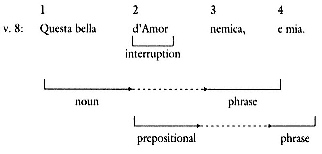
Fig. 1A
nemica, e mia."[56] Structurally, this is a line that evokes the mercurial quality of Petrarch's elusive lady. It rends the Petrarchan oxymoron on the beloved, the "bella nemica," with the intrusive "d'Amor" to form four disconnected grammatical units, as shown in Fig. 1a. Here the four constituents stand in a kind of chiastic relationship to one another, each of them one position removed from its proper neighbor. But the elements can also be considered in another way, as suggested in Fig. 1b. In this reading "questa bella" forms a complete and independent substantive, if a disarmingly casual one in Petrarchan discourse for reference to Laura. "Nemica" then counts as a second noun phrase troping "questa bella," and "d'Amor" a prepositional phrase defining simply "nemica." The possessive "mia," free-floating outside the main frame of the line, might be thought to define either "bella" or "nemica," or both, depending on how the reader perceives the line; its indeterminacy proceeds from the vagueness of the substantive, without which "mia" has no point of reference. Since Petrarchan commentators of Willaert's time seem consistently to have read the line as in Fig. 1a (as we will see Willaert appears to have done also), it seems fair to take this as our point of departure.[57]
The severed noun phrase of line 8 surprises, since even Petrarch's mannered norms did not usually allow for it. But the ambiguities thus created are a vital part of the line's rhetorical effect and its meaning. "Amor" is not only the intruder in the syntactic process but the culprit in the fractious vision of the poem as a whole. As hinted above, the witty dissociation of "e mia," combined with the line's lack of an unambiguous substantive, robs it of a clear grammatical affiliation and hence mean-
[56] For a fuller discussion of Willaert's syntactic strategies see my "Composer as Exegete: Interpretations of Petrarchan Syntax in the Venetian Madrigal," Studi musicali 18 (1989): 203-38, of which pp. 212-16 have been adapted for what follows. A broader appraisal of medieval and Renaissance concepts of syntax may be found in W. Keith Percival, "Deep and Surface Structure Concepts in Renaissance and Medieval Syntactic Theory," in History of Linguistic Thought and Contemporary Linguistics, ed. Herman Parret (Berlin and New York, 1976), pp. 238-53.
[57] Sixteenth-century commentators tended to restore the oxymoron with the paraphrase "Questa bella nemica d'Amor, e mia," with no comma after "bella" that would designate it a noun. See, for example, Sonetti, canzoni, e triomphi di Messer Francesco Petrarca con la spositione di Bernardino Daniello da Lucca (Venice, 1541), fol. 113; and Le rime del Petrarca brevemente sposte per Lodovico Castelvetro . . . (Basel, 1582), p. 312.
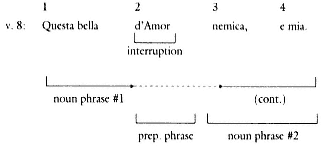
Fig. 1B
ing (my lovely one? my lovely enemy? mine and Love's?). The disorientation of "mia" comments on the slippery nature of the thing possessed; yet its dangling isolation, a structural means of semantic emphasis, accentuates at the same time the quality of possession.
Given Willaert's concern for linguistic coherence the line presented declamatory problems and perhaps inevitably invited multiple, fragmentary readings.[58] By offering a number of different fragments of the line Willaert was able to comment both on the nature of the fragmentation and on the grammatical interrelationships of the verse. Much of it he parsed in such a way as to unify the noun phrase "questa bella nemica": two outer voices initially present "questa bella" alone with a separate, lingering melodic figure, but immediately afterward all six declaim the verse in integral phrases up to the word "nemica." This bit of text, the one most frequently stated, fuses in a single melodic gesture the subject "nemica" with its qualifying adjective "bella." We might say that Willaert admitted the ambiguity and then resolved it: "Questa bella . . .," "Questa bella d'Amor nemica. "
In the tenor, by contrast, beginning in m. 62, Willaert linked the other disjointed verbal elements indicated in Fig. 1a by deploying a different textual fragment: "d'Amor nemica, e mia." This is the only time in this lengthy exposition when "e mia" joins directly any other portion of the verse, and the reason for it seems clear. Without the suspended adjectives "questa bella," no consolidation of the noun phrase (as obtained by ending with the word "nemica") is required. The phrase "d'Amor nemica, e mia" instead serves to unify words that function in essence as two prepositional phrases: "d'Amor" and "e mia" (that is, "d'Amor, e di me"). Now, for the only time in the whole passage, "e mia" is sung twice in a row (tenor, mm. 65-67) — repeated, that is, without first returning to an earlier part of the verse. Through this repetition and other isolated statements, Willaert took advantage of the line's grammatical self-sufficiency up to the word "nemica" to heighten the broken pathos that "e mia" inflicts on the octave's ending.
[58] For another example of varied parsing in Willaert's settings (of which there are many) see my comments on his Cantai, hor piango, e non men di dolcezza, vv. 1-2, in Chap. 9 nn. 41ff., below.
Just as telling as the many textual fragments that Willaert used here are those he avoided. Most important, the whole verse is never set to an unbroken melodic phrase. We should not underestimate the significance of this in a lengthy passage that provides so many diverse statements. Willaert seems to have considered presentation of the verse in a single phrase unintelligible, or insufficiently interpretive. Also, the words of the prepositional phrase "d'Amor" are invariably joined to the succeeding subject "nemica," as if one were a necessary rhetorical consequent of the other. Willaert's consistent linking of these words reduces the confusion created in the verse by the interjected "d'Amor" while preserving its descriptive role (this of-Love enemy).
To return, finally, to the question of tonal color, Willaert exploits the contrast of stable and unstable pitches to help underscore syntactic articulations. The dispassionate pitches F and C function as recurrent, if fleeting, points of repose for the words nemica and mia, words that conclude the severed syntactic units to which each belongs. The effect is striking at the two perfect cadences on C of mm. 63 and 71 and at the cadence on the perfect fifth g/C at m. 68. But it can also be perceived at numerous melodic markers. If we follow the soggetto in the cantus from m. 53 through the cadence in m. 63 and continue tracing the text repetitions in the cantus through to m. 73, we find an almost dogged insistence on ff and cc as points of departure (mm. 60, 63, and 70), arrival (mm. 60, 63, 69), and melodic accentuation (m. 57, 59, 65, and 66). When the soggetto appears in the altus in m. 64, its melodic line is anchored between F and c at mm. 68 and 71, respectively.
The way these pitches function tonally echoes the madrigal's placid opening exposition, especially in mm. 1-17, where F and C dominate the tonal space, undulating back and forth but essentially locked in tonal stasis. They form a striking contrast to the delicate E-flat inflections in the setting of v. 8, which instead suggest incompleteness and uncertainty. Willaert uses these accidentals to shade the text locally: they occur only on the syntactically open and ambiguous words "bella" and "d'Amor" — a pair of E-flats on the first syllable of "bella" in m. 56 and one on the first syllable of "d'Amor" in m. 62. In this way, both here and elsewhere in the madrigal, flatted inflections form restless counterpoises to more tranquil surrounding areas.
In singling out Pien d'un vago pensier for discussion I have tried to represent Willaert's private style at its most undemonstrative — which is to say its most typical. Where he might have opted for gripping contrasts or dramatic expressivity, Willaert instead kept to a subdued poetic reading. The paucity of all but the weakest articulation, the ubiquitous motivic variation, shifting textures, and kaleidoscopic shifts of vocal color yield a sense of continual, quiet unfolding that Willaert's discursive declamation does little to disturb. The constantly varied materials that produce such a dense contrapuntal web served, I have argued, to project the attitude of decorum advocated by Venetian literati. Beyond this, the sacred rhetoric Willaert adapted encoded the quality of reverence — a reverence that points outwardly toward the
unattainable woman, but covertly to a rarified discourse of self-contemplation and lyric creation.
It was thus precisely through this highly localized process of incessant, subtle variation, rather than a patchwork of contrasts, that Willaert's late madrigals were able to meet contemporary rhetorical ideals of decorum and variation. This localized instantiation of rhetorical principles is consistent with the particular way in which Bembo codified them. Recall that his dialectic of variazione took shape through the opposing qualities of gravità and piacevolezza, whose interactions he (and his followers) mostly illustrated in shadings of local events. At the level of the poetic line this meant contrasts of accents, phonemes and letters, elisions, and syllable lengths; and at the next higher level those of line lengths, rhymes, and rhyme schemes. As a rule Willaert departed from making delicate chiaroscuro effects through timbre, meter, and pitch only when his text embodied clear-cut oppositions that cried out for bald contrasts. One such instance, much-cited in modern literature, is the exposition of his six-voice Aspro core e selvaggio e cruda voglia (no. 265), whose opening two verses are particularly susceptible to dialectical opposition.[59]
Aspro core e selvaggio e cruda voglia A harsh, savage heart and cruel desire
In dolce, humile, angelica figura In a sweet, humble, angelic form
Willaert echoed the verses' natural declamatory rhythms by contrasting the choppy dissonance of the poet's charges in v. 1 with the graceful sdrucciolo accent of his encomiastic "angelica" in v. 2 (Ex. 16). The declamation of the first is martial, based on the tactus; much of the second gently syncopated. As Claude V. Palisca has pointed out, a wealth of linear and contrapuntal progressions also articulate qualities of gravità and piacevolezza. Major sixths moving to perfect fifths and parallel major thirds — both described by Vincenzo Galilei as justifiable transgressions of counterpoint rules for the sake of imitating the text — dominate the harmonic movement in the first verse, but disappear in the flatted environment of the second.[60] Verse 1
[59] See the discussions by Dean T. Mace, "Pietro Bembo and the Literary Origins of the Italian Madrigal," The Musical Quarterly 55 (1969): 78-80, Claude V. Palisca, Humanism in Italian Renaissance Musical Thought (New Haven, 1986), pp. 357-67, and Armen Carapetyan, "The Musica Nova of Adriano Willaert: With a Special Reference to the Humanistic Society of 16th-Century Venice" (Ph.D. diss., Harvard University, 1945), pp. 188 and 255-57.
[60] The rule violated is one making imperfect consonances go to the closest perfect ones. Palisca notes that Galilei drew attention to the device in his Fronimo dialogo, nel quale si contengono le vere, et necessarie regole del intavolare la musica nel liuto (Venice, 1568), p. 13: "Patisce secondariamente eccettione ne l'imitatione delle parole, come bene lo manifestò fra gl'altri eccellenti musici in piu luoghi il famoso Adriano, & particolarmente nel principio di quella sua dotta Canzone, che gia compose à sei voci, qual comincia. Aspro core, & et seluaggio & cruda voglia, dove passa piu volte (per esprimere con gratia tal concetto,) non Solo dalla Sesta maggiore alla Quinta ma da una Terza maggior à l'altra col mouimento congiunto, & piacendoui serverò à vn'altra volta il mostrarui maggiormente l'eccelentia di questo condimento della musica" ([This may be broken] in imitating the words, as the famous Adrian did (among other composers) in the beginning of that learned music he composed for six voices on the sonnet of Petrarch which begins Aspro core, e selvaggio, & cruda voglia. There several times, in order to express the subject with grace, he passes not only from a major sixth to a fifth, but from a major third to another by conjunct movement. I shall save for another time to demonstrate the excellence of this musical seasoning); quoted in Humanism in Italian Renaissance Musical Thought, pp. 357 and 362 n. 60.
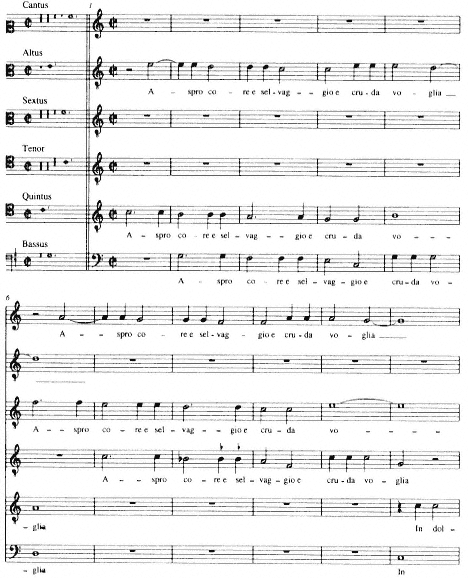
Ex. 16.
Willaert, Aspro core e selvaggio e cruda voglia (Petrarch, no. 265), mm. 1-22;
Musica nova (Venice, 1559), no. 14.
(continued on next page)
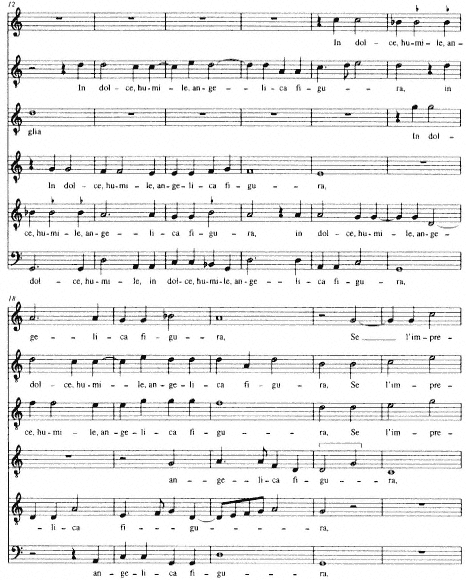
Ex. 16
(continued)
moves largely by melodic major seconds and major thirds and v. 2 by minor seconds and thirds and minor sixths, thus complementing the first verse's consonantal clusters and the liquids of the second (and recalling Zarlino's injunctions in Part IV, Chapter 32). Palisca also notes the tendency of the bass to move up by fifth and down by fourth for v. 1 and vice versa (down by fifth and up by fourth) for v. 2, tendencies Galilei associated with happiness, excitation, virility, and naturalness on the one hand and sad and subdued effects on the other.[61]
Willaert's interest in such dichotomies may seem clear in this instance, but it is rare that his Musica nova settings conform so straightforwardly to Bembist principles. Only three other cases, all again mainly notable for their exordia, are as striking in this respect as Aspro core. These include the pair of six-voice settings, I piansi, hor canto, che'l celeste lume and Cantai, hor piango, et non men di dolcezza ,[62] and the seven-voice Liete e pensose, accompagnate e sole.[63] Both of the first two begin with vivid antitheses that Willaert matched with madrigalisms: florid upturned melismas for singing and doleful sustained notes for weeping. In I piansi the image of weeping also invites a chain of suspensions (a virtual requirement at midcentury), here realized in varied entries of a stepwise descending motive alternating on arsis and thesis. (Quite unusually Willaert delayed the entrance of "hor canto" all the way until m. 9 and with it the establishment of the minim surface rhythm, which normally prevails after the first measure or two.)
The third setting that plays obviously with this sort of musical dialectic again embodies dualities codified by Bembo, especially in its octave.
"Liete e pensose, accompagnate e sole, "Happy and sad, in company and alone,
Donne che ragionando ite per via: Ladies who go talking by the way,
Ov'è la vita, ove la morte mia? Where is my life, my death?
Perché non è con voi com'ella sòle?" Why is she not with you as she is wont to be?" 4
"Liete siam per memoria di quel sole, "Happy are we in thinking of that sun;
Dogliose per sua dolce compagnia We are sad because we lack her company,
La qual ne toglie invidia et gelosia Which envious jealousy takes from us,
Che d'altrui ben quasi suo mal si dole." Grieving at another's good as if at its own harm." 8
[61] See Vincenzo Galilei, Dialogo della musica antica, et della moderna (Florence, 1581), p. 76.
[62] As in Petrarch's Canzoniere, the Musica nova places them side by side (though in reverse order). Discussions of this pair in the secondary literature can be found in Einstein, The Italian Madrigal 1:335-37; Willaert, Opera omnia 13:iv and v; Carapetyan, "The Musica nova of Adriano Willaert," pp. 164, 188, and 259-60; and Howard Mayer Brown, Music in the Renaissance (Englewood Cliffs, N.J., 1976), pp. 200-202. On Cantai, hor piango see also Bernhard Meier, "Rhetorical Aspects of Renaissance Modes," Journal of the Royal Musical Association 115 (1990): 183-84.
[63] Opera omnia 13:108-14. Liete e pensose is one of the two madrigals (along with Aspro core ) singled out by Mace for discussion ("The Literary Origins of the Italian Madrigal," pp. 80-83). Among the many other discussions of the madrigal are: Erich Hertzmann, Adrian Willaert in der weltlichen Vokalmusik seiner Zeit: Ein Beitrag zur Entwicklungsgeschichte der niederländisch-französischen und italienischen Liedformen in der ersten Hälfte des 16. Jahrhunderts (Leipzig, 1931), p. 53; Carapetyan, "The Musica nova of Adriano Willaert," pp. 118, 148, 185-86; Einstein, The Italian Madrigal 1:339; Willaert, Opera omnia 13:v; Helga Meier, "Zur Chronologie der Musica Nova Adriaen Willaerts," Analecta musicologica 12 (1973): 78; B. Meier, The Modes, pp. 126-28, 415; and David Alan Nutter, "The Italian Polyphonic Dialogue of the Sixteenth Century" (Ph.D. diss., University of Nottingham, 1978), 1:55.
These were lines ripe for the madrigalist's picking. Throughout the octave positive sentiments are keyed to the bright vowels e and i ("liete" and "vita," as well as the more neutral a , as in "accompagnate") and gloomier ones to the dark vowel o ("pen-sose," "sole," "morte," "dogliose"). Some of the contrasting terms are set in parallel structures that help tag rhythmically both meaning and sound: in v. I "liete" and "accompagnate" pair up as the first and corresponding terms in each syntactic entity and "pensose" and "sole" as the second — the second half of the verse thus echoing the first.
By articulating the syntactic inflections with rests and providing certain brightvoweled words with rising melodies and dark-voweled words with descending ones, Willaert intensified such parallelisms, as seen in Ex. 17. The four-voice group assigned to the first quatrain is divided into four sections, essentially one for each adjective. Willaert distinguished each through the contrast of major and minor intervals, both vertical and linear, in the uppermost voice: the major chords G and C and a melodic major second fall on "liete" and the minor chords a and d and a prominently accented melodic minor second, f to e, on "e pensose." Thereafter the "morte"/"vita" antithesis of v. 3 is expressed through similar means and further set off by parallel melodic motives in the altus — three repeated d's turning upward on "vita," downward on "morte."
Verse 5 summarizes the diverse syntactic and sentimental elements of the initial quatrain. By transferring to its outer limits both the words flanking v. 1 — "liete" and "sole" — Petrarch clarified their semantic relationship. The ladies' metaphoric recollection of Laura as that "sole," still resonating with its initial adjectival meaning, reminds the informed reader that she represents inseparably both happiness and loneliness. The new context of "liete" and "sole" in v. 5 thus enriches the words' meaning and consolidates them syntactically. As "Liete e pensose, accompagnate e sole" is recast as: "Liete siam per memoria di quel sole," that same "sole" which first conveyed desolation becomes, after the triple pun, a metaphor for the beloved who "sole" (both "alone" and "like the sun") in her radiance can produce happiness. Willaert's setting of v. 5 reflects this consolidation of symbol, syntax, and sense by delivering it in a single phrase, uninterrupted save short rests by cantus and sextus. It also reinterprets the final a-minor chord of v. 1's "sole" (m. 8) as A-major for that of v. 5 (m. 41). Moreover, the sextus and tenor, in mimicking the opening melodic material of septimus and altus, strengthen the correspondence between this verse and the first, helping to reinforce its special role in the octave.
I have touched on these four madrigals not only because all four trade in what are for Willaert uncommonly extroverted exordia, but because they have been the works most often cited from the Musica nova. In an important sense, they have formed the basis of widespread conceptions about Willaert's style. Their exemplary status in the musicological literature has lent support to certain representations of
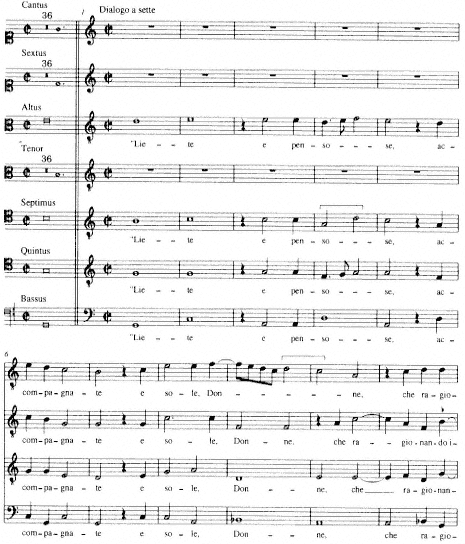
Ex. 17.
Willaert, Liete e pensose, accompagnate e sole (Petrarch, no. 222), mm. 1-42;
Musica nova (Venice, 1559), no. 23.
(continued on next page)
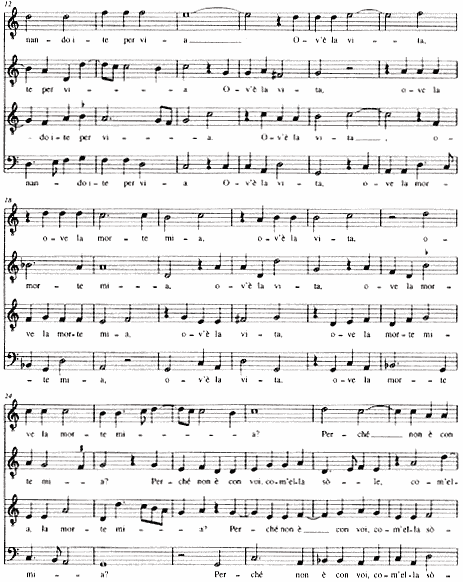
Ex. 17
(continued)
(continued on next page)
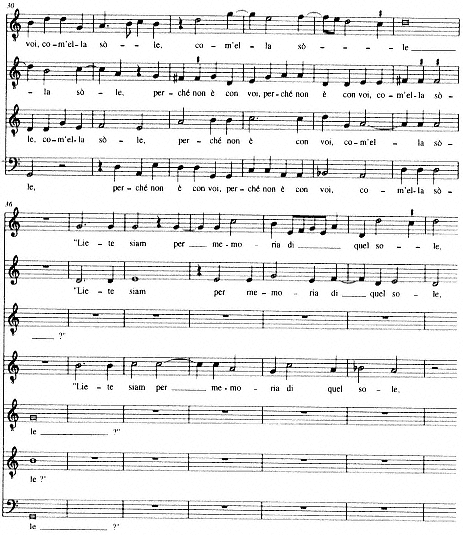
Ex. 17
(continued)
Willaert's new style as expressively vivid and given to musical symbolism, a representation first made by Gustave Reese. In asserting this, Reese isolated in the encyclopedic preserves of Music in the Renaissance only one tiny passage from the collection, a brief melisma on "cantando" from the otherwise archly spare Mentre che 'l cor.[64] His account of Musica nova style antedated the cross-disciplinary thinking that has since linked Willaert's madrigals to Bembo's ideas; it fell in better with teleological portrayals of madrigalian developments that sought to show the genre's increasing skill at mimesis over the course of the century. Like other such portrayals, a baldly mimetic approach seemed to offer the only tangible evidence of music's growing bond with words. It is not surprising that Reese had little else to say about the collection, since the reified textual-motivic links he wished to exemplify had in reality no prominent place in it.
Subsequent accounts have refined thinking about this repertory, yet something of the literalist impulse that guided Reese seems to underlie the expectations that have determined not only how we interpret but what we interpret — which examples have been chosen for close readings. Implicitly, at least, this literalism seems also to have shaped conceptions about the sorts of factors that must have governed Willaert's own readings, especially about how he realized Bembo's ideas: hence the censure, especially of Willaert's stark melody and undifferentiated pacing, that so often alloys praise of Willaert's late music, and the worrying over its lack of contrast.[65] Yet if, as I have insisted, strong juxtapositions were anathema to a Bembist idea of style, then Willaert's expressive reticence should cause neither surprise nor disappointment. I would view his subtly varied soggetti, plain rhythm, modest melody, and continuous musical fabric instead as carefully marshalled participants in his musica nova, a secular music intended to have no precedent or equal in weight and restraint. Willaert's personal conception — shared by his patrons, performers, and listeners — of the Musica nova as a monument to a newly conceived secular genre of the highest order seems clear from any number of features, both internal and external, that I have discussed: its compendious nature including four-, five-, six-, and seven-voice works, its mixing of madrigals with motets, its almost exclusive setting of Petrarch's poems, and its setting of complete sonnets.
Even those works by Willaert farthest from the Musica nova, his canzoni villanesche, seem to confirm the idea that his serious madrigals emerged from a
[64] Rev. ed. (New York, 1959), p. 324.
[65] See Edward E. Lowinsky, who suggests that humanistic demands for perfect declamation were the culprit hindering Willaert's ability to write good melodies: "Willaert's music has no easy appeal. Despite its masterly construction and notwithstanding its virtues of conciseness and elegance, its richness in harmonic color, its unexcelled adaption of the text, its variety of rhythmic and metric structure, it has a certain heaviness, hard to define, rooted perhaps in the absence of a true melodic inspiration. Yet the much freer flight of melody in his four-part ricercari suggests that the exigencies of a humanistically impeccable text setting in all the voices of a polyphonic complex of four, five, six, and more parts worked as a serious impediment to the free unfolding of melody" (Medici Codex 1:80). Similar reservations are voiced in Brown, "Words and Music," p. 228, and Carapetyan, "The Musica Nova of Adriano Willaert," pp. 115 and 147.
Bembist, hence Ciceronian, conception of stylistic propriety.[66] His conscious sense of purpose is evident from the way he codified the lighter style and segregated it (with help from Venetian printers) in separate publications. Indeed, the wholesale bifurcation of secular music into discrete genres, high and low, in Venetian musical production of the 1540s provides one of the clearest signs that Willaert's decorous fashioning of the madrigal was no failure of inspiration but one of the most concerted acts of Ciceronianism to emerge from early modern Venice.[67]
[66] The point is mentioned in Brown ("Words and Music," p. 229), who suggests that diverse genres in the music of Willaert and his students reflected Bembo's classical advocation of different stylistic levels. See also James Haar, who discusses the concern for genre in the period of Bembo's influence in Essays on Italian Poetry and Music in the Renaissance, 1350-1600 (Berkeley and Los Angeles, 1986), pp. 117-18; and idem, "Self-Consciousness about Style, Form, and Genre in 16th-Century Music," Studi musicali 3 (1974): 219-31; and Nino Pirrotta, "Willaert and the Canzone Villanesca ," in Music and Culture in Italy from the Middle Ages to the Baroque: A Collection of Essays (Cambridge, Mass., 1984); p. 179.
[67] The argument laid out in Michèle Fromson's "Themes of Exile in Willaert's Musica nova, " JAMS 47 (1994): 442-87, first came to my attention as this book was in press. Fromson's study contributes to our understanding of the religious background of Florentine republicans but reduces the multivalent cultural geography in which the Musica nova evolved to a single Florentine solution, reading the print's motet and Petrarchan sonnet texts as having registered solely in Florentine terms. I perceive a Florentine accent in Rore's first book but much less of one in Willaert's Musica nova, and I would question whether the romantic narrative of "heroic struggle" and "suicide" (pp. 465-66) that Fromson imposes on Florentine exiles (cf. p. 29 above) can be readily made to fit Neri Capponi, who is in fact the only known Florentine patron of the print. The crucial evidentiary basis of Fromson's thesis is the claim that Willaert's motets and madrigals evoked the Florentines' situation by quoting chants linked to loss and exile, but it is useful to remember here that Willaert's whole modal-melodic language was chant-based and that his melodic style in any case avoided distinctive motives.
Chapter 8—
The Enigma of Rore—
Books One and Two for Five Voices
Willaert's madrigals, like his orderly place in Venice's cultural institutions, form a study in temperance and regularities. Smooth rhythmic pace, orderly projection of syntax, controlled polyphony, and subdued motivic gestures all merged in the style Willaert cultivated for the Musica nova. The consolidation of musical and personal identities with civic image that Willaert embodied as Venice's chief representative of musical decorum stemmed from mutual accommodations between composer and state. Indeed, as we saw in the Preface, the Procuratori who had hired Willaert expressly commended him as a deliberate, cautious man — a reputation admirers elaborated in his role as patriarchal head of the Venetian musical establishment.
Against the patterns of order and moderation that repeat themselves with such uniformity throughout Willaert's biographical and musical legacy, Rore cuts a decidedly more eccentric figure. This is something of a puzzle, since it was Willaert and Rore together whose madrigals of the 1540s formed the pillars of a single musico-literary project. Even a cursory comparison of the madrigals in Willaert's Musica nova with those in Rore's Primo libro a 5 of 1542 reveals correspondences between them that support this association. Both collections are based on Petrarchan sonnets set motetlike in two parts in a broad, contemplative vein. Both embed Petrarch's convoluted language in a dense mass of freely imitative polyphony, shaping it in motives that subtly change from voice to voice. And most important, both attend scrupulously to rhetorical qualities of text — sound, accent, verbal figure, and syntax.
At the same time, Rore showed remarkable independence at age twenty-six when his first book emerged seemingly out of nowhere — independence in both musical style and manner of presentation. In 1542 his works had apparently never been printed before, even in anthologies. Despite this, his Primo libro included, rather unusually, only his own works. Both that book and his Secondo libro of 1544 lacked
the dedications to patrons who typically helped support composers and underwrite their prints. Neither book contains any of the same Petrarchan lyrics found in the Musica nova, although at least some of Willaert's settings of them must have existed by those years. Moreover, the Primo libro transmits some of the most tortured lyrics in Petrarch's Canzoniere, together with several remarkably dramatic modern texts. Whatever external impulses may have urged these poetic choices on him, Rore stands apart in this respect. Not until his Terzo libro a 5 of 1548 did he print a setting of a sonnet also set by Willaert, Quando fra l'altre donne ad hora ad hora (no. 7 in the Musica nova ). Yet any deeper affinities to which such a coincidence might hint pale beside the technical and stylistic departures of the Terzo libro as a whole. With this book came radical innovations in madrigalistic conception, including the transformation of the Venetian madrigal's penchant for the monumental into the form of an immense madrigal cycle, the famed setting of Petrarch's Vergine bella.[1]
Some inkling of these innovations might be inferred from Rore's earlier books. Already in the early 1540s Rore's language was considerably more extroverted than Willaert's. The bold motivic strokes, erratic declamatory pacing, florid melismas, and disjunct melody that appear regularly in Rore's madrigals barely exist in Willaert's, and neither does the graceful cantilena to which they form a foil.[2] Furthermore, Rore accommodated an expanded range of rhythmic values by using black notation for all but two of his madrigals in the Primo libro, a notational style Willaert adopted only a few times in his career.[3] The widened expressivity allowed by black notation made for more expansive madrigals: Willaert's sonnet settings, with their steady declamation, average about 120 measures, whereas Rore's stretch to as many as 164 and routinely over 150.[4] Finally, whereas Willaert invariably broke sonnets into two parts after the octave, Rore divided a number (unconventionally)
[1] Rore's was not the first madrigal cycle to be written but the most ambitious to date. Berchem's six-part setting of Petrarch's sestina Alla dolc'ombra, ranging from three to six voices, is more typical. It appeared in Doni's Dialogo della musica in 1544.
According to Vergelli's dedication to Gottardo Occagna, Rore's Vergine cycle was known in Venice for at least some months before its publication ("già molti mesi fa"), presumably by April of that year (see Chap. 3 above, n. 32, and the purchase entry in the records of the Accademia Filarmonica di Verona cited by Giuseppe Turrini, L'Accademia Filarmonica di Verona dalla fondazione (maggio 1543) al 1600 e il suo patrimonio musicale antico, Atti e memorie della Accademia di Agricoltura, Scienze e Lettere di Verona, no. 18 (Verona, 1941), p. 22.
[2] See James Haar's observations on Rore's melodic grace and individuality and his distinctive exordia, in Essays on Italian Poetry and Music in the Renaissance, 1350-1600 (Berkeley and Los Angeles, 1986), p. 120.
For full scores of madrigals discussed in this chapter see Cipriani Rore, Opera omnia, ed. Bernhard Meier, Corpus mensurabilis musicae, no. 14, AIM, vol. 2 ([Rome], 1963).
[3] The exceptions are nos. 19 and 20. On this issue see Don Harrán, "Rore and the Madrigale Cromatico," Music Review 34 (1973): 66-81, and James Haar, "The Note Nere Madrigal," JAMS 18 (1965): 22-41. Willaert's black-note madrigals include three in the Musica nova, nos. 11, 12, and 13, and four published in anthologies (see Table 2).
[4] The longest is Il mal mi preme e non spavento un hora (164 mm.) in Book One. Close behind it are Quanto più m'avincino al giorno estremo (162 mm.), La vita fugge e non s'arresta un'hora (155 mm.), and Perseguendomi amor al luogo usato (152 mm.), all also from Book One. The sonnet settings in Book Two are somewhat shorter on average, in the range of 130 measures. (I am speaking, of course, of modern transcription, with either the breve in white notation or the semibreve in black notation equivalent to a transcribed measure.)
after the first quatrain, in line with rhetorical suggestions in their texts; for others he made no division at all.[5]
We can scarcely begin to weigh these differences without adding into the balance the mysteries of Rore's biography before he arrived at his earliest known post, in Ferrara, at latest in April or May 1546.[6] The only patrons who can be linked definitively to him in his pre-Ferrarese years in Italy are Ruberto Strozzi and Neri Capponi. As I showed in Chapter 2, Strozzi spent most of his time between about July 1538 until the late summer of 1542 in Venice. To recapitulate the most salient data on Venice's Florentine colony, the dedication to Strozzi by his viol teacher Silvestro Ganassi dal Fontego strongly suggests that musical gatherings took place at the Strozzi's Venetian house at San Canciano, probably with Ganassi participating. Capponi, who bought music from Rore as well, was evidently settled in Venice from late 1538 through at least 1544. In the early 1540s, Rore made one documented trip to Venice — and probably many more — when he visited Capponi's salon, delivered madrigals to him, and apparently made revisions (possibly with Willaert's advice).[7] From what we know, Rore probably lived mainly in Brescia, rather than Venice, before moving to Ferrara. But throughout the early 1540s his stock must have been high among cognoscenti and publishers in Venice and Ferrara (where Strozzi would surely have championed him with the duke): all the evidence suggests Rore stood at the center of those guarded Florentine exchanges that saw the new Italo-Netherlandish idiom as a prized commodity.
These circumstances form the backdrop to Rore's first two books. In a different way each book raises questions about Rore's relationship to Venice: Book One to the genesis of Venetian style, to newer Venetian developments like modal ordering and black notation that appeared in the most modish prints, and to Willaert; Book Two to the eclecticism and occasional side of Venetian print culture, to the genre of anthologistic prints it produced, and to the directions taken up by less celebrated contemporaries. The remarkable changes appearing in Rore's Third Book lead ultimately out of the muted rhetoric practiced by Venetian madrigalists and into the more demonstrative style of Rore's late madrigals and madrigals by his students Giaches de Wert and Luzzasco Luzzaschi working in northern Italian courts. I will return to these directions in Chapter 10, after assessing the response Willaert's immediate students at San Marco made to the stylistic equipoise — this narrow play of alternatives — that was formed between Willaert's Musica nova and Rore's first two books.
[5] Sonnets that divide after the quatrain include nos. 9, 15, and 16 in Book One and nos. 16, 20, and 24 in Book Three. Sonnets set with no division include no. 6 in Book One and no. 21 in Book Three. Willaert sometimes did the same, as in Qual anima ignorante, published in Rore's Book Two, but never in setting Petrarch's sonnets.
[6] See Jessie Ann Owens, "The Milan Partbooks: Evidence of Cipriano de Rore's Compositional Process," JAMS 37 (1984): 270-98. Further citations for what follows can be found in Chap. 2 above, nn. 3 and 35.
[7] This was shortly after Strozzi left Venice. See Richard J. Agee, "Ruberto Strozzi and the Early Madrigal," JAMS 36 (1983): 12-13, and Chap. 2 above, n. 35 and Table 1.
Madrigali a Cinque Voci (1542): Petrarchan Woods in the Shadow of Dante
The twenty poems of Rore's First Book form a corpus of intriguing thematic tendencies. Several overlapping textual motifs recur often enough to raise the possibility that a loosely related thematics influenced the way the book was shaped, even if it carried no overarching lyric program. Central to these thematics is what I have elsewhere described as a dissident strain of Danteism manifest in extremes of materia and forma — harsh subjects delivered in rough-hewn language — that most contemporary critics must have sensed as dangerously uncontained.[8] To be sure, the book's outward alliance with the puristic variety of Petrarchism found in Venice, which was just then being adapted to musical repertory, belies this "Dantean" strain: twelve of the book's twenty settings are of Petrarch. Nonetheless, the combination of dramatic Petrarchan sonnets and starkly graphic modern ones betrays leanings quite alien to the orthodox Petrarchism of Bembo and his adherents.
To its audience in 1542 what must have seemed most remarkable about the collection were the sixteen sonnets, grouped contiguously as nos. 2-17, that make up the main body of the print, as shown in Table 6.[9] No previous book of music had collected so many sonnet settings in one place or rendered them with such intensity. Situated at the peripheries of the print are four lighter poems in less weighty forms — one at the start and three at the end. An informed observer might have noticed symmetries in the placement of these outer numbers too. At the book's extreme ends are its only two ballate, both by the Venetian poet Giovanni Brevio, whose reputation in the city included his minor role in Bernardino Daniello's La poetica published six years earlier.[10] Just inside them sit, toward the front, Petrarch's sonnet Hor che 'l ciel e la terra e 'l vento tace (no. 2) and, at the back, an anonymous cinquecento madrigal Hor che l'aria e la terra (no. 19) that glosses some of the former's famous themes and lexicon. Rore's Hor che l'aria reinforces the parallel by dividing the madrigal's eleven lines (quite unusually) into two halves along the lines of his sonnet setting.
These structural features of the book's layout are compatible with its systematic (and more widely recognized) organization by mode.[11] The Primo libro is the first book known to have been successively ordered by mode according to the traditional numbering 1 to 8 (see Table 6). The plan extends only through no. 17,
[8] See my "Rore's 'selva selvaggia': The Primo libro of 1542," JAMS 42 (1989): 547-603.
[9] The many later editions of the book altered this arrangement substantially through additions, deletions, and reorderings. For listings of these see Il nuovo Vogel 2:1479-85 (nos. 2389-2400) and for Gardane's edition of 1544, Mary S. Lewis, Antonio Gardane, Venetian Music Printer, 1538-1569: A Descriptive Bibliography and Historical Study, vol. 1, 1538-49 (New York, 1988), pp. 429-35 (no. 57).
[10] See Chap. 5 above, n. 10. The poems appear in Giovanni Brevio, Rime e prose volgari di M. Giovanni Brevio (Venice, 1545), fols. B V and C III'.
[11] On modal organization in Rore's madrigals see Bernhard Meier, The Modes of Classical Vocal Polyphony Described according to the Sources, trans. Ellen S. Beebe, rev. ed. (New York, 1988), and Jessie Ann Owens, "Mode in the Madrigals of Cipriano de Rore," in Essays in Italian Music in the Cinquecento, Altro Polo, ed. Richard Charteris (Sydney, 1990), pp. 1-15.
| ||||||||||||||||||||||||||||||||||||||||||||||||||||||||||||||||||||||||||||||||||||||||||||||||||||||||||||||||||||||||
(Table continued on next page)
(Table continued from previous page)
| ||||||||||||||||||||||||||||||||||||||||||||||||||||||||||||||||||||||||||||||||||||||||||||||||||||||||||||||||||||||||||||||
however, the same place that marks the end of the bank of sonnets.[12] What was given modal order, in other words, was essentially the sonnet.[13] And what was new about the print was therefore not just modal ordering, but the nexus of modes and sonnets.[14]
All in all, then, Rore's book was a novel essay in sonnet setting. Despite the many occasional sonnets written in the mid-sixteenth century, sonnets remained a primary vehicle for remote, archetypal forms of expression (as we saw in Chap. 7). Accordingly, the book avoids occasional verse almost completely,[15] emphasizing instead two interrelated themes: death — both feared and augured — and the untamed wilderness. The recurrence of these themes casts a veil of despair over the whole book, a feeling epitomized by the burst of vengeance that opens Petrarch's Far potess'io vendetta di colei (Canzoniere, no. 256).
Far potess'io vendetta di colei Could I but take vengeance on her
Che guardando et parlando mi distrugge Who gazing and speaking destroys me
E, per più doglia, poi s'ascond'e fugge, And then, to increase my pain, hides herself and flees,
Celando gli occhi a me sì dolce e rei! Taking from me her eyes so sweet and cruel!
Far potess'io vendetta explores a soundscape that challenges the limits of what Bembo later described as "materia grande" and the vocabulary he called "gravi, alte, e sonanti."[16] Consonantal clusters and abundant a 's and o 's slow the poem's rhythmic pace, especially in v. 2 ("Che guardando e parlando mi distrugge"), and fill its
[12] Does this mean that nos. 18-20 must have been a "foreign body incorporated only after the original had been submitted for printing," as Bernhard Meier assumed (Rore, Opera omnia 2:iii)? Apropos, we might consider that had the two madrigal texts (nos. 18 and 19) been interpolated among settings in modes 1 and 2 and Brevio's second ballata (no. 20) among settings in mode 3, the book's solid bank of sonnets would have been interrupted. Why the first Brevio ballata (no. 1) should not have been relegated to the back of the book as well apparently had to do with the bookmakers' notion that madrigal prints should not open with a sonnet but with something lighter. To judge from the makeup of subsequent collections published by Willaert's students, the Primo libro set a precedent for avoiding weighty sonnets at the starts of books in which they otherwise dominated. All of the following sonnet-filled prints open with cinquecento madrigals: Perissone Cambio, Madrigali a cinque voci (1545), with twelve sonnets out of sixteen settings; idem, Il segondo libro de madregali a cinque voci (1550), with fifteen sonnets out of twenty-three; Girolamo Parabosco, Madrigali a cinque voci (1546), with eight out of twenty; and Baldassare Donato, Il primo libro d'i madregali a cinque & a sei voci (1553), with thirteen out of twenty-six.
[13] It may be relevant here that the one ballata that departs from the pattern, no. 1, consists of fourteen lines of endecasillabi.
[14] This is not at all the same as saying that the meanings of the individual sonnets were keyed to modal affect, a different matter that I will take up briefly below. It does seem likely, however, that there is a connection between modal ordering and a highly literary vernacular. For a suggestion that composers sought "pathic and ethic effects" of modes particularly in secular (hence almost always vernacular) music, see Chap. 6 above, n. 26.
[15] Even Altiero sasso (no. 6), described by Einstein as a "threnody on the death of a Roman" (The Italian Madrigal 1:393), is couched in a generalized poetics, with no direct hint of its subject's identity. The only other quasi-occasional text in the book is no. 18, a chivalric madrigal for an anonymous "Rosa": "Ben si conviene a voi / Così bel nome, alma mia rosa poi / Che con quella beltà che 'l monda honora, / Vincete i più bei fiori / E i più soavi odori" (Well does such a lovely name suit you, my life-giving Rosa, since with that beauty that the world honors, you surpass the loveliest flowers and the sweetest aromas).
[16] Prose della volgar lingua, ed. Mario Marti (Padua, 1967), p. 55.
rhymes with what Bembo had called a "meravigliosa gravità.[17] This "grave" diction culminates in the clamorous rhymes of the sestet ("caccia" / "sciolta" / "minaccia", "volta" / "abbraccia" / "s'ascolta") and the bitter rebuke of its final point, where Petrarch embeds the o 's in a slew of hissing s 's: "Non rompe il sonno suo s'ella l'ascolta" ([My lamenting soul] does not break her sleep, if she is [even] listening).
Even though Far potess'io vendetta does not explicitly portend loss, it comes from a sonnet cluster that brings the entire Canzoniere to a nadir of despair with Laura's death in no. 264, and the beginning of the sonnets "in morte." This sonnet cluster, beginning with no. 250, positions the poet's fantasy on the edge of reality by slipping repeatedly into scenes of tormented sleep. Rore also set the very first of the group, Solea lontana in sonno consolarme (Accustomed from afar to console me in sleep), in which Laura announces in a nocturnal vision her imminent death ("Non sperar di vedermi in terra mai" [Do not hope to see me on earth ever again]). Several other poems in Rore's book deal centrally with death — Poggiand'al ciel coll'ali del desio (no. 3), an anonymous gloss on the motif of Icarus who flies so high from love that his wings are melted by the sun, Altiero sasso lo cui gioco spira by Francesco Maria Molza (no. 6), a eulogy on a Roman (see n. 15 above), and Petrarch's La vita fugge e non s'arresta un'hora (no. 8) and Chi vol veder quantunque po natura (no. 14) — and most of the other poems in the book touch on death at least tangentially.
The related topos of the savage wilderness staged at the center of Rore's book had its most gripping prototype in Dante's Divina commedia, particularly (as I have argued elsewhere) as the "selva oscura" with which Dante begins his prologue scene.[18] In the Commedia, of course, the dark woods represents a space of primitivity and spiritual blindness. Its power to terrorize the soul motivates the beginning of a conversion that will take the poet on a harrowing odyssey through Hell and into those linguistic regions that were forbidden by the codifiers of Tuscan who later prevailed in Venice.
The three sonnets that pursue the topos in Rore's Primo libro (nos. 6, 7, and 11) aspire to varying degrees of Dantean intensity. The most moderate, Petrarch's Per mezz'i boschi inhospiti e selvaggi (no. 11), mediates between Dantean and Petrarchan extremes. Its evocative nature scene is painted as a familiar symbol of spiritual loss, but also of comfort — a symbol caught, in typically Petrarchan fashion, in a web of uncertainties.
Per mezz'i bosch'inhospiti e selvaggi Through the midst of the inhospitable savage woods,
Onde vanno a gran rischi'homini et arme, Where even armed men go at great risk,
Vo secur'io, che non po spaventarme I go without fear, nor can anything terrify me
Altri che 'l sol, c'ha d'Amor vivo i raggi; Except the sun that has rays from living Love. 4
[17] Ibid., p. 81.
[18] Feldman, "Rore's 'selva selvaggia,'" from which some of what follows is drawn. For antecedents to Dante's exploration, particularly those of Virgil, see The Divine Comedy, ed. and trans. Charles S. Singleton, 3 vols. (Princeton, 1970), vol. 1, pt. 2, pp. 4-5; and John Freccero, "The Prologue Scene," Chap. 1 in Dante: The Poetics of Conversion, ed. Rachel Jacoff (Cambridge, Mass., 1986).
E vo cantando (o pensier miei non saggi!) And I go singing (oh my unwise thoughts!)
Lei che 'l ciel non poria lontana farme, About her whom the heavens could not put far from me,
Ch'i' l'ho ne gli occhi, e veder seco parme For she is before my eyes and with her I seem to see
Donn'e donzelle, e sono abeti e faggi. Ladies and damsels, and they are but firs and beeches. 8
Parmi d'udirla, udendo i rami e l'ore I seem to hear her when I hear the branches and breeze
E le frondi, e gli augei lagnarsi, e l'acque And the leaves, and birds lamenting, and the waters
Mormorando fuggir per l'herba verde. Murmuring, fleeing across the green grass. 11
Raro un silentio, un solitario horrore Rarely has the silence, the solitary horror
D'ombrosa selva mai tanto mi piacque, Of a shady wood pleased me so much;
Se non che dal mio Sol troppo si perde. Except that I lose too much of my Sun. 14
Unlike the dread that shadows Dante's journey, here the lover willingly seeks uninhabited places since nothing can harm him but the sun — metaphor, that is, for Laura and for the enlightened, hence civilized, life. In this pagan forest love is ubiquitous and comforting, yet also ambiguously elusive, as we learn in v. 4 and again in the last tercet. There the shaded woods of Dante's Commedia reappear, but since they offer solace (protection from the sun) their meanings are enervated by Petrarchan ambivalence. They point at once to the presence and absence of the beloved. By contrast with the sonnets of Rore's southern contemporaries that I will take up shortly — sonnets that delve deeply into the penumbral wilderness Dante had explored — Petrarch's sonnet leans at once in and out, tempering and softening its linguistic signs in a way that appealed to Venetian literati.[19]
As a text that reconciles these verbal-thematic extremes, Per mezz'i boschi offers a valuable way to consider the range of discursive possibilities that Rore's readings made use of. His setting is far more animated than those of Willaert, defined by clear contrasts and lively gestures (see the complete setting in Ex. 18). This squares well with the Rore of the late fifties whom Claudio Monteverdi later called the father of the seconda prattica — those experiments in extravagant harmonic and voice-leading effects in the service of text expression that he compared with the more constrained prima prattica employed by composers from Josquin to Willaert. Yet in the early forties Rore's language evinced virtually none of the harmonic experiments or overt text painting that were to invite that label. How his earliest settings managed to construe text so vividly is a question that must be searched out in other domains — in the way his rhetoric simultaneously shapes verbal syntax and meaning.
[19] Meier misrepresents the sonnet by reducing it to an expression of Petrarch's fearlessness in imagining Laura — this by way of explaining Rore's use here of fifth mode, traditionally conceived as cheerful (The Modes, p. 394). Petrarch's contradictory relationship to sun and light, and thus to Laura, is a theme that runs throughout the Canzoniere (e.g., nos. 18 and 22). Indeed the originary fiction of the Canzoniere describes the day he first sighted Laura as "il giorno ch'al sol si scolararo / per la pietà del suo fattore i rai" — that is, the anniversary of Christ's Crucifixion (no. 3, vv. 1-2). Far from being avoided by madrigalists, such contradictions were sought out.
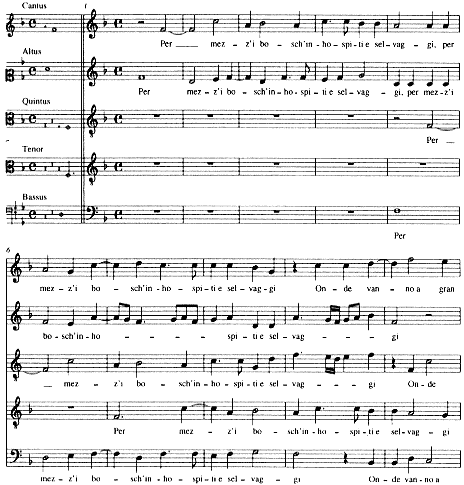
Ex. 18.
Rore, Per mezz'i bosch'inhospiti e selvaggi (Petrarch, no. 176), incl.; Madrigali
a 5 (Venice, 1542), no. 11.
(continued on next page)
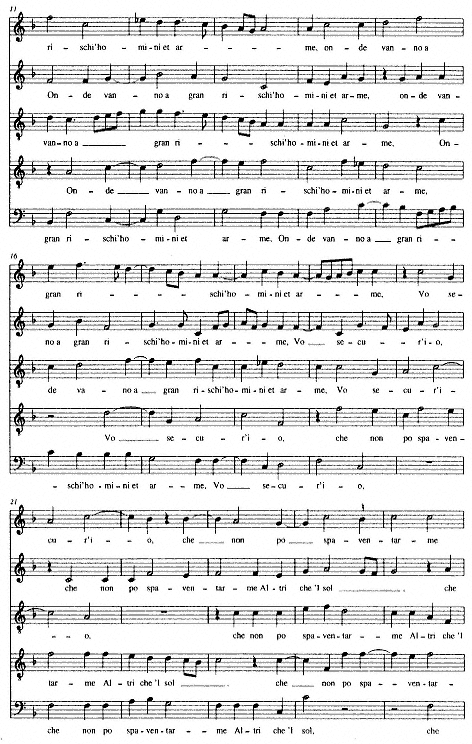
Ex. 18
(continued)
(continued on next page)
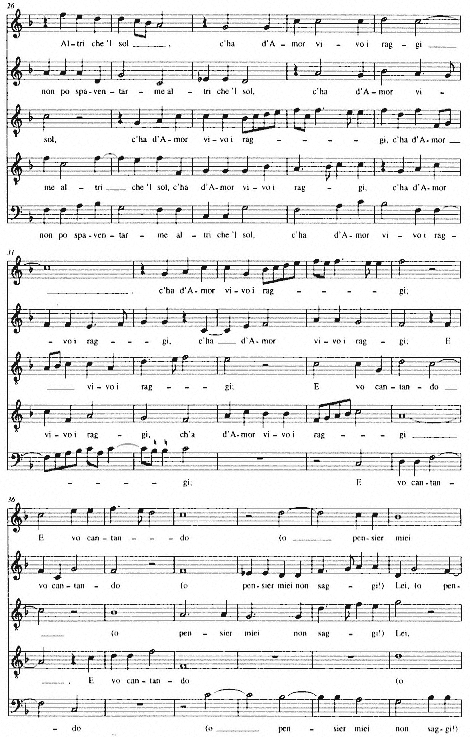
Ex. 18
(continued)
(continued on next page)
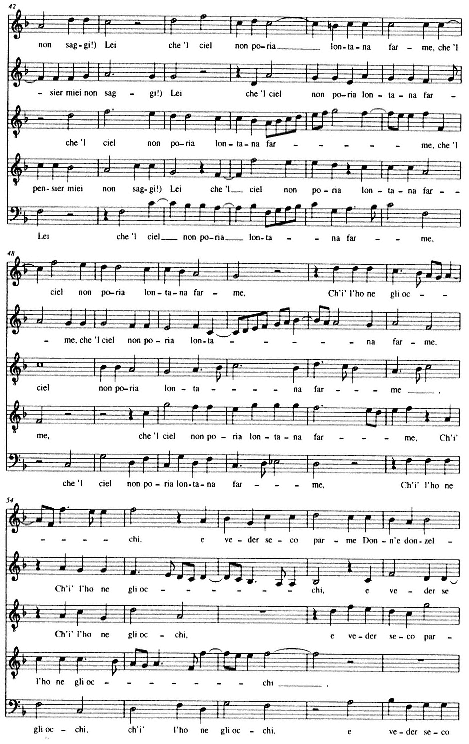
Ex. 18
(continued)
(continued on next page)
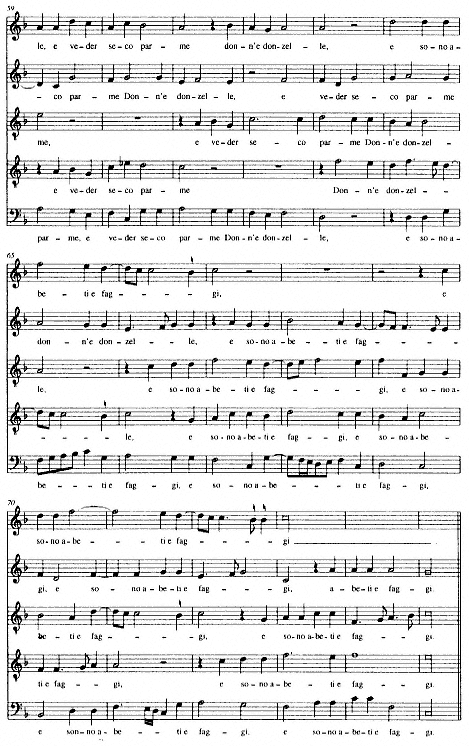
Ex. 18
(continued)
(continued on next page)
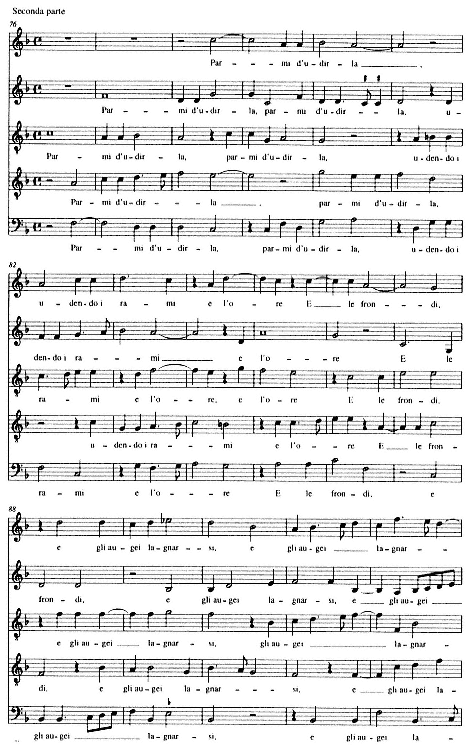
Ex. 18
(continued)
(continued on next page)
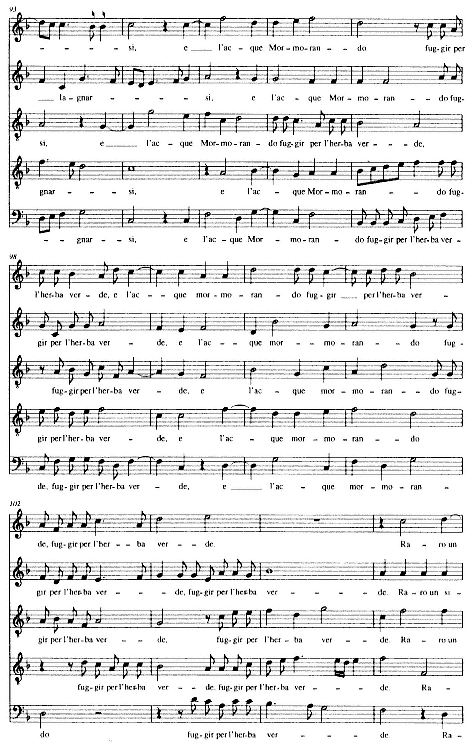
Ex. 18
(continued)
(continued on next page)
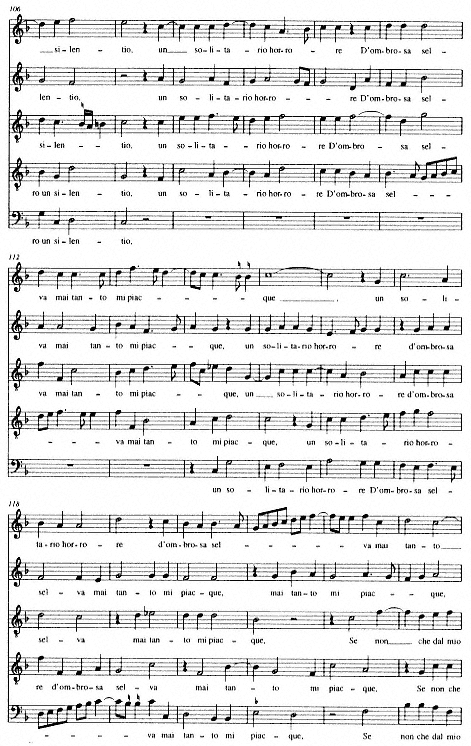
Ex. 18
(continued)
(continued on next page)
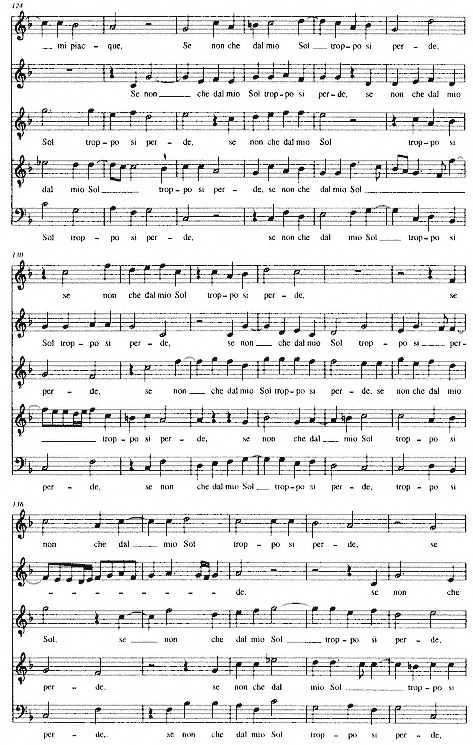
Ex. 18
(continued)
(continued on next page)
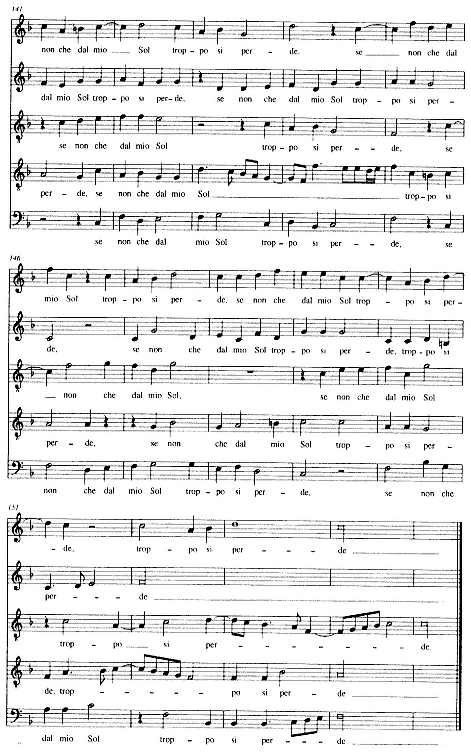
Ex. 18
(continued)
(continued on next page)
We can begin to uncover this rhetoric by looking at Rore's treatment of the sonnet's formal articulations, as provisionally described in Table 7. Although the ambiguities of Rore's counterpoint render such descriptions problematic,[20] Table 7 nonetheless shows that his setting foregrounds the sonnet's verse structure by using suspension cadences repeatedly at the ends of all but one of the sonnet's main sections (cf. vv. 4, 8, and 14). The only section that lacks such a cadence is the first tercet, with a single cadence to end v. II at m. 105, but here Rore reinforces the articulation through other means (as I discuss below). Furthermore, suspension cadences sound at the ends of virtually every clause (the only exceptions are the very last cadences that close each of the two parts).
This structural overview allows us to see profound differences between Rore and Willaert. Rather than trading in suspension cadences and sharp motivic differentiations, Willaert tended to work with speechlike recitation, often marking textual cadences through the simple use of rests.[21] Willaert's madrigals must have offered trenchant models for how to define formal details of text with subtle rhythmic and harmonic nuances and delicate textural shifts; but Rore sought out more explicit rhetorical definition.[22] While Willaert's madrigals usually deploy few contrapuntally conceived cadences, Per mezz'i boschi typifies Rore's tendency toward a highly articulated reading.
This profusion of contrapuntal cadences was just one way Rore's articulation differed from Willaert's, however, and perhaps not even the most obvious one. For Rore, semantic content held equal sway with linguistic form. More than Willaert's, his music indulged in vivid text painting and sharp verbal contrasts, bold motivic shapes and striking expositions. One result of these tendencies was a less regular rhythmic surface. Thus, where Willaert's declamation distributes durations fairly evenly over words in the course of a sonnet, Rore's moves between this Willaertian "speech time" and what we might usefully distinguish as "expressive time," time played out in alternately lingering or quickening affective gestures and pictorial effects. In short, Rore forewent some of Willaert's rigorous adherence to the
[20] As with Willaert's Pien d'un vago pensier (see Table 5), Rore's setting is not wholly congenial to this kind of simplified description. Both the contrapuntal ambiguities and the subtle and diverse means by which articulations are made defy efforts to summarize the forms of many cadences or even to identify all their locations. Rore parses the text not just through contrapuntal devices but through textural shifts, changes in declamatory speed, text repetition, and a host of other means. Table 7 lists all of the cadences involving suspended dissonances, as well as others that I deem especially significant, but for the reasons given above I do not aspire to a universal or wholly systematic approach in tabulating cadences.
[21] The total lack of suspension cadences in the prima parte and inclusion of only two in the seconda parte of Willaert's Mentre che 'l cor find no equivalent in Rore's books. Meier's tabulations of cadences for several madrigals from the Musica nova might seem to suggest otherwise, but his examples happen to be drawn from the most cadence-laden works in the book. See the sections on Giunto m'ha Amor and Quando fra l'altre donne in The Modes, pp. 144-45 and 159 (I do not count the seven-voice dialogues that Meier discusses on pp. 126-27 and 145 because they operate according to different principles of articulation).
[22] For a study aimed at demonstrating Rore's mastery in reflecting textual structure through bass patterns, tonal structure, and cadential repetitions see Jessie Ann Owens, "Music and Meaning in Cipriano de Rore's Setting of Donec gratus eram tibi," in Music and Language, Studies in the History of Music, vol. 1 (New York, 1983), pp. 95-117, on his setting of an ode by Horace.
| ||||||||||||||||||||||||||||||||||||||||||||||||||||||||||||||||||||||||||||||||||||||||||||||||||||||||||||||||||||||||||||||||||||||||||||||||||||||
tempos, accents, and cadences of a spoken reading in favor of a more semantic interpretation.
Per mezz'i boschi carefully balances such formal and expressive considerations in the transitions between major structural divisions. When the first quatrain draws to a close, for example, a series of brilliant melismas gestures the word "raggi" repeatedly toward cadence (quintus, mm. 28-30; bassus, mm. 30-32; cantus, mm. 33-35). Crowning the quatrain with their whimsical swirling motions launched across
sevenths and propelled in thirds and fourths, these melismas bring about the quatrain's tonal-grammatical resolution to the final, F. At the same time, by calling attention with their sudden absence to the poet's singing in v. 5 ("E vo cantando") and the beginning of the new poetic thought, they also exaggerate retrospectively the loss of motion in m. 35. To employ stasis for the sake of contrast at such a moment is a touch ironic, of course, since Rore can exploit it only by slighting the prevailing convention that prescribed florid melody for allusions to singing. But in pitting such a spare passage against the previous spate of melismas — condemning the poet's reckless song to a spell of semantic impoverishment — Rore found an efficacious formal-cum-expressive solution to the structural transition.
"E vo cantando" forms only the first part of a clause whose direct object "Lei" is displaced in enjambment to line 6 through an extraordinary interruption. It is worth pursuing these verses a little further to notice the ingenious syntactic solution given to Petrarch's exclamatory "(o pensier miei non saggi!)"; for Rore offset it with rests, as if to mark it as a parenthetical mental flash, and also reintroduced a declamatory rhythm at the semibreve (mm. 37-38) not heard since the opening. The new pacing marks the poet's "unwise thoughts" as intrusive and other, an effect heightened by the flat-footed binary figures that declaim "E vo cantando." Only when the phrase elides into v. 6 to complete the interruption — — "E vo cantando . . . Lei" — is the stasis of v. 5 lifted; trace the quintus from m. 37 to 41, for instance, and note the continuous and rising phrase that accompanies "saggi!) Lei" at each appearance.[23] The quintus, leading off as surrogate bass, immediately introduces a proliferation of voice crossings with the tenor that obscure and destabilize the sense of a bass line (mm. 37-39 and 44-45). Shortly afterward, the altus's flatted inflections herald a raft of minor triads, which otherwise scarcely appear in the madrigal (note the c, g, and a of mm. 39-41). None of the polyphony to this point has been tied off with a cadence. Indeed, for the first time in the madrigal, two whole verses go by before a suspended cadence sounds at the end of v. 6 (m. 53) — both the first Phrygian cadence and the first on the medial degree aa/a (altus and quintus), albeit immediately extended.
To summarize, vv. 4-6 gloss Petrarch's text in a way that moves between two different rhetorical goals: syntactic clarification and semantic expression. Whereas Willaert made interpretation of localized grammar an overriding concern — indeed often the sole means of enhancing the sense of the words — Rore's music wrested meaning directly from text. So doing, it balanced the competing demands of linguistic form and meaning.
[23] As Willaert did with the interruption in v. 8 of Pien d'un vago pensier (see Chap. 7 above, nn. 56-58), Rore clarified the words' syntactic autonomy by setting them off musically from the first part of the clause they interrupt, "E vo cantando." He also, like Willaert, linked the delayed completion of the main clause, "Lei," to the disruptive interjection: hence "(o pensier miei non saggi!) Lei" became a single syntactic unit.
Such balance proves expressively vital for the wonderfully pictorial first tercet, a catalogue of natural phenomena that Rore depicted in vivid musical images. Each item — branches, breeze, leaves, and birds — forms collectively part of a sonorous contrapuntal thicket used to animate Petrarch's scenery. To mimic the sound of the breeze whipping light rain over a field, for instance ("e l'acque / Mormorando fuggir per l'herba verde"), Rore set voices fluttering from part to part (mm. 93-105) and underpinned the effect with a rocking bassus at mm. 94-97 and 99-102. Such rich iconic tapestries were unusual at the time, even in Rore's own madrigals. In the future, rapid declamation combined with repeating note pairs such as Rore applied to "fuggir per l'herba verde" were to become a prominent musical topos for depictions of pastoral landscapes. They surface in black-note madrigals of the 1540s, of which those in Rore's Primo libro are early, if atypical, examples, and they continue to appear in madrigals of the seconda prattica. Rore's Terzo libro of 1548 is the first to make extensive use of such pictorial passages, which finally became part of an established tradition in the pastoral settings of Andrea Gabrieli, Wert, Marenzio, and Monteverdi.[24]
Even the bravura multiple counterpoint Wert fashioned for Vezzosi augelli, a stanza from Tasso's Gerusalemme liberata published in his Ottavo libro a 5 of 1586 (Ex. 19), finds its prototype in Per mezz'i boschi. Wert's madrigal pits a melodious trio of "singing birds" for Tasso's first two verses against monotonal chanting for the murmuring breeze of v. 3. Not dissimilarly, Rore assigned separate motives to "l'acque / Mormorando" and "Fuggir perl'herba verde." To do so he had forcibly to disengage the verbal parts, for their syntax alone does not call for them to be parsed as such. The separations he artificially forced on them provide the basis for what we might call prospectively a Wertian counterpoint, which takes shape in the overlappings of mm. 95-97 and 100-102. They form a striking precedent for the sort of simultaneous counterpoint Monteverdi was to cultivate so extensively beginning in his Secondo libro a 5 of 1590.[25]
Rore projected another efficacious rhetorical-grammatical shift by articulating the division of the tercets with the perfect cadence on f/F in m. 105. The reasons for this are evident, as Rore starts the brief "Raro un silentio" in near homorhythm and quickly ends with yet another perfect cadence in m. 107 (these being the only two to bring as many as four voices to a simultaneous close). The textural tranquillity thus achieved and enhanced by an all-vocal rest in turn sets up the poem's key phrase, "un solitario horrore / D'ombrosa selva mai tanto mi piacque." At this point the texture unravels just slightly until, reaching their second statement, the voices begin to hurtle toward an enormous coda.
Rore placed unprecedented weight on the last verse. Melismas now proliferate as each voice echoes the final verse six, seven, or more times, working out at last the
[24] See Gary Tomlinson, Monteverdi and the End of the Renaissance (Berkeley and Los Angeles, 1987), pp. 49-50, and Chap. 7 above, n. 53.
[25] Tomlinson, ibid., relates Wert's Vezzosi augelli to Monteverdi's setting of Tasso's lyric poem Ecco mormorar l'onde, another paratactic nature scene, which was published in Monteverdi's Secondo libro.
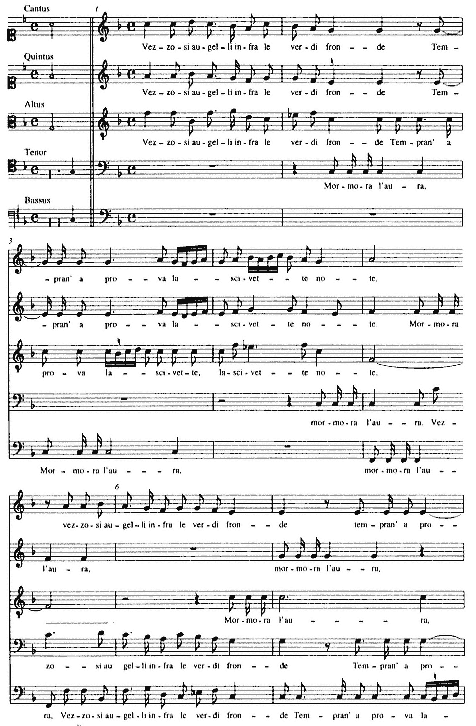
Ex. 19.
Giaches de Wert, Vezzosi augelli infra le verdi fronde (Torquato Tasso), mm.
1-9; in Ottavo libro a 5 (Venice, 1586), p. II.
(continued on next page)
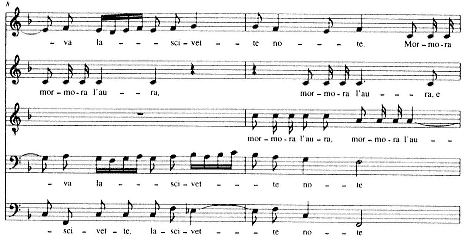
Ex. 19
(continued)
abundant polyphonic energy collected in the previous hundred-plus measures. Through all this the bass leaps back and forth between the two tonal axes, F and C, as if purging the tonal terrain of all the alien inflections that had invaded earlier. This is a fitting climax to a work that set new standards of vigor for polyphonic madrigals.
Both of the other sonnets that explore the topos of the woods were the work of poets contemporary with Rore, and both are darker than Petrarch's Per mezz'i boschi. The first (no. 6) is Molza's Altiero sasso.
Altiero sasso lo cui gioco spira Proud stone whose ridge breathes
Gli antichi honor del gran popul di Marte, The ancient honor of the great populace of Mars;
Fiume che fendi questa e quella parte, River that breaks this way and that,
Hor quieto e piano, hor pien di sdegno et ira, Now quiet and still, now full of rage and fury; 4
Piaggie che 'lmondo ancor ama e sospira, Slopes that all the world still loves and desires,
Consecrate da tante e da tai carte, Consecrated by so many and such writings;
Memorie eterne e voi reliquie sparte Eternal memories and you, Spartan relics,
Ch'ogni bon'alma con pietà rimira: On which every good soul gazes with devotion: 8
Parmi d'udir fuggendo a voi d'intorno I seem to hear flying all about you,
Sospirar l'onde e i rami e i fiori Sighing, the waves, and branches, and flowers,
e l'ora and the breeze
Lagnarsi, e per dolor romper i sassi; Lament, and the stones break from grief, 11
Che già del pianto s'avicina el giorno Since already the day of tears draws near
Che 'l bel viso ch'Italia tutta honora, When the beautiful face that all of Italy honors,
Cinti d'horror al suo partir vi lassi. Wrapped in horror at his departure, will leave you. 14
Altiero sasso apostrophizes deserted formations in the Roman out-of-doors — a stony mountain face, raging river, slopes, and Spartan relics. The poem sustains a level of Dantean gloom throughout the octave, then shifts to a lighter Petrarchan vein, conjuring up in waves, branches, flowers, and breeze the memory of the beloved. This first tercet is, of course, a gloss on the analogous one in Per mezz'i boschi. But here day breaks to provide a mere foil for the final tercet. The sonnet resumes its lamenting tone at v. 12, now draping the octave's rocky landscape in a Dantean "horror" to convey the air of deathly departure at the sonnet's end.
Rore set Altiero sasso in

Strane ruppi, aspri monti, alte tremanti Strange cliffs, harsh mountains, high quivering
Ruine, e sassi al ciel nudi e scoperti, Ruins, and stones naked and exposed to Heaven,
Ove a gran pena pon salir tant'erti Where with great effort such steep clouds
Nuvoli, in questo fosco aer fumanti, Of smoke rise in this gloomy, fuming air, 4
Superb'horror, tacite selve, e tanti Proud horror, silent woods, and so many
Negr'antr'herbosi, in rotte pietre aperti, Black grass-grown caves in broken-open stones,
Abbandonati, sterili deserti, Abandoned, barren deserts
Ov'han paur'andar le belve erranti: Where even wandering wild beasts go in fear: 8
A guisa d'hom che da soverchia pena As a man who, with a sad heart, torn with
Il cor trist'ange, fuor di senn'uscito, Excessive pain, out of his mind,
Se 'n va piangendo, ove la furia il mena, Goes crying wherever his madness leads him, 11
Vo piangend'io tra voi, e se partito I go weeping among you: and if Heaven does not
Non cangia il ciel, con voce assai più piena take my side, with a much fuller voice
Sarò di là tra le mest'ombre udito. Will I be heard from there among the sad shades. 14
Though attributions of its authorship are mixed, Strane ruppi appears to be the work of the Neapolitan Luigi Tansillo, who was noted for his extraordinarily raw diction.[26] Its trembling rocks, clouds of smoke, and lifeless woodland depict the spoils of a volcanic eruption. In evoking them with such graphic language, Tansillo departs radically from the Petrarchan mainstream, as well as from the idyllic Arcadian world of his Neapolitan predecessor Sannazaro.[27] Here the poetic persona is set in a stark and terrifying place that transforms the usual pastoral scenes of Petrarchan verse: unlike their docile woods and groves, these spaces are rugged and
[26] I expand on questions of authorship in "Rore's 'selva selvaggia,'" pp. 565-66. On Neapolitan Petrarchism see Aldo Vallone, "Di alcuni aspetti del petrarchismo napoletano (con inediti di Scipione Ammirato)," Studi petrarcheschi 7 (1961):355-75, and Giulio Ferroni and Amedeo Quondam, La locuzione artificiosa: teoria ed esperienza della lirica a Napoli nell'età del manierismo (Rome, 1973).
[27] On settings of Tansillo in the sixteenth century see my "Rore's 'selva selvaggia,'" p. 566 n. 30.
uninhabitable. All the poet's emotions are projected through this violent landscape, whose images express a total loss of civilization and, by extension, the loss of reason that defines a cultivated being. At the verbal level madness is dramatized most acutely in the octave, with its fragmentary vocatives distancing it from the equivocal syntactic convolutions of Petrarch's verse.
Elsewhere I have proposed that Tansillo drew from Dante's Commedia for specific words and meanings and more generally from the cacophonous sounds of the Inferno.[28] The "tremanti ruine" of Strane ruppi recall the rumblings of Purgatory Dante feels in Hell, to which he is doomed but for the grace of Heaven.[29] In the Inferno he learns through a series of cryptic allusions that the tremors signify a soul's completion of penance in Purgatory.[30] In Purgatory 20, the pilgrim and his guide hear violent quaking accompanied by cries of "Gloria in excelsis Deo" given out by shades ("ombre") who afterwards return to a state of eternal weeping.[31] This final point (as I have argued) confirms the specific inspiration of Tansillo's sonnet in the Commedia and provides a Dantean key to the whole poem, with its final allusion to the underground shades. More than this, it reveals a precise musical association with the quaking that must have made the poem appealing for musical setting, despite — or even because of — its lyric eccentricities.
The extravagant Neapolitanism of Strane ruppi finds a unique place among Venetian collections, a place that is unthinkable in Willaert's oeuvre. But it forms part of a distinctly southern stream running through Rore's Primo libro, also fed by poets like the Roman Molza and (so it seems) the anonymous author of the Neapolitan-styled Icarus sonnet Poggiand'al ciel.[32] Sitting at the extreme end of Rore's early expressivity in a style that borders on expressionism, Rore's
[28] I am indebted to Linda Armao, who first brought the thematic connection to my attention.
[29] According to Christian tradition, the rumblings commemorate Christ's Crucifixion and his harrowing of Hell. In Matt. 27:51, for example, the earth shudders after the Crucifixion: "And behold the veil of the temple was rent in twain from the top to the bottom, and the earth did quake, and the rocks rent." See also Mark 15:38: "And the veil of the temple was rent in twain from the top to the bottom."
[30] For the specific references and lexical connections see Feldman, "Rore's 'selva selvaggia,'" pp. 567-68.
[31] Purg. 20.124-44: "Poi cominciò da tutte parti un grido / tal, che 'l maestro inverso me si feo, / dicendo: 'Non dubbiar, mentr' io ti guido. / 'Gloria in excelsis ' tutti 'Deo ' / dicean, per quel ch'io da' vicin compresi, / onde intender lo grido si poteo. / No'istavamo immobili e sospesi / come i pastor che prima udir quel canto, / fin che 'l tremar cessò ed el compiési. / Poi ripigliammo nostro cammin santo, / guardando l'ombre che giacean per terra, / tornate già in su l'usato pianto" (Then began such a cry on all sides that my master drew toward me saying, "Do not fear while I guide you." "Gloria in excelsis, Deo, " all were saying, by what I understood from those nearby, where the cry could be heard. We stood motionless and in suspense, like the shepherds who first heard that song, until the quaking ceased and it was ended. Then we took up our holy way again, looking at the shades that lay on the ground, already returned to their wonted plaint).
[32] Vallone, "Di alcuni aspetti del petrarchismo napoletano," stresses southern poets' use of comparison and simile, their wielding of naturalistic imagery to heighten contrasts between the poet's interiority and the physical world, and manipulations of naturalistic invocations to balance rhetorical artifice — all qualities found in these poems. Vallone cites Tansillo's employment of the winged-flight motive in comparative form on p. 367. For Ernest Hatch Wilkens's description of the Icarus motif as an emblem of "soaring inspiration," see A History of Italian Literature, ed. Thomas Bergin, rev. ed. (Cambridge, Mass., 1974), p. 245.
settings of Southern imagery stimulated unexpected antecedents to his late madrigalian style.
Expressionistic qualities are most striking in the opening quatrain, where Rore ignored the norms of classical vocal counterpoint that assigned one main soggetto to each word group by threading a descending tetrachord through four distinct verbal phrases in the way of a virtual leitmotif. (See Ex. 20, where the four are numbered in the cantus and other instances bracketed.) With their staggered exordial entrances, these tetrachords translate musically the jagged cliffs of v. I. They find their most gripping exposition in the opening measures — texturally spare, broad in rhythm, jostled by ubiquitous suspensions, and hardened in parallel major thirds
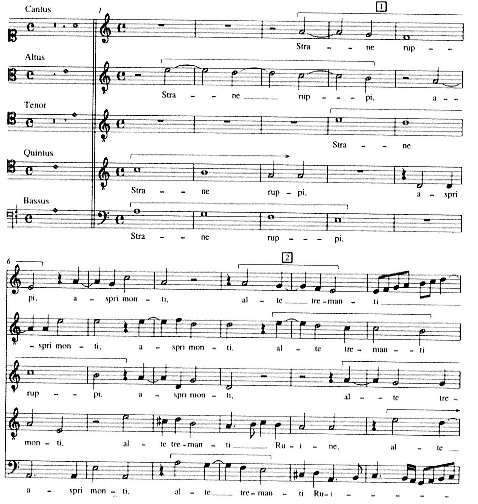
Ex. 20.
Rore, Strane ruppi, aspri monti, alte tremanti (prob. Luigi Tansillo), mm. 1-28;
Madrigali a 5, no. 7.
(continued on next page)
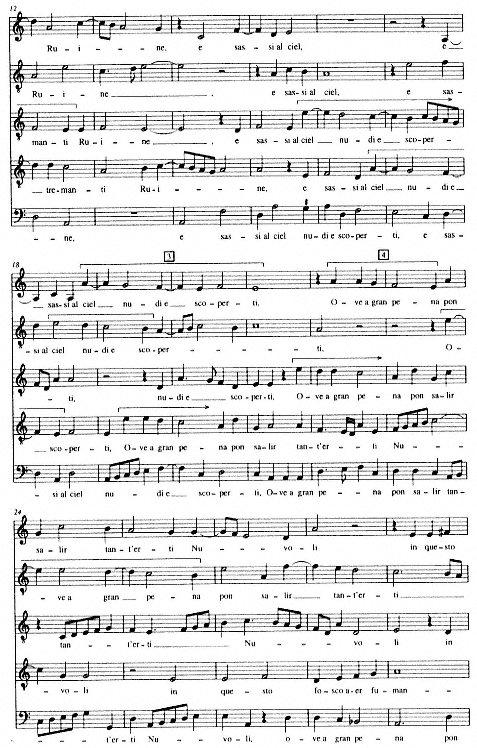
Ex. 20
(continued)
(the quintus and bassus of mm. 2-3).[33] Obsessively repeated, they give special force to the melodic whole tones that Zarlino later mentioned in connection with "asprezza, durezza, crudeltà [ed] amaritudine" (harshness, hardness, cruelty, [and] bitterness).[34]
From this stark beginning Rore drew the tetrachords into increasingly turmoiled counterpoint. With the appearance of "harsh mountains" and "trembling ruins" in m. 5 come more dissonances, declamatory ruptures, and shifts of texture. By m. 7 the suspension chains, now in diminution, generate faster harmonic shifts and remarkable dissonances. The bassus's suspended a of m. 8 becomes the middle member of a tone cluster whose outer notes (tenor g and quintus b) arrive by leap; its note of resolution, g, sounds with it not only simultaneously but in unison. As if to underscore the dissonance, the bassus rumbles through a subterranean run on "Ruine" to bring the noun phrase to an end.
In all of this, Rore made the most of the poem's noisy vowels and consonants by chiseling each of its paratactic parts into a separate musical phrase. The chain of broken syntactic bits thus receives an asymmetric musical parsing that Daniello (for one) had linked to proselike gravità in verse.[35] Deliberately measured, Rore's setting stuffed the poem's bloated diction — its a 's and o 's, r 's, s 's, t 's, and consonantal clusters,[36] with jarring discords compounding its instabilities of theme and phraseology.
The gritty style that emerged has much to do with Rore's individuality as a contrapuntist. Within the bounds of post-Josquinian, continuous polyphony, the music's surface is unusually restless. No sooner are words cranked up to a clattering, speechlike tempo than the surface turns lushly melismatic.
These two declamatory styles — recitational and melismatic — always stand in a kind of counterpose, one quickly mutating into the other. Rore individualized them contrapuntally by linking each of them to different types of chordal events and different kinds of voice leading. Crisp syllabic declamation — even and metrically stable — is usually accompanied by passages that are tonally less stable. Thus Rore often unleashed a succession of quick, erratic chordal shifts while holding the declamation steadily at the quarter note (here semiminim), as happens at the allusion to caves and stones of v. 6 (see Ex. 21, especially mm. 49-50).[37] Conversely, when the declamation unfolds in luxuriant melismas, harmonic changes become slower and
[33] Recall here that conjunct motion by major thirds, as well as from major sixths to perfect fifths, were later explicitly linked to gravity and harshness by Vincenzo Galilei in his Fronimo dialogo, nel quale si contengono le vere, et necessarie regole del intavolare la musica nel liuto (Venice, 1568), p. 13 (quoted in Claude V. Palisca, Humanism in Italian Renaissance Musical Thought [New Haven, 1985], p. 357 n. 60); see also Chap. 7 n. 60 above. Zarlino proscribed parallel major thirds in Le istitutioni harmoniche (Venice, 1558) because of the cross relations they cause (Part III, Chap. 29, p. 177).
[34] Istitutioni harmoniche, p. 339.
[35] See above, Chap. 5 n. 124.
[36] All of these were variously remarked by contemporary literary theorists for their fullness, gravity, and dissonance. On a 's and o 's see the views of Bembo, Tomitano, and Parthenio cited in Chap. 5 nn. 109, 110, 123, 138-39; on the consonants r, s, and t, see Bembo cited Chap. 5 nn. III-12 and Tomitano, nn. 123-25, among others. See also nn. 117-18 on vowel- and consonant-filled syllables.
[37] Still more so are the erratic shifts at "questo fosco aer fumanti" from v. 4, esp. m. 33; see the complete setting in Rore, Opera omnia 2:29-34.
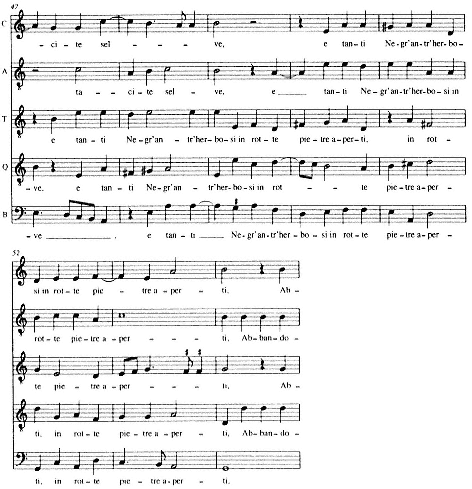
Ex. 21.
Rore, Strane ruppi, aspri monti, alte tremanti (prob. Luigi Tansillo), mm. 47-54;
Madrigali a 5 (Venice, 1542), no. 7.
less adventuresome: witness the poet's "fury" in v. II (Ex. 22), where melismas weave their way through a mild progression of fifths, C-G-C-F-C-G (mm. 100-105). Despite the wide registral spans and wild contours in some of these melismatic passages (e.g., quintus, mm. 106-7), however, Rore's voice leading minimizes the destabilizing effects of voice crossing. In this respect, such melismatic passages contrast with the many instances of chordal declamation, where voice crossing often abounds (in Ex. 20, note mm. 13-16).
This process of broadening out from syllabic textures to more florid ones that resolve instabilities of tonality and voice leading takes place repeatedly in the madrigal. It seems unlikely that Rore developed the technique by simply extending expressive possibilities he learned from Willaert, for Willaert made such pronounced
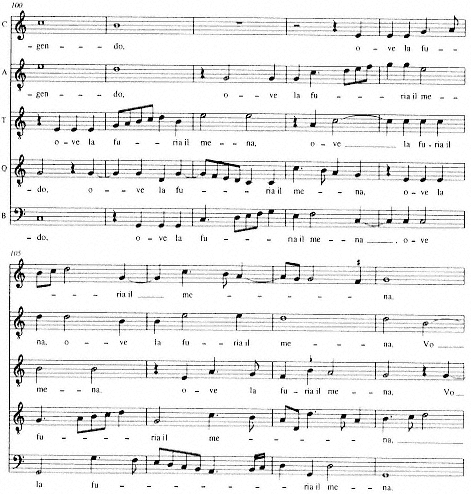
Ex. 22.
Rore, Strane ruppi, aspri monti, alte tremanti (prob. Luigi Tansillo), mm.
100-108; Madrigali a 5 (Venice, 1542), no. 7.
juxtapositions only at the most exceptional passages, like his setting of the paradox that opens Cantai, hor piango (see Ex. 45a). More typical is the diffident rhetoric of Pien d'un vago pensier (Ex. 14).
Almost invariably Rore's settings make use of Willaertian rhetoric but only for expressive contrast and rarely in so reticent a state as Willaert's own. Even a passage that explicitly recalls Willaert's plain idiom such as "Abbandonati, sterili deserti" (Ex. 23) is too idiosyncratic for Willaert in its contrapuntal construction. Here the passage earlier seen in Ex. 21 (mm. 47-54) devolves into an unsettled motivic counterpoint once all the voices have formed a perfect cadence on G. Pulled apart grammatically, the separate nouns and adjectives create ephemeral effects of a kind generally unknown in midcentury Venetian madrigals — contrapuntal disintegrations
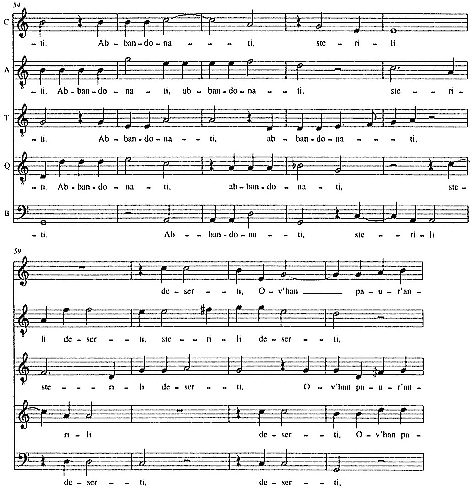
Ex. 23.
Rore, Strane ruppi, aspri monti, alte tremanti (prob. Luigi Tansillo), mm. 54-62;
Madrigali a 5 (Venice, 1542), no. 7.
that we might call, after Anthony Newcomb's descriptions of the cadences in late Ferrarese madrigals, "evaporated."[38] In mm. 55-57 the fifth motion that animates the bassus provides a little momentum and direction to help the music retain its bearings, but by mm. 57-61 a sense of disorientation begins to set in again. The lowest-sounding note constantly migrates from part to part, switching back and forth from tenor to bassus as the texture is intermittently abandoned by one voice and then another. Finally these stark motives seem to go nowhere and end in the empty major third at m. 61. Both the textural disorder and spare, sharply etched motives foreshadow Rore's later experiments of the 1550s, as well as the Luzzaschian and Monteverdian madrigals of the 1590s. The eloquent minor-sixth leap in the altus of
[38] The Madrigal at Ferrara, 1579-1597, 2 vols. (Princeton, 1980), 1:120 n. 6.
mm. 54-55 even brings to mind the kind of barren pathos evoked in the famous opening of Monteverdi's Vattene pur crudel.[39]
Strane ruppi shows other extremes foreign to Willaert beyond those exemplified here. Occasionally they crop up quite unexpectedly, as in the madrigal's voluptuous, sequence-filled fioriture — one in the cantus on "erranti" (mm. 72-76), for example, and another for the final "ombre udito" (mm. 141-42). Other melismas are surprisingly angular, like the triadic tenor at m. 27 and the quintus at mm. 22-24, seen in Ex. 20.
What is remarkable, then, is not the boldness of any one such gesture viewed in isolation, but the general saturation of them. When the book first appeared, the public was unused to such intense expression applied to vernacular poetry; nor would it have been used to hearing such dramatic poetry sung to music. In fact, neither Strane ruppi nor Altiero sasso was ever set again, despite the popularity of Rore's book, and the same can be said of a number of other poems Rore published in it.[40]Per mezz'i boschi was not reset until later decades, by the Nicosian Pietro Vinci and the Mantuan Wert. Only late in the century did its topos become a favorite in the form of Petrarch's Solo e pensoso, i più deserti campi, where it found memorable expositions at the hands of Wert and Marenzio in the 1580s and 1590s. In 1542 that topos was — and would remain for many decades — a rarity.
There is a lighter side to the Primo libro, however, one that is mostly evident in its settings of madrigals and ballate. Of these, the former evince more realism than the book's other poems, though all four settings differ poetically from even the book's most restrained sonnets. The least facile — and most influential — of them was the opening madrigal, Cantai mentre ch'i arsi del mio foco, which will figure in the next chapter in connection with resettings by madrigalists even younger than Rore, the San Marco musicians Perissone and Parabosco. For the other poems Rore turned to a more cantabile idiom, a more modest elocution, and a style that is altogether less weighty and highly wrought.
The contrast of light and weighty styles reveals itself in the exordia Rore wrote for the madrigal Hor che l'aria e la terra and the sonnet to which it is loosely related, Hor che 'l ciel e la terra e 'l vento tace (Exx. 24 and 25). The two share the same basic declamatory rhythms through the first eight syllables. But in the usual high Venetian manner Hor che 'l ciel pits a syncopated entrance of the quintus against unsyncopated entrances in the other voices and a moment later varies the soggetto in the altus with a new dotted rhythm (mm. 3-4). These irregularities instantly complicate the metric edifice. By contrast, the exordial rhythms of Hor che l'aria are
[39] See Claudio Monteverdi, Tutte le opere, ed. G. Francesco Malipiero, 17 vols. (Asolo, 1926-42; Venice, 1966), vol. 3 (1926), p. 48. Rore achieves a similar effect for the exposition of Altiero sasso.
[40] These include no. 3, Poggiand'il ciel, no. 9, Tu piangi, no. 10, Perseguendomi amor, and no. 15, Quel sempre acerbo, as well as both of the madrigals (nos. 18 and 19).
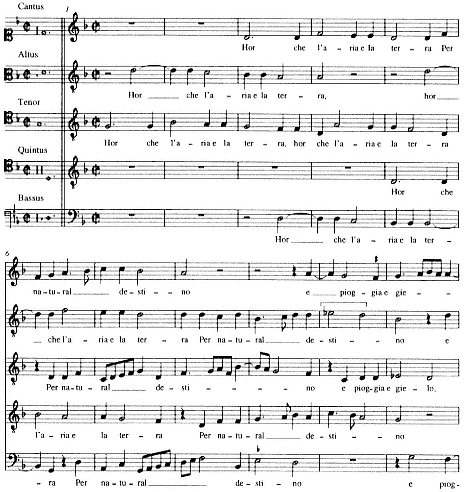
Ex. 24.
Rore, Hor che l'aria e la terra, mm. 1-11; Madrigali a 5 (Venice, 1542), no. 19.
virtually uniform through all five entrances and only vary with the reentry of the tenor in mm. 3-4. Similarly, while the opening measures of Hor che 'l ciel are drenched in semitones —

The vigorous rhetoric Rore fashioned for a poem like Hor che 'l ciel was unsuited to most madrigals, ballate, and small canzone stanzas. Perhaps the most unequivocal expressive departure of Hor che 'l ciel from the milder Hor che l'aria comes at the ravishing contrasts of vv. 5-6, where Petrarch jolts the sonnet from the serenity of the first quatrain to introduce a sudden shift to first-person parataxis. By contrast with the tranquil scene painting of vv. 1-4, the verbs of v. 5 move along in an unsettled, if weary, dissolutio. Suddenly, as the parataxis breaks, the verse tumbles in enjambment toward the oxymoron of v. 6.
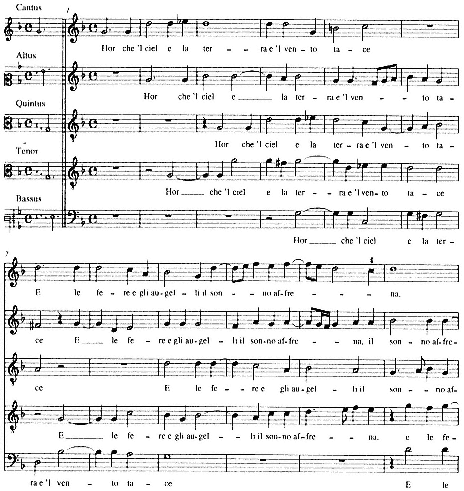
Ex. 25.
Rore, Hor che 'l ciel e la terra e 'l vento tace (Petrarch, no. 164), mm. 1-12;
Madrigali a 5 (Venice, 1542), no. 2.
Hor che 'l ciel e la terra e 'l vento tace Now that the heavens and the earth and the wind are silent,
E le fere e gli augelli il sonno affrena, And sleep reins in the beasts and the birds,
Notte 'l carro stellato in giro mena Night drives her starry chariot around
E nel suo letto il mar senz'onda giace And in its bed the sea lies without a wave. 4
Veggio, penso, ardo, piango, e chi mi sface I am awake, I think, I burn, I weep; and she who destroys me
Sempre m'è inanzi per mia dolce pena; Is always before me, to my sweet pain;
Rore's setting orchestrates the resultant interplay of syntax and rhetoric in vv. 5-6 while maximizing the expressive possibilities broached by the instabilities of the exordium (Ex. 26). It sets off the syntactic disjunction of the verbs in v. 5 by
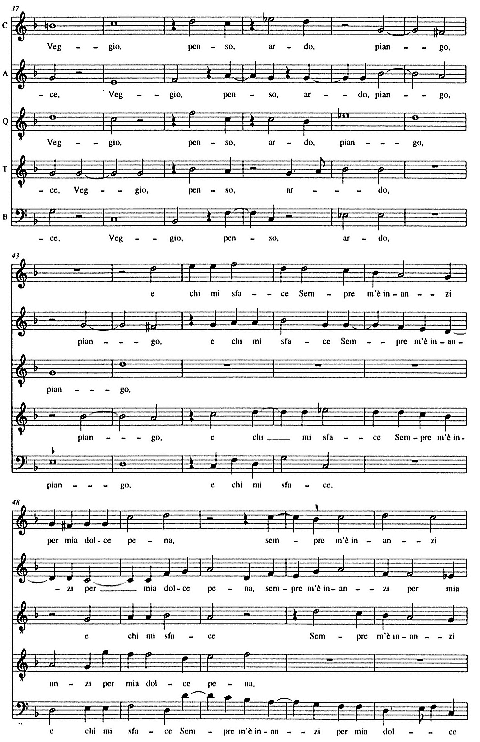
Ex. 26.
Rore, Hor che 'l ciel e la terra e 'l vento tace (Petrarch, no. 164), mm. 37-56;
Madrigali a 5 (Venice, 1542), no. 2.
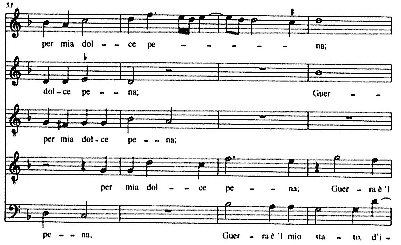
Ex. 26
(continued)
suddenly slowing the declamatory speed. Each verb is declaimed in a plaintive two-note gesture (often a simple minor second) and isolated by rests. Measures 37-44 move through an unpredictable harmonic course, irregular rhythms, and a texture wholly variable in density and weave. Ultimately, this passage forms a foil to the music starting at mm. 44-45 by distinguishing the shift to third person at the end of v. 5 ("E chi mi sface / Sempre m'è innanzi") with a return to the standard declamatory rate and counterpoint. First set off by rests, the clause is realized in a rhythmic parallel that energizes the enjambment and embodies it iconically through various rising and falling melodies, at the same time as it accentuates the words' expressive asymmetries.
Rore's Primo libro — and especially the play of these two text settings — nonetheless attests to the continued vitality of lighter poetic forms in Venetian printed repertories, not least because it represents the first printed madrigal book of such weight. Some of the lighter settings published alongside sonnets undoubtedly carried a whiff of nostalgia for the prettier, more chansonesque idioms of Verdelot and Arcadelt. Others offered more neutral versions of the new Venetian style, possibly more congenial to the amateurs who had purchase on printed books. Rore's Second Book, a printer's compilation drawn from a variety of styles and authors, furnished numerous examples of these earlier idioms, along with retrospective settings and new-styled Venetian sonnet settings.
Secondo Libro a 5 (1544): Anthology in the Guise of Single-Author Print
The distinctive makeup of Rore's second book sharpens the contrast between Petrarchan sonnet settings and settings of lighter and (in part) more realistic verse
seen in his first. Of its scant eight madrigals by Rore, four set sonnets of Petrarch, two set occasional sonnets, one an occasional cinquecento madrigal, and one a little ballata-madrigal (see Table 8). All four of the Petrarch settings are placed consecutively (as nos. 15 to 18), the others, all by unidentified poets, ranged throughout the print (nos. 1, 3, 14, and 26). We will see that, as in Book One, this rough bifurcation of sonnets and nonsonnets throws into relief a general stylistic one.
With less than a third of its twenty-seven settings by Rore, however, we can hardly take at face value the title under which Gardane marketed the book: Di Cipriano il secondo libro de madregali a cinque voci insieme alcuni di M. Adriano et altri autori a misura comune novamente posti in luce a cinque voci.[41] Rore's contributions form only a few points on a map that plots a significant corner of the northern madrigalian dialect. Among the other madrigals in the volume, the most prestigious and prominently placed are Willaert's. The Secondo libro was the first publication to print Willaert's and Rore's madrigals in quasi-symmetrical proximities: Willaert's first setting, no. 2, was wedged between Rore's first two and his final one, no. 27, just after Rore's last (as if giving Willaert the last word). No. 2, the lengthy ballata-madrigal Sciocco fu il tuo desire (see Chap. 7, pp. 221-22), was followed by a sonnet setting of Rore's; and no. 27, the ten-line madrigal Qual vista sarà mai, came after Rore's little ballata-madrigal Deh, se ti strins'amore. Thus two "pairs" framed the book at front and back, with madrigals roughly equivalent in weight and size by each composer making up each pair. It is not surprising that the centerpiece of the book, Rore's four settings of Petrarch's sonnets, is unmatched by Willaert's contributions, since Willaert published none of his Petrarch sonnet settings until 1559.
Of the other contributors, the Roman-based Fleming Hubert Naich follows Rore in number with seven madrigals (nos. 4, 10-12, 19, and 24-25). His settings probably served as fillers, however. They are among the least engaged in the Venetian style that otherwise stamps the print — the least concerned with textual rhetoric or polyphonic breadth — and but for one setting of a Petrarch sonnet (no. 24), bizarrely truncated after seven verses, they are almost wholly disengaged from the high-styled literary verse prevalent among Venetians.[42]
The single madrigals by Arcadelt and Ferrabosco (nos. 20 and 21), both of whom had ties not to Venice but to Rome, also stand outside the book's Venetian charac-
[41] In addition, eight of the madrigals in the book had appeared (undoubtedly before Gardane's edition) in Scotto's reprint of Rore's First Book of the same year, of which six of the madrigals were Rore's. See Il nuovo Vogel no. 2391 (2:1480-81) and no. 2401 (2:1485-86) — Scotto's reprint of Book One and Gardane's edition of Book Two, respectively — and see the comments of Lewis, Antonio Gardane, p. 436, and the forthcoming catalogue of Scotto's printing house by Jane A. Bernstein.
[42] Another sonnet of Naich is apparently occasional, addressed to the "sacrato impero" and set in one part (no. 12). Four other settings are of madrigals (nos. 10, 11, 19, and 25) and another a short canzone (no. 4), all anonymous. For a good biography of Naich and summary of his madrigalian style see Don Harrán's foreword to his edition of The Anthologies of Black-Note Madrigals, Corpus mensurabilis musicae, no. 73, AIM, 5 vols. (Neuhausen-Stuttgart, 1978), I:xxix, and idem, "Hubert Naich, Musicien, Académicien," Fontes artes musicae 28 (1981): 177-94. It should be noted that all of Naich's madrigals had been published around 1540 by the Roman printer Antonio Blado in Naich's Exercitium seraficum (Rome, [ca. 1540]).
| ||||||||||||||||||||||||||||||||||||||||||||||||||||||||||||||||||||||||||||||||
(table continued on next page)
(table continued from previous page)
| |||||||||||||||||||||||||||||||||||||||||||||||||||||||||||||||||||||||||||||||||||||||||||||||
(table continued on next page)
(table continued from previous page)
| |||||||||||||||||||||||||||||||||||||||||||||
ter,[43] but each of the other contributors was in some way aligned with Venice stylistically and, in most cases, biographically. Clearest among these were Willaert's students Perissone Cambio and Girolamo Parabosco. Perissone's bipartite setting of a spiritual sonnet (no. 5) and Parabosco's setting of an octave adapted from Petrarch (no. 13) are both unmistakably Venetian works that will be taken up in Chapter 9. For both composers, the Secondo libro was the venue of their first secular vocal publications, along with Doni's Dialogo della musica of the same year.
Less obvious but sound enough claims to Venetian provenance fall to two final contributors, Jacquet Berchem and Leonardus Barré. The prolific Berchem spent time in Venice during the 1540s and may well have been sponsored by an ostensible
[43] Harrán, ed., Anthologies of Black-Note Madrigals I:xxix.
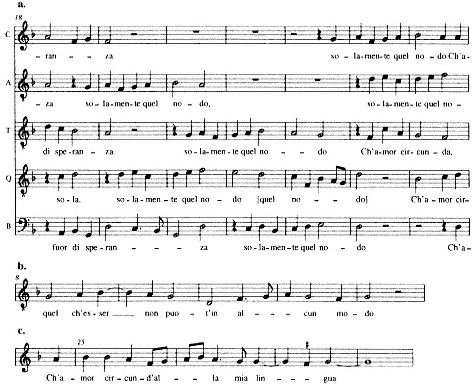
Ex. 27.
Giachet Berchem, Lasso, che desiando (Petrarch, no. 73, stanza 6): a, mm.
18-24; b, tenor, mm. 8-11; c, cantus, mm. 24-28; Di Cipriano il secondo libro
de madregali a 5 (Venice, 1544) (RISM 154417 ), no. 6.
patron of Willaert's, Marcantonio Trevisano.[44] Yet his contribution of a Petrarchan canzone stanza, Lasso, che desiando (no. 8), shares little of the syntactic and accentual precision or rhetorical logic of Willaert's settings, and the same is true of the Petrarchan settings, six in all, in his first book of 1546.[45]Lasso, che desiando does make modest efforts at Willaertian rhetoric, but it also contains instances of awkward text setting of a sort that virtually never mar the settings of Willaert's immediate circle. (Note, for example, in Ex. 27: a) the unvaried misaccentuation of "solamente" and the quintus's broken "sola-, solamente" [mm. 18-20]; b) the tenor's clumsy declamation of the cadential "non puot'in alcun modo"; and c) likewise, the misaccented cadence on "Ch'Amor circund'alla mia lingua.")
The work of the lesser-known Barré shows surprisingly deeper sympathies with Venetian practices than Berchem's. Barré had already debuted as a member of the
[44] See Appendix to Chap. 3, as well as Dale Emerson Hall, "The Italian Secular Works of Jacquet Berchem" (Ph.D. diss., The Ohio State University, 1973), esp. pp. 21-22 and passim; and George Nugent, "The Jacquet Motets and Their Authors" (Ph.D. diss., Princeton University, 1973).
[45] Mod. ed. Jessie Ann Owens, The Italian Madrigal, vol. I (New York, 1993). The ambiguities of text underlay in Berchem's book almost never appear in those of Willaert's students at San Marco.
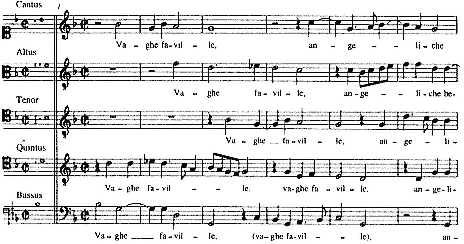
Ex. 28.
Leonardus Barré, Vaghe faville, angeliche beatrici (Petrarch, no. 72, vv. 37-45), mm. 1-6;
Di Cipriano il secondo libro de madregali a 5 (Venice, 1544) (RISM 154417 ), no. 8.
(then fledgling) Venetian school in the five-voice anthology Le dotte, et eccellente compositioni de i madrigali a cinque voci da diversi perfettissimi musici fatte, printed by Scotto in 1540 (RISM 154018 ).[46] Though he was a papal singer, the print's title page dubbed him a "discipulo" of Willaert's. The claim is not sustained by other biographical findings, but the style of his Vaghe faville, angeliche beatrici (no. 8), a setting of the sirima from the third stanza of Petrarch's canzone no. 72, makes it entirely plausible. Barré set the text in a motet texture, with meticulous accentuation and declamation and all the choice gauging of musical to verbal cadence emphasized by Willaert and Zarlino. As seen in Ex. 28, the first three voices of the exposition immediately preempt the possibility of a dominating tactus by staggering their entrances at the minim with the device that Zarlino called a "sospiro."[47] Subsequent entries are equally irregular, metrically and melodically, and delicately inflected with e-flats in a way that prefigures the nuanced Venetian-styled reading of subsequent passages.
A few observations, then. First, the Secondo libro, like Doni's Dialogo della musica, already evinces the diffusion of Venetian style beyond the chapel members and Rore to a larger circle. In this respect, the book offers a useful way to see the two composers now regarded as the style's most illustrious practitioners in relation to
[46] See Fenlon and Haar, The Italian Madrigal, pp. 313-16.
[47] See Le istitutioni harmoniche, Part III, Chap. 44, and Chap. 6 above, Ex. 5. The exposition's soggetto likewise collaborates in shaping Barré's introverted style: carried by the cantus and tenor as the third and fifth voices to enter, it conforms to the kind of exposition cautiously approved by Zarlino in which non-soggetto voices enter first, adapting themselves to a "real" soggetto that materializes only later. See Le istitutioni harmoniche, Part III, Chap. 28, and Chap. 6 above, n. 81.
surrounding lesser lights.[48] Second, to date none of the poets who authored verses in the Secondo libro has been identified save Petrarch (and provisionally the Petrarchan adaptation, no. 13). Given increasingly useful (if still limited) apparatuses for searching cinquecento poetic sources, this profusion of anonymous poetry looks less and less coincidental. Even in its own time the book probably divided roughly into anonymous poetry, on the one hand — synonymous with poetry never meant for collection or preservation outside of music — and Petrarch's poetry, on the other. Perhaps only one other print of Venetian provenance displays a division as strict, namely Perissone's Primo libro a 4 of 1547, which figures in my discussion in Chapter 9. Third, the rough division of poetry into two large branches — lighter anonymous and weightier Petrarchan — has broader ramifications. Petrarch's poems form the basis of a higher, more remote expression, while the anonymous ones run the gamut: some are set in styles close to those of the Petrarch settings, others are much lighter in tone. (The same sort of bifurcation marks Willaert's entire corpus, of course — a bifurcation duplicated in its patterns of preservation.) By juxtaposing Petrarchan settings with settings of anonymous verse, composers set a probing and timeless aesthetic against the simpler, more mundane countertypes produced by transient Petrarchan imitators.
The latter have their most characteristic embodiment in settings of occasional verse, whose worldly aspect manifests itself in three of Rore's four non-Petrarch settings, all of them celebratory: two wedding sonnets (nos. 1 and 14) and an encomium of one Isabella of Cremona (no. 3). Verse like this was much at home in the madrigalian anthology, since both celebratory settings and printed anthologies bore the social signs of commodification. Whether vended by composers or printers, both were publicly produced for capital consumption with an ear to easy appeal.
The opening madrigal of the Secondo libro, a sonnet for a Gonzaga wedding, speaks precisely out into this public space. The text opens in the first-person plural, familiar from songs for carnival and theater, calling up the image of costumed singers staging their song for assembled wedding guests.
Cantiamo lieti il fortunato giorno Let us sing joyously about the happy day
Che strins'a un nodo sacr'almo e tenace That bound in a sacred, life-giving, constant knot
Coppia si degna e con ardente face Such a worthy couple, and adorned this
Il fe divino amor leggiadro adorno. Divine, happy love with an ardent light. 4
Cantiamo lieti, che già d'ogn'intorno Let us sing joyously, for heaven is already rejoicing
S'allegr'il cielo, l'aria e 'l vento tace, All about, the air and the wind are silent,
[48] An inverse pattern of dissemination can be seen in the 1546 reprint of Verdelot's six-voice madrigals, Madrigali di Verdelot et de altri autori a sei voci novamente con alcuni madrigali novi ristampati et corretti (originally titled La piu divina . . . musica in 1541), printed, like the original ed., by Gardane. Its inclusion of works by Willaert, Parabosco, Perissone, Berchem, and Nollet (all of them represented in Doni's Dialogo della musica ), along with those of Verdelot, Festa, Arcadelt, Maistre Jhan, and others, justifies Fenlon and Haar's description of the reprint as having "a more Venetian cast" than the original ed. (The Italian Madrigal, pp. 317-18).
E 'l bel sereno appare, e già si sface And the weather appears serene, and already
A tutti gli animanti un bel soggiorno. A beautiful site is arrayed before all the lively ones. 8
La terra di novelli e vaghi fiori The earth paints itself with new and lovely flowers
Ovunque si dipinge e copre il manto And covers the mantle,
Di la felice et aurea età presaga: Foreshadowing the happy and golden age: 11
Verà che sol il mondo acqueti e It will come to pass that the sun may appease and honor
honori the world
Da l'alto seme glorioso santo Through the great, glorious, saintly seed
D'il fiero Marte e l'unica Gonzaga. Of the proud Mars and the unique Gonzaga.[49] 14
Rore's setting revels in sparkly melodies, with episodes of patter declamation, speechlike rhythms, and (intermittently) extended periods reminiscent of song. In the cantus's first fifteen measures a continuous strain arches from f to cc and back, with graceful diminutions cadencing on the final in the approach to the "Coppia si degna." In keeping with this melodious character, the setting's large-scale structure is more sectionalized than those Rore designed for Petrarch's sonnets. Highlighting the refrainlike anaphora of the first two quatrains, verses 4 and 6 both cadence with the full complement of five voices and on the final, which dominates the setting, followed by the unpretentious modal degrees a (mm. 30, 67, and 89) and c (mm. 61 and 84). Rore executes all this with crisp dispatch — a mere 114 measures for fourteen endecasillabi, whereas his settings of Petrarch's sonnets generally average between 130 and 160 measures. His other wedding sonnet, Scielgan l'alme sorelle, is equally short and similar in style, with buoyant rhythms, brisk declamation, and several multivoice cadences. In a way almost unknown in Rore's Petrarch settings (and more in keeping with later pastoral styles), many of its melismas are wholly unsyncopated (see the one drawn from the cantus in Ex. 29).
Even though the ethos of Scielgan l'alme sorelle is far lighter than that of Willaert's Petrarchan sonnet settings, the work exploited certain Musica nova -like techniques to evoke local rhetorical events without recourse to contrapuntal cadences. Most remarkable in this respect is the way in which Rore gives definition to the catalogue of virtues that opens the sestet (and the seconda parte; see Ex. 30). The passage did not escape Einstein's attention, and for good reason.[50] Yet his claim that "in 1540 only Rore could write a section as 'articulated'" as this one does not hold up in the face of an analogous passage from Petrarch's I vidi in terra angelici costumi set by Willaert; like Rore's exordium, Willaert's also opens the sestet and seconda parte (Ex. 31). In composing "Ardir, senno, virtù, bellezza e fede," the anonymous poet of
[49] The poem, for a spring wedding between a female member of the Gonzaga family and (possibly) a member of a Roman family, is difficult to translate because the grammatical relationships in vv. 3-4 and v. 12 are unclear. I am grateful to Stefano Castelvecchi for his help with it.
For Rore's setting see Rore, Opera omnia 2:108-12.
[50] See The Italian Madrigal 1:401.

Ex. 29.
Rore, Scielgan l'alme sorelle in li orti suoi, cantus, mm. 72-76; Di Cipriano il
secondo libro de madregali a 5 (Venice, 1544) (RISM 154417 ), no. 14.
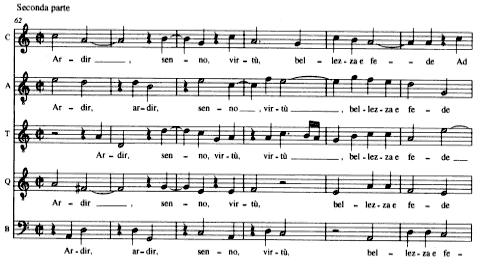
Ex. 30.
Rore, Scielgan l'alme sorelle in li orti suoi, mm. 62-67; Di Cipriano il secondo libro
de madregali a 5 (Venice, 1544) (RISM 154417 ), no. 14.
Scielgan l'alme sorelle surely glossed the rhythms, words, and word sounds of "Amor, senno, valor, pietate e doglia" from Petrarch's I vidi in terra. But did Rore's setting gloss Willaert's? This question raises issues of both chronological and musical relationships between the two. A definitive resolution of chronology is not possible, though it is likely that Willaert's setting came first. Einstein's view that in general the Second Book represents the earliest stylistic layer in Rore's oeuvre, that the pieces in it were leftovers from the First Book, and that Scielgan l'alme sorelle dates from 1540 (a claim unsupported by circumstantial evidence) was undergirded by his teleological view of the repertory.[51] It conflicts with the model I propose for Venetian madrigals in which different styles endured concurrently in connection with different kinds of poetry, for different kinds of occasions, and for dissemination in different kinds of sources. Probably the works printed in 1544 were mostly newer
[51] "Rore's eight compositions for this book . . . seem to me to represent a mere gleaning, all of which antedates the first book of 1542. This follows not only from their notation but also from their character, which is less sharply defined. One of them, Deh, se ti strins'amore, is a youthful work, still wholly in the style of Verdelot; others are occasional pieces whose early date will perhaps be determined someday by inferences from the texts" (ibid.).
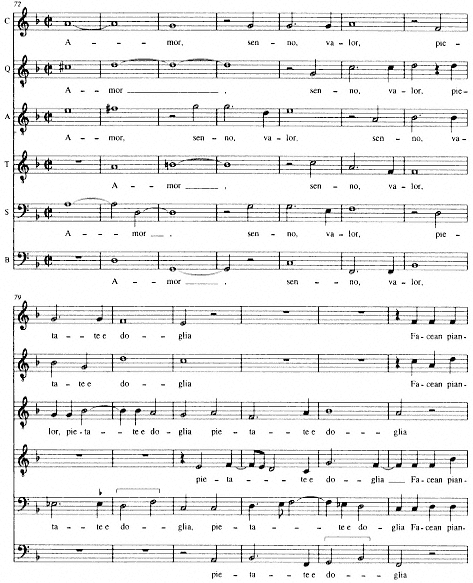
Ex. 31.
Willaert, I vidi in terra angelici costumi (Petrarch, no. 156), mm. 72-84; Musica
nova (Venice, 1559), no. 19.
than those of 1542 — at least in part — and more suited (as I have suggested) to inclusion in an anthologistic potpourri.
Questions of musical relationships are less difficult, for the two employ a fragmentary motivic counterpoint that is much alike. Despite differing pitch systems —


At least one other passage in the Second Book raises similar questions, a line from the madrigal Sfrondate, o sacre dive, v. 8, "Sgombrino l'altre voglie aspr'e selvaggie." This line echoes the incipit of Petrarch's sonnet no. 265, Aspro core e selvaggio e cruda voglia, just as Rore's setting echoes the striking exordium of Willaert's Musica nova setting of it. As noted in Chapter 7, Claude Palisca (among others) has remarked on the harsh parallel major thirds and major-sixth-to-perfect-fifth progressions of Willaert's exposition, as well as its copious deployment of melodic major seconds and thirds (see Ex. 16).[52] As seen in Ex. 32, Rore's setting makes comparable parallel motion at the words "aspr'e selvagge" and deploys linear major seconds copiously between the respective syllable pairs "a - spr'e" and "sel - vag-," with their descending tetrachords. (Minor seconds, by contrast, more often connect the two words to each other.) Given the intensity and exposed position of the parallel-third motion, later proscribed by Zarlino,[53] Willaert's passage bears signs of having served as the model.
Even so, correspondences like these suggest only a very partial obeisance toward Willaert on Rore's part, in addition to confirming Rore's participation in Willaert's practice through their mutual preoccupations with dense five-voice polyphony, Petrarch's sonnets, bipartite settings, and the like. Other aspects of Rore's madrigals — even general ones like choices of sonnets, ordering of sonnets by mode, extensive use of black notation, expansive proportions, and florid melismas — have little or no precedent in Willaert.
Again the musical clues to this relationship rest mainly on the Primo libro, for the Secondo libro is not really a single-author monument, as its title would have it — not a book by Rore at all, but one made to honor and profit from him. For us the Secondo libro helps situate Rore's early practice by clarifying his relationship to some of his contemporaries and affirming his recently gained status as Willaert's equal. In
[52] See n. 33 above and Zarlino, Le istitutioni harmoniche, Part IV, Chap. 32.
[53] See nn. 33 and 52 above. Vincenzo Galilei first drew attention to Willaert's breaking of the rule in Aspro core in order to justify it as an instance of imitation; see also Chap. 7 above, n. 60.
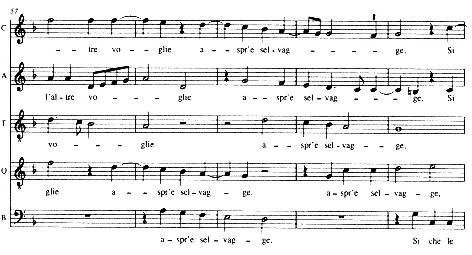
Ex. 32.
Rore, Sfrondate, o sacre dive, mm. 57-61; Di Cipriano il secondo libro de madregali
a 5 (Venice, 1544) (RISM 154417 ), no. 3.
this regard we should recall that Rore was the only composer in the Secondo libro by whom there were settings of Petrarch's sonnets at all, save the seven odd lines set by Naich. The only other complete settings of sonnets (both anonymous) are those of Willaert and his pupil Perissone, the latter of whom managed, through an ambitious act of entrepreneurship, to become the first acolyte to issue a book dominated by sonnet settings after Willaert's and Rore's leads.
Taken together, Willaert and Rore make an odd pair of figureheads: the one eminently visible to historical view, the other cloaked in mystery; the one moored in a single symbolic space, the other seemingly aloof from the enveloping constraints of place. The aesthetic hegemony that Rore was able to elude was rabidly Ciceronian and anti-Dantean. Even with such minimal information on Rore's ties and where-abouts as we now have, much can be understood by perceiving that his allegiances to Venice, with the many taboos and biases it demanded, must have been far more tenuous than Willaert's. To say so constitutes a substantial revision of long-standing assumptions initiated in the mid-nineteenth century by Francesco Caffi, who claimed that Rore had been a singer in the Chapel of San Marco.[54] Caffi evidently played off two notions that remain much discussed in more recent literature: one was a tradition dating back to the mid-sixteenth century for referring to Rore as Willaert's disciple, which emerged only in 1548 with the dedication of Scotto's edition of Rore's Third Book to Gottardo Occagna;[55] the other was the problematic
[54] See Francesco Caffi, Storia della musica sacra nella già cappella ducale di San Marco in Venezia (dal 1318 al 1797): riedizione annotata con aggiornamenti bibliografi (al 1984), ed. Elvidio Surian, rev. ed. (Florence, 1987); Surian corrects Caffi on p. 94 n. 2.
[55] See Chap. 3 n. 32, above. In 1549 Scotto again described works by "Adriano Vuigliart, et Cipriano de Rore suo discepolo" on the title page of the print Fantasie, et recerchari a tre voci (RISM 154934). The works in question include five madrigals, centrally placed and printed in alternation by composer (three by Rore and two by Willaert), in addition to seven ricercars by Willaert. A still more equal association between the two was implied two years later by Antonio Gardane's inclusion of two three-voice settings of "Regina caeli, laetare," one each by Willaert and Rore, in a related print (RISM 155116, containing seven of the ricercars by Willaert that were printed in 154934). These two settings used the same cantus firmus and were printed on facing pages.
assumption that whoever was chapelmaster must have had priority in fashioning the new style. The possibility that Caffi's assertions might someday prove right has now been effectively nullified by Giulio Ongaro's detailed documentary study of the chapel in Willaert's time,[56] but Caffi's opinion forms only the first in a line that has long viewed Rore unproblematically as Willaert's student.[57]
All the same, if Rore was as unfettered in the early forties as he seems — freelancing for worldly, nomadic Florentines and the like — we should recall that the allegiances to which Willaert was bound were multiple as well. Even the staunch, seemingly monolithic Venetianism Willaert served was fused with Tuscan tastes — not only through the elitism imposed on him by Capponi but by the Tuscan linguistic norms that Venetians promoted. In the ensuing chapter we will see some of the madrigalistic choices this alliance drew from students who appropriated and disseminated Venetian musical norms in the 1540s and 1550s.
[56] "The Chapel of St. Mark's at the Time of Adrian Willaert (1527-1562): A Documentary Study" (Ph.D. diss., University of North Carolina at Chapel Hill, 1986).
[57] See Einstein, The Italian Madrigal 1:384, and Meier, ed., Rore, Opera omnia 2:ii.
Chapter 9—
Willaert's Protégés at San Marco—
Codification, Dissemination, and Subversion
By the mid- to late forties Willaert was producing music more and more slowly. He printed his last sizable cache of madrigals (five) in Scotto's edition of Rore's Third Book of 1548, and this after a dry spell of four years. During the same time the pursuit of madrigals by vernacular connoisseurs in Venice like Antonio Zantani, Gottardo Occagna, and Domenico Venier was rising with the increased production of what I have called dialogic volumes around midcentury. With "the good times of la Pecorina" nearly gone, these connoisseurs could have little chance to fill their shelves and parlor rooms with new music by the aging chapelmaster. And Rore — chapelmaster in his own right at Ferrara by the spring of 1546 — must have been all but inaccessible.
Willaert's young corps of students at San Marco was eager to fill the void. Girolamo Parabosco had been studying with Willaert since about 1540.[1] Perissone Cambio made his way to the city by 1544 and had joined the chapel by 1548. His tutelage under Willaert probably started earlier, since he was already skilled at Willaertian composition by 1544-45. Baldassare Donato arrived perhaps only slightly later than Perissone (to judge from the raise in the nominal salary he received as a zago, a boy singer in training, early in 1546).[2] As we saw in Chapter 7,
[1] H. Colin Slim notes that Parabosco may have studied with Willaert as early as the late 1530s, for in 1540 two of his ricercars appeared along with Willaert's in the instrumental print called Musica nova; see Musica nova accommodata per cantar et sonar sopra organi; et altri strumenti, composta per diversi eccellentissimi musici. In Venetia, MDXL, ed. H. Colin Slim, foreword by Edward E. Lowinsky, Monuments of Renaissance Music, vol. I (Chicago, 1964), pp. xxix and passim. According to Zarlino's Sopplimenti musicali (Venice, 1588; facs. ed. Ridgewood, N.J., 1966), Parabosco was present in Venice by at least 1541 (p. 326).
[2] See Mary S. Lewis (who learned it from Jonathan Glixon), "Rore's Setting of Petrarch's Vergine bella: A History of Its Composition and Early Transmission," Journal of Musicology 4 (1985-86): 371 n. 13, and Ongaro, "The Chapel of St. Mark's at the Time of Adrian Willaert (1527-1562): A Documentary Study" (Ph.D. diss., University of North Carolina at Chapel Hill, 1986), p. 125 and Document 164.
Donato was enough in his teacher's graces by 1547 to have been given the tasks by the Procuratori of acting as Willaert's scribe and keeping him "occupied in composing."[3] And Francesco Londariti (called "il Greco"), who attended Zantani's gatherings along with the other three, joined the chapel in June 1549.[4]
For musicians at the chapel, training in counterpoint formed an essential part of a general musical education. Counterpoint taught singers how to adapt part music according to the norms of musica ficta, how to make the correct consonances and progressions, and how to improvise over a cantus firmus — a practice alluded to by the Venetian dialect author Andrea Calmo in a letter to Willaert.[5] A knowledge of counterpoint (as Margaret Bent has argued) was thus virtually as necessary for singing as for composing. For chapel members, Willaert's counterpoint lessons were part of the weekly agenda, and singers who ignored them (like one Zorzi Carpenello) risked censure from the upper echelons of the church.[6] It did not follow that all performers of part music were also composers, yet one of the most significant coincidences in the social, aesthetic, and economic conjunctures by which vernacular music emerged in Venice was that Willaert's three main disciples excelled in both roles. All but Londariti published solo madrigal books at the same time as they won considerable fame as performers.[7] These composer-performers were among the most successful entrepreneurs in the private worlds of Venetian music making, even though none of them seems to have formed the elitist pacts with patrons that Willaert and Rore did. On the contrary, what distinguished the new generation were careers marked by struggle, entrepreneurship, and mobility. Unlike Willaert's and Rore's prints of Petrarchan sonnet settings, theirs were interlaced with numerous lighter-weight settings of madrigals, canzone stanzas, ballate, and ottave rime, and all of them were underwritten by dedicatees. By recasting elite styles in sunnier guises, they disseminated them in forms that could better appeal to commercial consumers.
[3] Donato was also to notify the bureaucracy of any new works that Willaert had composed (see Chap. 7 above, n. 14).
[4] Ongaro, "The Chapel of St. Mark's," pp. 128-29 and Document 180.
[5] "La vostra componidura amice dulcissime è destilà a sete lambichi, e purgà in nuove acque, e affinà a quatro fuoghi, propio alla condicion de l'Aurum potabilem; mo vegnimo sun questa difficultae, che puochi la sà resolver, tanto la xe difficile, e contrapontizar all'improviso del canto fermo, altro cha dir vilote, ni zorziane, ni barzelete" (Your compositions are distilled in seven stills, purged in fresh water, and sharpened over four fires, just like aurum potabilem. But let's turn now to this difficult business, so hard that few can manage it, of improvising a counterpoint over a cantus firmus: how much harder than improvising villotte, zorziane, or barzellette ); Delle lettere di M. Andrea Calmo libro terzo. Nel quale si contiene varij, & ingeniosi discorsi filosofici, in lingua Veneta composti, 4 vols. (Venice, 1572), vol. 3, fol. 30.
[6] See Ongaro's report of an interrogation of Willaert by one of the Procurators, Giovanni da Lezze, made on 8 August 1538, "The Chapel of St. Mark's," pp. 105-9 and Document 343. For an argument that studying counterpoint in the chapel ranks was an advanced, rather than elementary, training for adult singers, see the interpretation offered on pp. 109-11. For Bent's views on the necessity of counterpoint both for correct composing and singing see "Resfacta and Cantare Super Librum, " JAMS 36 (1983): 371-91, esp. p. 377.
[7] Although Parabosco was hired as an organist, he was clearly a good salon singer (see n. 8 below). Londariti's surviving madrigals are negligible in number — four, plus two napolitane — though he produced a good deal more sacred music. See the brief entry "Londariti, Francesco," in The New Grove 11:142.
Girolamo Parabosco
"The rest of us are worth nothing. Who composes music? Parabosco. Who writes poetry? Parabosco. Who sings, who has a thousand talents? Parabosco. Pazienza!"[8]
So raves Parabosco's fictive rival Claudio Veggio in Doni's Dialogo della musica after the interlocutors have just sung three of Parabosco's pieces and then gone on to hear him recite some of his sonnets. At the time Doni wrote the Dialogo, the young Piacentine was only about twenty. He had learned keyboard from his father, organist at the cathedral of Brescia from 1536, before going to Venice to study composition with Willaert. Around the time he arrived in Venice a ricercar of his was published in Willaert's instrumental Musica nova of 1540, four years before the Dialogo appeared, and shortly thereafter he published his first madrigal, the three-voice Ben madonna a che siamo, in Constanzo Festa's Primo libro de madrigali a tre voci . . . novamente ristampati of 1541.[9] Yet Ben madonna is no new-styled setting but a diminutive madrigal on a text rhymed aABccDD that Parabosco rendered with almost childlike naïveté, outfitting it in a quasi-frottolistic dress suited to its simple complaint. In keeping with Festa's settings a 3, Parabosco's is largely homophonic, its voices pulling apart only occasionally in imitative or staggered entrances before moving into simultaneous, or near-simultaneous, cadences to end each verse. In this sense his reading is resolutely prosodic, matching single melodic phrases to each poetic line with little concern for syntax and even breaking syllables in midword in the way of light and parodistic genres ("ch'io mo-, ch'io mora").[10]
Parabosco may well have been the only one of Willaert's three main disciples who had already arrived in Venice by the late thirties to the early forties when Strozzi and Capponi were both encamped there, and who had begun by practicing a decidedly pre-Musica nova art. This may help explain why so much variety is found among his juvenilia from 1544, four in Doni's Dialogo della musica and one in Rore's Secondo libro de madrigali a cinque voci. Of these, two set poems by Petrarch (the octave from the sonnet Giunto m'ha Amor fra belle e crude braccia, no. 171, and stanza seven from the sestina Nessun visse giamai più di me lieto, no. 332); one the octave from a sonnet by the Florentine Lodovico Martelli (Pur converrà ch'i miei martiri amore );[11]
[8] "Noi altri ci siam per nulla; chi compone i canti, Parabosco; chi fa versi, Parabosco; chi suona, chi ha mille virtù, Parabosco. Pazienza" (Antonfrancesco Doni, Dialogo della musica, ed. G. Francesco Malipiero and Virginio Fagotto [Vienna, 1965], p. 190). Another edition of the Dialogo is that of Anna Maria Monterosso Vacchelli, L'opera musicale di Antonfrancesco Doni, Instituta e monumenta, ser. 2, no. 1 (Cremona, 1969).
[9] The latter work may have appeared even earlier since the Festa print is called "ristampato" on Gardane's title page, but the original edition is now lost (see Fenlon and Haar, The Italian Madrigal, p. 231). A mod. ed. of Ben madonna is included in Gerolamo Parabosco, Composizioni a due, tre, quattro, cinque e sei voci, ed. Francesco Bussi (Piacenza, 1961), pp. 5-6. For the ricercar see Musica nova accommodata per cantar et sonar sopra organi, ricercar "Da pacem," pp. 123-24. For further on Parabosco's biography see the citations in Chap. 1 n. 38 above.
[10] For Zarlino's proscription against this see Le istitutioni harmoniche (Venice, 1558), p. 341.
[11] For the Petrarch settings see the eds. in Doni, Dialogo della musica, pp. 64-69 and 123-28, respectively. For Pur converrà see idem, pp. 58-63, and Parabosco, Composizioni, pp. 7-11; for the poem see Lodovico Martelli, Rime volgari (Rome, 1533), fols. 20-20'.
one set a ballata by the Venetian Giovanni Brevio (Cantai mentre ch'io arsi del mio foco );[12] and the fifth — the one that appeared in Rore's collection — set a gloss on Petrarch's sonnet Anima bella da quel nodo sciolta.[13] These texts anticipate the predilection Parabosco, or his patrons, had for established poets. In his only printed madrigal collection, Madrigali a cinque voci of 1546, every poet can be named, save one, a distinction not shared by any of the other collections by Willaert's students (see Table 9). By 1544, in keeping with this high literary tone, Parabosco's madrigals also began to fashion themselves in response to Willaertian declamatory ideals: largely syllabic, carefully accentuated, complexly textured, ingeniously articulated, expressively colored, and newly sensitive to the subtleties of rhetoric.
Nevertheless, in altering or abridging a number of the texts he set, Parabosco eschewed the absolutist demands for perfect literary integrity that Willaert and Rore were making in the 1540s. His Anima bella irreverently tacks a newly written quatrain onto a quatrain by Petrarch. Another setting, Niuna sconsolata (in the Madrigali a 5 ), begins a thirteen-line madrigal by quoting the three-line ripresa from Boccaccio's ballata of the same incipit.[14] Such texts move between standard ploys of imitation and something more like revision. In line with the radical manipulations they work on preexistent verse, Parabosco's other settings often truncate poems, in some cases drastically. At other times, they extract stanzas from canzoni and sestine or take octaves from sonnets to set either in one part (as in Giunto m'ha Amor ) or in two (as in I' vo piangendo from the Madrigali a 5 ). Truncations of extended lyrics were of course a typical corollary of the fairly freewheeling attitudes madrigalists across Italy often held about the texts they set, and it was precisely those attitudes that were called into question by the new reverence with which Venetians began treating vernacular poetry. Perhaps it is no surprise that a poet and brash, self-made man of culture like Parabosco would not fully have shared them.
Parabosco's music written for 1544 collections shows less sweeping affinities with Willaert's practice than that from 1546. The truncated Giunto m'ha Amor set a 4 forms a case in point and a revealing basis for comparison with Parabosco's later work. Giunto m'ha Amor does not model itself on Willaert's five-voice setting from the Musica nova but unfolds in a series of Willaertian expositions on overlapping syntactic units.[15] Unlike Willaert, Parabosco balanced the claims of syntax against those of versification, rather than calibrating cadences strictly according to words' grammatical weight and order. The differences are notable in Willaert's and Parabosco's settings of vv. 2-3 of Giunto m'ha Amor, both of which are marked by
[12] Modern eds. in Parabosco, Composizioni, pp. 12-24, and Doni, Dialogo della musica, pp. 176-88; for the poetic source see Table 6, no. 1.
[13] Modern ed. in Einstein, The Italian Madrigal 3:151-54.
[14] Cf. Boccaccio, Decamerone, ed. Mario Marti, 5th ed., 2 vols. (Milan, 1984), 1:262, and Girolamo Parabosco, Il primo libro dei madrigali, 1551, ed. Nicola Longo (Rome, 1987), p. 113.
[15] Neither does Parabosco's setting show any relationship to Girolamo Scotto's setting of 1542, whose declamation is often oblivious to textual accent; see Madrigali a quatro voci di Geronimo Scotto con alcuni alla misura breve, et altri a voce pari . . . Libro primo (Venice, 1542), no. 20.
strong articulation owing to the deployment of three grammatical clauses over four poetic lines (as marked below in the version from Willaert's setting).
[1] Giunto m'ha Amor fra belle e crude braccia, [1] Love has brought me within reach of lovely, cruel arms
Che m'ancidono à torto, [2] e s'io mi doglio That unjustly kill me, [2] and if I complain
Doppia 'l martir, [3] onde pur, com'io soglio, he redoubles my torment; [3] thus still, as I am wont,
Il meglio è ch'io mi mora amando e taccia. it is better that I die loving and be silent.
In Petrarch's text all three syntactic parcels are effectively displaced from the versification, the first ending in the middle of v. 2 and the second in the middle of v. 3. For Willaert, these clauses determined the shape and layout of the syntactic counterpoint, as seen in the articulations he makes in the middles of those verses (See Ex. 33a beginning with v. 2). "E s'io mi doglio" and "onde pur" generate new soggetti (albeit internally varied ones) and, for the most part, new pitch planes. Willaert's setting separates each clause with rests, projecting the enjambments and practically effacing the poetic prosody. By contrast, Parabosco's setting virtually inverts Willaert's hierarchy of syntax and versification, closing off "Che m'ancidono a torto" with a simple cadence that is weak by comparison with the four-voice diminished clausula in mi ending "e s'io mi doglio" (Ex. 33b; compare mm. 8 and 10) and unfolding a separate exposition on "Dopp'il martir." Parabosco's ostensibly syntactic treatment thus masks what is really a poetic one, while Willaert treats the text almost as though it were prose.[16]
Put another way, Parabosco parsed text more like song than prose-based polyphony, consistent with his more lyric declamation. Not only are his melodies prone to free melismatic flights reminiscent of Rore's (see, for instance, the melisma in the tenor on "soglio," Ex. 33b, mm. 15-18), they are also more extended than Willaert would allow. Willaert, for example, set the r-, o-, and consonant-laden "e rompr'ogn'aspro scoglio" with unvaried austerity, reiterating a series of quarter notes (Ex. 34a), while Parabosco broke up the line to lyricize at least one voice (again, the tenor) with florid turns, graceful dotted notes, and leaps (Ex. 34b). In this sense Parabosco's Giunto m'ha Amor, and other settings of his from 1544, indicate he was under the sway of Rore's First Book. Given Veggio's suggestion that Parabosco was a fairly proficient singer — Veggio mentions it in a world in which virtually everyone could sing — and given his acquaintance with Ruberto Strozzi and the whole circle of those close to Willaert and Capponi, we can guess that Parabosco knew Rore's madrigals from having sung them in salons himself. Two of his madrigals can be located specifically within Rore's madrigalian production: Anima bella, the Petrarchan adaptation that had its debut in Rore's Second Book,
[16] For further on Willaert's setting, see Howard Mayer Brown, "Words and Music: Willaert, the Chanson and the Madrigal about 1540," in Florence and Venice, Comparisons and Relations: Acts of Two Conferences at Villa I Tatti in 1976-1977, vol. 2, Il Cinquecento, ed. Christine Smith with Salvatore 1. Camporeale (Florence, 1980), pp. 225-28.
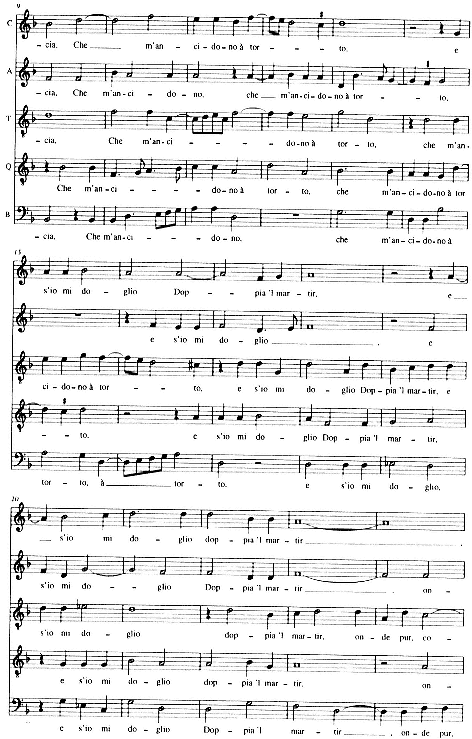
Ex. 33A.
Willaert, Giunto m'ha Amor fra belle e crude braccia (Petrarch, no. 171),
mm. 9-24; Musica nova (Venice, 1559), no. 11.
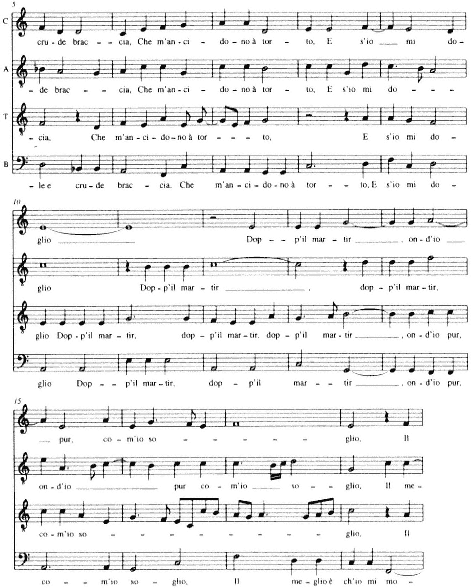
Ex. 33B.
Parabosco, Giunto m'ha Amor fra belle e crude braccia (Petrarch, no. 171),
mm. 5-18; in Antonfrancesco Doni, Dialogo della musica (Venice, 1544), fol. 14
in cantus.
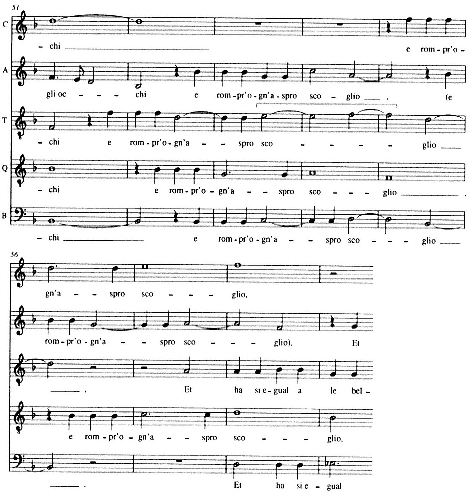
Ex. 34A.
Willaert, Giunto m'ha Amor fra belle e crude braccia (Petrarch, no. 171),
mm. 51-59; Musica nova (Venice, 1559), no. 11.
and the six-voice setting of Brevio's Cantai mentre ch'io arsi. The latter shows extensive similarities with the setting Rore had published at the head of his First Book, from the same signature and final (G mollis) and overall length (104 breves compared with Rore's 105) to numerous details of interpretation.
Cantai mentre ch'io arsi is a ballata, organized sonnetlike in fourteen hendecasyllabic verses, whose grammatical articulation coincides exactly with its formal scheme.[17]
[17] I give the poem as it appears in Parabosco's setting. Bussi mistakes the poem for a sonnet and therefore presents a wayward analysis of Parabosco's setting (Umanità e arte di Gerolamo Parabosco: madrigalista, organista, e poligrafo [Piacenza, 1961], p. 127). The form of Brevio's ballata is exactly the same as that of Petrarch's ballata no. 63, "Volgendo gli occhi al mio novo colore": a four-line ripresa (ABBA), a pair of three-line mutazioni (CDE/DCE), and a four-line volta (EFFA), all in endecasillabi.
For Parabosco's complete setting, see the eds. cited in n. 12 above and for Rore's setting see his Opera omnia, ed. Bernhard Meier, Corpus mensurabilis musicae, no. 14, AIM, vol. 2 ([Rome], 1963), pp. 1-4.
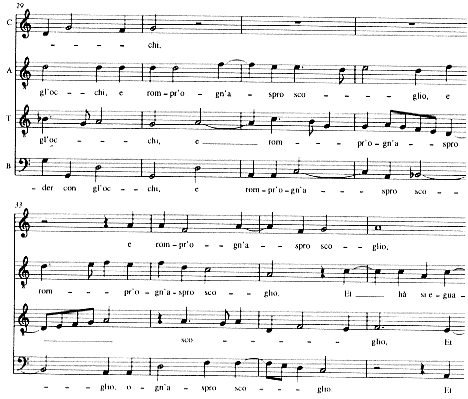
Ex. 34B.
Parabosco, Giunto m'ha Amor fra belle e crude braccia (Petrarch, no. 171),
mm. 29-36; in Antonfrancesco Doni, Dialogo della musica (Venice, 1544), fol. 14
in cantus.
Cantai, mentre ch'io arsi, del mio foco I sang while I burned from the living flame
La viva fiamma, ov'io morendo vissi, Of my fire, whence I dying lived,
Benchè quant'io cantai e quant'io scrissi Although what I sang of and what I wrote
Di madonna e d'amor, fu nulla o poco. About my lady and love were nothing, or little. 4
Ma se i begli occhi ond'il mio cor s'accese But if the lovely eyes from which my heart burned
Del lor chiaro divin almo splendore Had not wrongly found me unworthy
Non m'havessero a torto fatto indegno, Of their bright, divine, life-giving splendor,
Col canto havrei l'interno e grave ardore With a song I would have made known
Agl'orecchie di tal fatto palese, My grave inner passion to those ears,
Che pietà fora ove alberga ira e So that there might be pity where anger and disdain
sdegno. now dwell. 10
Agl'amorosi strali fermo segno I would be a sure mark for the
Sarei, pieno di dolce aspro martiro, Amorous darts, full of bittersweet grief,
Ov'hora in libertà piango e sospiro: Where now in freedom I weep and sigh:
Ahi, pace in cor d'amanti non ha loco. Oh, peace has no place in the hearts of lovers! 14
The ripresa (vv. 1-4) encloses the ballata's life-death conceit in a single extended period, then elaborated in a complex if-then qualifier by the mutazioni (vv. 5-10). The mutazioni thereby culminate in the kind of rhetorical resolution usually reserved in a sonnet for the final verse, but typical at this point in a ballata. In the third and last clause the volta (vv. 11-14) provides by comparison more modest thematic closure through a distant trope on what has gone before, while still strengthening the poem's end by reintroducing the A rhyme that frames the ripresa.
Both Rore and Parabosco avoided dividing the ballata into two parts after the ripresa but marked its chief formal divisions with strong cadences. Like most of his other settings, Rore's is extensively articulated by means of cadences at every verse ending as well as at some of the internal caesurae (vv. 2 and 3). More strongly than Parabosco's setting Rore's reinforces the structural breaks at vv. 4 and 10 with two successive cadences for each (mm. 29 and 32 and mm. 61 and 64, respectively). Parabosco's setting, by contrast, uses few cadences. The first one, a major sixth to octave on C fortified with a descending fifth in the bass, appears only at the end of the ripresa (m. 31), with a similar one on B-flat (minor third to unison, now with a rising fourth in the bass) at the end of the mutazioni (m. 72).
While paying less attention to large formal divisions, Parabosco apparently emulated some of Rore's declamatory rhythms (as at the opening). What is more, he took over voicings and intervals from a striking contrapuntal passage on "dolce aspro martiro" from v. 12 that absorbs Brevio's Petrarchan oxymoron of bittersweet grief into successions of parallel sixths (Exx. 35a and 35b).[18] Especially noteworthy in connection with Parabosco's imitation is that Rore's setting deploys parallel six-three chords first in the upper voices (mm. 75-76), later shifting them to altus and bassus in staggered declamation and writing the last two intervals as major (mm. 79-80). In so doing Rore introduced dissonance in a mild way but accentuated it with the spiky major seventh struck on "aspro" (E-flat and d, m. 80 — recall Zarlino's dicta on parallel motion and major intervals). Both passages resemble Willaert's exposition of the incipit "Aspro core e selvaggio, e cruda voglia" (Chap. 7, Ex. 16), which Parabosco himself imitated in a later setting (Ex. 38 below), as well as Rore's own apparent imitation of Willaert's exposition in setting the line "Sgombrino l'altre voglie aspr'e selvaggie" from Sfrondate, o sacre dive (Chap. 8, Ex. 32). Parabosco made similar use of parallel six-three chords in setting v. 12 from Solo e pensoso, "Ma pur sì aspre vie nè sì selvaggie," (Madrigali a 5; see Ex. 36). The entire complex of passages thus par-
[18] On Willaert's use of the six-three chord and parallel sixths as mild dissonances, see Armen Carapetyan, "The Musica Nova of Adriano Willaert: With a Reference to the Humanistic Society of 16th-Century Venice" (Ph.D. diss., Harvard University, 1945), pp. 172-73 and passim.
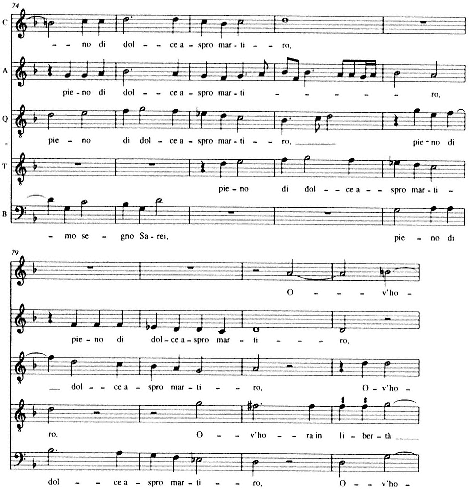
Ex. 35A.
Rore, Cantai mentre ch'i arsi del mio foco (Giovanni Brevio), mm. 74-82;
Madrigali a 5 (Venice, 1542), no. 1.
ticipates in a single musical topos that Venetian composers cultivated for expressions of harshness and wildness — a topos whose roots probably lie in Willaert's Aspro core and possibly in Rore's Cantai mentre ch'i arsi as well.[19]
The indebtedness of Parabosco's Cantai mentre ch'io arsi to Rore's setting is clearest at mm. 80-84, where it intermittently adopts Rore's parallel sixths and six-three chords when delivering "martiro" (Ex. 35b). Parabosco also adopted Rore's disposition of the text in semichoirs, high, then low (though his are more homorhythmic), and matched Rore's rhythmic declamation almost exactly (compare Rore's cantus at mm. 74-77 with Parabosco's at mm. 79-81). The only other
[19] We could also add to this group the parallel-third-filled exordium of Rore's Strane ruppi, aspri monti, alti tremanti (see Ex. 15).
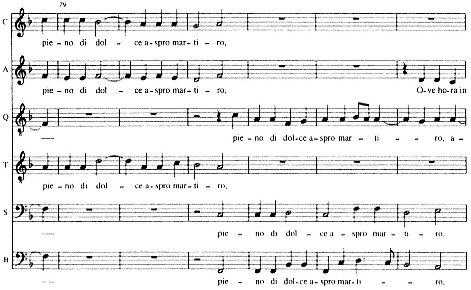
Ex. 35B.
Parabosco, Cantai mentre ch'io arsi del mio foco (Giovanni Brevio),
mm. 78-84; in Antonfrancesco Doni, Dialogo della musica (Venice, 1544),
fol. 31 in cantus.
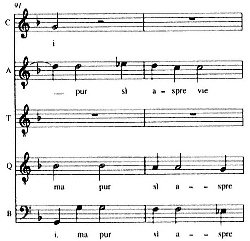
Ex. 36.
Parabosco, Solo e pensoso, i più deserti campi
(Petrarch, no. 35), mm. 91-92; Madrigali a 5
(Venice, 1546), no. 4.
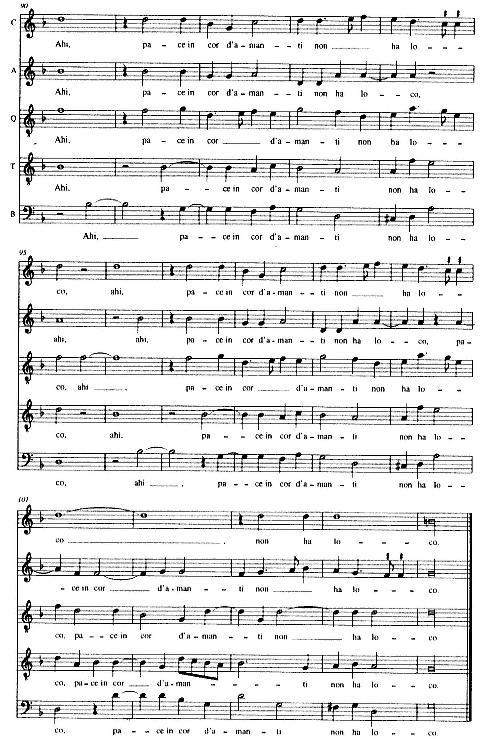
Ex. 37A.
Rore, Cantai mentre ch'i arsi del mio foco (Giovanni Brevio),
mm. 90-105; Madrigali a 5 (Venice, 1542), no. 1.
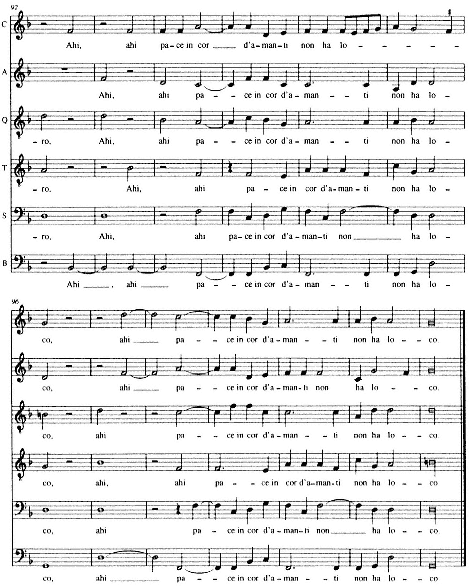
Ex. 37B.
Parabosco, Cantai mentre ch'io arsi del mio foco (Giovanni Brevio),
mm. 92-104; in Antonfrancesco Doni, Dialogo della musica (Venice, 1544),
fol. 31 in cantus.
passage that echoes Rore's so closely is the one setting the final aphorism, "Ahi, pace in cor d'amanti non ha loco" (compare Exx. 37a and 37b). Here the gasping "Ahi"s of both settings follow conventional practice, but Parabosco specifically emulated Rore in mm. 92-94 by staggering the vocal entrances in even semibreves over a B-flat in the bass.
Like Willaert's other students, Parabosco assembled his only madrigal collection, dedicated to Ruberto Strozzi, as a polyphonic miscellany.[20] All the poems in the Madrigali a 5 align themselves with a literary vernacular and most explore the amorous, metaliterary tropes of courtly Petrarchan verse. Apart from these commonalities, the book embraces a wide variety of poetic forms and registers across the whole upper range of the Ciceronian spectrum, approaching the heterogeneity of a book like Rore's second by excluding only comic, low, and dialect verse. Given the ideals of Ciceronian propriety that (I have argued) demanded this exclusion, it is no surprise that Parabosco's Madrigali a 5 bears little resemblance to his Lettere amorose, Lettere famigliari, I diporti, Il viluppo, or a host of other quasi-colloquial texts that he published between 1545 and his death in 1557. In most of these literary works Parabosco was openly eclectic, often droll, and at least a little subversive, evincing that self-serving blend of establishmentarianism and iconoclasm that defines the social climber in cosmopolitan Venice. Yet his one collection of madrigals was concertedly literary. None of Willaert's other students' books match Parabosco's in the amount of verse included that could also claim existence in literary venues. By concentrating on poems that carried enough cachet to have circulated with respectable lyric identities outside of music, Parabosco's collection could project a certain level of urbane sophistication. Perhaps to that end, the book avoids the provincial madrigalistic verse of his Piacentine countrymen Lodovico Domenichi, Bartolomeo Gottifredi, and even the wildly popular Luigi Cassola. It opens instead with two of Parabosco's own poems (a madrigal and a ballata-madrigal), then mixes in poems by more celebrated contemporaries — Baldassare Castiglione, Lodovico Martelli, Fortunio Spira, and Giovanni Mozzarello — among the many settings of Petrarch.
This chic vernacular eclecticism may explain why the book is built less on strictly high-styled, and especially "classical," sonnets than any of the other five-voice collections by Willaert's immediate pupils. Only six of its twenty numbers are complete sonnet settings (nos. 3, 4, 5, 7, 15, and 17), an additional two settings of sonnet octaves (nos. 13 and 14), as seen in Table 9. Of the nine Petrarchan settings (not counting Anima bella), only three are full sonnets, the rest partial sonnet settings (nos. 11 and 14) and stanzas drawn from canzoni (nos. 10 and 16) and sestine (nos. 9 and 12). About a third of the poems can be described as madrigals (nos. 1, 6, 8, 18, 19, and 20) or ballata-madrigals (no. 2).
[20] For the dedication see Chap. 2 n. 65 above. There is no mod. ed. of the collection at present.
| ||||||||||||||||||||||||||||||||||||||||||||||||||||||||||||||||||||||||||||||||||||||||||||||||||||||
(table continued on next page)
(table continued from previous page)
| ||||||||||||||||||||||||||||||||||||||||||||||||||||||||||||||||||||||||||||||||||||||||||
This idiosyncratic and rather paradoxical literary character — not conventionally elevated with a saturation of sonnets but nevertheless steeped in verse of recognizable pedigree — is matched by an equally unusual modal plan. Like many midcentury collections, the book is organized by cantus mollis and cantus durus as well as by final. The design that results seems to consist of four modal categories irregularly arranged without regard to ambitus: protus (nos. 1-4), tritus (nos. 5-8), deuterus (nos. 9-14), and tetrardus (nos. 15-20).[21]
Among the weightiest and surely the best-known setting in the Madrigali a 5 is Parabosco's Aspro cor. Since Helga Meier's study of 1969, it has been widely recognized that Willaert's students at San Marco emulated some of his Musica nova settings with borrowings and citations in their resettings of the same texts.[22] Given that Aspro cor is the only one of Parabosco's settings to have done so directly, it is not surprising that it took over Willaert's decorum, gravity, careful rhetorical shaping, and many of his specific readings more completely than did any of Parabosco's other settings. (We will see that Parabosco's colleagues also followed Willaert's practices most closely when actually modeling their settings on his.) Indeed, Parabosco's imitation of Willaert is arguably even more striking than Meier made out.[23] It quotes almost literally the extraordinary conception Willaert imposed on the first verse, even while replacing Willaert's G-durus eighth mode with a G-mollis transposed second (Ex. 38; cf. Ex. 16). It also adopts the descending melodic profile of the main motive and, like Willaert's, introduces the vocal groups in a three-plus-three arrangement (v. 1; v. 1 repeated — though with Parabosco's reduction to five voices, one voice sings v. 1 twice). And, most important, it borrows the six-five and four-three suspensions, the parallel major thirds mentioned by Galilei, and the concentration of major imperfect intervals that makes Willaert's setting so distinctive.
Yet Parabosco's departures from Willaert's version reveal even more than his borrowings, for on the whole he alleviated the austerity of Willaert's reading despite the harsh character of the poem. The tenor voice that begins the exposition imitates Willaert's motive, but its effect is undermined by the syncopated entrance of the alto a minim later and a new syncopation introduced in the cantus in mm. 2-3. These syncopations lighten the overall ethos of the passage while slighting considerations of textual stress and sense: the word "e" invites syncopation and prolongation in the cantus not for its accentual position or textual meaning but only to allow a more sensuous surface. Willaert's rhythms, by comparison, initially spaced a semibreve apart and wholly bound to the tactus through v. 1, help fix and maintain a more
[22] "Zur Chronologie der Musica Nova Adrian Willaerts," Analecta musicologica 12 (1973): 71-96.
[23] For a mod. ed. of the madrigal see Fünf Madrigale venezianischer Komponisten um Adrian Willaert zu 4-7 Stimmen, ed. Helga Meier, Das Chorwerk, vol. 105 (Wolfenbüttel, 1969), pp. 14-22. See also Meier's discussion of the madrigal in the preface to the edition, p. iv, and in "Zur Chronologie der Musica Nova, " p. 78. In Fünf Madrigale Meier points out how Parabosco's setting of Aspro core and Donato's setting of I vidi in terra angelici costumi and Liete e pensose made explicit references to Willaert's models by placing citations in exposed positions at the beginnings or ends of one of the parti.
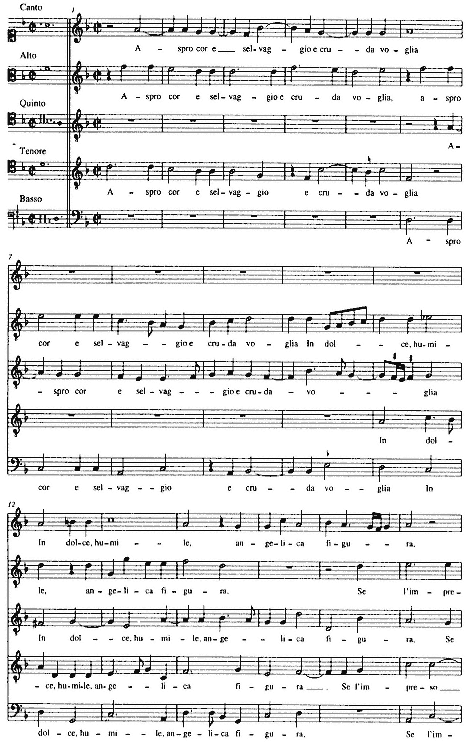
Ex. 38.
Parabosco, Aspro cor e selvaggio e cruda voglia (Petrarch, no. 265),
mm. 1-17; Madrigali a 5 (Venice, 1546), no. 3.
solemn pulse. The slow stepwise motion is hardly relieved by repeated minims, which do no more than fill in the basic semibreve structure.
In fact, Parabosco nearly reversed the role of metric stress and the discrete roles of tonic and agogic accents that Palisca found so striking a feature of Willaert's rendition, especially Willaert's staunch avoidance of syncopation in v. 1 and exploitation of it in v. 2; (see Chap. 7 n. 59). Furthermore, Parabosco's setting minimizes semantic contrasts between the verses by sprinkling the repetition of v. 1 with dotted semiminims while reducing the level of syncopation in v. 2. Despite the sdrucciolosa lilt in Petrarch's second verse, Parabosco had all the voices but the alto enter on the tactus. Similarly, he minimized the major-minor intervallic polarities that Palisca noted in Willaert's model by eliminating v. 2's emphasis on minor intervals. The only consistent way in which Parabosco realized these semantic dichotomies was through conventions that aligned textual meaning with melodic direction, moving largely downward for v. 1 and upward for v. 2.
In later passages Parabosco actually appropriated more completely Willaert's rhetorical delivery. At the beginning of v. 7, "Piango ad ogn'hor," for example, his setting exploits the same minor intervallic relationships with which Willaert's had personified the poet's weeping in the second quatrain (Exx. 39a and 39b).
Che quando nasce e mor fior erba e foglia, For when the flowers, grass, and leaves are born or die,
Quando è 'l dì chiaro e quando è notte oscura, When it is bright day and when it is dark night,
Piango ad ogni hor. Ben ò di mia ventura, I weep at all times. From fate,
Di Madonna, e d'Amor onde mi doglia. From my lady, and from Love I have much to grieve me. 8
Parabosco's setting concentrates on minor seconds and minor thirds, stressing the relationships B-flat/A and B-flat/G (cantus, tenor, quintus), as well as D/E-flat and E/F (altus). Beyond this, both settings take the beginning of v. 7 as a point of formal rupture by emphasizing the prosodic asymmetry it introduces into the quatrain. The nine and a half breves Willaert assigned to the first part of v. 7, "Piango ad ogn'hor" (as opposed to eight for all of v. 5 and seven for v. 6) magnify it rhetorically; Parabosco follows suit with eleven breves (compared with nine and eight and a half for vv. 5 and 6, respectively), and both set up its entrance with a perfect cadence and a registral shift to end v. 6 (aided in Willaert's case by a slowed surface motion).
Parabosco's setting continues to evoke the memorable textural, rhythmic, and tonal events that Willaert had deployed to mark the sonnet's major formal-expressive divisions in the sestet. But, here again, his setting mollified Willaert's effects. The voicing that opens Parabosco's seconda parte — three homophonic inner voices leading off, a fourth joining them after a semibreve, and the bass entering two and a half breves later — borrows from Willaert's, and the bass line in fifths comes from Willaert too (though Parabosco fails to sustain it beyond three chords). Parabosco
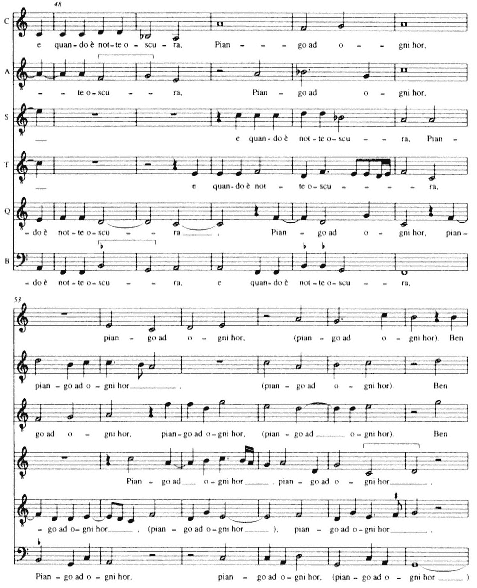
Ex. 39A.
Willaert, Aspro core e selvaggio e cruda voglia (Petrarch, no. 265),
mm. 48-58; Musica nova (Venice, 1559), no. 14.
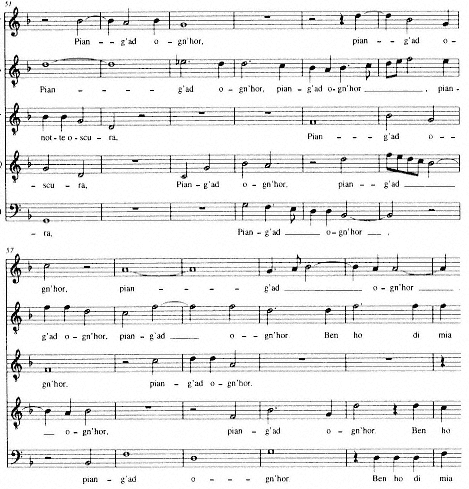
Ex. 39B.
Parabosco, Aspro cor e selvaggio e cruda voglia (Petrarch, no. 265),
mm. 51-62; Madrigali a 5 (Venice, 1546), no. 3.
used Willaert's rhetorical markers again at the beginning of the second tercet, "Non è sì duro cor che lagrimando," by isolating the first half of the verse, but here his motivic and tonal manipulations enervate the model even more (Exx. 40a and 40b). Willaert had started with a cross relation introduced by f-sharp in the sextus (third voice from the top, m. 103), which occurs within yet another brief circle-of-fifths progression, A to C, originating in the previous phrase. All but one of his approaches to "duro" hammers away in repetition figures that move up by major second. Parabosco treats the clause less uniformly, maximizing motivic and metric variety between parts where Willaert's setting pointedly avoids doing so, while underscoring Petrarch's verbal dissonance. His tenor leaps on "duro" to a mild minor sixth over the bassus (m. 105), resolving immediately to a perfect fifth. Three measures later (mm.
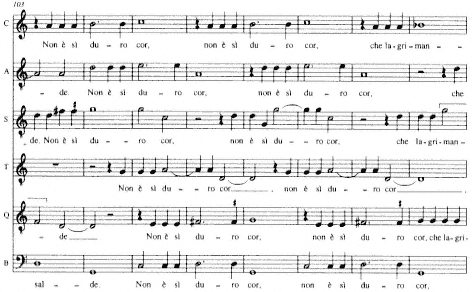
Ex. 40A.
Willaert, Aspro core e selvaggio e cruda voglia (Petrarch, no. 265),
mm. 103-10; Musica nova (Venice, 1559), no. 14.
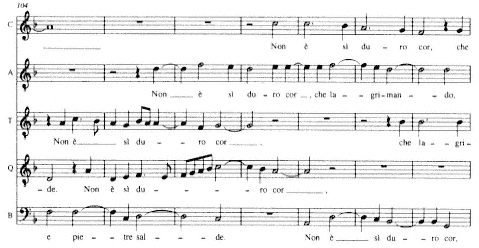
Ex. 40B.
Parabosco, Aspro cor e selvaggio e cruda voglia (Petrarch, no. 265),
mm. 104-10; Madrigali a 5 (Venice, 1546), no. 3.
108-9) suspended parallel sixths between outer voices invoke the madrigal's beginning.
Willaert's and Parabosco's treatments of the sonnet's final verse, "Ne sì freddo voler che non si scalde" (nor is there a will so cold that it cannot be warmed), resemble one another rhythmically but only confirm the sense that Parabosco largely refrained from riveting particular rhetorical effects to a single musical reading. In syncopating "freddo" with a dotted figure, Willaert's reading reinforced a level of
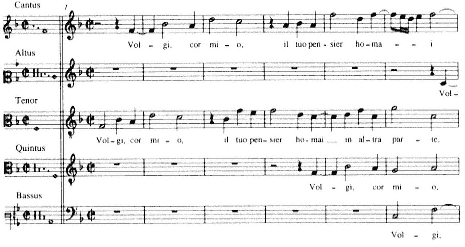
Ex. 41.
Parabosco, Volgi, cor mio, il tuo pensier homai (Fortunio Spira),
mm. 1-6; Madrigali a 5 (Venice, 1546), no. 7.
dissonance that Petrarch's poem achieves through consonantal clusters. The pompous energy of his syncopations captures rhythmically the spirit of the "cold will." By declaiming the word wholly in minims and thus misaccenting both syllables, Parabosco turned his back on Willaert's text-generated diction, giving up Willaert's semantic emphasis as well as the means to a stagier rhetorical climax.
Willaert's submission of all dimensions of his Musica nova madrigals to the rigors of a rhetorically determined declamation resulted in a speechlike musical oratory that his pupils generally pursued less adamantly than they did endearing local moments. The difference is evident even in Parabosco's sonnet settings, many of which (like Aspro cor ) are less weighty than one might expect. We should recall in this regard that in midcentury Venice a preoccupation with Petrarch did not necessarily signal elitism or even imply de facto a preference for sonnets. Petrarch after all was the most widely disseminated poet in the marketplace of printed editions and commentaries, and the sonnet by far the most common genre of the mid-sixteenth century (as abundantly evident in the copious anthologies of the time). Not all of the modern sonnets Parabosco set were especially introspective, nor were his settings of them. Mozzarello's O desir di questi occhi, for one, is an untroubled series of apostrophes to the beloved ending with a vaguely erotic "Deh, sarà mai ch'io vi riveggia et oda?" (Ah, will I ever see and hear you again?) that Parabosco set lightly in a compact ninety-four breves.[24] Similarly, his cheerful fifth-mode setting of Spira's Volgi, cor mio, il tuo pensier homai depicts a spurned poet who makes a pact with his heart over a disdainful lady; for this Parabosco opened with a cantus-tenor duet in quixotic fourths and graceful syncopations (Ex. 41).
[24] See the ed. in Bussi, Composizioni, pp. 38-50. It is not the only setting so brief; Parabosco's setting of Petrarch's Gli occhi di ch'io parlai is only eighty breves long.
Poems like these did not invite the expansively weighty style Parabosco used to set sonnets like Aspro core, Solo e pensoso, or I' vo piangendo.[25] Still further from these Petrarch sonnets — indeed at the opposite end of the spectrum — are settings like that of Martelli's madrigal Ultimi miei sospiri.
Ultimi miei sospiri, My last breaths,
Che mi lasciate fred'e senza vita, Which leave me cold and lifeless,
Contate i miei martiri Recount my sufferings
A chi morir mi vede e non m'aita. To one who sees me and does not help me.
Dite, o beltà infinita, Speak, oh infinite beauty, 5
Dal tuo fidel ne caccia empio So that your faithful one may drive out bitter
martire; suffering;
Et se questo l'è grato, And should this please her,
Gitene ratto in ciel', a miglior stato. Go swiftly to Heaven, to a better state.
Ma se pietà gli porg'il vostro dire, But if your speech arouses pity in her,
Tornat'a me, ch'io non vorrò morire. Return to me, for I do not wish to die. 10
Since settenari appear equally with endecasillabi here, Parabosco turned out shorter melodies than he did for sonnets (see Ex. 42). Many of the phrases span a single settenario in the manner of earlier Italian secular music — an approach also evident in his canzone settings like the stanza from Petrarch's Amor, se vuoi ch'io torni. Unlike the motetlike expositions of Venetians' sonnet settings, Ultimi miei sospiri moves in fast surface rhythms right from the opening, with entrances driving at a buoyant minim rate instead of the standard semibreve. The playful rhythmic assonance of the exposition — accented "miei" against "-mi" and "spi-" against "so-," piling strong / weak accents amid waves of syncopations — sets the tone for the rest of the madrigal. Parabosco accentuates it with fragmentary divisions of the verse, breaking off "sospiri" from "ultimi miei" with the little gasp that precedes so many sixteenth-century sighs (and even a repetition of "ultimi miei" in the tenor part). Some of the strategies he uses resemble those of contemporaneous black-note madrigals, with their widely divergent note values. Note, for example, how sharply "Gitene ratto in ciel" (v. 8), spit out in groups of semiminims (mm. 44-52), contrasts with the calm apostrophe following the double bar, "Dite, o beltà infinita" (mm. 37ff.).[26]
[25] In his setting of the two quatrains from I' vo piangendo Parabosco's extreme extension of the Venetian madrigal's new ideal of breadth seems almost like an exercise in one-upsmanship. By increasing dramatically the proportion of notes to words he virtually "used up" what he must have considered the allowable space for each parte, leaving no room for the sestet after 104 breves. A little arithmetic helps to clarify the point: had Parabosco set the complete sonnet with the same number of breves per verse as in the octave (on average thirteen), the entire madrigal would have expanded to 182 breves — an unheard-of size for a sonnet setting of the time. Rather than setting the sestet he merged two currently viable alternatives, the prototype of the extended sonnet setting developed by the Venetians and that of the truncated octave setting common in lighter madrigal repertories of the time.
[26] "Volti subitamente," from v. 5 of the sestina Mia benigna fortuna (also included in the Madrigali a 5 ), is set similarly to "Gitene ratto in ciel."
Parabosco's use of tritus modes for setting poems like Ultimi miei sospiri and Volgi, cor mio — modes generally described by modal theorists as more joyful than deuterus or protus plagal — raises the question whether Parabosco tried to fulfill criteria of modal affect or modal structure. We have already seen that neither Willaert's settings, nor even those of Rore's modally ordered First Book, reveal clear links between mode and affect apart from some intriguing cases of Phrygian. Yet Parabosco's book, despite its unorthodox organization, presents some suggestive evidence to the contrary. The tritus works in F mollis all set facile poems, save perhaps the sonnet of Castiglione. The protus group, on the other hand, seems to divide affectively according to the traditional bifurcation of ambitus: the two poems by Parabosco may have been meant to represent first mode, the dark
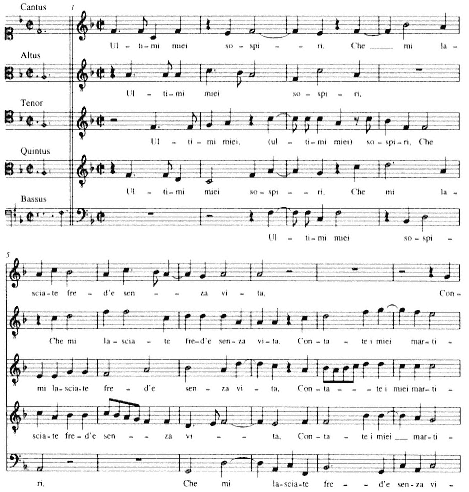
Ex. 42.
Parabosco, Ultimi miei sospiri (Lodovico Martelli), incl.; Madrigali a 5
(Venice, 1546), no. 6.
(continued on next page)
(continued from previous page)
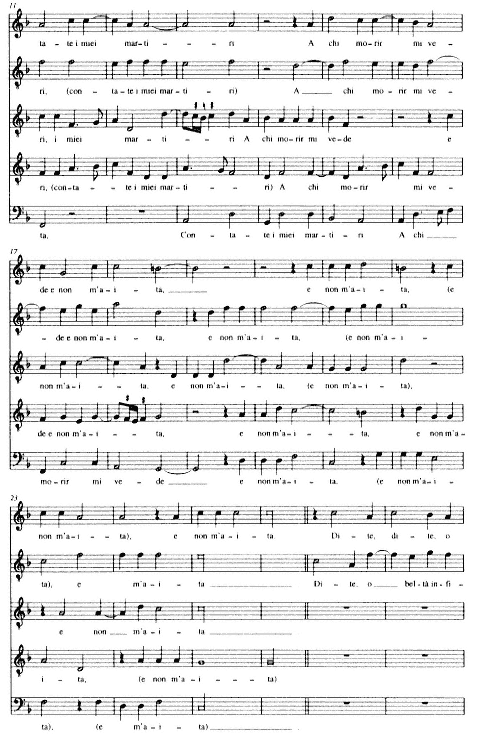
Ex. 4.2
(continued)
(continued on next page)
(continued from previous page)
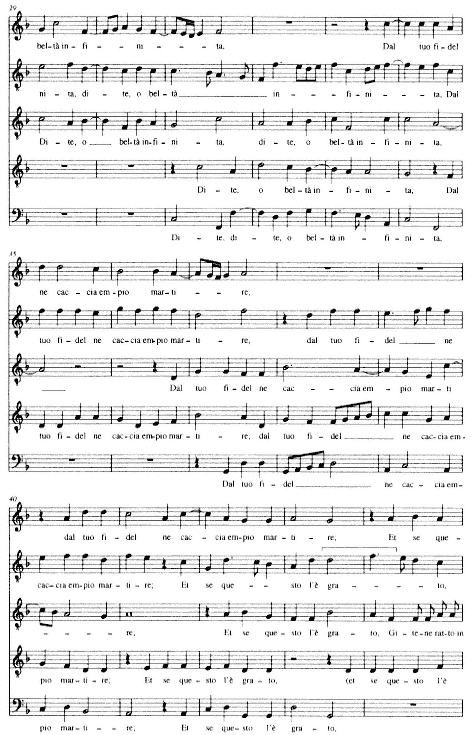
Ex. 4.2
(continued)
(continued on next page)
(continued from previous page)
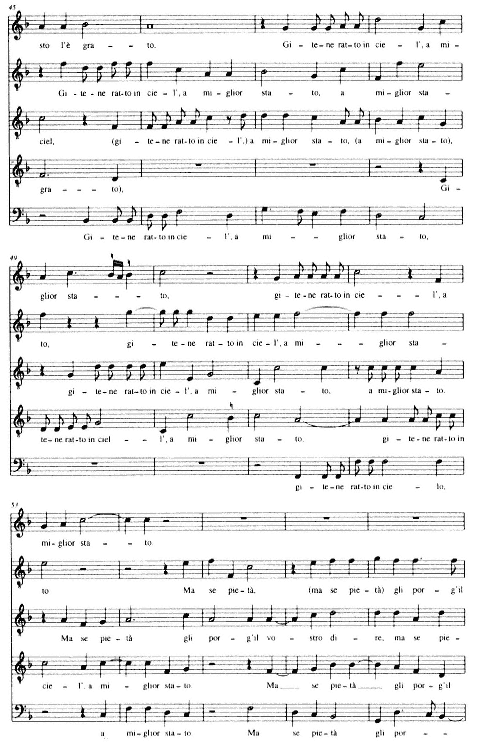
Ex. 4.2
(continued)
(continued on next page)
(continued from previous page)
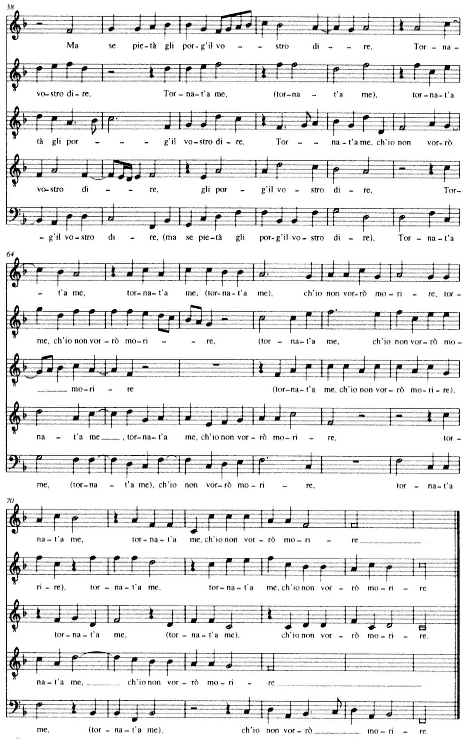
Ex. 4.2
(continued)
Petrarchan sonnets Aspro cor and Solo e pensoso second mode. Most strikingly, all of the settings in the deuterus (Phrygian) category come from the "in morte" portion of Petrarch's Canzoniere — even the first four lines of the adapted Anima bella.
All of this jibes well with other knowledge of Parabosco. His debt to Rore's modally ordered Primo libro is clear at least in the case of Cantai mentre ch'io arsi and his book was dedicated to Rore's early patron Ruberto Strozzi. If modal issues occupied a place in the dialogues of Venetian salons, Parabosco would have been at the center of them, for he was as close to academic life there as any composer in the city.
Perissone Cambio: Madrigals for Five Voices
FORESTIERO: And who have you got here in the way of noteworthy men?
VENETIAN: Starting with musicians, we have Messer Adrian Willaert, who is chapel-master at San Marco, and you know what his fame is.
FORESTIERO: I've heard him called the Prince of Musicians.
VENETIAN: We also have Perissone, a soprano without equal who's been sought out by many princes but wouldn't exchange Venice for any other city.
FORESTIERO: It seems to me he's wise.[27]
Perissone Cambio was Willaert's most prolific disciple in the mid- to late 1540s. In addition to a book of canzoni villanesche alla napolitana dated 1545 he published three independent collections of madrigals, the two five-voice books of 1545 and 1550 and a four-voice book of 1547. All but the last were produced before Perissone even joined the roster at San Marco. Owing to a lack of positions or funds he entered the chapel only on 19 July 1548, before a real post had come available, and then, remarkably, on an unsalaried basis. Perissone owed his position to an unprecedented personal manoeuvre by doge Francesco Donà, who was effective in Perissone's being awarded the next valid opening seven months later, on 8 February 1549.[28] By that time Perissone may have developed connections with Rore as well as with Willaert, for Scotto's edition of Rore's Third Book of madrigals of 1548 (RISM 15489 ) had included one of Perissone's works (as Rore's second book had done four years earlier) and Perissone's Primo libro a quatro voci offered first printings of three
[27] For: E chi ci havete di huomini segnalati?
Ven. Cominciando dà Musici, noi ci habbiamo M. Adriano Vuigliaret, ilquale è Maestro di Capella di S. Marco, e voi sapete quale è la sua fama.
For. Lo ho sentito chiamar Principe de Musici.
Ven. Habbiamo similmente Perissone per Sorano senza alcun paro, ilquale desiderato da molti Principi, ma però non cambiarebbe Venetia per altra Città.
For. Mi par che sia savio.
From Francesco Sansovino, Delle cose notabili che sono in Venetia. Libri due, ne quali ampiamente, e con ogni verità si contengono (Venice, 1565) fol. 33; ded. 17 Sept. 1561. Il Venetiano goes on to name the other great musicians of that time: "il Salo Basso, il Zeffiro, il Franzese, Marc'Antonio, M. Angelo, Don Galeazzo da Pesaro, gentiliss. Spirito, Silvestro da Fontego, i Fauretti, Matteo dalla Viola, il Tromboncino, Annibale Organista, Claudio, Frate Armonio, e molti altri tutti eccellenti" (fols. 33-33').
[28] Ongaro, "The Chapel of St. Mark's," pp. 127-28.
of Rore's madrigals. In addition, the printer Gardane appears to have exploited Perissone's connections with Rore by having him write the dedication to Gardane's edition of Rore's Third Book (RISM 154810 ).
Francesco Donà numbered among several powerful Venetians who took an interest in Perissone's talents — a factor that was instrumental in building up his reputation as a singer and composer during the mid-forties. As we saw in Chapters 3 and 4, Perissone profited from the patronage of Gottardo Occagna, Antonio Zantani, and (most likely) Domenico Venier, and we can imagine him among the impressive performers Doni witnessed in Neri Capponi's salon too. Perissone was probably one of the showiest singers in the salons, a performer who repeatedly won plaudits in print for his singing, and, moreover, a singer of treble parts.[29]
Nothing precise is known of Perissone's origins or of the route that took him to Venice — only that he was Flemish, according to a privilege granted to him by the Senate.[30] By 1544 Perissone's five-voice setting of the anonymous sonnet Che cosa al mondo far potea natura appeared in Rore's Secondo libro and a four-voice setting of Vivo sol di speranza, rimembrando (the sestet of Aspro core ) in Arcadelt's Quinto libro.[31] He made his first major appearance that same year in Doni's Dialogo della musica, where he was designated an interlocutor along with Parabosco, Veggio, and others.[32] Doni's text already places him within a group that pictures itself on the cutting edge of Venetian musical developments. After those assembled sing his setting of Bartolomeo Gottifredi's Deh, perchè com'è il vostro al nome mio, one of the interlocutors praises Perissone as an "accomplished young man and commendable person" with a "beautiful voice" and fine compositional technique.[33]Deh, perchè is one of two madrigals of Perissone's in the Dialogo' s Venetian second half, the other a six-voice setting of Giunto m'ha Amor.[34]
In this early repertory Perissone was already cultivating both stylistic poles of a dichotomy that has been emerging gradually in our discussions of Venetian madrigals — the dichotomy between a songlike polyphony generated directly out of lyric form and meter and a more declamatory, motetlike polyphony shaped by
[29] Though the chapel rolls list Perissone as an alto, Francesco Sansovino's dialogue cited in n. 27 above suggests he must have taken the more difficult upper parts often enough to have been regarded popularly as a soprano, as Giulio Ongaro has argued ("The Chapel of St. Mark's," pp. 105 and 132). Ongaro notes that the term soprano was often used loosely, probably to designate anyone who sang the top line of a composition.
[30] See n. 38 below.
[31] The sestet had earlier been set by Arcadelt and published in his Terzo libro of 1539.
[32] See James Haar, "Notes on the Dialogo della musica of Antonfrancesco Doni," Music & Letters 47 (1966): 198-224, and Chap. 1 above, n. 56.
[33] The praise is initiated by the Piacentine Count Ottavio Landi: "Oh che belle parole, oh che bel canto! Perison certamente ha preso un modo dolce, fugato, chiaro e bellissimo." To this the female interlocutor Selvaggia responds, "Valente giovane e persona virtuosa non poteva far se non divinamente." Depicted here, like the other males in the dialogue, as an amorous courtier, Perissone responds by swearing fealty to Selvaggia (Dialogo della musica, p. 121).
[34] Ibid., pp. 114-20 and pp. 232-42, respectively; in Malipiero's ed. Giunto m'ha Amor is wrongly attributed to Willaert. It reappeared in 1546 in Madrigali di Verdelot et de altri autori a sei voci novamente con alcuni madrigali novi ristampati & corretti [RISM 154619].
rhetorical qualities and proselike diction. Deh, perchè and Giunto m'ha Amor mark the crystallization of this dichotomy. Gottifredi's poem concretizes the internalist poetics of Petrarch in playful, realistic, and sweetly erotic conceits, here encapsulated in the poet's plea that the beloved match his desire as her name does his.
Deh, perchè com'è il vostro al nome mio Oh why, since your name
Parimente conforme Conforms to mine
A mia voglia non è vostro desio? Does not your desire to my longing?
Scaldat', oimè scaldate, Warm, oh warm,
Donna gentil, nel mio amoroso ardore Gentle lady, your frozen desires 5
Vostre voglie gelate, In my loving ardor,
Che se qual esce fuore For if, just as the same sound
De i nomi un suono stesso Issues forth from our names,
Fosse par il voler nei cori impresso: The same desire were only impressed in our hearts,
O che bell'union d'animi santi, Oh what a lovely union of blessed souls, 10
O fortunati amanti! Oh fortunate lovers!
Perissone's setting of Deh, perchè has nothing of the pious Willaertian sobriety and complexity Perissone aspired to (however partially) in sonnet settings. Instead it indulged in sweet cascading melody and light, airy counterpoint to create a clear formal exposition, notable in the way the cantus's opening bars lay out Gottifredi's first period (Ex. 43). Perissone's exordial cantus traces the poetic exposition (vv. 1-3) in a series of ascents that rise by successive steps, peaking on the confinal dd, dropping to a caesura on aa (and "mio"), then reascending for a more ecstatic reiteration of dd ("conform'a mia voglia non è") before the syncopated stepwise descent ("vostro desio"). His writing displays the skill of a great arioso melodist, with the cantus unbroken from start to finish, suspending a large melodic arc between two tonal axes. Unlike the recitational melodies and equal-voiced polyphony of Willaert's and Rore's madrigals, here poetic affect is projected mainly through melodious adornment of the text. With the G-mollis tonality, chiavette cleffing, and delicate coloration, Perissone fashions an engaging chiaroscuro in polyphonic accompaniment to the lyrical cantus. The profusion of cross relations that result (C/C-sharp, F/F-sharp, E/E-flat, and B/B-flat) were ones he continued to exploit in later madrigals.[35] In this lyric and coloristic ebullience, some of the words go breezily misaccented ("pa-ri -men-te ") and in a way that resists the rigors of Willaert's sternly Bembist approach.
If the melodic style of Deh, perchè is pretty and tuneful, the six-voice setting of Giunto m'ha Amor shows that Perissone already knew something of the more severe idiom Willaert reserved for Petrarch's sonnets. Giunto m'ha Amor adheres closely to
[35] On the matter of cross (or false) relations see James Haar, "False Relations and Chromaticism in Sixteenth-Century Music," JAMS 30 (1977): 391-418.

Ex. 43.
Perissone, Deh, perchè com'è il vostro al nome mio (Bartolomco Gottifredi),
cantus, mm. 1-13; Madrigali a 5 (Venice, 1545), no. 1.
the even pulse of Willaert's setting with only occasional syncopations. At the same time it exploits harmonic coloration almost as much as Deh, perchè. A single example may be seen in the sonorities at "Che m'ancidono a torto" (Ex. 44), where Perissone alternately strengthened the fifth motion of the bass from D to B-flat (mm. 14-17) or colored the text through the addition of accidentals.
Reminiscent of Parabosco's 1544 settings, Perissone's Giunto m'ha Amor set only lines 1 through 8. By the time his first collection, Madrigali a cinque voci, was published in 1545, however, Perissone had begun to treat texts more as literary artifacts. Much like Rore's First Book, the Madrigali a 5 published twelve sonnet settings, all unabridged,[36] along with a few lighter settings including Deh, perchè at the head. This is the same mix seen in all the Venetian collections assembled principally for commercial markets, but the bibliographical history of Perissone's book explains more than most about the social context that helped generate it.
The Madrigali a 5 is an unsigned print. According to Jane Bernstein, it was probably produced in the publishing house of Girolamo Scotto — head of a consortium of printers — and most likely printed by Ottaviano Scotto.[37] The venture was engineered by Perissone himself, as made clear enough from the survival of a privilege he applied for from the Venetian Senate in order to print it.[38] As his first publication, the Madrigali a 5 thus represents Perissone's effort to make his name in Venice with a collection devoted exclusively to his own works (as I argued in Chapter 3). These circumstances are corroborated by its long and highly suggestive title page, which implies that the madrigals the book contains originated from a social setting much like the one depicted by Doni.
[36] For my ed. of the book see Sixteenth-Century Madrigal, vol. 2 (New York, 1990).
[37] "The Burning Salamander: Assigning a Printer to Some Sixteenth-Century Music Prints," Music Library Association Notes 42 (1985-86): 483-501, esp. pp. 493 and 497.
[38] Perissone applied for the privilege in June 1545, granted with the description "La musica per lui composta de madrigali sopra li sonnetti del Petrarcha"; see Einstein, The Italian Madrigal 1:439, and Richard J. Agee, "The Privilege and Venetian Music Printing in the Sixteenth Century" (Ph.D. diss., Princeton University, 1982), pp. 95-96 and 179.
It might be of interest that the print has a fairly high number of errors; see the notes that accompany my ed. cited in n. 36 above.
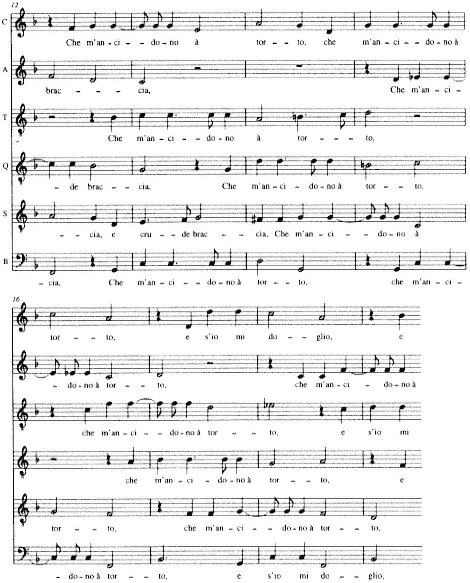
Ex. 44.
Perissone, Giunto m'ha Amor fra belle e crude braccia (Petrarch, no. 164),
mm. 12-19; in Antonfrancesco Doni, Dialogo della musica (Venice, 1544),
fol. 38 in cantus.
Madrigals for five voices by the excellent musician Messer Perissone Cambio, composed for the pleasure of various friends of his and now brought to light at the request of the same, and corrected, revised, and arranged by the composer himself. Never before seen or printed. Five voices. Venice, 1545. With grace and privilege.
Notwithstanding the claim that none of the madrigals had been previously printed, the book does signal Perissone's first major step into the public eye and his first efforts as an entrepreneur. His avowal in the dedication to Occagna that he himself is "having a few of [his] . . . madrigals for five voices printed" tends to confirm this.[39]
To the Noble and Valorous Signor Gottardo Ochagna
My most honorable lord, your virtue, kindness, and courtesy, having obligated me as much as anyone else who considers and experiences them, I cannot but always wish to find a way whereby I might somehow show you some sign of the love that I bear to you, thanks to your divine qualities. Therefore, my lord, knowing that, among the many other such rare virtues in which my lordship delights, Music is one that pleases you exceedingly, I did not want to lose this opportunity. So, since I am having a few of my madrigals for five voices printed — however they may be — I make a gift of them to your lordship in order to give you a small sign of the great desire I have to serve you. Might you then deign to accept with your usual kindness my humble present, keeping ever in mind the affection in my heart. Your perpetual servant, Perissone Cambio
In turning for backing to an afficionado of vernacular letters as well as music, Perissone made visible the symbiotic threads of his inaugural book: its self-promotional origins, its involvement in the new Venetian vogue for setting Petrarch's sonnets, and its appeal to consciously styled literary tastes in the vernacular. Not all the madrigals in it are settings of Petrarch's sonnets (as the privilege implied), but sonnet settings do occupy nearly three-quarters of the book and over half of these are Petrarch's (see Table 10). The others include some novel literary choices: one by Petrarch's early fifteenth-century Florentine imitator, Buonaccorso da Montemagno (no. 8), one by the Neapolitan poet of the early sixteenth century Jacopo Sannazaro (no. 15), and one of mixed attribution, probably by the eminent sixteenth-century Petrarchan Vittoria Colonna (no. 11).[40] All of the sonnet settings, moreover, are complete — still a new practice in the mid-forties, the only real precedent (among printed works) for which was Rore's First Book.
[39] See Chap. 3 above, nn. 13-14, and for the original title page and dedication Plates 9 and 10.
[40] With the exception of Buonaccorso and Colonna, the identifications I make here are found in Il nuovo Vogel 1:304-5. In addition to the poetic source given in Table 10, Buonaccorso's sonnet is reprinted in Poesia del quattrocento e del cinquecento, ed. Carlo Muscetta and Daniele Ponchiroli, Parnaso italiano, no. 4 (Turin, 1959), p. 13. The text of no. 2 is attributed to Colonna in Rime diverse, di molti ecc. autori . . . libro primo, 2d ed. (Venice, 1546), p. 293, but Vogel names its author as Cottemanno, probably on the basis of its inclusion in Philippe de Monte's collection devoted to Cottemano's spiritual poems, Primo libro de' madrigali spirituali a cinque voci (Venice, 1581). The earlier attribution to Colonna seems more likely. The other sonnet settings, nos. 4 and 6, remain anonymous.
| ||||||||||||||||||||||||||||||||||||||||||||||||||||||||||||||||||||||||||||||||||||
(table continued on next page)
(table continued from previous page)
| ||||||||||||||||||||||||||||||||||||||||||||||||
Indeed, Perissone could well have gotten various ideas for his own collection from Rore's, including the idea of ordering the corpus by mode, with high-clef arrangements (chiavette) standing in for authentic modes, lower clefs for plagals. Rore's Primo libro may also have helped inspire Perissone's inclusion of several black-note madrigals using common time signatures (C), copious syncopation, and a wide range of rhythmic values (nos. 6, 9, 12, and 14).
Unlike Rore's, however, all of Perissone's sonnet settings divide (like Willaert's) after the octave, and none of them actually resets sonnets set by Rore. Instead, three of the six Petrarch sonnets (nos. 3, 12, and 16) were among those later published in the Musica nova, making the Madrigali a 5 the first in the stream of books to imitate directly Willaert's madrigalian practice. Two of these, Cantai, hor piango and I piansi, hor canto, respond frankly to an implicit compositional challenge. In Cantai, hor piango Perissone adopted a characteristic imitative procedure from Willaert's exposition, compressed it, and simplified it thematically. (See the beginning of Willaert's setting in Ex. 45a and Perissone's imitation in Ex. 45b.) Following his model, Perissone introduced the downward- and upward-moving versions of the opening motive a semibreve apart but varied the whole texture less than Willaert had. He discarded the simple breve/semibreve motive that Willaert had assigned
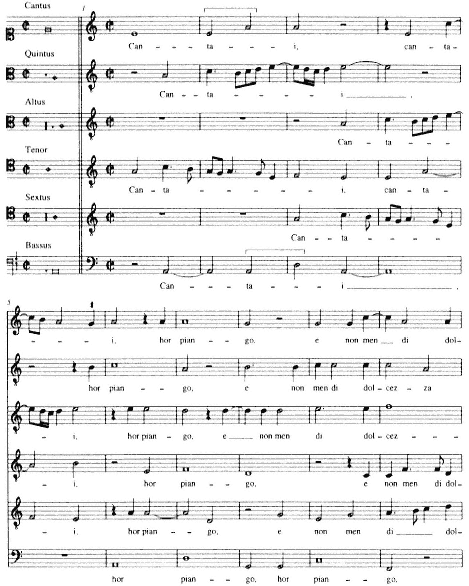
Ex. 45A.
Willaert, Cantai, hor piango, e non men di dolcezza (Petrarch, no. 229),
mm. 1-27; Musica nova (Venice, 1559), no. 17.
(continued on next page)
(continued from previous page)
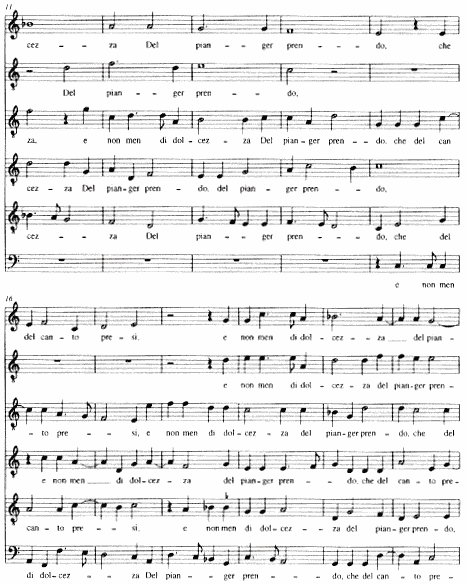
Ex. 45A
(continued)
(continued on next page)
(continued from previous page)
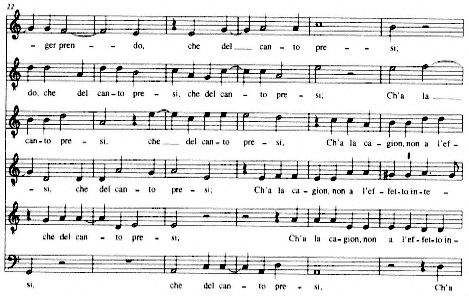
Ex. 45B.
Perissone, Cantai, hor piango, e non men di dolcezza (Petrarch, no. 229),
mm. 15-18; Madrigali a 5 (Venice, 1545), no. 3.
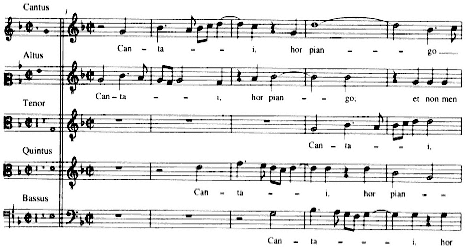
(continued on next page)
(continued from previous page)
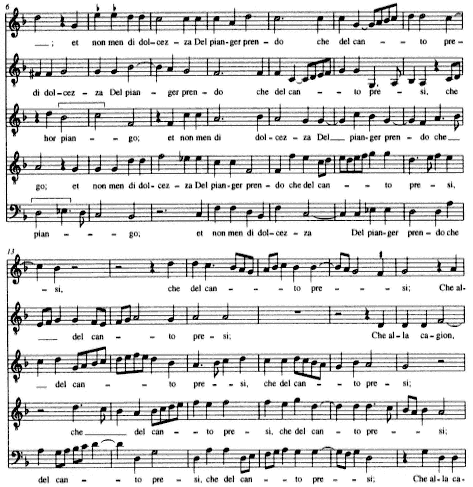
Ex. 45B
(continued)
to "cantai" in the outer parts and in place of Willaert's double-subject counterpoint created a simpler single-subject point of imitation with every voice stating the lone motive either in its original form or in inversion.
Perissone's opening also lacks the chiming multivoiced effect that Willaert achieved by exploiting closely staggered inner parts. In Willaert's setting each of these parts enters on the same note, a, the parts paired symmetrically with quintus inverting tenor, then altus inverting sextus. The contrapuntal and motivic intricacies spread over twelve breves and more before v. I is played out by all voices, as compared with seven in Perissone's setting. Perissone's smaller exposition is characteristic of his generally shorter-winded approach and the smaller proportions of his work as a whole in comparison with Willaert's (53 and 57 measures, as compared with 70 and 69 in Willaert's): the different sizes result from dissimilar ways of handling poetic and musical materials. Willaert's varied parsings often explore a variety
of syntactic divisions and groupings for a single excerpt of text, while Perissone reads more uniformly to produce terser settings overall.
Note, for instance, the array of alternatives Willaert searched out in parsing the first two verses of Cantai, hor piango:[41]
1. Cantus: Cantai / cantai / hor piango / e non men di dolcezza Del pianger prendo / che del canto presi / e non men di dolcezza del pianger prendo / che del canto presi
2. Quintus: Cantai / hor piango / e non men di dolcezza / Del pianger prendo / e non men di dolcezza del pianger prendo che del canto presi / che del canto presi
3. Altus: Cantai / hor piango / e non men di dolcezza / e non men di dolcezza Del pianger prendo che del canto presi / e non men di dolcezza del pianger prendo che del canto presi / che del canto presi
4. Tenor: Cantai / cantai / hor piango / e non men di dolcezza Del pianger prendo / e non men di dolcezza del pianger prendo che del canto presi che del canto presi
5. Sextus: Cantai / hor piango / e non men di dolcezza Del pianger prendo che del canto presi / e non men di dolcezza del pianger prendo che del canto presi
6. Bassus: Cantai / hor piango hor piango / e non men di dolcezza Del pianger prendo che del canto presi / che del canto presi
Each voice presents a different reading, stringing together various syntactic fragments freely and irregularly in a way that elevates variable syntax to the status of a musico-rhetorical ideal. By reading the same text identically in every part, Perissone's practice accords with many of Parabosco's text settings (the only exception is a repetition of "che del canto presi" by the quintus): "Cantai / hor piango / e non men di dolcezza Del pianger prendo che del canto presi / che del canto presi." Not surprisingly, Willaert required nine breves more than Perissone to set the same two lines in a manner that is weightier, broader, more complex and convoluted, but also less lucid and immediately winning than his student's.
Perissone must have taken Willaert's lead in building much of Cantai on harmonic motion by fifth, especially at the opening of the seconda parte. Willaert set the bass moving in circles of fifths a total of three times for the poet's proclamation "Tengan dunque ver me l'usato stile / Amor, Madonna, il mondo et mia fortuna" (Let them keep toward me their accustomed style, Love, my lady, the world, and my fortune): from an E-major triad to one on C-major; from E to C
[41] These verses are not ambiguous in the way of v. 8 from Pien d'un vago pensier, however; see Chap. 7, pp. 246-49.
again at double the harmonic rhythm; and from A to F. Perissone began his seconda parte with fifth motion as well, initially from G to B-flat and (a little later) from A to C and D to F. The progressions and their particular locations differ, but the coloring and sense of drive are similar,[42] Perissone adopting Willaert's fifth motion to reinitiate the syntactic process after the octave break and propel the paratactic series forward at v. 10, "Amor, Madonna, il mondo et mia fortuna." Here it is worth recalling Einstein's observation that even in such polyphonic surroundings, this sort of writing can produce textures in which "the bass takes no part in the motivic structure but functions merely as a support," the four parts above it forming a sort of "concertante."[43]
In sum, Perissone's borrowings in Cantai, hor piango avoid literalism in favor of a free gloss. Comparison of these borrowings with those of Cantai's companion sonnet I piansi, hor canto shows that Perissone's tendency to compress and simplify was habitual. Here too Willaert's model provided a complex exposition in double counterpoint (Ex. 46a), the first subject a three-note stepwise descent that generates harmonic suspensions, the second a fifth-leap followed by a downward step. At first both subjects move solely in breves. The two upper voices give out the opening subject, with the comes introducing suspensions over the dux as well as over lower voices that enter later. The second motive first emerges in the bass as a harmonic support (m. 2), resolving the harmonies set askew by the cantus, and only later takes flight as a melodic motive in its own right. Perissone's exposition (Ex. 46b), like the one in Cantai, is again substantially shorter than Willaert's (the words "I piansi" lasting through four and a half measures as opposed to ten in Willaert's), and his setting is more effulgent. Perissone appropriated Willaert's G-durus tonality but used it at a higher cleffing, replacing c1 with g2 in the cantus. As in Cantai, he smoothed out irregularities in Willaert's version by giving the syntactic readings a simpler, more homogeneous character. Instead of two motives of equal status, he employed just one, similar to the second of Willaert's two. He treated it in a regularized imitation, with each of the five voices entering at equal temporal intervals of a semibreve and moving straight through the rest of the verse ("hor canto che 'l celeste lume") after a single statement of "I piansi."
Along with the simplification and abbreviation that mark Perissone's imitation goes a general lightening of tone. Perissone did away with the descending motive of Willaert's exposition and its pervasive suspensions. Having eliminated the drooping minor second on "piansi," he reduced the number of suspensions to just one (m. 3), working neither of them back into Willaert's second motive — the one he did borrow.
[42] For the scores see Willaert, Opera omnia 13:73-79, and Perissone, Madrigali a cinque voci, ed. Feldman, Sixteenth-Century Madrigal 2:24-40. There are a number of examples of this among Willaert's settings of sestets, e.g., Mentre che 'l cor dagli amorosi vermi, in Willaert, Opera omnia, ed. Hermann Zenck et al., Corpus mensurabilis musicae, no. 3, AIM ([Rome], 1950-), 13:32-36 (on which see Feldman, "Rore's 'selva selvaggia': The Primo libro of 1542," JAMS 42 [1989]: 558-60).
[43] The Italian Madrigal 1:440.
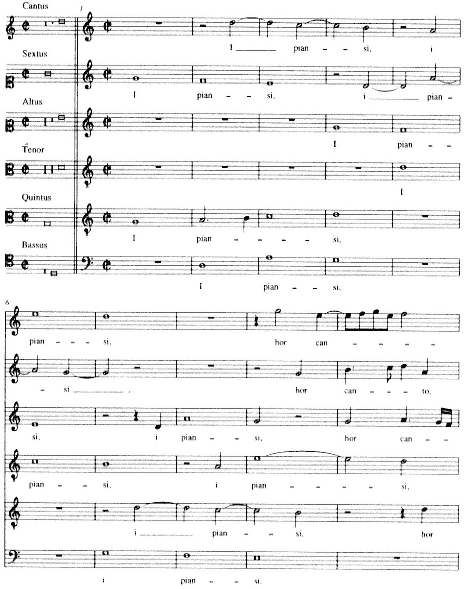
Ex. 46A.
Willaert, I piansi, hor canto, che 'l celeste lume (Petrarch, no. 230),
mm. 1-10; Musica nova (Venice, 1559), no. 16.
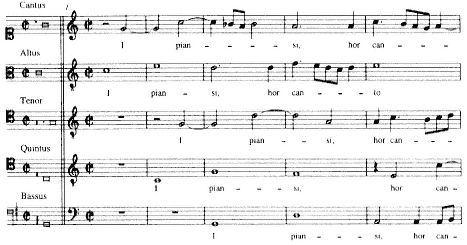
Ex. 46B.
Perissone, I piansi, hor canto che 'l celeste lume (Petrarch, no. 230),
mm. 1-5; Madrigali a 5 (Venice, 1545), no. 16.
In the face of these modifications toward more appealing — and no doubt more public — prototypes, we should not underestimate Perissone's participation in the musical practices of Petrarchism that his teacher epitomized. Two further passages from I piansi help make the point. First, Perissone's I piansi follows Willaert's model in drawing the exposition of v. 5, "Onde suol trar di lagrime tal fiume" (Thus he [Love] is wont to draw from me such a river of tears), over eleven breves. Also, like Willaert, he introduced plaintive B-flat's at "lagrime" and later "pianger" (v. 10) to produce minor seconds and thirds — a gesture that had by then become conventional. Second, at the beginning of the final tercet, "Non lauro o palma, ma tranquilla oliva / Pietà mi manda" (Pity sends me not a laurel or a palm, but the tranquil olive), Perissone emulated Willaert's slowing of the composite rhythm to the semibreve. This type of surface deceleration almost always marks moments of key rhetorical importance in Willaert's writing — a point of symbolic significance, a shift of grammatical person or tense, or an important twist in meaning — especially in articulating structural divides. In the Petrarchan lexicon the words signify the crucial mirror relationship laurel-Laura, of course. Like Willaert, Perissone applied the device a second time at the image of pity drying the poet's tears, "E 'l pianto asciuga" (v. 14),[44] a brief reminder of the opening and one that helps bring the poem full circle.
Perissone's second book a 5 (and his last book of madrigals) continued to extend directions taken up in the Madrigali a 5. Published by Antonio Gardane in 1550, it
[44] In Willaert, mm. 116-18, and Perissone, mm. 111-12.
was given the title Il segondo libro di madregali a cinque voci con tre dialoghi a otto voci & uno a sette voci novamente da lui composti & dati in luce and affixed with a brief dedication to Domenego Roncalli.[45]
To the noble and gentle young man, Mr. Domenego Roncalli, my most eminent lord.
If your lordship will consider well your valor and kindness, you will surely believe without further ado that I have remained such a servant to you from the first day that I came to know you here in Venice; for an ardent desire was born in me to serve and honor you always. I dedicate to you, then, with all my powers, these madrigals of mine, which you might deign to accept not as a gift matched to your worth, but rather as a little sign of the great affection of my reverence, and I kiss your hands with all humility. From Venice on the 3rd of May. Loving servant, Pierisson Cambio.[46]
Domenego Roncalli is not a name that otherwise appears in connection with Venetian music. He may be the same as Giovanni Domenico Roncalli, descendant of a noble Bergamese family that was added in 1545 to the Consiglio Communale of Rovigo, a Venetian outpost. According to his recent biographer, this Roncalli spent a good deal of time at both Padua, where he had a house, and Venice, where in 1554 the doge Francesco Venier made him a cavalier of San Marco.[47] Intriguingly, he gained notoriety in the Veneto by founding an academy in Rovigo in 1553, the Accademia degli Addormentati (later condemned for Calvinist heresies) that was styled after the cultural academies of Venice but with a public aspect that prefigures Badoer's Accademia Veneziana.
Whether this Roncalli is the same as Perissone's dedicatee and what relation he might bear to the print unfortunately remain mysteries. It would be gratifying to connect the two, not least because the Segondo libro counts as yet another Venetian print to attempt some kind of modal ordering, though the least straightforwardly of Perissone's three madrigal books (see Table 11). Like Parabosco's collection, its works are arranged in modal groups without obvious distinctions of ambitus, but unlike Parabosco's they are given in the usual ascending order, protus, deuterus,
[45] There is no mod. ed. of the book at present.
[46] Al Nobile & Gentile Giovane Il Signor Domenego Roncalli Signor mio Osservandissimo.
Se vostra signoria considerera bene il Valore & la gentilezza sua, ella senza piu credera bene ch'io le ristassi tanto servitore il primo giorno che qui in Vinegia la conobbi, che in me sia nasciuto ardente desiderio di sempre servirla, & honorarla. io le dedico adunque insieme con tutto il poter mio questi miei Madrigali: i quali ella si degnera d'acettare, non per presente conveniente al suo Valore: ma si bene per picciolo segno del grandissimo affetto della mia riverenza & a V.S. con ogni humilta bascio le mani. Di Vinegia alli 3 di Maggio. Amorevole Servitore Pierisson Cambio.
[47] See Stefania Malavasi, "Giovanni Domenico Roncalli e l'Accademia degli Addormentati di Rovigo," Archivio veneto, 5th ser., 95 (1972): 47-58, and Gino Benzoni, "Aspetti della cultura urbana nella società veneta del' 5-600: le accademie," Archivio veneto 108 (1977): 114-15. My information relies on Malavasi, to which I can add only that a Giocan da Roncali fu Giovanni Domenico da Rovigo, apparently Roncalli's son, made his will in Venice on 25 May 1596 (I-Vas, Archivio Notarile, Testamenti, Atti Beni, b. 160, fol. 239).
| ||||||||||||||||||||||||||||||||||||||||||||||||||||||||||||||||||||||||||||||||||||
(table continued on next page)
(table continued from previous page)
| ||||||||||||||||||||||||||||||||||||||||||||||||||||||||||||||||||||||||||||||||||||
tritus, and tetrardus, until the four dialogues at the end (nos. 20-23). Only the tritus-mode madrigals appear to distinguish unambiguously between authentics and plagals,








Ambiguities like these confirm that the book's "modal" arrangement was made ex post facto, either by Perissone, who had made or collaborated on the modal ordering of his first five-voice book, or by Gardane in collaboration with Perissone. If I am right that modal ordering and sonnet setting were companion projects among Venetians, then the book's poetic contents show a commitment to sonnet setting about equal to its commitment to modal thinking (both of which were less than Perissone's had been in putting together his Rore-like First Book). Ten of the Segondo libro's poems are Petrarch's, nine of them sonnets (three dialogues), and one a madrigal.[50] The book also contains two sonnets by Bembo and one possibly by Ariosto — poets represented by one poem each in Perissone's earlier two books. The only other poets identifiable at present are Luigi Cassola, author of the madrigal Alma gentil, s'in voi pietà fu mai, and Panfilo Sasso, the late-fifteenth-century Petrarchan poet whose dialogue "Quando nascesti, Amor? Quando la terra" was also included in Willaert's Musica nova. Eight poems remain anonymous.
In all, the Segondo libro contains a record seven settings of texts in the Musica nova.[51]
[48] "Tonal Types and Modal Categories," pp. 451-52.
[50] One of these, the sonnet Amor m'ha posto come segn'al strale, had already been published in 1548 in Scotto's edition of Rore's Terzo libro a 5, RISM 15489.
[51] One other poem was previously set by Willaert, the anonymous Amor, da che tu voi (see Chap. 7 n. 40).
1. I vid' in terra angelici costumi
2. In qual parte del ciel, in qual idea
3. Gionto m'ha Amor fra bell'e crude braccia
4. "Occhi piangete, accompagnate' il core"
5. "Liete e pensose, accompagnat'e sole"
6. "Che fai, alma? Che pensi? Havren mai pace?"
7. "Quando nascesti, Amor? Quando la terra"
Helga Meier noted borrowings from Willaert's settings in five of these madrigals (as well as connections between Perissone's five-voice setting of the anonymous Amor, da che tu voi pur ch'io m'arischi and Willaert's four-voice Amor, Fortuna, et la mia mente schiva ).[52] The Musica nova 's four dialogue sonnets make up four of the seven. They furnish yet another sign of how early the Musica nova had taken shape as a collection and represent through Perissone's placement of them at the end of his book a novel attempt to imitate something of the outer form of Willaert's collection.[53]
As in the Madrigali a 5, Perissone's Second Book's imitations showed a refined melodic flair and general brightening that resists Willaert's sternness. To cite a single example, he replaced the dark



Nonetheless, Perissone's In qual parte del ciel offers a kind of ideal exemplar of emulation practice. Helga Meier pointed out two unambiguous references to Willaert's original: the circle of fifths imitating Willaert's characteristic opening of the seconda parte and its accompanying motivic-contrapuntal structure (Exx. 49a and 49b); and Willaert's soggetto for v. 4, "Mostrar qua giù quanto lassù potea"
[52] The five related settings cited by Meier are: I vidi in terra, In qual parte del ciel, "Liete e pensose," "Che fai, alma?," and "Quando nascesti, Amor?" ("Zur Chronologie der Musica Nova, " p. 76).
[53] At least two other collections made a less sweeping attempt to do this: Donato's Primo libro d'i madregali a 5 & a 6 of 1553 (discussed below) and the Paduan Francesco Portinaro's Primo libro de madrigali a cinque voci of 1550, with five six-voice settings and a seven-voice setting of "Liete e pensose" at the end.
[54] Cf. the triple meter that starts the seconda parte of no. 11. For Qual dolcezza giamai see Willaert, Opera omnia 14:65-70, esp. mm. 64-69.
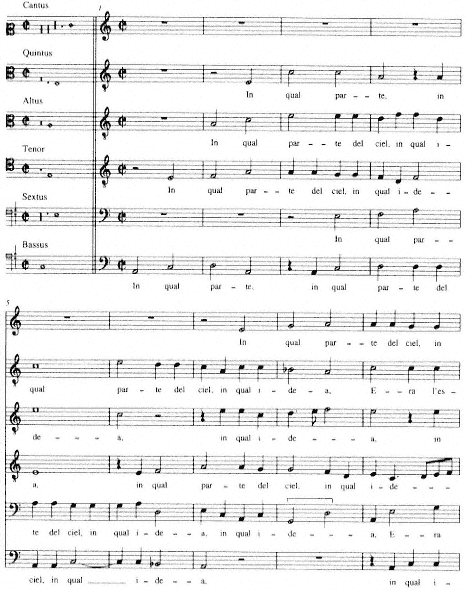
Ex. 47A.
Willaert, In qual parte del ciel, in qual idea (Petrarch, no. 159),
mm. 1-13; Musica nova (Venice, 1559), no. 18.
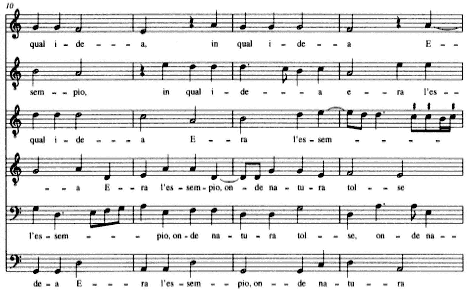
Ex. 47B.
Perissone, In qual parte del ciel, in qual idea (Petrarch, no. 159),
mm. 1-13; Segondo libro a 5 (Venice, 1550), no. 14.
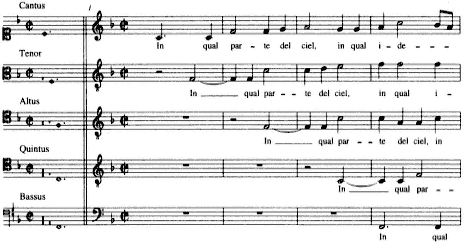
(table continued on next page)
(table continued from previous page)
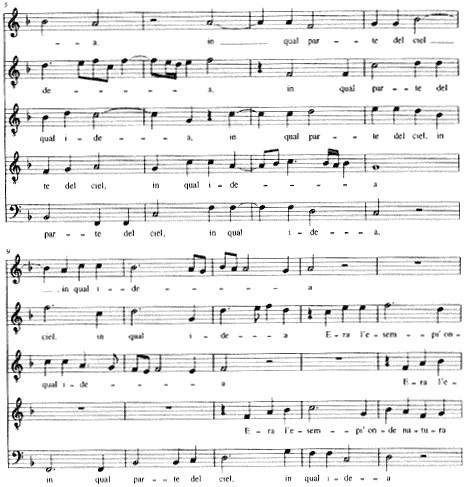
Ex. 47B
(continued)
(compare the altus of each in Exx. 50a and 50b). In fact Perissone adopted Willaert's declamatory gestures even more extensively than this, borrowing the rhythm of Willaert's homorhythmic altus-tenor duet at v. 3 and taking over the four-note figure for "Chiome d'oro" of v. 6. Even so, he continued to avoid the obscuring intricacies of a pervasively varied motivic structure. In both of the cases just cited he turned Willaert's soggetti into unvaried rhythmic figures (or nearly so); Willaert's setting continually alters the rhythms applied to v. 3 by shifting stressed syllables between tonic and agogic accents and also adds small melismas, while Perissone's
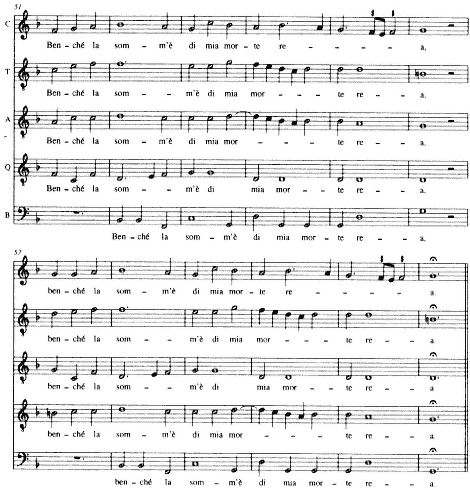
Ex. 48.
Perissone, In qual parte del ciel, in qual idea (Petrarch, no. 159),
mm. 51-62; Segondo libro a 5 (Venice, 1550), no. 14.
retains the same rhythmic morphology for each entry (Exx. 51a and 51b). Likewise, Willaert made "Chiome d'oro" rhythmically fluid and metrically elusive: four of the six voices start with the syncopated figure and two others on the tactus, nearly transforming the motive into anonymity. Here again Perissone repeated Willaert's rhythm exactly at each of the five entrances — yet never with the precise rhetorical incentive Willaert seems to have had in those rare instances when he avoided motivic variation (see Ex. 15 and Chap. 7 n. 47).
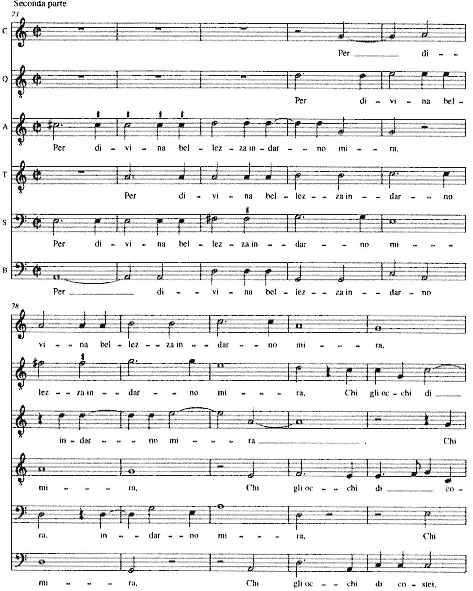
Ex. 49A.
Willaert, In qual parte del ciel, in qual idea (Petrarch, no. 159),
mm. 73-82; Musica nova (Venice, 1559), no. 18.
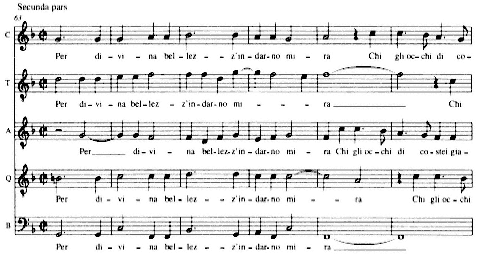
Ex. 49B.
Perissone, In qual parte del ciel, in qual idea (Petrarch, no. 159),
mm. 63-68; Segondo libro a 5 (Venice, 1550), no. 14.

Ex. 50A.
Willaert, In qual parte del ciel, in qual idea (Petrarch, no. 159),
altus, mm. 25-28; Musica nova (Venice, 1559), no. 18.

Ex. 50B.
Perissone, In qual parte del ciel, in qual idea (Petrarch, no. 159),
altus, mm. 29-33; Segondo libro a 5 (Venice, 1550), no. 14.
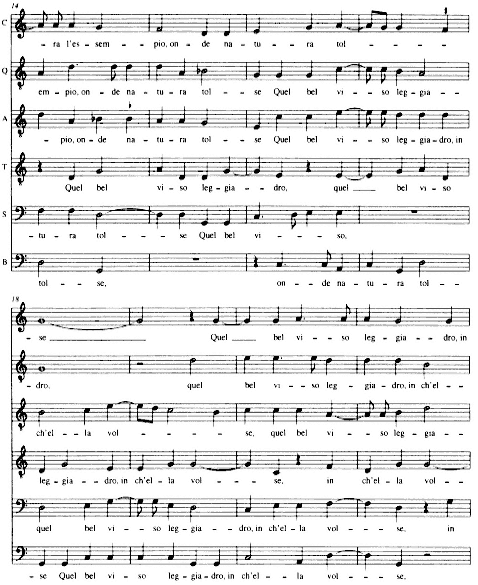
Ex. 51A.
Willaert, In qual parte del ciel, in qual idea (Petrarch, no. 159),
mm. 14-21; Musica nova (Venice, 1559), no. 18.
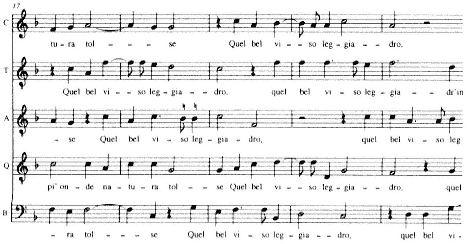
Ex. 51B.
Perissone, In qual parte del ciel, in qual idea (Petrarch, no. 159),
mm. 17-21; Segondo libro a 5 (Venice, 1550), no. 14.
Perissone Cambio: Madrigals for Four Voices
In 1547 Perissone published with Gardane his Primo libro di madrigali a quatro voci — as it turned out, the only four-voice madrigal book to be issued by any of Willaert's immediate students.[55] Like Perissone's other books, the Primo libro a 4 is arranged in ascending modal order — at least through no. 22, the end of the consecutive block of madrigals that are Perissone's own (see Table 12). The modal ordering extends to distinctions between authentics and plagals (unlike the Segondo libro a 5 ), albeit with a few anomalies.[56] Nothing else unites the book, however, and otherwise it is Perissone's most diverse, merging in a single collection the widely disparate generic traditions that attached to madrigals for four voices, on the one hand — chansonesque madrigals à la Verdelot and Arcadelt, madrigals for theater, madrigals a note nere, madrigals related to frottole, and songs in the oral tradition — and the
[55] I except the four-voice book of madrigals published by Nicola Vicentino of Vicenza (in the Veneto) in 1546 because it bears so little relation to the style that Willaert's Venetian circle was pursuing at the time; see Del unico Adrain Willaerth discipulo don Nicola Vicentino madrigali a cinque voci per theorica et pratica da lui composti al nuovo modo dal celeberrimo suo maestro ritrovato. Libro primo (Venice, 1546); mod. ed. Nicola Vicentino, Opera omnia, ed. Henry W. Kaufmann, Corpus mensurabilis musicae, no. 26, AIM ([Rome], 1963), pp. 1-60.
| ||||||||||||||||||||||||||||||||||||||||||||||||||||||||||||||||||||||||||||||||||||||||||
(table continued on next page)
(table continued from previous page)
| ||||||||||||||||||||||||||||||||||||||||||||||||||||||||||||||||||||||||||||||||||||||||||||||||
generally more monolithic, learned traditions of five- and six-voice madrigals, especially of sonnet settings, on the other.
Perissone's book included sonnets, ballate, cinquecento madrigals, and ottave rime. Not all of these had lately been linked to four -voice settings and certainly not mixed in a single volume. Of the twenty-six numbers, the largest share (predictably) are settings of cinquecento madrigals, eleven of them by Perissone (nos. 1, 2, 6, 8, 10, 15, 16, 18, 20, 22, and 26) and three by Cipriano de Rore (nos. 23, 24, and 25).[57] Rore's contributions include the first publication of his setting of Alfonso d'Avalos's Anchor che col partire, one of the most often reprinted and imitated secular settings of the century. Einstein may have overstated the case in calling it the model for the whole collection,[58] but it has suggestive stylistic parallels with Perissone's many madrigal settings in the book.
Sonnet settings, by comparison, total only five — all Petrarch's and all complete (nos. 3, 12, 14, 17, and 21). This makes Perissone's emphasis on madrigals over sonnets an apparent emphasis of Rore's four-voice model over the four-voice madrigals in the Musica nova . Yet it is Perissone's sonnet settings that are newest and that introduce the single most significant dichotomy in the collection. Perissone was the only one of Willaert's disciples to write four-voice settings of Petrarch's sonnets in a style close to the Musica nova. Four of them in fact set Musica nova texts: Io amai sempre & amo fort'ancora (the only one also for four voices in Willaert's setting), In qual parte del ciel, Più volte già dal bel sembiant'humano, and Pien d'un vago pensier. We might add to the book's weightier sonnet side its two ballata settings, no. 11, Come potrò fidarmi, Brevio's Cantai mentre ch'i arsi (earlier published in settings by Rore and Parabosco), as well as the anonymous Amor, da che tu voi (no. 22), set in two parts (like Willaert's setting of 154-8 and Perissone's of 1550).
None of the poems I have placed in this group is shorter than twelve lines long. By contrast, only one of the madrigal texts (apart from no. 22) is longer than nine lines (no. 8), including Rore's. These tiny poems generally concentrate on a single, concisely developed conceit. The slight literary status they claimed in musical prints may have been nil outside of music: except for those by Cassola (no. 15) and d'Avalos, all the madrigal texts are as yet anonymous.
To complete this sketch of the book's contents, the four remaining numbers are ottave rime. One of them is Bembo's (no. 5), another a stanza from Ariosto's Orlando furioso, 24.1 (no. 7), and the other two (nos. 4 and 19) again anonymous. Ottave rime are among the least common forms to appear in contemporary Venetian collections. With their lucid songlike textures and avoidance of contrapuntal artifice, they fall more on the madrigalian than the sonnet side of Venetian production. Their form — endecasillabi rhyming ABABABCC — was a long-standing
[57] Perissone's setting of the first seven lines from Petrarch's canzone Perchè la vit'è breve (no. 9) might just as well be added to this group, as it functions similarly to the madrigals, extracting the piedi and the first line of the sirima from the opening stanza.
[58] The Italian Madrigal 1:441.
vehicle of poet-improvisors in the oral tradition, the structural prototype shared by epic poetry and the lyric strambotto, as well as occasional stanzas. Thus their presence in the Primo libro a 4 may signal yet again the enduring connection between settings of ottave rime and traditions of improvisatory song.[59]
This brings us to the dedication attached to the collection, made to the renowned Paduan poet Gaspara Stampa who was famed for her singing to the lute.
To the lovely and talented Signora Gasparina Stampa
Noble lady, well might I be reproved by the wise and learned composers of this sweet and admirable science — reproved in this science, yes, but no man in the world will ever be able to say that I have had little judgment in dedicating these notes of mine to your ladyship, however they may be. Because it is well known by now — and not only in this fortunate city, but almost everywhere — that no woman in the world loves music as much as you do, nor possesses it to such a rare degree. And thousands upon thousands of fine and noble spirits attest to this who, having heard your sweet harmonies, have given you the name of divine siren, remaining over time your most devoted servants, among whom I am as devoted as any. I come with this my little token and gift to refresh the memory of the love that I bear for your talent, begging that you deign to find me worthy to be placed where you place the innumerable throngs of those who adore and love your rare talents and beauties. And to your graces I commend and offer myself. Most devoted servant Pieresson Cambio.[60]
In Chapter 4, I suggested that a connection might exist between the kind of solo and at least quasi-improvisatory singing for which Stampa was acclaimed and the treble-dominated writing and periodic phraseology that pervades much of Perissone's four-voice book. Even though his published settings were suited to part singing, it is reasonable to imagine alternatively that at least some of them could have been adapted for solo singing to lute accompaniment or simply been performed by a solo treble singer to the accompaniment of viols or broken consort on the lower parts. Perissone's plea to be placed among Stampa's adoring throngs
[59] On this matter and in connection with the discussion that follows see Chap.4 nn. 68-80 above, esp. the literature cited in n. 75. See also James Haar, "Arie per cantar stanze ariotesche," in L'Ariosto: la musica, i musicisti, ed. Maria Antonella Balsano (Florence, 1981), pp. 31-46, and idem, Essays on Italian Poetry and Music in the Renaissance, 1350-1600 (Berkeley and Los Angeles, 1986), pp. 92-99.
[60] Alla bella et virtuosa Signora Gasparina Stampa
Valorosa signora, io potrò ben esser ripreso apresso ai saggi, & dotti compositori di questa dolce et mirabile scienza: in essa scienza ma no mi potra gia huomo del mondo dire giamai ch'io habbia havuto poco giuditio nel dedicare queste mie note, quale elle siano, alla S.V. perche si sa bene homai. & non pure in questa felice citta: ma quasi in ogni parte, niuna donna al mondo amar piu la Musica di quello che fate voi, ne altra piu raramente possederla, & di questo ne fanno fede i mille, & mille spirti gentili, & nobili: i quali udito havendo i dolci concenti vostri, v'hanno dato nome di divino sirena, restandovi per tempo devotissimi servi, fra i quali, io devoto quanto altro, vengo con questo mio picciolo segno & presente, a rinfrescarle nella memoria, lo amore ch'io porto alle sue virtu, pregandola che si degni, ch'io sia degno di esser posto dove ella pone la innumerabil turba di quei ch'adorano, & amano le sue rare virtu, & bellezze. & alla sua bona gratia mi raccomando & offero. Devotissimo servo Pieresson Cambio.
might be glossed as a hope that his songs will grace her repertory. It might also have been a way of insinuating himself as fellow singer in the elect circles of literary academists with which Stampa surrounded herself in various private homes, including her own. To say so is to suggest that a four-voice book of the 1540s might still have functioned at times as a sort of fakebook — as books of frottole had done — providing raw material to be freely adapted according to variable needs. One of its specific functions may have been that of a solo songbook (also like books of frottole), thus continuing the alliance of early madrigals with solo song made so patent by Willaert's intabulations of Verdelot's madrigals a decade earlier.[61]
Vestiges of recitational practice from unwritten traditions are embedded in Perissone's setting of Ariosto's stanza Chi mett'il pie su l'amorosa pania from Orlando furioso, the central textual repository for sixteenth-century improvvisatori (Ex. 52).
Chi mett'il pie su l'amorosa pania May he who puts his foot in the loving birdlime
Cerchi ritrarlo e non inveschi l'ale, Try to extract it and not catch his wing [in it],
Che non è in somm'Amor se non l'insania For in the end Love is nothing but madness
A giuditio de savi universale; In the universal opinion of wise men;
E se ben egualment'ogn'huom non smania, And if everyone does not go raving about equally,
Suo furor mostrar'a qualch'altro segnale; Its furor shows itself through other signs;
E qual è di pazzia segno pi& espresso And what is a more telling sign of madness
Che per altri voler perder se stesso? Than to lose your own self by desiring another?
Each of the stanza's eight lines is fitted to a distinct musical strain. None but the last receives a full repeat, and only the most minimal textual repetition occurs otherwise. Simultaneous declamation simulating accompanied solo singing plays a prominent role here, as it does in the other ottava settings, all but one of which begin in homorhythm. Homorhythm also helps articulate the couplets that organize the octave at the highest level: while cadences at line endings reinforce the sense of organization by melodic strains, the junctures between couplets are reinforced texturally by four-voice homophony (if only up to the cadence — compare mm. 8 and 14 with m. 18). At another level of formal articulation, Perissone's setting reproduces musically the effect of various textual rhymes by giving them similar cadences, like the ones ending vv. 3 and 5, "sania" / "smania" (mm. 10 and 16). Meanwhile, as in other ottava settings, the bass line moves much more harmonically than in Perissone's settings of other sorts of verse. This is not to underestimate Perissone's use of contrapuntal artifice or his exploitation of counterpoint to achieve cadences of varying weights: weakening the cadence of v. 1 (m. 3) by delaying the diminished suspension in the cantus, evading the cadences in mm. 13 and 14 for v. 4, or overlapping seams between vv. 7 and 8 (mm. 21-22). It is rather to point
[61] Intavolatura de li madrigali di Verdelotto da cantare et sonare nel lauto, intavolati per Messer Adriano (Venice, 1536); Renaissance Music Prints, vol. 3, ed. Bernard Thomas (London, 1980); facs. ed. Archivum Musicum, Collana di testi rari, no. 36 (Florence, 1980).
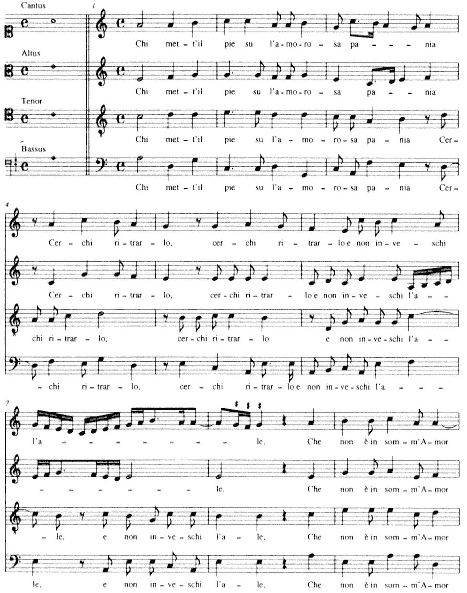
Ex. 52.
Perissone, Chi mett'il pie su l'amorosa pania (Ariosto), incl.;
Primo libro a 4 (Venice, 1547), no. 7.
(continued on next page)
(continued from previous page)
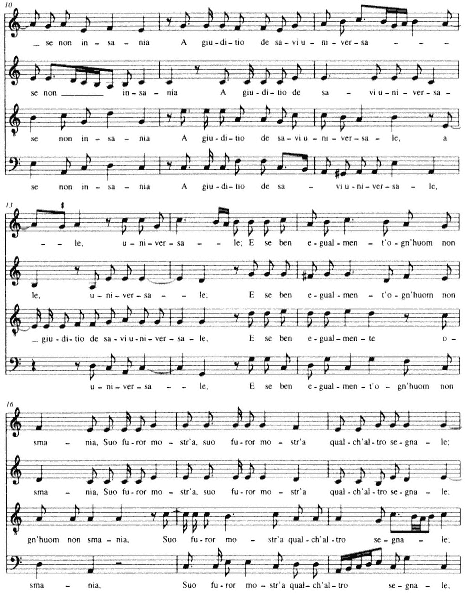
Ex. 52
(continued)
(continued on next page)
(continued from previous page)
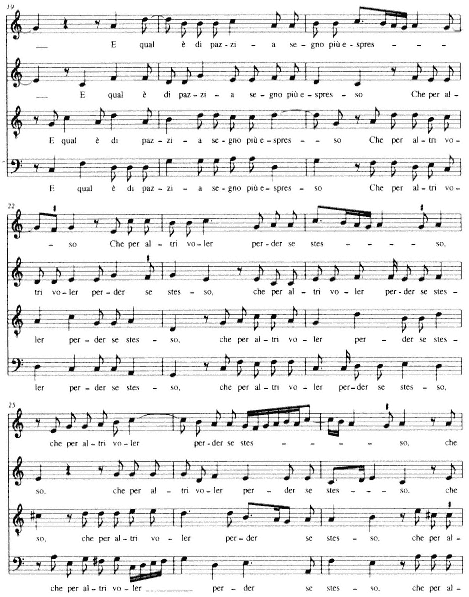
Ex. 52
(continued)
(continued on next page)
(continued from previous page)
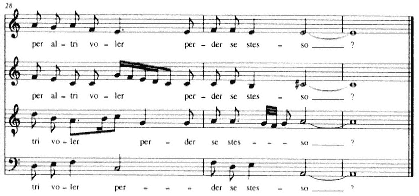
Ex. 52
(continued)
up the fortuitous merging of written contrapuntal with oral soloistic procedures that Perissone effects in settings like this.
Perissone's four-voice settings of madrigals avoid the signs of oral recitation that mark his ottava settings, though without aiming for a higher literary tone. Madrigals elicit more extensive text repetition and far more radical displacements of poetic lines between contrapuntal parts. (In no. 10, for example, the tenor is nearly three measures and fully one poetic line ahead of all three other voices by the end of m. 6.) Instead of playing a continuously harmonic role, bass lines in madrigal settings are inclined to alternate between two roles, that of harmonic support and that of equal participant in the imitative processes governing the whole texture.
Many of the madrigal texts are addressed directly to women in the form of serenades: Vaga tranquilla e lieta (no. 2, to a "Marina"), Duo più potenti lumi (no. 6), and Chiara luce serena (no. 8). Moving away from the sectionalizing strategy of the frot-tola, Perissone's settings give a continuous musical development to their amorous conceits, which invariably crest in a witty point at the end, rather than "[touching on] the principal motif . . . in the first line" or an opening ripresa, as happens in barzellette.[62] According to Parabosco (as he has Speroni declare in I diporti ), both madrigals and strambotti resemble epigrams in sharing this sort of development.[63] Whereas Perissone's ottava settings reproduce the segmented techniques of solo recitation and rely on rhythmic energy for momentum, his madrigal settings mirror their poems' rhetorical trajectory by piling up voices, displaced in imitation, into a contrapuntal crescendo.
[62] The quote is from Einstein, The Italian Madrigal 1:185.
[63] "Above all else," he writes, "the madrigal and strambotto must have a lovely wit and invention, just like an epigram" (sopra ogni altra cosa, il madrigale e lo strambotto vuole andare vago d'arguzia e di invenzione, sì come apunto vuole apparire il motto); I diporti (Venice, [ca. 1550]; repr. in Novellieri minori del cinquecento: G. Parabosco — S. Erizzo, ed. Giuseppe Gigli and Fausto Nicolini [Bari, 1912]), p. 177; a longer excerpt, which includes this passage, is quoted and trans. in Einstein, The Italian Madrigal 1:184-85.
Both approaches could draw on aspects of madrigalistic repertories from the 1530s, though in different ways. By contrast, Perissone's sonnet settings a 4 tend toward denser polyphony and more learned diction (if less so than his sonnets set a 5 ). While indebted to Willaert's settings, his sonnets a 4 are less solemn and ample than Willaert's or Rore's settings a 5 or 6 . Perissone's four-voice In qual parte del ciel, for instance, falls short of Willaert's for six voices by twenty-two breves. The prima parte of Willaert's six-voice Pien d'un vago pensier alone is longer than the whole of Perissone's four-voice setting of it (73 and 72 breves, respectively; Willaert's setting lasts 128 breves altogether).[64] Discrepancies like these are to be expected, given that contrapuntal complexities normally increase geometrically as voices are added. But differences also arise because Perissone tended to make his four-voice sonnet settings lighter, more condensed, and simpler in construction, with voices more frequently arranged in homophony or closely interwoven, and with somewhat less radically evaded cadences than Willaert did.[65]
Perissone's setting of the sonnet Più volte già (no. 14) embodies many of these differences. Like In qual parte del ciel and Pien d'un vago pensier, the setting is much shorter than Willaert's, with each line normally stated once, or at most repeated only partially. Whereas Willaert's exposition of Più volte già opened the a - and o - laden first verse in a languorous, irregular point of imitation, Perissone's opening ascends in chansonlike dactyllic tetrachords located in a regularized, efficient exposition (Exx. 53a and 53b). Willaert ambles through six breves before accelerating into a minim pace; Perissone establishes the minim as the basic declamatory pulse in the first measure. Perissone returned to this laconic style for the polysyndetonic vv. 6 and 7: (Exx. 54a and 54b): "Per ch'ogni mia fortuna, ogni mia sorte, / Mio ben, mio male, et mia vita et mia morte" (for all my fortune, all my destiny, my good, my ill,
[64] Overall the four-voice settings in the Musica nova average about the same length as those for more voices and are about half again as long as the four-voice sonnet settings of Perissone.
[65] On works in the Primo libro a 4 that are modeled on settings in the Musica nova — In qual parte del ciel and Amor, da che tu voi — see Helga Meier, "Zur Chronologie der Musica Nova ," pp. 84-87, and the preface to idem, ed., Fünf Madrigale, pp. iii-iv. The latter, she notes, is unique for borrowing its exposition (like Perissone's five-voice setting of the same poem, published in 1550) not from a setting by Willaert of the same text but rather from one that merely begins with the same word, Amor, fortuna, et la mia mente. Perissone's habit of modeling took a unique form in his four-voice setting of In qual parte del ciel, which borrowed extensively only after the exposition. Meier cites two of these borrowings, one in the motive at v. 3, "Quel bel viso leggiadro" (mm. 18-20; cf. Willaert, mm. 18-21), and the other in the latter half of v. 5, "in selva mai qual dea" (mm. 33-35; cf. Willaert, mm. 36-47). In addition to emphasizing a C tonality, other correspondences may be cited as follows: Perissone's adoption of various aspects of Willaert's interpretation of v. 6, "Chiome d'oro sì fino a l'aura sciolse?" (Perissone, mm. 35-40; Willaert, mm. 45-52); the polymetric combination of tonic and agogic accents on the initial syllable "Chio-" of "Chiome d'oro"; and motivic similarities throughout the respective settings of vv. 12 and 13. The opening of the seconda parte, while not taken over as precisely in Perissone's version a 4 as in that a 5 , nonetheless borrows both the rhythm and general melodic direction of Willaert's original. Willaert's five opening sonorities — A-D-G-C-a — are also all present. Though Perissone reverses the order of the first two, he was apparently reconciling a harmonic imitation of Willaert's setting with the exigencies of his counterpoint, transposing A and D to permit a smooth transition from the prima parte and retain Willaert's colorful C-sharp on "divina" in the uppermost voice. This allowed him to adopt much of the sonority of Willaert's passage despite using a different mode. On the whole Perissone's setting is more tuneful and melodically more far-ranging than its model. In the exposition, for instance, where Willaert's opening is plain, full of repeated notes in small ambituses and devoid of rhythmic surprise, Perissone's lines sweep quickly over large areas of pitch space.
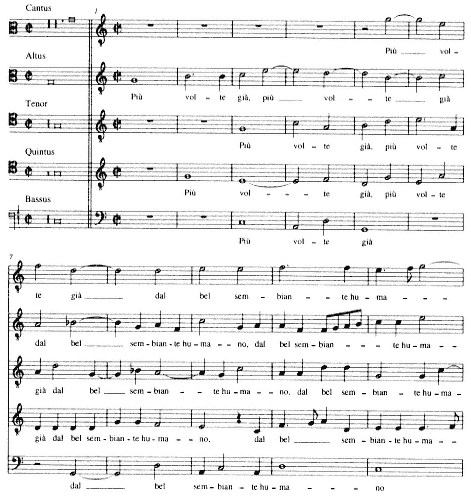
Ex. 53A.
Willaert, Più volte già, dal bel sembiante humano (Petrarch, no. 170),
mm. 1-11; Musica nova (Venice, 1559), no. 6.
my life, and my death). Where Willaert had assigned a separate gesture to each rhetorical parcel, casting "mio ben/mio male" into a kind of dialogue (altus-tenorquintus-bassus, mm. 47-49, answered by cantus-altus-tenor-quintus, mm. 49-51) and drawing out "e mia vita, e mia morte" in a madrigalistic rendering, Perissone set the same clause more plainly (mm. 38-41), phrasing the entire chain of possessives, save "mia fortuna," in a single, quasi-continuous gesture (mm. 31-41). Only the final verse broadens out through a series of textual repetitions marked by perfect cadences (mm. 76 and 84, as traditionally happens toward the end of a madrigal), and finally syncopated embellishment in the tenor.
It thus seems clear that Perissone's less expansive approach to sonnets reflects a continued tendency to view the four-voice madrigal as a qualitatively different
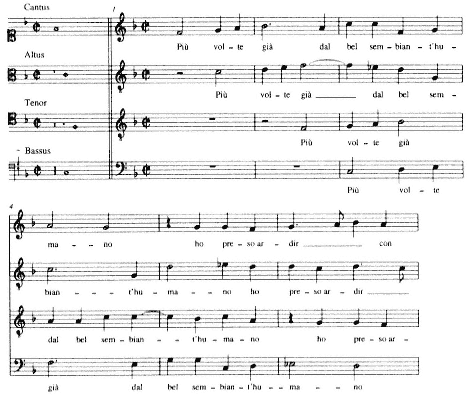
Ex. 53B.
Perissone, Più volte già dal bel sembiant'humano (Petrarch, no. 170),
mm. 1-6; Primo libro a 4 (Venice, 1547), no. 14.
genre from madrigals for five or six voices or those for seven or eight. Yet his Più volte già also conforms to many other instances in which Willaert's disciples hesitated to embrace completely the restrictive seriousness that Willaert brought to Musica nova madrigals.
Although Perissone's career as chapel singer and freelancer continued to flourish in the 1550s,[66] no further collections devoted to his music have come down to us after that of 1550. A few of his works were anthologized up until 1576, but sometime during the 1560s Perissone passed away.[67] His death was mourned in Petrarchan tropes exchanged by two Venetian academists, Domenico Venier and Girolamo Fenaruolo: "The sound
[66] See Jonathan Glixon, "A Musicians' Union in Sixteenth-Century Venice," JAMS 36 (1983): 409-10 n. 42, and Ongaro, "The Chapel of St. Mark's," pp. 140-41 and 145.
[67] See the mentions of his death in documents from the Scuola di San Marco and the Scuola di Santa Maria della Carità reported by Glixon, "A Musicians' Union," pp. 409-10 n. 42. He may have died earlier than the late sixties, as suggested by his absence from the lists of singers at St. Mark's from 1562; see Ongaro, "The Chapel of St. Mark's," p. 165 n. 194, and Document 272.
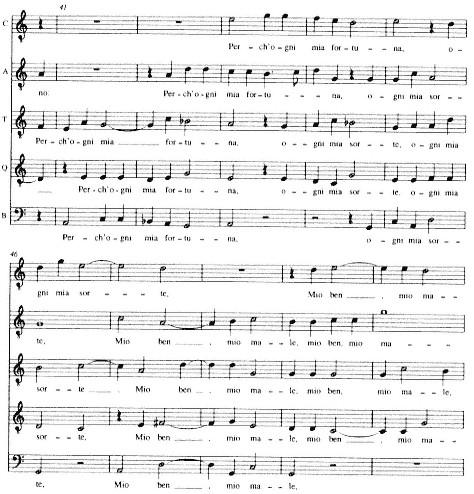
Ex. 54A.
Willaert, Più volte già dal bel sembiante humano (Petrarch, no. 170),
mm. 41-50; Musica nova (Venice, 1559), no. 6.
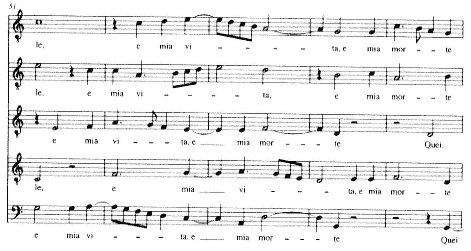
Ex. 54A
(continued)
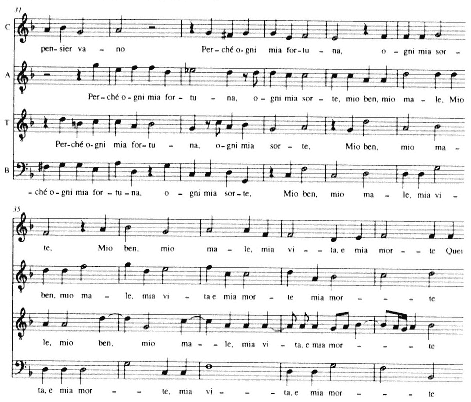
Ex. 54B.
Perissone, Più volte già dal bel sembiant'humano (Petrarch, no. 170),
mm. 31-41; Primo libro a 4 (Venice, 1547), no. 14.
of his sweet tones stopped / the waves in the sea, the wind in the air, / burned ice, moved mountains, and made serene the clouded sky."[68]
Baldassare Donato, Madrigals to 1553
We have already glimpsed Baldassare Donato several times in previous chapters — Donato the maturing choirboy who gained favor in the salons of Venice, was made right-hand man to Willaert, and informant to the Procuratori. Donato's beginnings are in some respects an inverse reflection of Perissone's. Whereas Perissone entered San Marco only in 1548 after several years of scrambling to publish and to perform under private aegises, Donato was already mounting the chapel hierarchy at a comfortable pace by 1545-46, in his mid- to late teens. Yet neither of the prints that unveiled the Venetian school in 1544 — Doni's au courant Dialogo della musica or Rore's Secondo libro — showed any sign of him. Donato's first published work appeared only with Scotto's edition of Rore's Terzo libro of 1548 when Donato was about eighteen to twenty-two years old — still young but hardly precocious by the standards of a Parabosco.[69] Unlike Perissone's compositional career, then, Donato's seems to have been hatched directly from his breeding in the chapel.
Donato's first published madrigal was a setting of Petrarch's sonnet S'una fed'amorosa, un cor non finto (no. 224) that showed him already adept in the diction and counterpoint reserved for sonnets.[70] Petrarch's poem, compounded of seven conditional clauses resolved only in the final verse, deploys a rhetorical strategy ready-made for the continuously woven polyphony and slight motivic variation developed by Willaert. The entire sonnet consists of a large paratactic chain, reinforced by anaphora and structured by linking together in additive series several of its ubiquitous "if" clauses. Since the verb of the main clause is postponed all the way until v. 13, the poem's essential form can be gleaned from the opening and closing lines (1-4 and 12-14):
S'una fed'amorosa, un cor non finto, If faithfulness in love, an undeceiving heart,
Un languir dolce, un desiar cortese, A sweet languishing, a courteous desire,
S'honeste voglie in gentil fuoc'accese, If virtuous longings kindled in a noble fire,
S'un lungh'error in cieco laberinto . . . , If a long wandering in a blind labyrinth . . . ,
. . . . . . . . . . . . . . . . . . . . . . . . . . . . . . . . . . . . . . . . . . . . . . .
S'arder da lunge et agghiacciar da presso, If to burn from afar and freeze close by
Son le cagion ch'amand'io mi distempre, Are the reasons that I untune myself with love,
Vostro, Donn', è'l peccato et mio fia il danno. Yours is the wrong, Lady, and mine may be the loss.
[68] The words are Venier's; see the Appendix to this chap.
[69] On Donato's age I follow Ongaro, "The Chapel of St. Mark's," who thinks he was probably on the younger side of the four-year span given.
[70] For a full transcription see my "Venice and the Madrigal in the Mid-Sixteenth Century," 2 vols. (Ph.D. diss., University of Pennsylvania, 1987), 2:656-67.
In setting this sonnet Donato appealed to the plainest possible motivic idiom, avoiding individual semantic emphasis in favor of a language that would play up the poem's local syntactic and rhetorical differentiations while still countering any pull toward articulation. The setting's dearth of syncopation or sustained progressions by fifth and its proliferation of two-note declamatory groups help check the possibility of any forceful approaches to cadence. The entire setting uses only one diminished cadence: it takes place at the end of the first couplet, but with textual and contrapuntal cadences displaced from one another (see mm. 14-16 in Ex. 55) and only the cantus's noncadential bb-flat sharing the text with the cadencing contratenor. The only other cadences in the first quatrain fall at the end of v. 4, both simple cadences, the first (mm. 26-27) emphasized with an f-sharp in the cantus, the second with an undiminished half cadence (mm. 31-32).
All of this contrasts greatly with Donato's madrigalian settings from his first solo collection of 1550, a medley of light madrigals for four voices and canzoni villanesche alla napolitana published as Le napolitane, et alcuni madrigali a quattro voci.[71]Le napolitane points up the loose affinity of villanesche with lighter four-voice madrigals, both of which profited from Donato's natural gifts for vivid, animated rhythms and sharply etched melodies. None of the madrigals in it are sonnet settings. Indeed the opening number, Vaghi pensier che così passo passo, setting the third stanza from Petrarch's canzone no. 70, serves as a reminder that single canzone stanzas — even Petrarch's — were thought of by composers in a way more akin to poetic madrigals than to weightier sonnets (as poets conceived them).
Vaghi pensier is a compact mix of endecasillabi and settenari. With its emblematic lament on the stony lady culminating in the famous incipit from Dante's Rime petrose, it must have made good capital with literary-minded book buyers. (The stanza had already been singled out for musical treatment by Parabosco four years earlier; see Table 9, no. 16.)
Vaghi pensier che così passo passo Yearning thoughts, which thus step by step
Scorto ma'havet'a ragionar tant'alto; Have led me to such high speech:
Vedete che madonna ha 'l cor di smalto You see that my lady has a heart of such hard
Sì forte ch'io per me dentro no 'l passo. Stone that I cannot by myself pass within it.
Ella non degna di mirar sì basso She does not deign to look so low 5
Che di nostre parole As to care about our words,
Curi, che 'l ciel non vuole, For the heavens do not wish it,
Al qual pur contrastand'io son già lasso; And resisting them I am already weary;
Onde come nel cor m'induro e 'naspro, Therefore as in my heart I become sad and bitter,
"Così nel mio parlar vogli'esser aspro." "So in my speech I wish to become harsh." 10
[71] The print also included villotte by Perissone. The last three numbers in it are Donato's settings of Venier's stanzas in praise of Venice (see Chap. 4 nn. 78-79).
Between publications of S'una fed'amorosa in 1548 and Le napolitane in 1550 Donato published a single ottava setting, O felice colui ch'al suo volere, in Scotto's Fantesie, et recerchari a tre voci, accomodate da cantare et sonare . . . con la giunta di alcuni altri Recerchari, et Madrigali a tre voci of 1549 (1549 ), a print that includes works by Willaert, Rore, and others. (Einstein's statement that this was the first appearance of Donato's music in print is of course incorrect; The Italian Madrigal 1:448.)
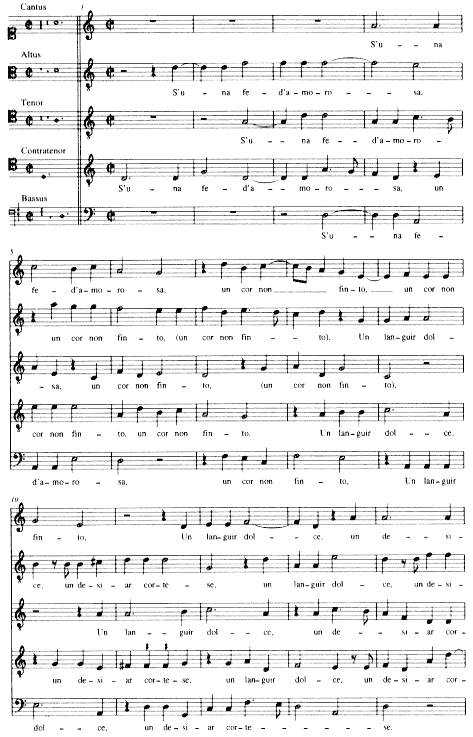
Ex. 55.
Donato, S'una fed'amorosa, un cor non finto (Petrarch, no. 224),
mm. 1-32; in Cipriano de Rore, Terzo libro a 5 (Venice, 1548) (RISM 15489 ), p. 13.
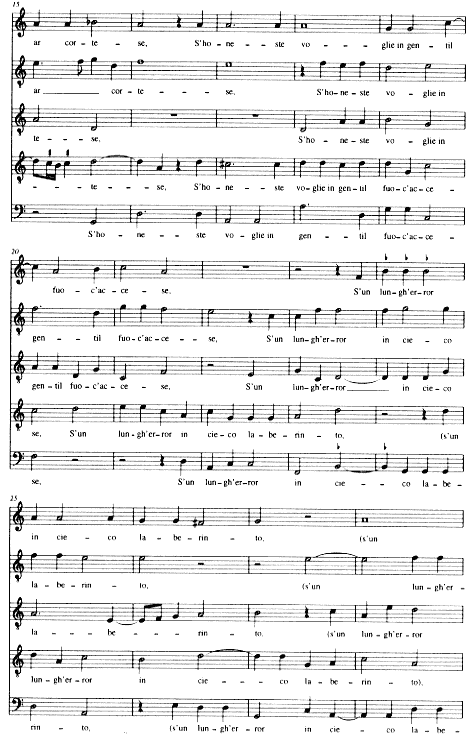
Ex. 55
(continued)
(continued on next page)
(continued from previous page)
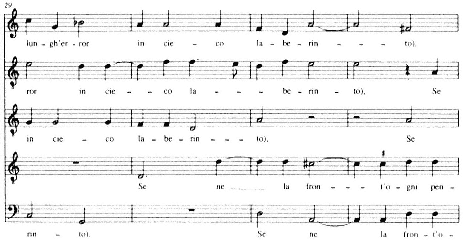
Ex. 55
(continued)
Donato's style here so much avoids the heavier manner of Willaert's and Perissone's sonnet settings that Einstein likened it to that of the young Palestrina.[72] Sealing off the four lines of piedi with a sectional break, Donato recognized the stanza's segmented character, as earlier madrigalists had done in setting canzoni and ballata-madrigals, and also (like them) built his setting out of crisp, short phrases and a metrically uniform imitative technique. Cadences like the ones in Ex. 56 assemble the voices in homorhythmic declamation (mm. 38, 43, and 48), or else they converge successively by pairs.
Donato's generally careful declamation helped project the stanza formally, rather than elaborating it rhetorically, but he also embellished the text in line with the lighter traditions that especially suited his natural gifts. Thus, for example, the end of v. 3 ignores declamatory demands altogether, applying a graceful decorative melisma in the manner of chansonesque madrigals. Following the lead of Rore's recent Vergine bella setting (and unlike Willaert's madrigals), voices do not always sing the complete stanza, but often drop out to reduce textures epigrammatically without reinstating omitted text. Donato lingers only for formal reasons, like the standard reiteration of the last line. This is one place, at Petrarch's deft elision into Dante's text, where a more arduous rhetoric might be expected, but Donato ventures nothing but a few consecutive six-three chords on "aspro" and a single four-three appoggiatura. If Donato's S'una fed'amorosa avoided semantic intensity in favor of sober recitation, Vaghi pensier avoids it to preserve an air of light lyricism.
[72] The Italian Madrigal 1:452. For a complete transcription see Feldman, "Venice and the Madrigal," 2:668-76.
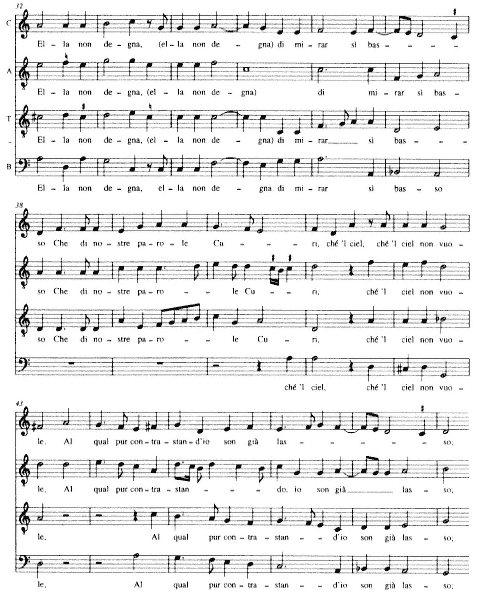
Ex. 56.
Donato, Vaghi pensier, che così passo passo (Petrarch, no. 70, stanza 3),
mm. 32-48; Le napolitane, et alcuni madrigali a 4 (Venice, 1550), p. 1.
Donato's first full-fledged print of madrigals was not issued until 1553, under the title Il primo libro d'i madregali a cinque & a sei voci, con tre dialoghi a sette.[73] The book bore a mysterious and intriguing dedication to one Cardinal of Sant'Angelo, whom Donato called his "sole benefactor."
To the most Illustrious and Reverend Monsignor, Cardinal of Sant'Angelo, my sole Lord and Benefactor. Baldassara Donato.
Most Illustrious and Reverend Monsignor, my most honorable patron: Two symbols used to be specially assigned by the ancients to the sun, the bow and the lyre — the bow because with the arrows of its rays it [both] strikes and gives life to everything; the lyre because, placed in the midst of all the other planets, almost as the norm and temperament of all the others, it guides the softest and the grandest celestial harmony. But we, owing to our disproportioned senses, fail to hear it. It is fitting that the moderns should give the same to Your Most Illustrious and Reverend Lordship, sun and ornament of this age — you who with the rays of your many virtues and with your splendor and that of your ancestors manifest and kindle everything and who with your lyre of internal reasoning and prudence so well harmonize the affects of your soul in the midst of the other princes that both in great fortunes past and in the glory of the present one could barely discern which was greater in you, grandeur or charm, happiness or humanity, forcefulness or mildness. Beyond this it will suit you when the time comes to you, taking the place of your most blessed forefathers, to temper amongst all the other princes the harmony of the Christian Republic. Owing to this renown, then, the dedications of works in all fields are due to the name of your Most Illustrious and Reverend Lordship. But those of music are most due to you. My having therefore collected some of my efforts in this science I consecrate them to you, as to their true and appropriate recipient, considering that the virtue of your sacred name must make the harmony of my labors sweeter and more welcome to whomever will hear them. Kissing your sacred hands with this, I pray for you a happiness equal to your merit.[74]
[73] A complete ed. may be found in Sixteenth-Century Madrigal, vol. 10, ed. Martha Feldman (New York, 1991).
[74] ALL'ILLUSTRISSIMO ET REVERENDISSIMO Monsignor, Il Cardinale di Santo Angelo, Signor & Benefattore unico. Baldassara Donato.
Illustrissimo & Reverendissimo Monsignore, Patrone Colendissimo. Due insegne si solevano da gli antichi spetialmente dar al sole l'arco et la cetra: L'arco perche con le saette de suo raggi ferisce & vivifica ogni cosa. La cetra perche posto in mezzo di tutti gli altri pianeti quasi norma et temperamento de gli altri guida la celeste armonia soavissima et grandissima. Ma da noi per la sproportion del nostro senso non udita: L'istesso conviene che moderni dieno a Vostro Illustrissima et Reverendissima .S. Sole & ornamento di questa età, Il quale co raggi di tante virtu vostre, & dello splendore Avito & proprio illustrate, & infiammate ogni cosa, & con la cetra dell'interna ragione & prudenza accordate in mezzo a gli altri Principi cosi bene gli affetti del vostro animo, che nella maggior fortuna passata et nella grande d'hora mal s'e possuto scorgere qual sia stata maggiore la grandezza, o la piacevolezza, la felicita, o l'humanita, l'amplitudine o la mansuetudine, Oltre che a voi converrà, quando per l'eta vi sarà concesso occupando il luogo del vostro Santissimo Avo temprare fra tutti gli altri Principi l'armonia della Christiana Republica: Per questo nome dunque le dedicationi de componimenti in ogni scientia sono dovute al nome di Vostra Illustrissima & Reverendissima .S. Ma quelle della Musica le sono dovutissime: Havendo io per tanto raccolte alcune mie fatiche in questa scienza le consacro a lei come ad obietto loro proprio et adequato: Considerando che la virtu del vostro sacro nome dovra render piu dolce & piu aggradevole l'armonia di queste mie fatiche a chiunque le udira, & basciandole con questo le sacre mano le prego felicita eguale al suo merito.
Though signed by the composer, Donato probably could not have crafted such an extended Neoplatonic conceit without the aid of an acquaintance or house editor versed in letters (if indeed he authored it at all). The language seems designed to complement august aspects of the book itself, with its full panoply of five-, six-, and seven-voice works (twenty-six in all), its sumptuous stylistic and topical variety, and its several ceremonious dedicatory works.
Given this, it is fitting to realize that the Cardinal of Sant'Angelo is identical to Ranuccio Farnese (1530-1565), member of the powerful Farnese family who ruled Parma from 1545. Remembered today especially for the famous portrait of him painted by Titian in 1542 (Plate 20), Ranuccio was the son of Parma's first duke Pierluigi Farnese, grandson of Alessandro Farnese (better known as Pope Paul III) and a cardinal from the age of fifteen.[75] Corroboration of his identity comes in the print's inaugural piece, which gives his Christian name in the variant Rinuccio, together with various allusions to the family's history and the fleur-de-lis on its coat of arms.[76]
Mentre quest'alme et honorate rive While you make these life-giving
Co' tuoi purpurei gigli And honored shores bloom
Fai fiorir d'ogn'intorno, All about with your purple lilies,
Rinuccio, de le cose al mondo Dive, Rinuccio, divine among the things of the world,
Odo il tuo Tebro e'l sacro Vaticano, I hear your Tiber and your sacred Vatican 5
Quasi un de suoi più chiari et degni figli, Sighing for you, almost as one of their
Sospirarti lontano, Worthiest and most eminent sons, far away,
Pur attendendo il dì del tuo ritorno, And still awaiting the day of your return,
Sperando l'un le sponde Hoping to see fertile again,
L'altro le sue pendici The one its banks, the other its slopes, 10
D'Olive et palme riveder feconde, With olives and palms,
Quai le fer già le tue sante radici, As your holy roots already make them,
Et de tuoi gigli tutta Italia et Roma And all of Italy and Rome [hoping]
Ornarsi anchor la gloriosa chioma. To crown themselves gloriously with your lilies.[77]
Nothing is known of Ranuccio's relationship to Donato and the Primo libro a 5 & a 6 apart from this book. Perhaps Donato came to the attention of the Farnese family through Willaert, whose setting of the sonnet Mentre al bel lett'ove dormia Phetonte,
[75] See the genealogy in Emilio Nasalli Rocca, I Farnese (Varese, 1969), Table II and p. 108, which explains that Ranuccio came to be called "Sant'Angelo" for the name of his church. See also the Table in Edoardo del Vecchio, I Farnese, Istituto di Studi Romani (Città di Castello, 1972), and on Ranuccio, pp. 107ff. On Titian's portrait and its subject see Harold E. Wethey, The Paintings of Titian: Complete Edition, 2 vols. (New York, 1971), vol. 2, The Portraits, pp. 98-99, and Plates 109 and 111-14, including details. See also Georg Gronau, "Zwei Tizianische Bildnisse der Berliner Galerie: I, Das Bildnis des Ranuccio Farnese; II, Das Bildnis der Tochter des Roberto Strozzi," Jahrbuch der königlich preuszischen Kunstsammlungen 27 (1906): 3-12.
[76] For a description of the Farnese arms see G. B. di Crollalanza, Dizionario storico-blasonico delle famiglie nobili e notabili italiane estinte e fiorente, 3 vols. (Pisa, 1886-90; repr. Bologna, 1965), 1:392, and for the arms showing the lilies described in the poem, Lina Balestrieri, Feste e spettacoli alla corte di Farnese, Quaderni parmigiani, no. 6 (Parma, 1981), front matter.
[77] My translations of this poem and the dedication were much aided by advice from Linda Armao.
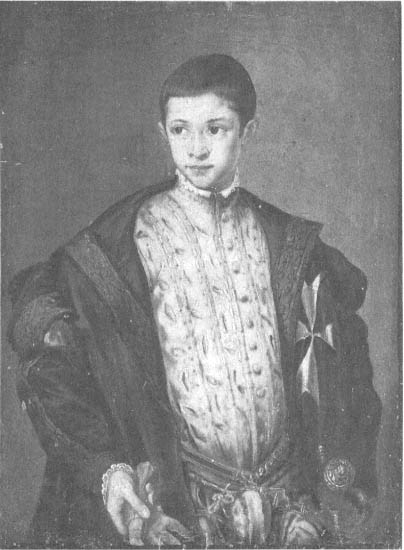
20.
Titian, Portrait of Ranuccio Farnese, 1542.
Photo courtesy of the Gemäldegalerie, Staatliche Museen
Preussischer Kulturbesitz, Berlin.
published in 1548, appears to celebrate the heroics of Ranuccio's father, Pierluigi, on the occasion of the Farnese's takeover of Parma and Pierluigi's assumption of Parma's dukedom in September and October 1545.[78] Other texts in Donato's book celebrating famous families may form part of a complex of tributes to the Farnese (though none of these has the positive markers of Mentre quest'alme ). The ottava rima Pianta beata,
[78] The setting was published in Rore's Terzo libro a 5 (RISM 15489). The identification of the poem's probable occasion and dedicatee was made by Helga Meier in her edition of Willaert, Opera omnia, vol. 14, Madrigali e Canzoni Villanesche, AIM (Neuhausen-Stuttgart, 1977), p. x.
che già fosti degna (no. 18), in particular, exalts the "Fronde de vincitor felice insegna / A cui fan sempre i più bei spirti honore" (branch of the victor, happy insignia, to which the most beautiful spirits always pay homage). Later it calls up the "Rami sacri felici almi'et beati" (sacred branches, happy, life-giving, and blessed) as part of a final two-verse acclamation that occupies nearly half the length of Donato's setting. The final dialogue, "Ahi miserelle, ahi sventurate noi, " celebrating Pluto, Proserpina, and Hymen, probably evolved as an intermedio that formed part of a staged wedding celebration. Only Italy's wealthiest families, like the Farnese, typically produced such celebrations, but no positive clues of a connection to them exist.[79]
Following roughly the form of the Musica nova, Donato's Primo libro a 5 & a 6 contains seventeen five-voice madrigals, six six-voice madrigals, and three seven-voice dialogues, in no traditional modal order (see Table 13). Surely the desire to position the dedicatory madrigal at the book's opening and order its madrigals by numbers of voices superseded modal concerns. Nevertheless, like nearly all Gardane's prints, Donato's book groups works with like pitch systems — hence nos. 4-6 are all in cantus durus on E, nos. 10-13 all share the type

The Primo libro a 5 & a 6 stresses sonnets, but not to the exclusion of other poems. Half of the book's twenty-six numbers are sonnet settings, only ten of them complete. All but one of the complete settings divide after the octave; the single exception, set continuously, is no. 10, on a light May Day text. Otherwise only the dialogues dispense with this two-part arrangement, two of them resetting texts from the Musica nova (nos. 24 and 25). The remaining thirteen works divide between cinquecento poetic madrigals (nos. 1, 11, 15, 19, and 26), ottave rime (nos. 4, 12, 13, 14, and 18), a canzone stanza by Petrarch (no. 3), and two ballata-madrigals (nos. 16 and 23). In addition to somewhat older poets like the Venetians Andrea Navagero and Pietro Bembo, the book makes notable use of a younger group of poets who were intimates of Domenico Venier's literary salon: Giovanni Battista Amalteo, Lodovico Dolce, and Fortunio Spira. Donato, as we saw in Chapter 4, may have gotten to know Venier when he set his three patriotic stanzas for a public festival in the city (the settings were published as the final three numbers in Donato's Napolitane of 1550), and the sonnet setting no. 9 almost surely celebrated one of Venier's noble academists, Lorenzo Contarini (see n. 79).
Donato's first book shows a facility for counterpoint and melody as endearing as Perissone's and just as fit to win admirers and freelance work from wealthy patrons.
[79] On Ahi miserelle see Einstein, The Italian Madrigal 1:452-53.
One other setting, no. 9, Angelico intelletto hor che nel seno, on a sonnet lamenting the death of one "Contareno," eulogizes another nobleman, a member of the prominent Venetian family also called Contarini. The sonnet's emphasis on the deceased's intellect leads me to think that it referred to Lorenzo Contarini, the philosopher, Latin scholar, and member of Venier's circle, included as interlocutor in Parabosco's I diporti, who died on 8 November 1552; see A. Venturi, "Contarini, Lorenzo," in Dizionario biografico degli italiani, vol. 28 (Rome, 1983), pp. 231-33.
[80] On Gardane's practice of grouping works by some combination of system, ambitus, and/or final see Mary S. Lewis, "Antonio Gardane and His Publications of Sacred Music 1538-55" (Ph.D. diss, Brandeis University, 1979), pp. 184-91. For the argument that Gardane was arranging by tonal type and not mode see Powers, "Tonal Types and Modal Categories," esp. p. 461.
| ||||||||||||||||||||||||||||||||||||||||||||||||||||||||||||||||||||||
(Table continued on next page)
| |||||||||||||||||||||||||||||||||||||||||||||||||||||||||||||||||||||||||||||||||||||
Only rarely, as in his fourth-mode setting of Petrarch's spiritual sonnet I vo piangendo, scored for low male voices, did Donato essay the same dark effects as Willaert. More often his work followed that of other disciples at San Marco in reconciling Willaert's rhetorical lessons with a lighter style, approximating Bembist ideals without clinging to such introverted declamation as Willaert's.
Indeed Donato did so while borrowing from Willaert in less concealed ways than Perissone. His setting of I vidi in terra employs the same tonal type as Willaert's,

But the most striking borrowing comes at the beginning of the seconda parte, where Donato adopted almost every facet of Willaert's composition (cf. Ex. 58a below with Ex. 58b) — the lengthy movement by fifths, the pacing and development of the declamatory rhythm, and even much of the voicing and many of the individual motives. The passage is little more than a rescoring of Willaert's original. Here Donato's imitative practice verges on the kind of submissive reverence contemporary Venetian literati exhorted for imitating Petrarch.[82] The same can be said of both his other resettings of Musica nova texts, the two dialogues "Liete e pensose " and "Che fai alma, " which (again) mimic Willaert in ways that are less camouflaged than Perissone's. For "Che fai alma, " in fact, Donato closely adapted the polyphony of Willaert's entire exposition.[83]
[81] To follow a complete score, see my ed., pp. 214-21.
[82] On this matter see Chap. 5 above and Thomas M. Greene, The Light in Troy: Imitation and Discovery in Renaissance Poetry (New Haven, 1982).
[83] See H. Meier, "Zur Chronologie der Musica Nova, " p. 78. On the concision that typically marks Donato's adaptations see David Alan Nutter, "The Italian Polyphonic Dialogue of the Sixteenth Century," 2 vols. (Ph.D. diss., University of Nottingham, 1978), p. 107.
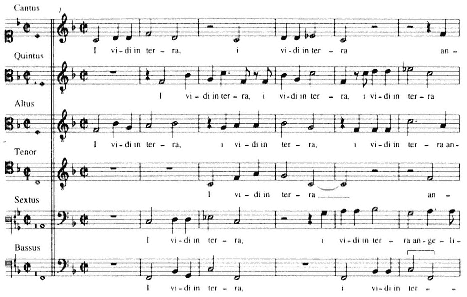
Ex. 57A.
Willaert, I vidi in terra angelici costumi (Petrarch, no. 156),
mm. 1-6; Musica nova (Venice, 1559), no. 19.
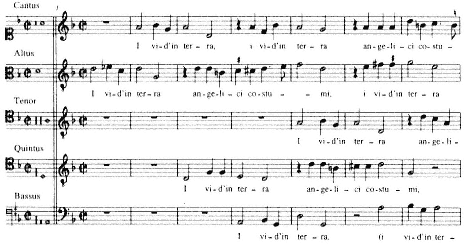
Ex. 57B.
Perissone, I'vid'in terra angelici costumi (Petrarch, no. 156),
mm. 1-7; Segondo libro a 5 (Venice, 1550), p. 6.
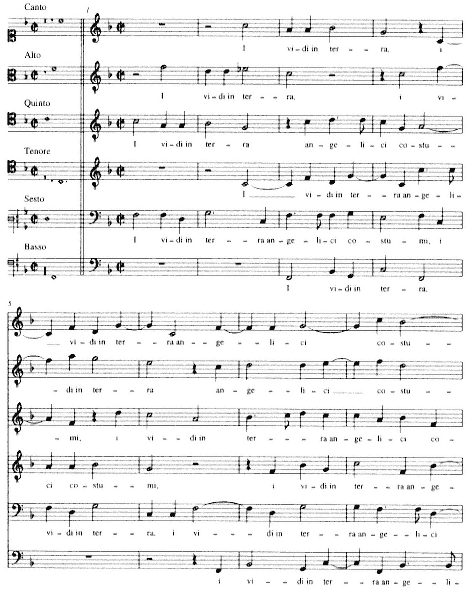
Ex. 57C.
Donato, I vidi in terra angelici costumi (Petrarch, no. 156),
mm. 1-8; Primo libro a 5 & a 6 (Venice, 1560), p. 28.
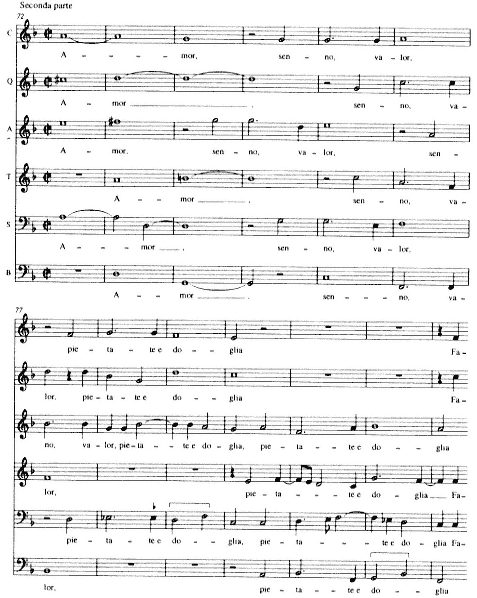
Ex. 58A.
Willaert, I vidi in terra angelici costumi (Petrarch, no. 156),
mm. 72-83; Musica nova (Venice, 1559), no. 19.
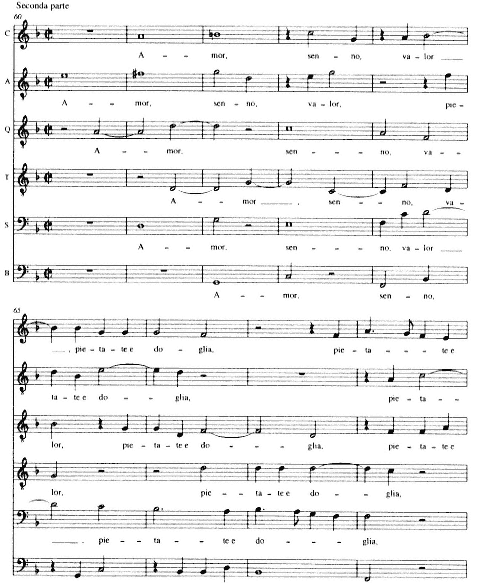
Ex. 58B.
Donato, I vidi in terra angelici costumi (Petrarch, no. 156),
mm. 60-68; Primo libro a 5 & a 6 (Venice, 1560), p. 28.
These are not the sorts of furtive borrowings to thread the counterpoint with witty glosses, perceptible only to the canniest observers. They are servile acts of praise, readily identified by any listener well acquainted with the model. Given Donato's relation to Willaert as both close collaborator and subordinate, it comes as no surprise that his imitations took the form of public homage.
By their simultaneous gestures of overt tribute and self-display, imitations of this kind allow us privileged scrutiny of the public debts disciples paid their masters at the same time as they paradoxically illuminate disciples' styles in nonemulatory works. Donato's setting of Dolce's Scalda, Signor, il mio gelato core (no. 21) forms a case in point. As a spiritual sonnet, Scalda, Signor aligned itself with a pious Petrarchan rhetoric through direct supplications to God, calling for a somber diction as naturally as Petrarch's secular sonnets did. Donato set Scalda, Signor with the same proportions as Musica nova settings, yet asserted his own voice by fashioning a more melodious and metrical exemplar of the spiritual style. Such lyricism is even more surprising in Donato's other spiritual madrigal, on Petrarch's I vo piangendo, a text that he might have set more like Scalda, Signor. I vo piangendo lacked a model in either Willaert or Rore but had a direct antecedent in Parabosco's setting of its octave, published in 1546. Donato's madrigal shows no relation to Parabosco's, except that both use Phrygian mode and avoid chiavette (in fact Donato's dips into the lowest possible tessituras with the cleffing c4c4F3F4F5, as compared with Parabosco's c1c3c4c4F4; cf. Table 9, no. 14 with Table 13, no. 5). In other respects Donato's setting forms a virtual antitype to Parabosco's, collapsing the entire sonnet into a scant 89 breves as against the 104 Parabosco used for the octave.[84]
Once outside the imposing domain of Petrarchan sonnets and close cousins like Scalda, Signor, Donato's knack for pithy execution, distinctive motives, and melodic grace led him to author wonderfully fresh madrigals. In his settings of poetic madrigals, in particular, Donato's stylishness, lyricism, and wit went unsurpassed by his contemporaries. A good example of these melodic gifts is the anonymous Sarra, vostra beltate è tanta e tale (no. II), an encomium to the Sarra apostrophized in the incipit, where Donato's cantus sparkles its way through the plagal octave d to dd, with semiminims lighting down by thirds (mm. 14-15), before reaching the final g (Ex. 59). Another madrigal, Lodovico Martelli's Da duo occhi lucenti (no. 16), unveils the opening conceit on the beloved's "two eyes" with a tongue-in-cheek musical icon: two lone voices in homorhythm. Still other settings — Il primo dì del bel fiorito maggio (no. 10) and the octave of Bembo's Cantai un tempo, et se fu dolce il canto (no. 17) — turn to breezy triple meters and sprightly melismas (note the rhapsodic example of the latter in Ex. 60).
With this playful melodic bent, Donato must have been a great hit in the salons of Venice. Yet not all his 1553 settings of lighter texts are so insouciant — most notably his setting of Spira's ballata-madrigal, Non è, lasso, martire (no. 23).
[84] See Einstein's description, The Italian Madrigal 1:452.

Ex. 59.
Donato, Sarra, vostra beltate è tante e tale, cantus,
mm. 5-18; Primo libro a 5 & a 6 (Venice, 1560), p. 16.

Ex. 60.
Donato, Cantai un tempo, e se fu dolce il canto (Pietro Bembo),
cantus, mm. 30-37; Primo libro a 5 & a 6 (Venice, 1560), p. 22.
Non è, lasso, martire It is not, alas, a martyrdom
Il convenir per voi, Donna, morire, To agree for you, Lady, to die,
Se la cagion de la mia mort'è tale If the cause of death is such
Che fa lieve ogni male; That it lessens every suffering.
Ma quel che mi tormenta But what torments me 5
È che del mio morir sete contenta, Is that my death contents you,
E ch'al primo veder d'altro amadore And that at the first sight of another admirer
Cangiaste 'l vostro core. You changed your heart.
Non è, dunque, martire, Is it not, then, a martyrdom
Il convenir per voi, Donna, morire? To agree for you, Lady, to die? 10
Already in 1545, when Spira's text was published in the first of the Rime diverse series, its form was a throwback to the old madrigal-with-refrain popular with poets like Lodovico Martelli and Dragonetto Bonifazio in the twenties and thirties. Like Bonifazio's Amor mi fa morire (see Chap. 7 nn. 18-19), Spira's poem elides the ripresa 's return by means of a slight rhetorical transformation. In keeping with the poetic device, the music that begins the madrigal returns to end it (mm. 54-72), neatly joined by means of an expressive cross relation, C-sharp/C. However old the setting was in 1553 (it could well have been newly written, or as old as eight or
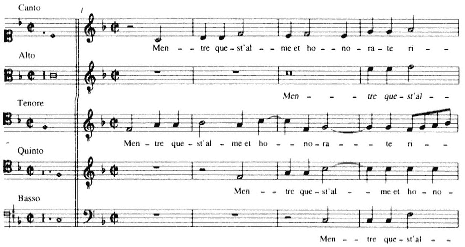
Ex. 61.
Donato, Mentre quest'alme et honorate rive, mm. 1-4;
Primo libro a 5 & a 6 (Venice, 1560), p. 1.
ten years), it resembles Verdelot's six-voice madrigals on similar texts[85] — not only their form but their calm, graceful rhythms. Non è, lasso, martire begins with a chansonesque dactyllic figure and disposes the opening verse with a minimum of fuss, avoiding any syncopation until the cadential figure occurs after eight bars. The metrical regularity of the opening endures throughout, with balanced, lucid expositions introducing each new line of text. Choirs of voices often deliver the text in consort, with even-paced counterpoint declaimed in semiminims (like that setting v. 4), adding a chansonesque metric feel. Apart from the cross relation noted earlier, these steady rhythms accompany a pervasive diatonicism.
Such tonal-rhythmic simplicity is shared by Donato's several celebratory settings, which were probably recent creations. The dedication piece Mentre quest'alme begins with a similar dactyllic figure but in a triadic form appropriate to the enunciatory rhetoric of celebration; and the same figure later opens out more spaciously in the invocation to the dedicatee "Rinuccio" (Exx. 61 and 62). Another occasional piece, Pianta beata, realizes this style of choral celebration more fully through its quick triadic exchanges and clear registral shifts. Like those of Non è, lasso, martire, the rhythmic motives of Pianta beata are simple and square and its soundscape diatonic as well. Yet as an ottava rima, Pianta beata's formal-tonal organization is based on the distich principle. The conjunction of simple diatonicism, motivic simplicity, and ottava form is natural, since historically the form was aligned with declamatory song. Even though, as a six-voice setting, Pianta beata has a fair share of imitative
[85] I refer to those published in the collection of 1541 and reprinted in 1546 [RISM 154619]. See also Verdelot's Madonna, qual certeça on a ballata-madrigal by Bonifazio, in H. Colin Slim, ed., A Gift of Madrigals and Motets, 2 vols. (Chicago, 1972), pp. 379-81, with the text on p. 446.
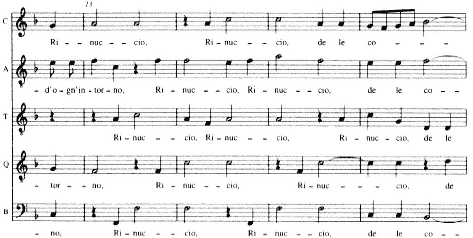
Ex. 62.
Donato, Mentre quest'alme et honorate rive, mm. 13-17;
Primo libro a 5 & a 6 (Venice, 1560), p. 1.
counterpoint, each one of its couplets finishes with a strongly marked cadence joined by at least five of the six voices.
Pianta beata is one of five ottave rime in the Primo libro a 5 & a 6, a higher number than found in any other print in the Venetian repertory. Ottave rime are more at home in Perissone's Primo libro a 4 (the only other print I have dealt with in these chapters to include them, not counting Venier's stanzas in Donato's Napolitane ), since Perissone's four-voice book straddles the fence that separates song from polyphony. By contrast, none of the ottave Donato set in the Primo libro a 5 & a 6, save Pianta beata, looks formally or stylistically different from his madrigals: indeed some seem to merge the rhythmic vivacity of the madrigals with the polyphonic complexity of larger forms. Laura, le selv'et le campagne apriche (no. 12), a gamesmanly series of wordplays on the Laura-Paura homonym, is such an ottava setting, gamboling in widely displaced points of imitation and ebullient declamation.
Unlike any of his peers' collections, Donato's Primo libro was reprinted twice, in 1557 and in 1560. By that time the Willaertian madrigal was already on the wane, and Donato himself published no new books until his first for four voices of 1568. In later years Donato's prestige in the chapel continued to rise as he repeatedly found success in the administrative ranks of San Marco. In addition to regular salary increases, he was made maestro of a newly formed cappella piccola at St. Mark's in 1562,[86] and in 1590 finally became maestro di cappella—a position in which he died
[86] See Ongaro, "The Chapel of St. Mark's," pp. 153-56 and Document 259, on the formation of the cappella piccola, and on Donato's raises in salary, passim.
in 1603, succeeded by the local musician Giovanni Croce. Donato thus takes his place in a neat line of succession from Willaert, Rore, and Zarlino to Monteverdi, who eventually replaced Croce's successor in 1612. His turn toward administration corresponds to the creative trajectory of the madrigal, which had already begun to move out of Venice shortly after Donato published his book. By the mid- to late 1550s exciting transformations of Willaert's style were no longer ventured by composers in Venice but by Rore in Ferrara and, later on, by his students Giaches de Wert and Luzzasco Luzzaschi in Ferrara and Mantua through the 1590s. It is in their works, as well as in those of Luca Marenzio and others, that the lineage of multi-voice madrigals from midcentury can be followed, culminating in Monteverdi's provocative madrigal collections from the turn of the century.
Appendix: Sonnets on the Death of Perissone Cambio[87]
Del Sig. Domenico Veniero In morte di M. Perison Cambio
Musico Eccell.
Ben perì suon, qual suona il nome stesso The sound that sounds the same angelic and
Di cui piangemo, angelico, e divino Divine name for whom we weep perished down there
Qua giuso il dì, che 'l tolse empio destino The day that bitter fate took him away,
E perì tutto il nostro ben con esso. And all our good perished with him. 4
Sol fu per gratia un tempo à noi concesso Such a rare, choice, and uncommon spirit
Sì raro spirto, eletto, e pellegrino, Was only granted us by grace for a time,
Ma troppo hebbe al principio il fin vicino But the end was too close to the beginning
Del viver suo da morte invida oppresso. Of his life, oppressed by envious death. 8
Fermò l'onde nel mar, ne l'aria i venti, The sound of his sweet tones stopped
Arse il gel, mosse i monti, e 'l ciel turbato The waves in the sea, the wind in the air,
Serenò 'I suon de' suoi soavi accenti. Burned ice, moved mountains, and made serene
the clouded sky. 11
Quando egual cambio in cambio à noi fia dato When is an equal change given to us in exchange
Di sì gran Cambio? in van speran le genti, For such a great Cambio? In vain do people hope
Che piu tal dono a lor conceda il Fato. That fate will award them again such a gift. 14
Risposta di Mons. Fenarolo.
Sì mi sento ne l'alma il suono impresso I so hear in my soul the sound made
Di lui, che verso il ciel prese il camino, By him that has taken the path toward Heaven
Che mel par di veder sempre da presso, That I seem to see him always close by,
E fermo il passo, e 'l dolce canto inchino. And I hold my step and bend toward the sweet song. 4
[87] From Rime di Mons. Girolamo Fenaruolo (Venice, 1574), fol. [38].
Poscia avveduto del mio inganno espresso Then realizing my express mistake
Allargo a gli occhi il pianto, e 'l viso chino, I widen my eyes to the tears and bow down my face;
E grido; ahi Cigno gloria di Permesso And I cry, "Oh swan, glory of Permessus,
Perche lasciarmi qui solo, e meschino? Why do you leave me here alone and wretched?" 8
In un punto perì suon sì preghiato, In one moment the sound so esteemed perished,
E 'n sua vece mandò tristi lamenti, And in its place the sea of Hadrian from every side
(Duro Cambio,) il mar d'Adria in ogni lato. (In bitter exchange) sent sad laments. 11
Però, se meco piangi, e ti lamenti, But if you weep and lament with me,
Fai ciò, che chiede il nostro acerbo stato, You do what our bitter state
E la fera cagion de' miei tormenti. And the fierce cause of my torments asks. 14
Chapter 10—
Epilogue "Sopra Le Stanze Del Petrarca in Laude Della Madonna"—
Rore's Vergine Cycle of 1548
In proposing ways to read large lyric forms from start to finish Venetian madrigalists took on one of the principal challenges to cinquecento polyphony. The new mood of lingering meditation that pervaded their madrigals in the 1540s was chiefly sustained by adapting the imitative strategies of sacred polyphony to the long lines and formal units of whole sonnets. But imitative polyphony, especially as embodied in sacred form, made a strange match for lyric verse. Lurking in those vast, cerebral settings was something that contradicted the deepest lyric principles of concision, melodiousness, and spontaneity.
To be sure, a composer like Rore could turn these expansive proportions to rich expressive account, even while working within the general confines of a Ciceronian poetics that placed decorum at its aesthetic core. From this centrist position, Rore's expressivity continually pressed against boundaries that guarded the way to more eccentric idioms. By the time of his Quattro libro a 5 and Secondo libro a 4, both published in 1557, the rhetorical lessons of Venetian madrigals had been absorbed into tighter, more emotional settings — shorter in the main, more direct, and more extreme. Rore's ponderous early madrigals contrast sharply with the pithy style he sought in these later ones; but the extravagance of his late style nonetheless grew out of gestures he was cultivating from the start. In this last chapter I locate Rore's stylistic shift within his Vergine cycle, his setting of Petrarch's final canzone (no. 366), first printed in 1548-49.
Rore's Vergine sits at a crossroads between his early and late manners, representing the consummation of the old and beginning of the new. On the one hand, the cycle was his last major contribution to the repertory of Venetian-styled madrigals and to the ideals of Venetian Petrarchism, epitomizing propensities toward elegiac breadth and introspection that were the fountainhead of his Italian style. Its polyphony remains largely imitative and continuous, and its harmony coolly
diatonic. At the same time, its wealth of animated declamation, flexible speech rhythms, sharply pitted homorhythmic duets and trios, overt madrigalisms, and sudden shifts of pace and texture betoken deep shifts beneath the surface that make it a pivotal work not only in Rore's development but in the whole development of lyric part singing in Italy. With these techniques Rore rearranged the basic textual components of vocal polyphonic architecture that had ensured Venetian madrigals their measured flow. His Vergine questions Venetian norms through a new form of poetic reading — a reading that enlarges the relatively minor rift between Rore's earliest efforts and the Musica nova into a major aesthetic gulf.
Let me begin by expanding slightly some bibliographical details of the Vergine 's publication that I first broached in Chapter 3.[1] Rore set the Vergine canzone as a cycle of eleven madrigals, one on each of the poem's stanzas. Around April 1548, when Rore had already been chapelmaster at Ferrara for at least two years, the first editions of his Terzo libro a 5 by Scotto and Gardane printed stanzas one through six. In this fragmentary state the cycle was decidedly incomplete and quite likely had been issued without Rore's approval. Furthermore, neither the dedication of the Scotto edition to Gottardo Occagna nor of the Gardane edition to the poet-cleric Giovanni della Casa was made by Rore himself, and neither dedication claimed to have Rore's blessing. Not long after the initial editions appeared, and probably in 1549 as Mary Lewis has argued, both printing houses issued supplements to their respective editions appending the last five stanzas along with three additional madrigals.[2] This made the cycle complete, but Rore must still have wanted it revised: in 1552 the whole was reissued by Gardane in a complete edition containing substantial alterations to the original printed versions.[3] Gardane's revised edition can be taken as the final bibliographical bit of a compositional puzzle whose first pieces were set in place by mid-1547, by which time at least the first six stanzas must have existed in draft.[4]
I will bring my account of midcentury Venetian madrigals to a close by suggesting that musical aspects of the work's two sections — stanzas 1 to 6 and 7 to 11 — reveal a work stratified in its compositional genesis as well as its dissemination. Each section seems to represent not merely different stages at which printers acquired portions of the cycle but different compositional layers, hence stages, in Rore's approach to setting text. Taken in sum, discrepancies between the two layers offer a remarkable lens through which to view Rore's refocusing of the Venetian
[1] For more details see Chap. 3 nn. 31-35.
[2] These supplements appear in fewer than a handful of copies of the Terzo libro; for a listing see Mary S. Lewis, "Rore's Setting of Petrarch's Vergine bella: A History of Its Composition and Early Transmission," Journal of Musicology 4 (1985-86): 366-67, Tables 1 and 2. It was only the altus part book of Gardane's supplement that actually carried the dedication to della Casa.
[3] This is the version reflected in the edition of Bernhard Meier and the one from which I will cite. No substantive revisions from the earlier editions appear in the examples shown in this chapter. For the complete cycle see Cipriani Rore, Opera Omnia, ed. Bernhard Meier, Corpus mensurabilis musicae, no. 14, AIM, vol. 3 ([Rome], 1961), pp. 1-33.
[4] Cf. Chap. 8 above, n. 1.
idiom, without contradicting evidence that Rore intended a cyclic conception at the macrolevel. There can be no doubt that the cycle's final form displays signs of unification by consistently using five voices, a single cleffing arrangement (c1-c3-c4-c4-F4), alla breve time signatures, and even the same signature and final for the first and last stanzas.[5]
More than all this, Rore unified the cycle by invariably intensifying the invocations to the Virgin that occur twice each strophe at vv. I and 9 while also shaping the equally regular rhythmic articulations between piedi and sirima that come between vv. 6 and 7. In so doing, Rore recognized the dual articulative scheme basic to Petrarch's stanzaic construction, as seen in stanza one.
A Vergine bella, che si sol vestita, Lovely Virgin who, clothed with the sun and
B Coronata di stelle, al sommo Sole Crowned with stars, so pleased
C Piacesti sì che 'n te sua luce ascose: The highest Sun that He hid his light in you:
B Amor mi spinge a dir di te parole, Love drives me to say words about you,
A Ma non so 'ncominciar senza tua aita But I know not how to start without your aid
C Et di colui ch'amando in te si pose. And that of Him who loving placed Himself in you. 6
C Invoco lei che ben sempre rispose I invoke her who has always answered
d Chi la chiamò con fede, Whoever called on her with faith.
d Vergine, s'a mercede Virgin, if extreme misery
C Miseria estrema de l'umane cose Of human things ever turned you 10
E Giamai ti volse, al mio prego t'inchina, To mercy, bend to my prayer,
f Soccorri a la mia guerra Give succor to my war,
(f)E Ben ch'i' sia terra et tu del Ciel regina. Though I am earth and you are queen of Heaven. 13
Indeed, the rhythmic-rhetorical counterpoint is even more complex than this. The shared rhymes C-C, which smooth the auditory transition between piedi and sirima, have a parallel in the rhythmic kinship of vv. 8 and 9 (d-d), rhymed settenari that straddle the second invocation. (The so-called unità — the rhyme that links the piedi and the sirima — is standard to canzoni, but the rhyme scheme of the sirima itself is idiosyncratic among those of Petrarch. More typical would be CDEEDFF or some variant thereof.) As a constant accompaniment to the invocatory structure, the rhymed pair elides v. 9, giving the invocation a ripresa -like character almost reminiscent of a ballata — an effect made strongest when the sirime do not coincide with a significant syntactic pause, as in stanzas 2 and 3.
A quick sampling of some of Rore's invocation settings will show what diversity he brought to them, especially in the way of rhetorical articulations. What matters here is not just the immediate counterpoint applied to any one fragment of text but
[5] Meier has proposed a modal design consisting of five pairs, but the reasoning to me seems contrived and unsupported by the musico-rhetorical design. See The Modes of Classical Vocal Polyphony Described according to the Sources, trans. Ellen S. Beebe, rev. ed. (New York, 1988), pp. 392-94, and Rore, Opera omnia 3:i-ii.
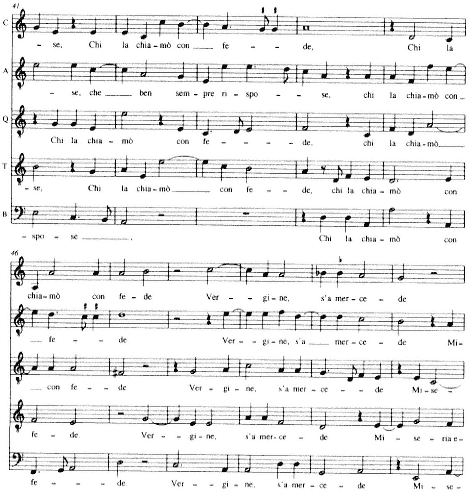
Ex. 63.
Rore, Vergine bella, che di sol vestita (Petrarch, no. 366, stanza 1),
mm. 41-51; Terzo libro a 5 (Venice, 1552), p. 1.
the whole musico-rhetorical context in which each invocation lies. In the passage excerpted in Ex. 63 from stanza 1, the second invocation of v. 9, "Vergine, s'a mercede," gains its presence in relation to the rhymed mate that precedes it (always a source of rhythmic elision), "Chi la chiamò con fede" (v. 8). In Rore's presentation v. 8 is all motion and clarity — the ubiquitous octave leaps, recurrent moves toward cadence, and consistently metric patterning of the declamation. By contrast, the "Vergine" of v. 9 is invoked in a series of plain calls fixed within a static space. Their entrances coincide with the end of the brief circle-of-fifths progression, A-D-G-C, that begins with the cadence of v. 8 (mm. 46-47) and closes in the pile-up of "Vergine" cries at m. 48. Rather than drawing the whole of v. 9's plea into the continuing circular motion, Rore truncates the circle, using its major harmonies to

Ex. 64.
Rore, Vergine santa, d'ogni gratia piena (Petrarch, no. 366, stanza 4),
cantus, mm. 1-5; Terzo libro a 5 (Venice, 1552), p. 4.
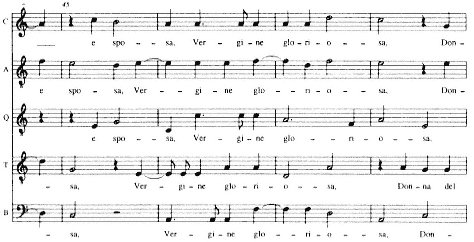
Ex. 65.
Rore, Vergine santa, d'ogni gratia piena (Petrarch, no. 366, stanza 4),
mm. 45-48; Terzo libro a 5 (Venice, 1552), p. 4.
adumbrate and irradiate the Virgin's name. Thus in the cadential m. 47 the invocation is highlighted even as it emerges from the shadowed inner voices whose cadence it shares. In all of this, Rore fuses the demands of a viscous Willaertian polyphony with a newer urge to articulate the separate parts.
Stanza one represents the Virgin in one of her conventional guises as the embodiment of noble simplicity. As set in stanza four, where a lovely "Vergine santa" floats through a minor sixth in the cantus to open the stanza, delicate and untethered in its Phrygian otherworldliness, the invocation calls up more ethereal images (Ex. 64). Here the polyphony too is elusively vague, with uneven entries and whimsical curves. But at v. 9 Rore made the second invocation, "Vergine gloriosa," into a choral acclamation that counterbalances the first (Ex. 65). In the brief space of a semibreve each of the voices is crowded into a thick homophony, with the echoing o' s of "gloriosa" resounding in communal exaltation against the cantus's top-of-the-register dd.
Junctures like these are Rore's rhetorical bread and butter. He handled them in sharper, more striking ways beginning at the sixth stanza (and they were to become far more dramatic still in stanza seven). A passage that occurs at the beginning of the
sirima, is especially revealing since its invocation takes place — most unusually, and problematically, for a musical setting — within a continuous grammatical process.
Ma pur in te l'anima mia si fida, But still my soul relies on you —
Peccatrice, io no 'l nego, A sinful one, I do not deny,
Vergine, ma ti prego Virgin — but I beg you
Ch'el tuo nemico del mio mal non rida. That your enemy not laugh at my harm. 10
Rore's challenge was to project both the invocation and the continuities of rhetorical detail in which it is embedded. To meet it his setting extracts the full measure of rhetorical contrast from the passage with no fewer than four distinct declamatory styles of polyphony (Ex. 66). It may be useful to review them in turn. First, both the end of the piedi and the end of v. 7 are tied off with cadences that enclose the syncopated cross rhythms adopted for the conditional thought at the beginning of the sirima. Two different vocal groupings — cantus, altus, and tenor imitating quintus and bassus — trade a buoyant melody between them as expressive foil for the quasi-parenthetical "Peccatrice, io no 'l nego, / Vergine" that follows. With these words the madrigal opens into a second declamatory style, a series of near-homorhythmic blocks that carry the text along in speech rhythms — an upper-voice trio on "Peccatrice" dovetailing the lower-voice duet "io no 'l nego, Vergine," with cadenze semplici serving as caesurae at mm. 41 and 43. The invocation thus keeps its proper grammatical place, but the full pause that punctuates it supplies retrospectively the sort of structural definition that Rore's rhetorical conception requires. A fuller complement of low voices extends equally speechlike rhythms to the prayer "ma ti prego,"[6] and as it echoes in the lone cantus, a third kind of declamation resonates beneath. This is the sort of spare recitation in overlapping counterpoint common to Willaert's works — and increasingly rare in Rore's. Why "tuo nemico" (your enemy) should elicit such semantic neutrality can only be answered by the need to clear expressive space for the avant-garde flourishes Rore next fashioned for "rida." They count as the fourth distinct textural-declamatory entity to appear in the few bars that compress vv. 7-10. A frenetic kind of mid-cinquecento ars subtilior, these flourishes reduce the rhythmic pulse from the half-note value (minim) to the quarter-note (semiminim), bizarrely and radically dividing the semiminims from the moment the quintus executes a straight suspension cadence in m. 48.
The excerpt shown in Ex. 66 raises several issues that will be central to my consideration of stanza seven. The passage is the first in the cycle in which various voices omit to present the entire poem, as Willaert's madrigals had invariably done. Rore's willingness not to make each part bear the full text marks a critical shift in his thinking about how words and music were to be consolidated. Its implications for the singers' encounter with the poem are profound. And it carries far-reaching
[6] Such speech rhythms reappear in stanza seven (as noted below) and stanza ten, mm. 26-33.
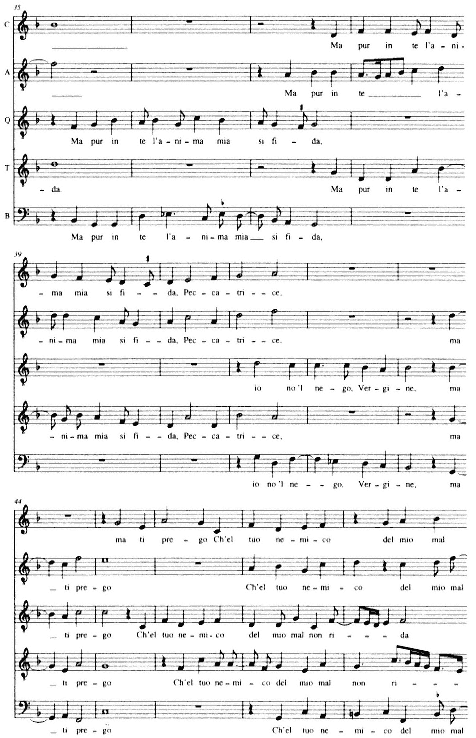
Ex. 66.
Rore, Vergine chiara e stabil'in eterno (Petrarch, no. 366, stanza 6),
mm. 35-53; Terzo libro a 5 (Venice, 1552), p. 6.
(continued on next page)
(continued from previous page)
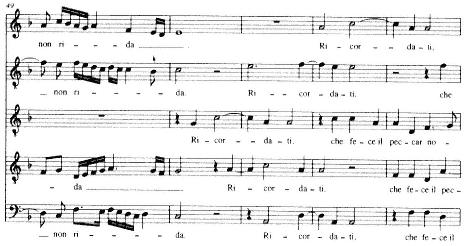
Ex. 66
(continued)
ramifications for texture, ones that are more familiar from the late madrigals of Marenzio, Wert, and Monteverdi.
Once the lyric text was scattered through several parts whose aggregate is needed to enable an integral reading, the linear and individual representation of the poetry by separate voices was sacrificed in favor of the composite, corporate one of the "score." Rather than directing the poetic experience inward toward the sense and intellect of each singer and the communal experience each of them shares, this new approach implies an audience of listeners outside, who are necessary now to construct the poem in its totality. The new approach thus implies projection outward too, with an attendant shift in the statuses of singers (now extroverted performers) and auditors (now passive appreciators). Potentially, at least, the two were more sharply separated than ever before, with professional church singers and female vocalists made indispensable in the parlor room and the relations to them of amateurs dramatically altered.[7]
A crucial corollary of these shifts and ruptures is that if madrigals were now to be sung for auditors, real or implied, they needed to be diverting to hear. A reading projected out of a performative frame, as opposed to a silent or communal one, wants a showier veneer, and those performing it are in turn the showmen and -women rather than mutual participants in an inner experience. This situation ushers in another change hinted at in the passage I quoted from stanza six — a more virtuosic persona. The florid writing on "rida" is harder to sing, harder to count, and harder to coordinate than most anything in earlier madrigals. Its closest kin are
[7] James Haar makes a related point about the new staginess of late-sixteenth-century madrigals at the conclusion of his Essays on Italian Poetry and Music in the Renaissance, 1350-1600 (Berkeley and Los Angeles, 1986), esp. p. 147.
some of the madrigals in the black-note anthologies published by Gardane, to which Rore's first book is obliquely related.[8] With poetic coherence dependent on a dynamic yet well-coordinated performing body, fast shifts of tempo, texture, and vocal style become part of the rhetorical hardware. The whole surface turns more mercurial, more temperamental: Rore's Vergine, though usually serene, at times seems to foreshadow the quixotic stylization of late-sixteenth-century Ferrarese madrigals.
All of these factors come together in Rore's rendering of stanza seven. The single group of words omitted in the texting of stanza six is a mere foretaste of more rampant textual omissions here. In all, four verses receive partial texting, as shown in italics below: v. 1 is given in a homophonic exordium, but only by cantus, altus, and quintus; v. 5 is omitted by the altus; the first part of v. 7 by the cantus and tenor; and v. 12 by the quintus and bassus. (As discussed below, v. 11 also omits its latter part from the repetition made by cantus and altus.) Consequently, the whole poem is delivered with more than usual dispatch.
Vergine, quante lagrim'ho già sparte, Virgin, how many tears have I already scattered,
Quante lusinghe e quanti pregh'indarno, How many pleadings and how many prayers in vain,
Pur per mia pena e per mio grave danno! Only to my pain and my heavy loss!
Da poi ch'io nacqu'in su la riva d'Arno, Since I was born on the bank of the Arno,
Cercand'hor quest'et hor quell'altra parte, Searching in this, now that other direction,
Non è stata mia vit'altro ch'affanno. My life has been nothing but troubles. 6
Mortal bellezza, atti e parole m'hanno Mortal beauty, acts, and words have
Tutt'ingombrata l'alma. Burdened all my soul.
Vergine sacr'et alma, Holy and life-giving Virgin,
Non tardar, ch'io son fors'all'ultim'anno; Do not delay, for I am perhaps in my last year; 10
I dì miei più correnti che saetta, My days, more swift than an arrow
Fra miserie e peccati, Amid wretchedness and sin,
Son se n'andati e sol morte n'aspetta. Have gone away and only Death awaits me. 13
Rore's setting of stanza seven evinces an extraordinary turn in his compositional thinking. His freer disposition of text is linked to a more outspoken rhetoric and a new polyphonic architecture that this rhetoric commanded. The rhythmic and textural diversity and strenuous changes of declamatory tempo with which Rore handled the passage I focused on from stanza six now pervade the entire setting (see Ex. 67). The stanza moves regularly into patter declamation ("in su la riva d'Arno," "atti e parole," "più correnti che saetta," "Son se n'andati" — mm. 36-38, 51-54, 57-58), much of it arrayed in duets or trios with an out-and-out homorhythm of the sort Willaert avoided almost completely in the Musica nova. In place of Willaertian
[8] For a mod. ed. of them see Don Harrán, ed., The Anthologies of Black-Note Madrigals, Corpus mensurabilis musicae, no. 73, AIM, 5 vols. (Neuhausen-Stuttgart, 1978), and on Rore's black-note madrigals idem, "Rore and the Madrigale Cromatico," Music Review 34 (1973): 66-81.
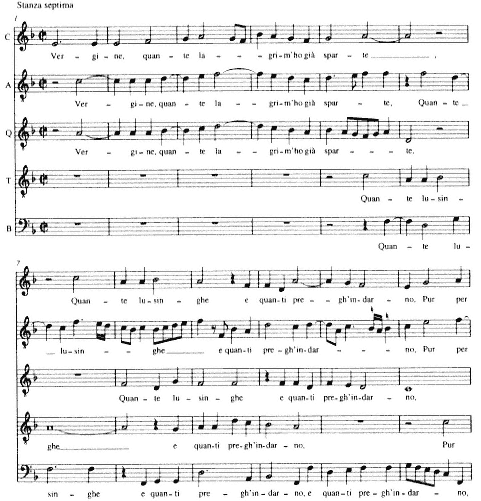
Ex. 67.
Rore, Vergine, quante lagrim'ho già sparte (Petrarch, no. 366, stanza 7),
incl.; Terzo libro a 5 (Venice, 1552), p. 7.
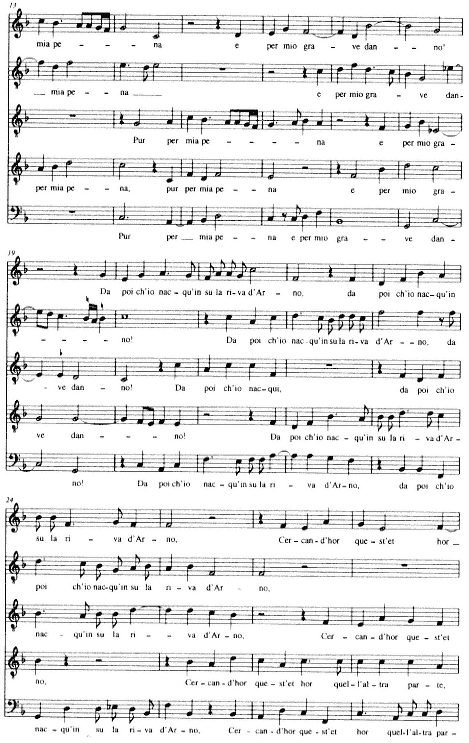
Ex. 67
(continued)
(continued on next page)
(continued from previous page)
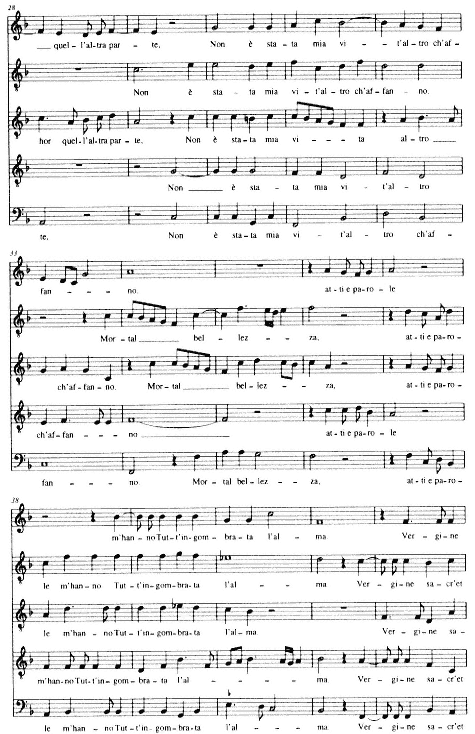
Ex. 67
(continued)
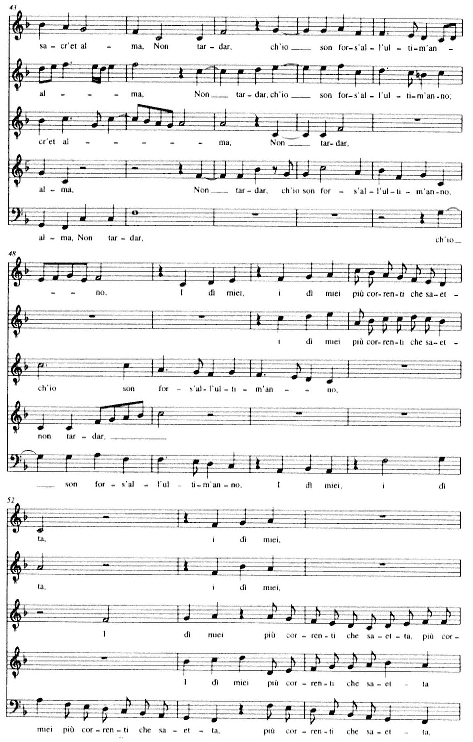
Ex. 67
(continued)
(continued on next page)
(continued from previous page)
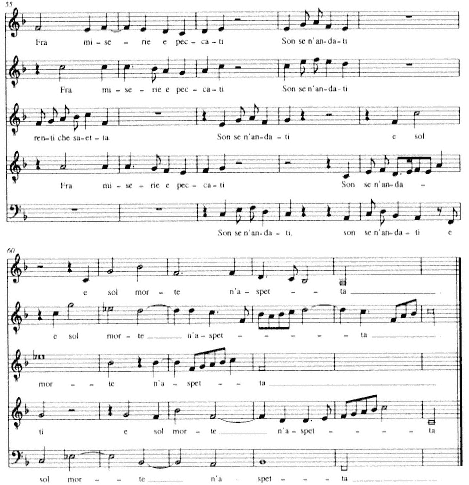
Ex. 67
(continued)
expansion this technique substitutes brevity and concision. (Not by coincidence, stanza seven lasts only 65 breves, five fewer than the next shortest stanza).[9]
The combined effect of these novelties is most pronounced in Rore's setting of the rhetorical point of vv. 11-13 (mm. 49 to the end), a proto-Monteverdian passage without precedent in his earlier canon and one to which we will shortly turn. Up to that point his articulative techniques are in part, at least, still conventional. The first nine to ten verses make a number of traditional suspension cadences, despite some patter rhythms and homophonic textures: a perfect cadence at m. 12 ending v. 2 (c/C, altus and quintus), another at m. 20 ending v. 3 (c/C, altus and quintus), an evaded cadence at m. 34 ending the piedi of v. 6 (aa/F, cantus and tenor), a perfect
[9] Further, the average length of stanzas seven, eight, nine, and ten is six breves less than that of the first six — just over 71 breves as opposed to just over 77.
cadence at m. 36 setting off the "Mortal bellezza" of v. 7 (f/F, altus and bassus), and perfect cadences at mm. 41 and 44 preceding and closing the invocation of v. 9 (b-flat/B-flat, tenor and bassus; f/f, cantus and altus). In mm. 13-16 Rore also made expressive use of two unusual suspension cadences on "pena" — close to what Zarlino would later call cadenze stravaganti. Their resolutions in parallel fifths (between cantus and tenor, mm. 13-14, then quintus and bassus, mm. 15-16) are indeed irregular, yet their contrapuntal techniques remain canonical.
Not all the contrapuntal articulation in the first nine verses is even as straightforward as these examples. With text now omissible from various voices, textures can easily be reduced to two parts or otherwise dissolved for expressive ends. Something approaching what Anthony Newcomb has dubbed the "evaporated cadence" marks off v. 5 (mm. 28-29):[10] the quintus drops to cadence followed a minim later by a suspension-staggered cantus, while the altus that would normally be part of this upper-voice group is denied the verse altogether. Nonetheless the syntactic principles still in force here do not admit a full caesura between vv. 5 and 6. Thus the altus returns with v. 6 at the start of m. 29, overlapping the seam just as the surrounding voices come to rest.
More often than not, however — and this crucial point holds throughout the cycle — suspension cadences, when they do occur, are far more lucid than the ones in the Musica nova. Rore's proclivity toward strong articulation is an enabling factor in the new musical rhetoric that emerges in these later Vergine stanzas. Many of the cadences are perfect, often with the same text ending in both voices, and a good number involve three, four, or all five voices.[11] Even in passages of patter-style duets and trios, Rore fashioned legitimate contrapuntal cadences in a way that brings the chattering homorhythm simultaneously into harmonic and rhetorical focus. The undiminished articulations to aa/a at m. 37 and a/A at m. 38 on "atti e parole," for example, meet quite unproblematically Zarlino's guidelines for "simple" cadences.
By comparison, the cadential constructs of traditional counterpoint fall away almost entirely after the invocation of v. 9, replaced by new modes of articulation — speech rhythms, fast-shifting choral groups, and flashes of textual-motivic fragments — much of it moving by parallel thirds and six-three chords. The setting opens onto this new terrain with two sharply drawn motivic gestures, the pithy head motive on the nominative "I dì miei" offset by a run of semiminims for the comparative "più correnti che saetta." From this lopsided opposition (three syllables vs. eight) Rore drew forth contrasting sounds and rhythms that help distill the semantic essence of each, working them, in the manner of fugal subject and countersubject, into a dynamic multiple counterpoint. The head motives, stolidly equalized in conjunct minim ascents (e.g., cantus: c-d-e, rest, f-g-aa, mm. 49-50), are neutralized metrically by their open-ended linearity and avoidance of downbeat.
[10] See The Madrigal at Ferrara, 1579-1597, 2 vols. (Princeton, 1980), 1: 120 n. 16.
[11] Cf. the discussion of Per mezz'i boschi, Chap. 8 above, n. 20 and Table 7.
This equalization increases the sonorous parity between vowels of the first phrase ("i," "i," and "iei") well beyond the level of spoken prosody. The rushing tail motive, usually anchored to consecutive downbeats equal in status on an implied metric grid (e.g., mm. 51-52), brings out only vowels regarded as piacevole by contemporaneous literati — the two "e" sounds on "correnti" and "saetta." From mm. 49-52 the cantus traces an arc from c to cc and back, with two statements of the head motive, one of the tail. Motivically, the two motives stand in a bipolar relationship: with the tail inverting the melodic direction and doubling the declamatory speed, they form antitheses — of up vs. down, ametric to metric, "i"/"iei" to "e," and slow vs. fast.
The larger goal of this motivic polarization is a flexible multiple counterpoint that embodies text as a virtual physical presence. No sooner is the consequent broached in m. 51 than the head motive enters beneath it in the role of bass line (mm. 51-52). The two form a pseudo-villanella texture as the upper voices turn quickly into parallel thirds ("che saetta") against the slower bass line. This is the same sort of villanella-like texture that proliferates in the pastoral madrigals of Andrea Gabrieli and Luca Marenzio and the later assimilations of their styles by Wert, Monteverdi, and others.[12]
In subsequent measures these same motives continue searching out new and varied scorings, transposing the consequent back to the lower register and arraying the parallel thirds anew. Rore's textual omissions allow him some delightfully unforeseen turns. As the cantus-altus duo falls unexpectedly mute after m. 53, the way is cleared for their languorous trio with the tenor of mm. 55-57 — a two-breve interlude on the miseries and sins of v. 12. This passage transforms the earlier parallel-third motion by expanding it into a doleful plaint of fauxbourdon.[13] At the next rescoring it is bassus and quintus, silent since v. 11, who come (for the first time) to the fore. Cadencing as part of a C-major triad with "Son se n'andati" (m. 58),[14] they restore the previous contrapuntal climate — root-position harmony along with imitative duets, chipper canzonetta homorhythms, and parallel thirds.
One event thus vanishes as quickly as the next. The final poetic turn to the poet's anticipation of death, "e sol morte n'aspetta," brings a last shift of texture, pace, and tonality as evanescent as any. It flips the tonal orbit suddenly backward to the flat side and introduces an unsettling string of intervals spanning minor sevenths (quin-
[12] According to Gary Tomlinson, Monteverdi borrowed the device from Marenzio's Non vidi mai dopo notturno pioggia (see Marenzio, Madrigali a quattro voci of 1585), to use in his Non si levava ancor l'alba novella, printed in Monteverdi's Secondo libro a 5 of 1590; see Monteverdi and the End of the Renaissance (Berkeley and Los Angeles, 1987), pp. 42-44.
[13] The technique was picked up by Wert. For an early instance of it see Wert's setting of Petrarch's Voi ch'ascoltate in rime sparse 'l suono, mm. 24-29, from his Madrigali del fiore, libro secondo (Venice, 1561); mod. ed. in Collected Works, ed. Carol MacClintock with Melvin Bernstein, Corpus mensurabilis musicae, no. 24, AIM ([Rome], 1962) 2:5. Verdelot sometimes wrote similar counterpoint, but melismatically.
[14] The cadence to e in the cantus of m. 57 is strange in the context of the apparent mode 6 — a clausula peregrina, as Meier calls it (The Modes, p. 252). But must we view it in such modal terms? The effect is that of a half-cadence, an actual dominant in this case. One senses a moving away from modal principles in the setting of vv. 11-13.
tus, bassus, cantus) and ninths (cantus, mm. 61-65) in a move of unprecedented dramatic force before dissipating in the ethereal cadences of the final measures.
These transformations of Venetian style raise profound questions about how and why Rore now reads text so differently from the way he had before. His writing here rejects the staid introspection, balance, and temperance that Musica nova -styled madrigals made all-important. In their place it proposes something almost gleefully hedonistic. The flood of motives is so thick and fast that few affective-semantic entities stay in place long enough to sink in. The vivid contrasts that unfold so rapidly in parts of the Vergine setting leave the auditor no chance — indeed no time — to enter a meditative state. Radically disjunct, they are often abandoned before the listener can ever begin to legitimize them.
Rore's now extreme iconic interpretations are inevitably fragmenting even in semantic terms. They destabilize lyrics by focusing on the single word and on isolated word groups. The startling verbal disembodiments that result are not just grammatical, hence formal, ones. In Rore's rendition, phrases like "più correnti che saetta" and "son se n'andati" could have been found in the most secular contexts, depicting the wiles of Cupid or the woes of a forsaken lover, rather than in a confessional prayer on life's sins and a presage of death.[15] Even the last and most explicit iteration of this confession, "e sol Morte n'aspetta," undercuts the anticipation of death to which Petrarch's words point by winding them voice to voice in a sumptuous stream of melismas.
Here Rore flirts with unabashed showmanship and flagrant sensuality.[16] His novelties do not, after all, simply "raise" music's level to meet abstract ideals of rhetorical sophistication — something we might impute to more conventional Willaertian madrigals — but confront the most performative aspect of Petrarch's poetics, his lyric bravura, with a new contrapuntal prowess. Neither Rore nor Willaert, nor anyone attempting to hear rhetoric in so close a way as they, would have been deaf to Petrarch's tremendous formal virtuosity, its signifying power, and the contradictions it poses with Petrarchan thematics. As Robert M. Durling has put it, the "self-conscious technical mastery" that Petrarch flaunts and worries time and again is "integral to his expressiveness."[17] It is this linguistic virtuosity, this formal gamesmanship in Petrarch's lyric achievement, that Rore's new readings isolate and elevate.
Indeed his is arguably a reading admitted within this seemingly most pious of canzoni, the Vergine poem itself. Petrarch's wily poetics, his nearly subversive formal
[15] For other words and phrases taken out of context see stanza three, "in allegrezza torni" (mm. 51-55), a reference to the Virgin's effect on the tears of Eve, and stanza four, "il Sol che rasserena" (mm. 27-30), to the brightening power of the sun.
[16] Similar melismas occur in stanza two, "chiara lampa" (mm. 17ff.) and "fortuna" (mm. 32ff.), and in stanza eight, "Tu ved'il tutto" (mm. 52ff.).
[17] Petrarch's Lyric Poems: The "Rime sparse" and Other Lyrics (Cambridge, Mass., 1976), p. 12.
manipulations, at times call the fundamental seriousness — or at least sacredness — of the whole poem into question, and with a measure of metaliterary distance that permeates the entire Canzoniere. An almost reckless instance of this comes in the middle of stanza eight, as Petrarch problematizes his always ambiguous address to the Virgin.
Hor tu, Donna del ciel, tu nostra Dea, Now you, Lady of Heaven, you our Goddess
Se dir lic'e conviensi, (If it is permitted and fitting to say it),
Vergine d'alti sensi, Virgin of deep wisdom:
Tu ved'il tutto, e quel che non potea You see all, and what another could not 10
Far altri è null'a la tua gran virtute. Do is nothing to your great power:
Pon fin al mio dolore, Put an end to my sorrow,
Ch'a te honore et a me fia salute. Which to you would be honor and to me salvation.
Petrarch's ambivalent "Vergine" is never entirely distinct in his Canzoniere from the virginal Laura (nor Laura from Her). Here She is a pagan goddess, "Donna del ciel, tu nostra Dea." Petrarch's obsequious bowing and scraping in v. 8 ("se dir lic'e conviensi") only draws attention to the audacity of his address and the forever unresolved and partial status of his faith, so necessary to sustaining his poetic design.[18]
Rore picks up Petrarch's cue in mm. 47-63 (see Ex. 68). After a full pause marks off v. 8, She becomes the "Vergine d'alti sensi," as lightly told in a choral exchange of lower and upper voices. She sees all ("Tu ved'il tutto"), they continue, jauntily weaving fast-dotted melismas between them until their dissolution in m. 54.[19] Thereafter a shift to triple meter, the first of two such in the last few stanzas of the cycle,[20] leads to a cheerful course of florid parallel tenths (cantus and bassus, mm. 60-61) in celebration of her "gran virtute."[21]
This passage seems unabashedly flippant but in a way that becomes typical of the last five stanzas.[22] Rore's reading moves decidedly away from the patriarchal and Ciceronian orientation of Willaert's settings.[23] To be sure, it extends directions
[18] Note too the presumptuous conclusion, where the consolatory function that she plays toward him becomes a source of her honor.
[19] The same sorts of dotted melismas can be seen in stanza five, altus, m. 41, on "gioconda."
[20] The other occurs in stanza ten, mm. 62-63.
[21] Simultaneous melismas of this sort do not appear in the Musica nova. Other examples in the Vergine cycle may be found in stanza two, mm. 60-61 (with parallel sixths between the upper voices), stanza four, m. 71 (parallel thirds between quintus and tenor), and stanza ten, mm. 65-66 (parallel sixths between cantus and tenor).
[22] Earlier stanzas toy with a similarly brazen rhetoric, though to a lesser extent. In stanza one, mm. 59-66, for instance, as Petrarch beseeches the Virgin to turn to his prayer and aid in his war ("al mio prego t'inchina;/Soccorri a la mia guerra," vv. 11b-12), Rore launches the first of his dotted-note melismas and syncopated minim/semiminim cross rhythms. Once the poet declares himself but earth beside her heavenly reign ("bench'io sia terra et tu del ciel Regina," v. 13, with its internal rhyme to "guerra"), his fawnings begin to look like a thin excuse for bravura paradox. For this Rore makes a dip into his lowest tessitura and drollest affective regions. (Another example of the cross rhythms found here crops up in stanza six, "Di questo tempestoso mare stella," mm. 11-15.)
[23] My thinking here has been influenced by William J. Kennedy's interpretations of Petrarchan commentaries like Bernardino Daniello's Sonetti, canzoni, e triomphi di Messer Francesco Petrarca con la spositione (1541; Venice, 1549) that emerged from the Venetian milieu during the third to fifth decades. Kennedy's forthcoming book on sixteenth-century Petrarchan commentaries promises fascinating new insights into relationships between civic and personal identities and modes of reading.
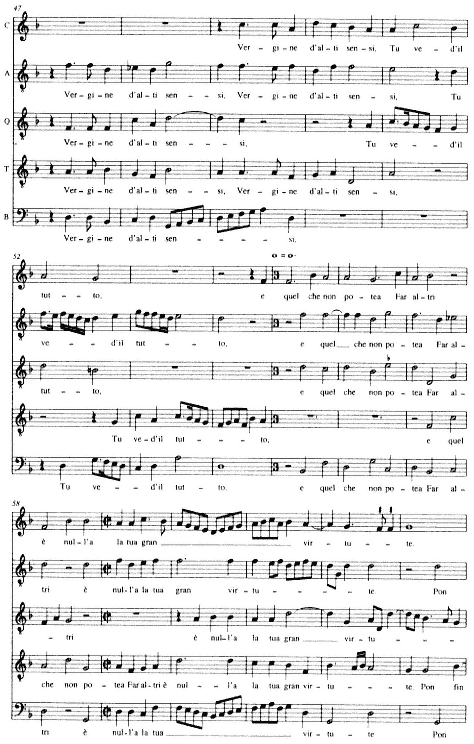
Ex. 68.
Rore, Vergine, tal è terra e post'ha in doglia (Petrarch, no. 366, stanza 8),
mm. 47-63; Terzo libro a 5 (Venice, 1552), p. 8.
anticipated in his first two books of madrigals, which ruffled Willaert's smooth Ciceronian surfaces by periodically disrupting the placid and continuous polyphonic flow. Already in a Dantean madrigal like Strane ruppi Rore maximized gestures of destabilizing discontinuity: consecutive leaps, fast, vaulting melismas, constant voice crossings, strings of inverted triads, textural evaporations, suspended dissonances, and tone clusters generated out of anticipated notes of resolution.[24] Where Willaert mainly stuck to verbal projection through linguistic structure — syntax — Rore balanced syntactic with semantic considerations. It is no surprise that Rore's early books continued to be reprinted into the 1590s.[25]
All of this we might view as underpinning his later seconda pratica style, if not actually broaching its harmonic experiments. To see in the madrigals of Rore's Books 1-3 a monolithic repertory, therefore, all falling under the rubric "Venetian," is to miss the new stirrings in Book 3 and even Rore's earlier books. It was the Vergine cycle that explicitly enunciated rhythmic and textural procedures that were essential to Rore's late compositional techniques. Far more than the early sonnet settings I have discussed, the Vergine forms a link between the classic Venetian style of the early forties and the late madrigalistic idioms of the north Italian courts, Ferrara and Mantua. It looks at once backward over the monumental style of the 1540s and forward to various quixotic strategies of the late 1550s and beyond, strategies at once iconic and iconoclastic.
I am tempted to propose, finally, that Rore's Vergine theatricalized text in a way that post-Ciceronian poetics encouraged. Aristotelian notions of imitation that were just then beginning to supplant Ciceronian ones bedazzled practitioners of mimetic arts with their vivid iconic promise and possibilities for imitating directly natural human speech and action. Rore's demonstrative imitations of textual events resonate in sympathy with this representational mimetic model. In making them he put at risk Venice's Ciceronian supertrope, its trope of tropes, decorum, pushing it from its dominant space at the center of discursive practice to a marginal position outside.
[24] See Chap. 8 above, pp. 285-93, for a discussion of the madrigal.
[25] On Rore's legacy see Meier's foreword to the Opera omnia 2:i-ii.